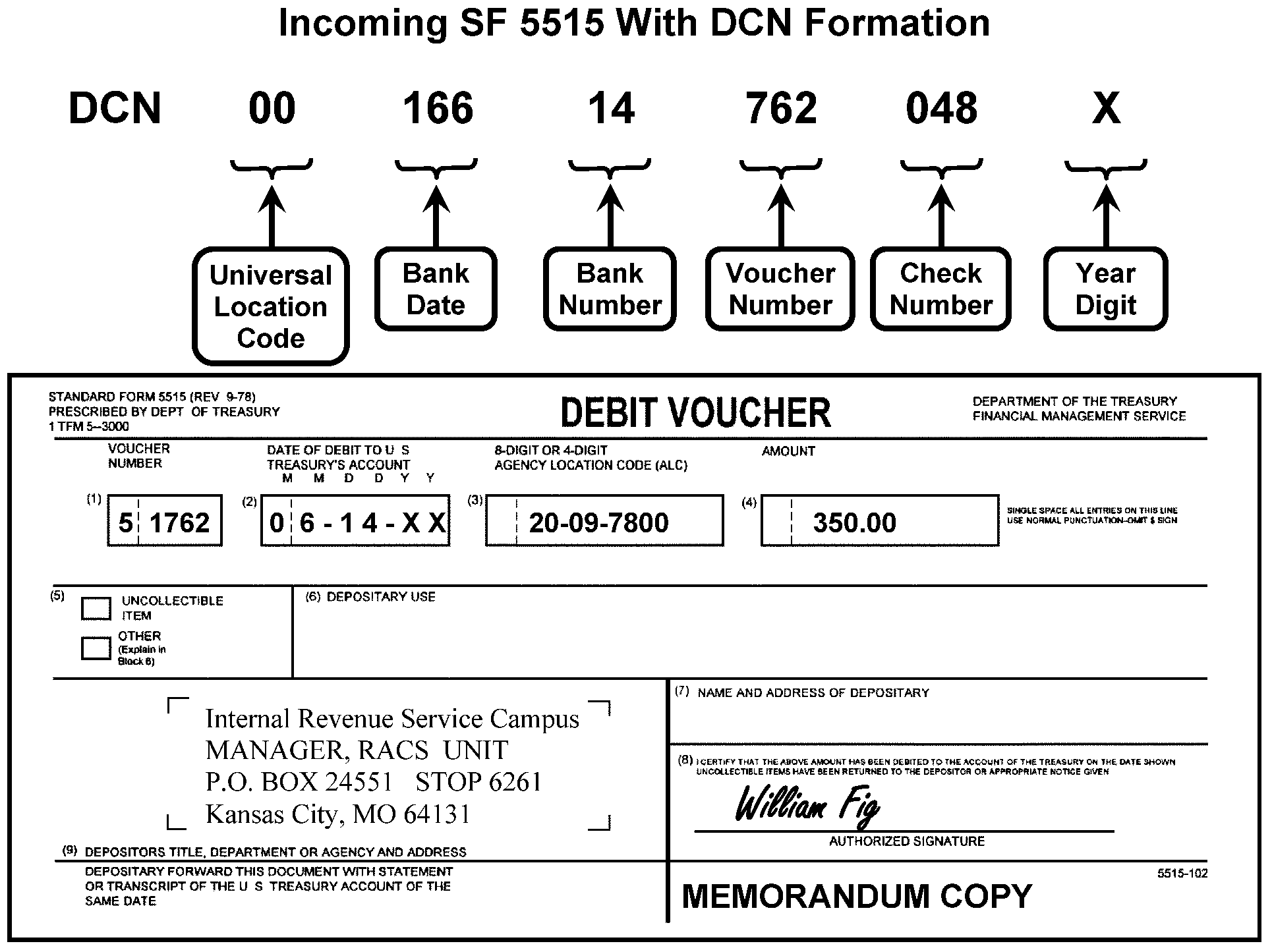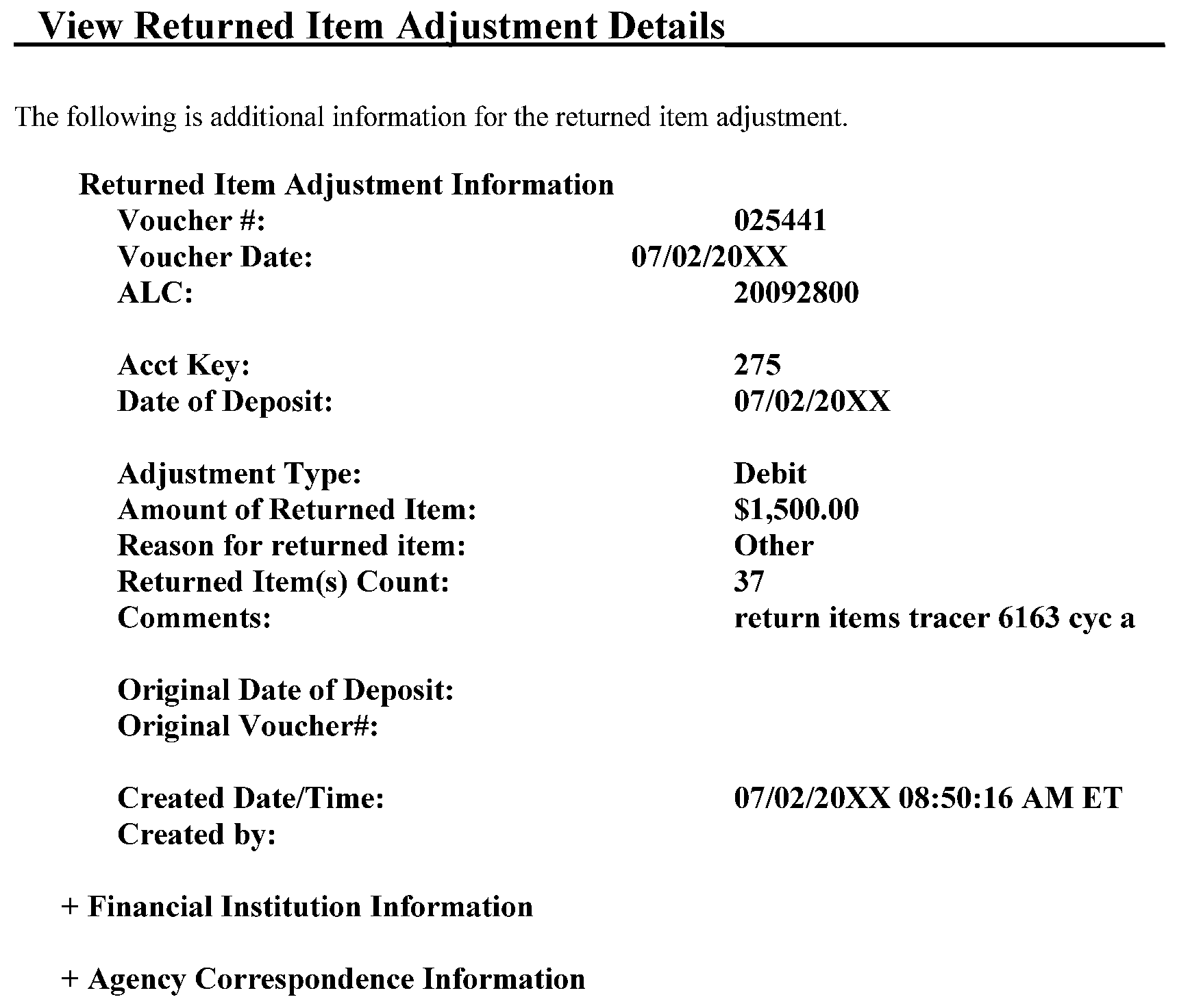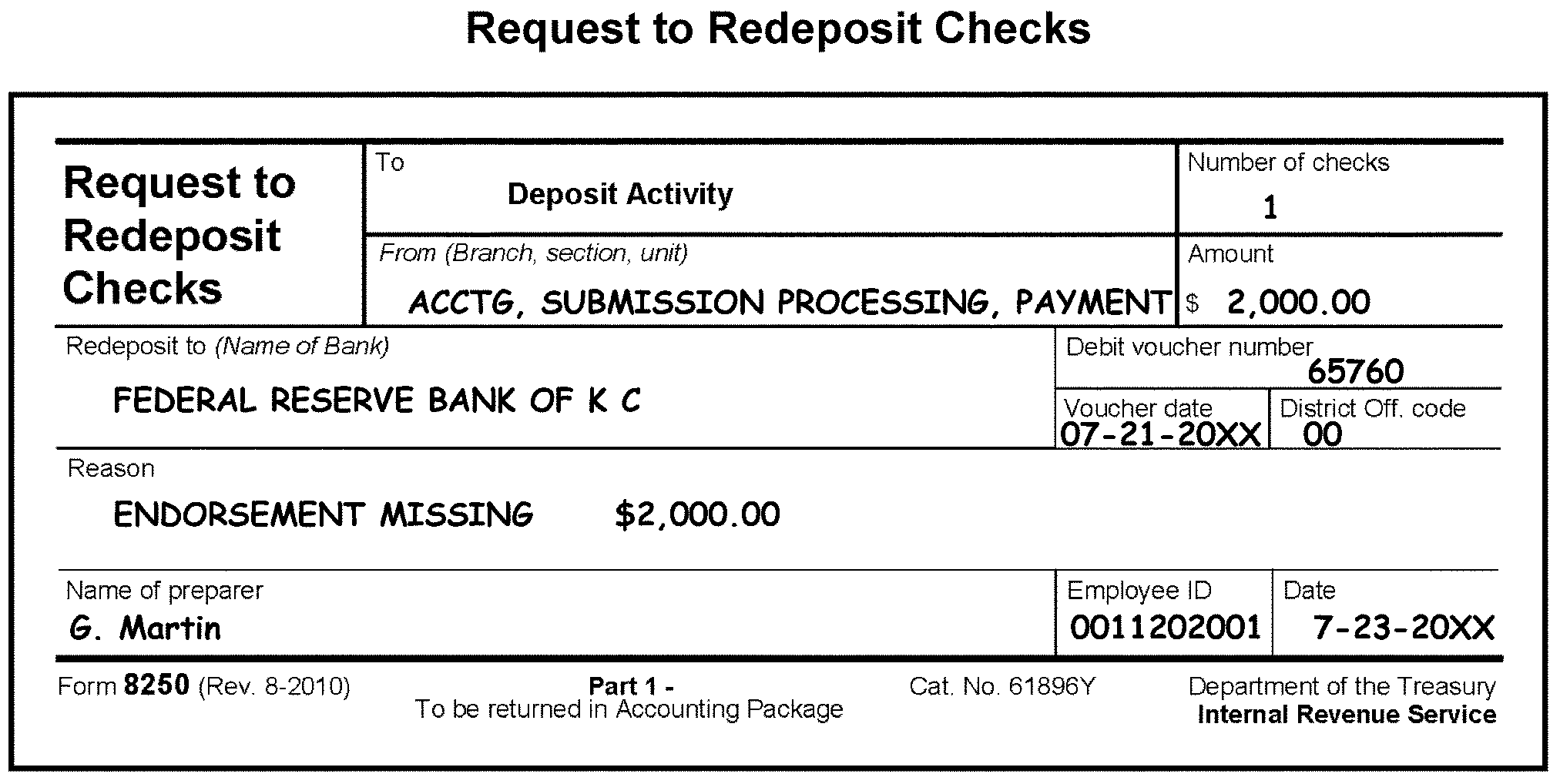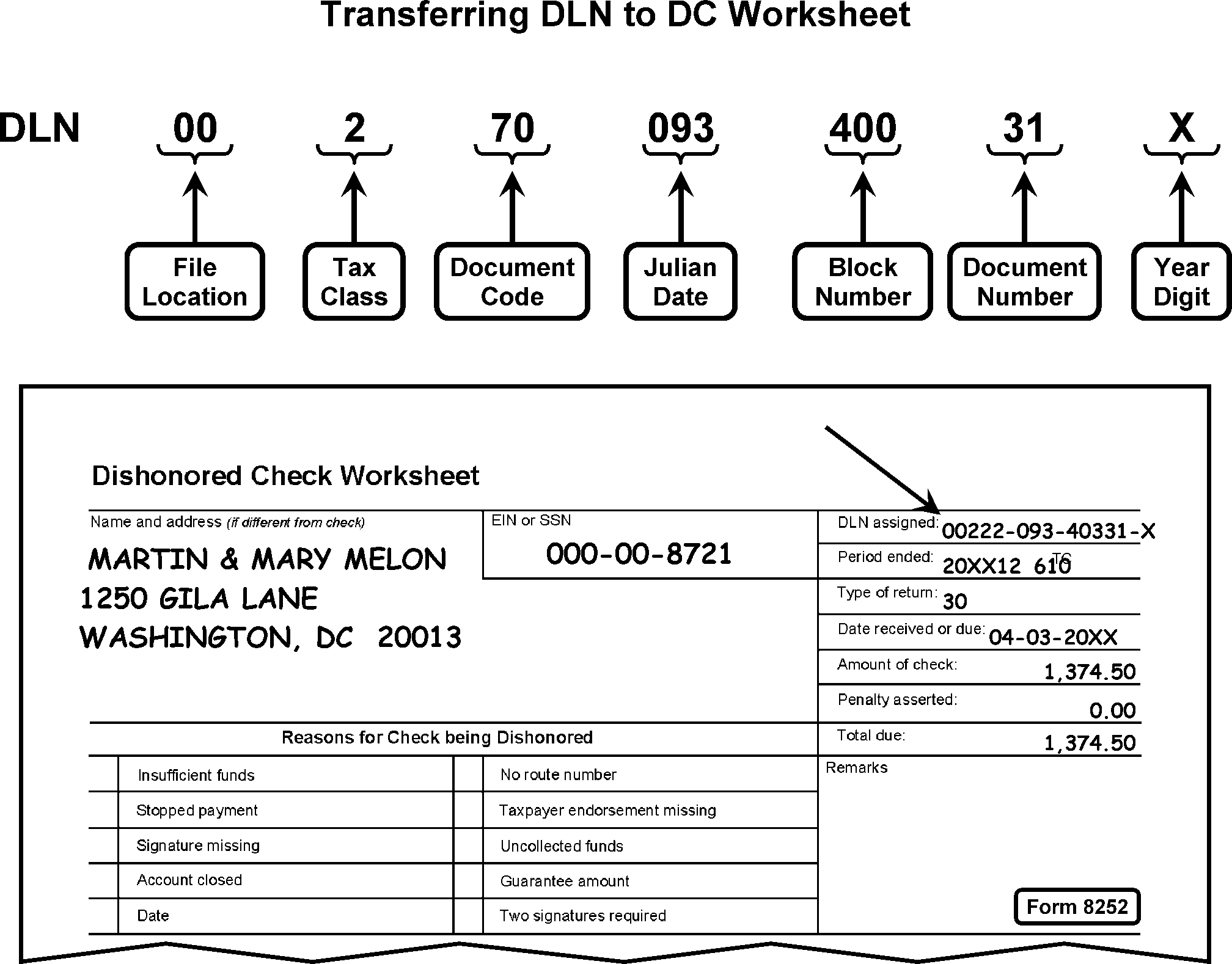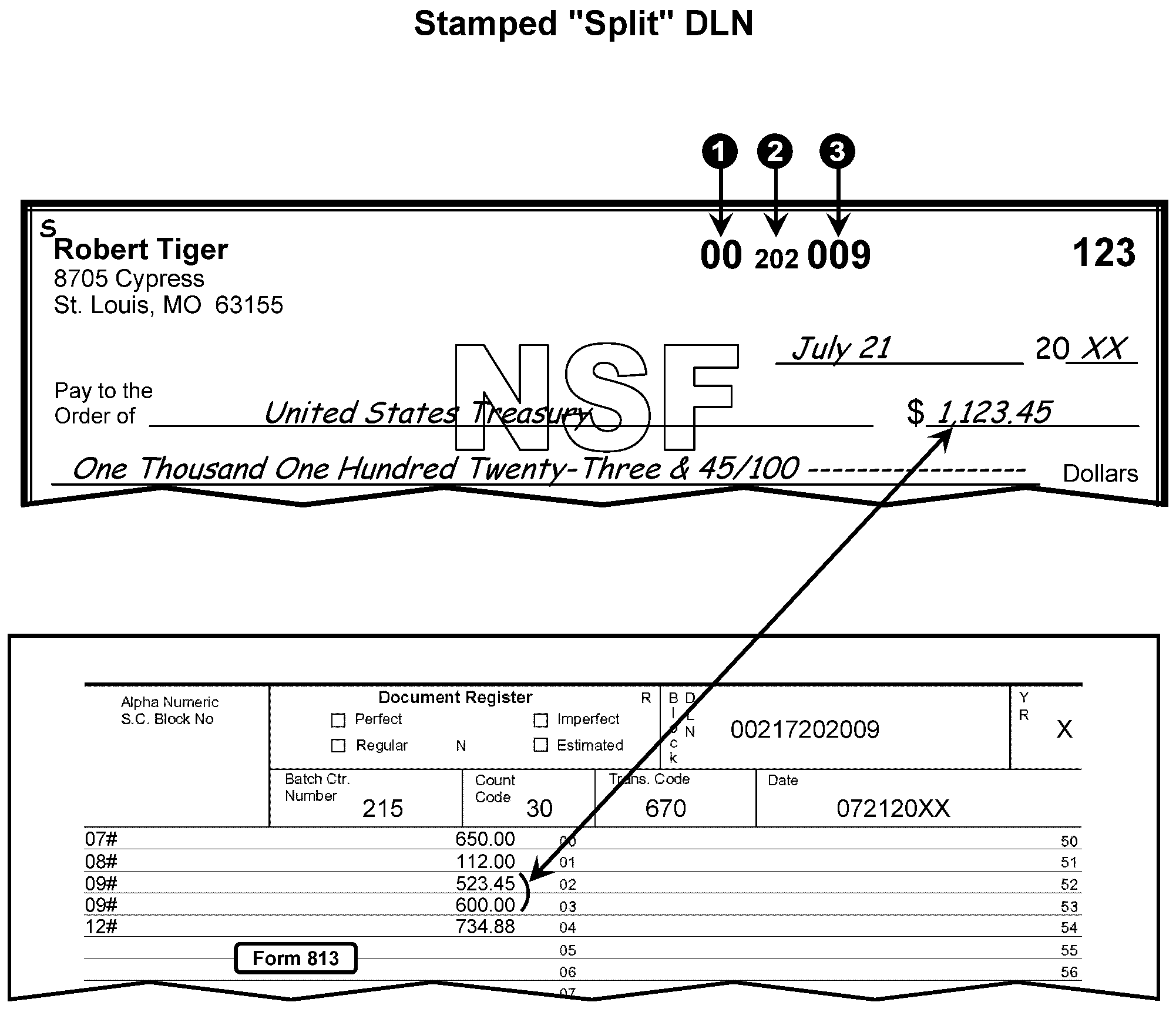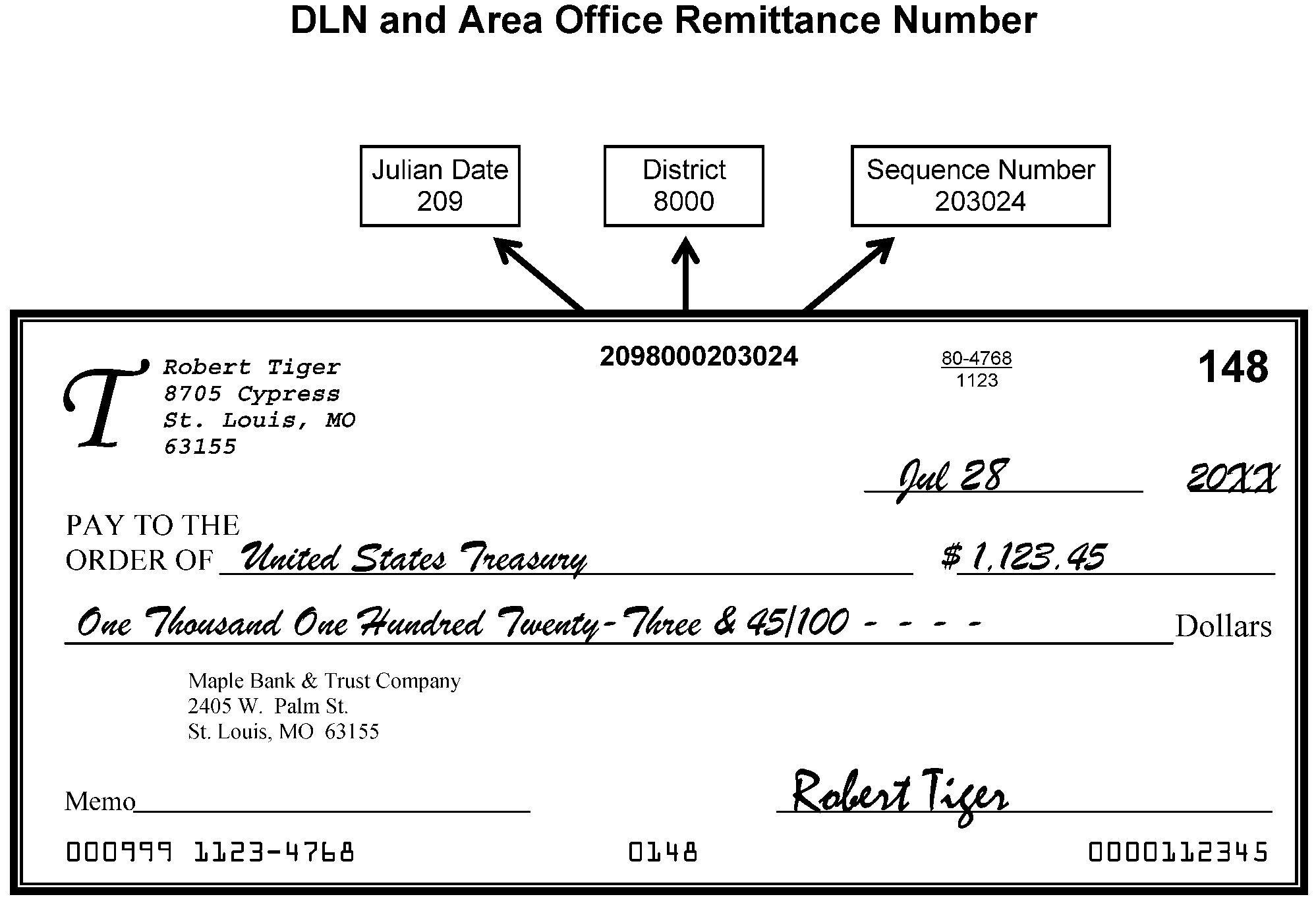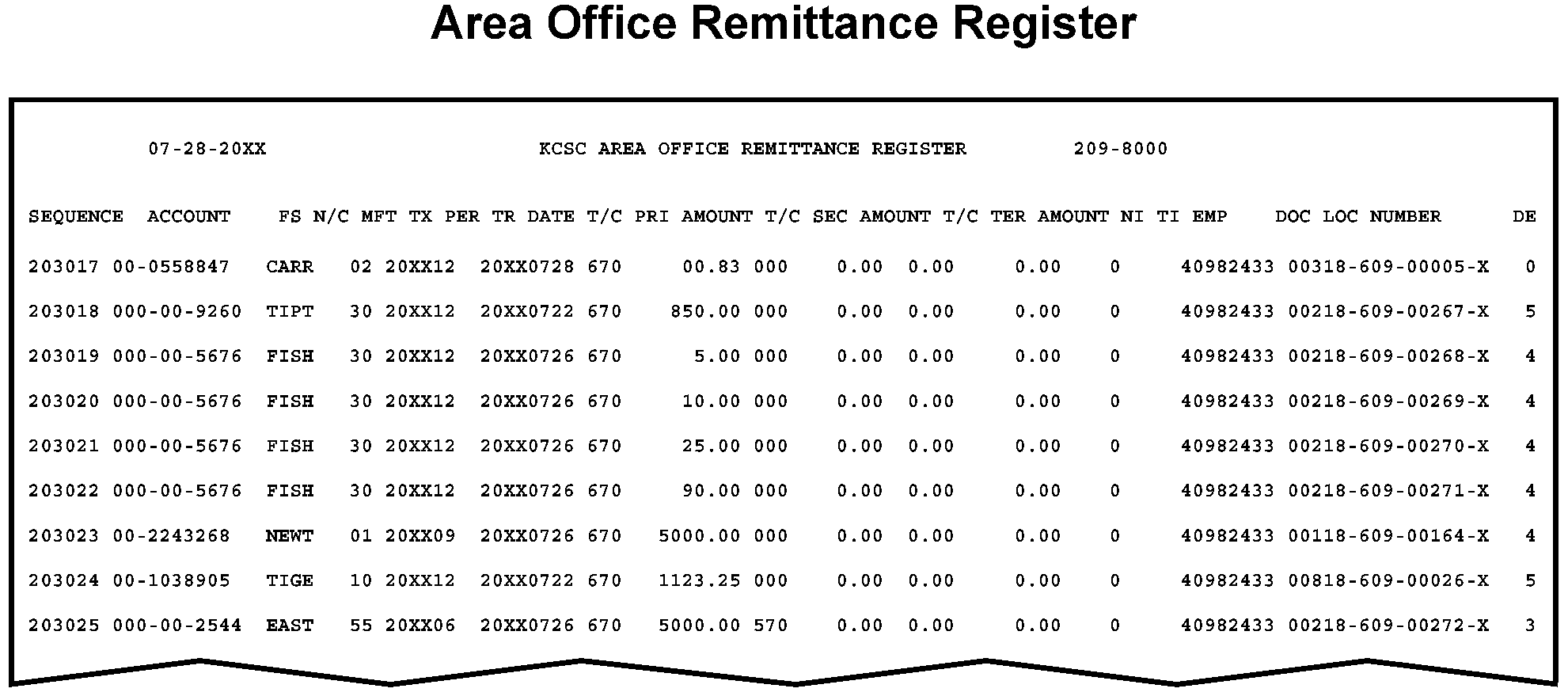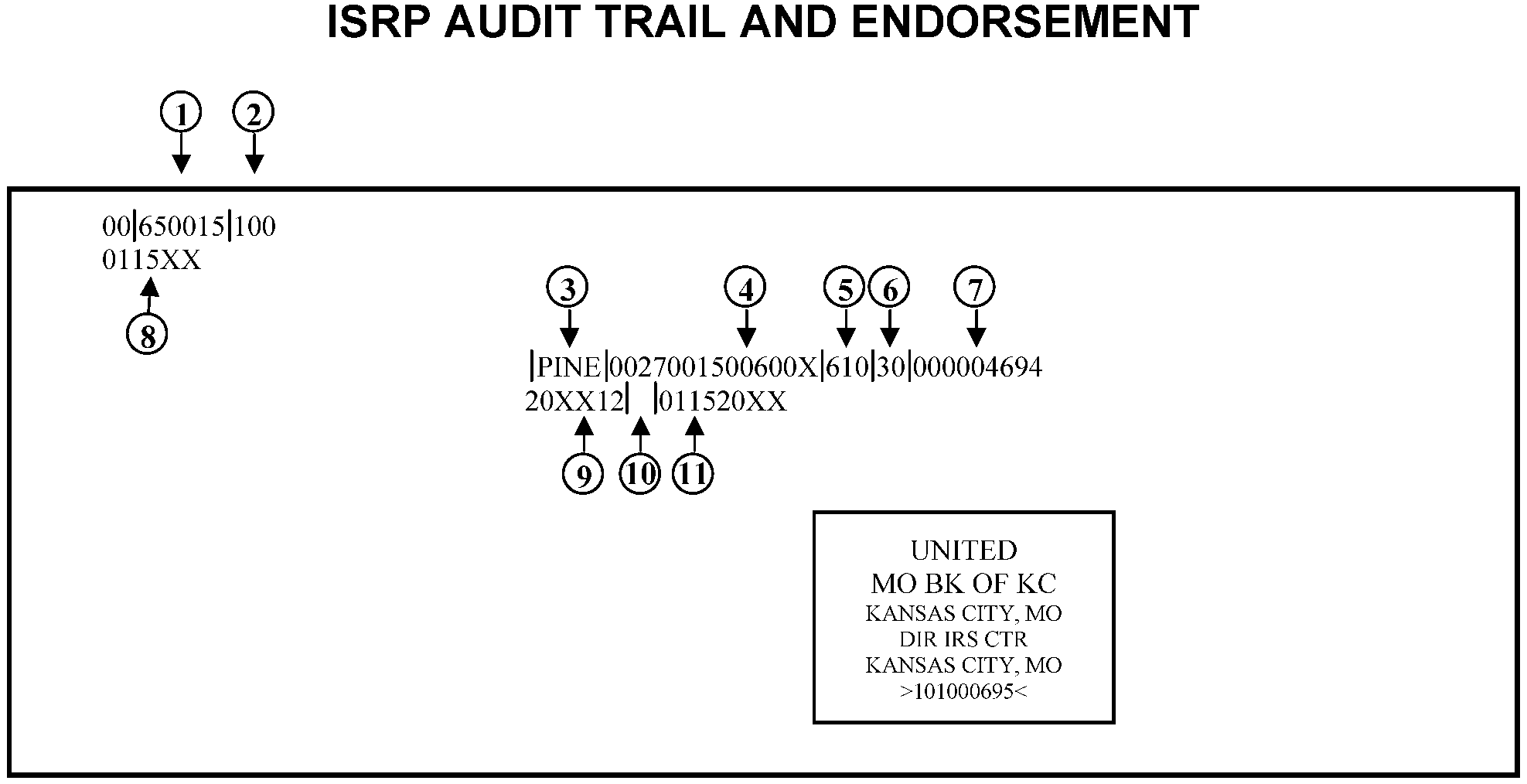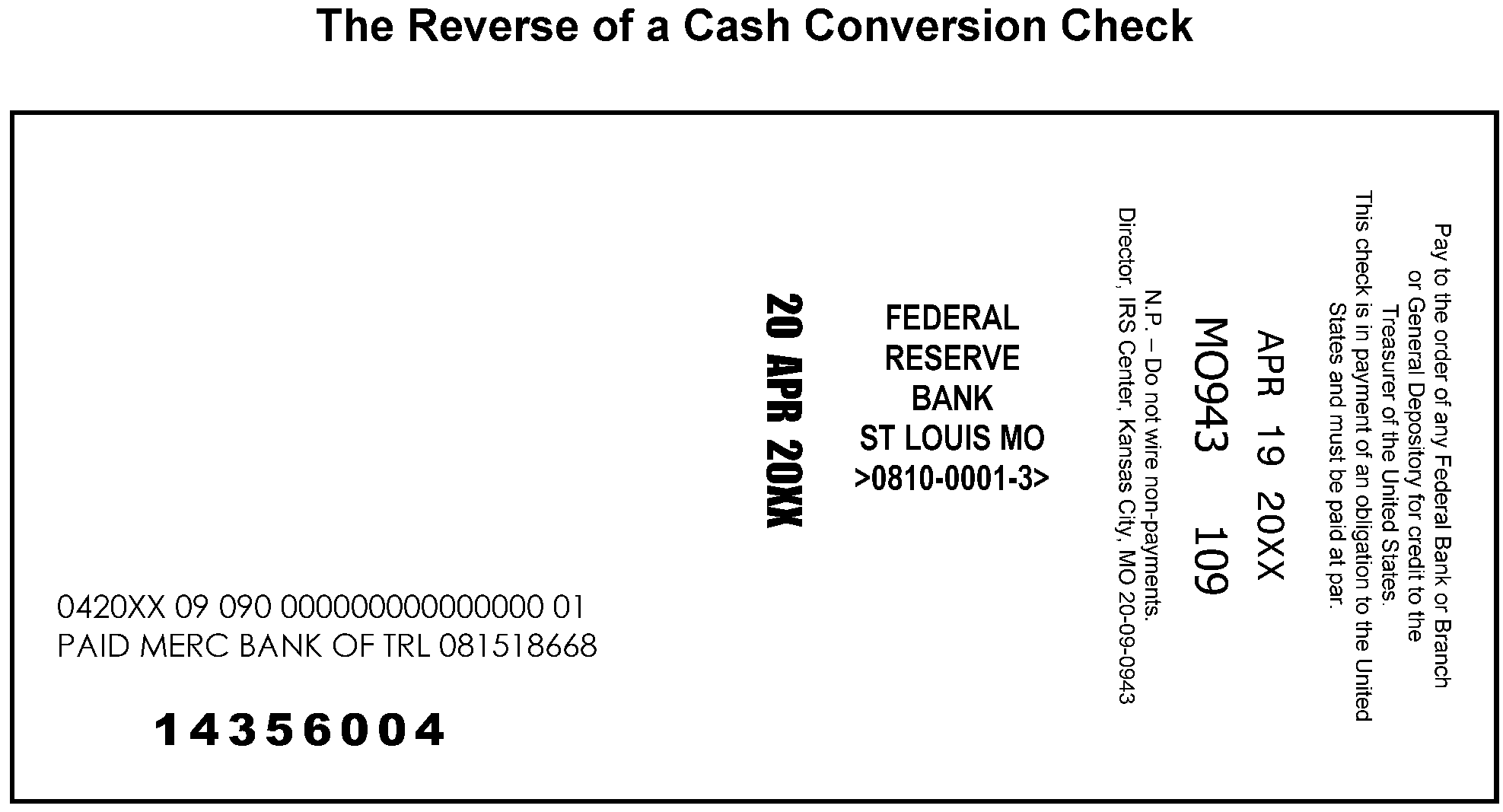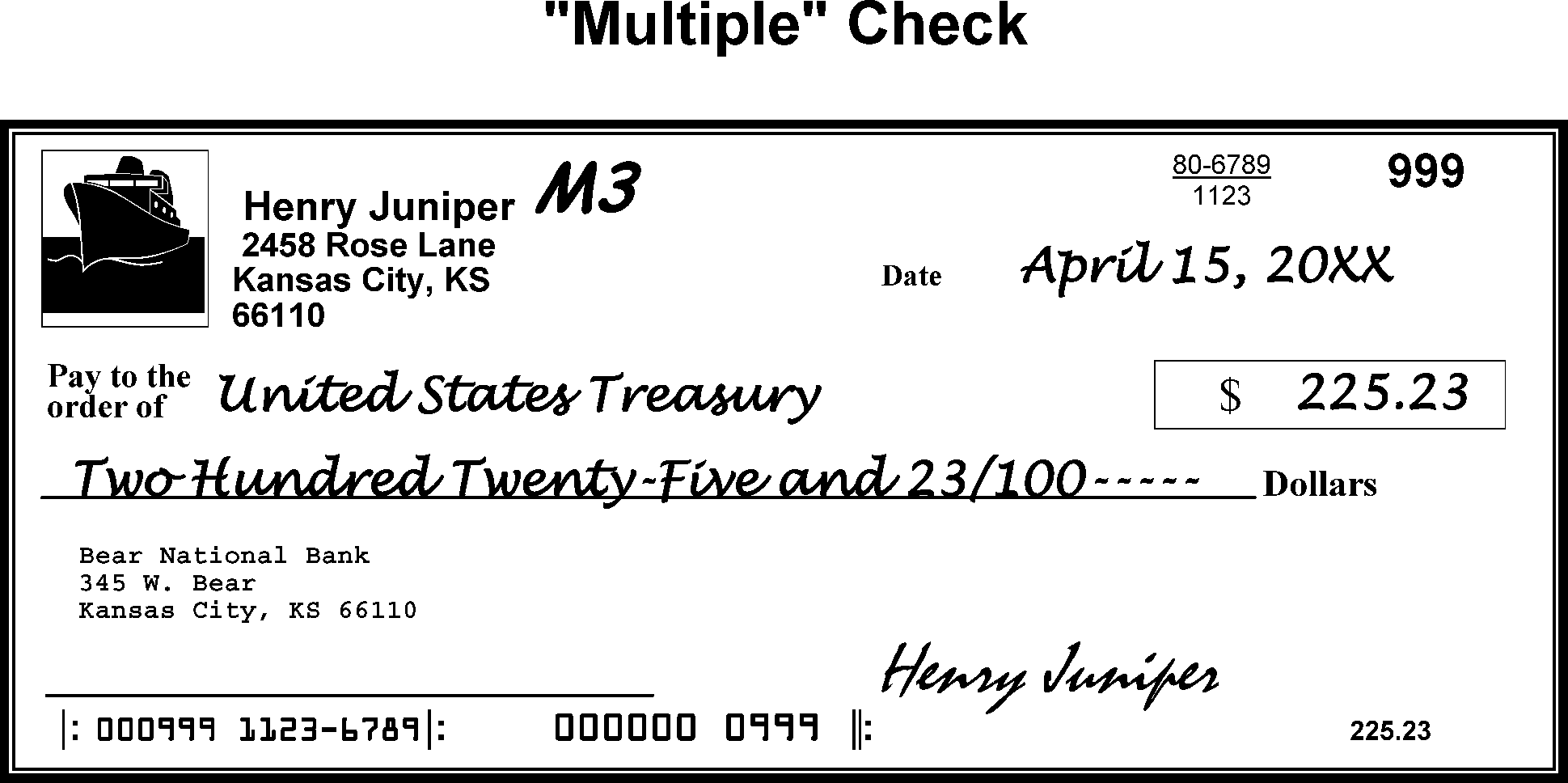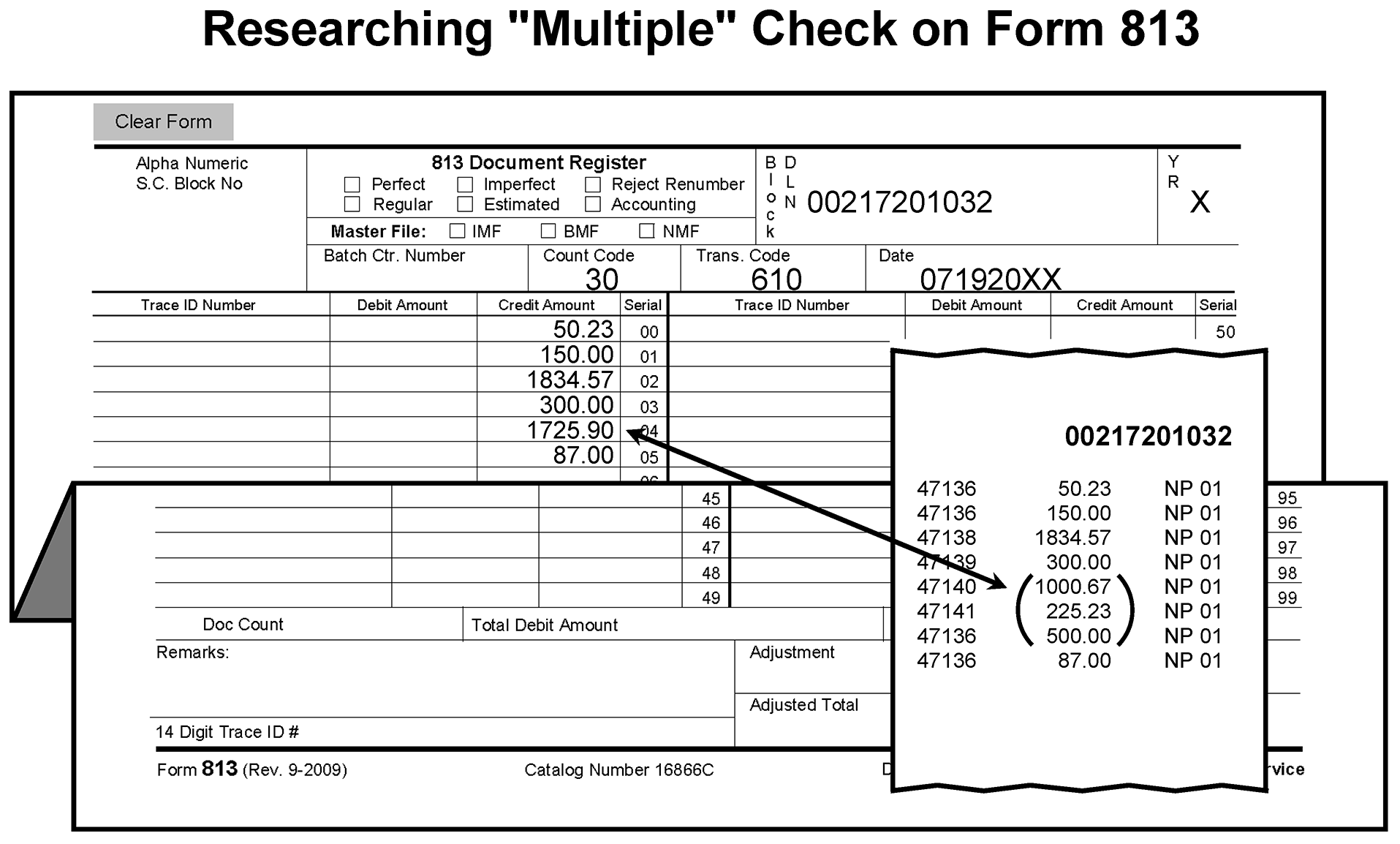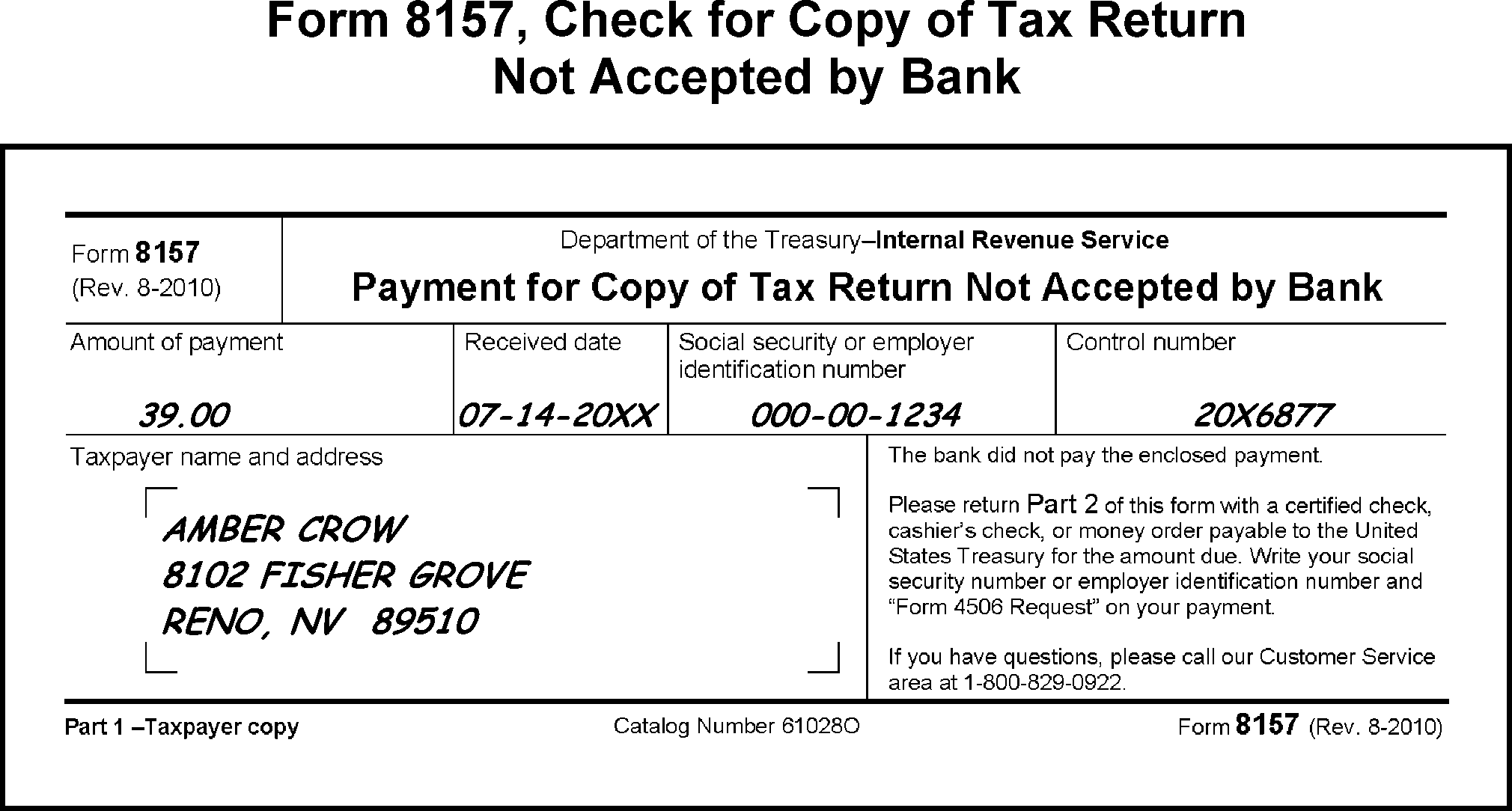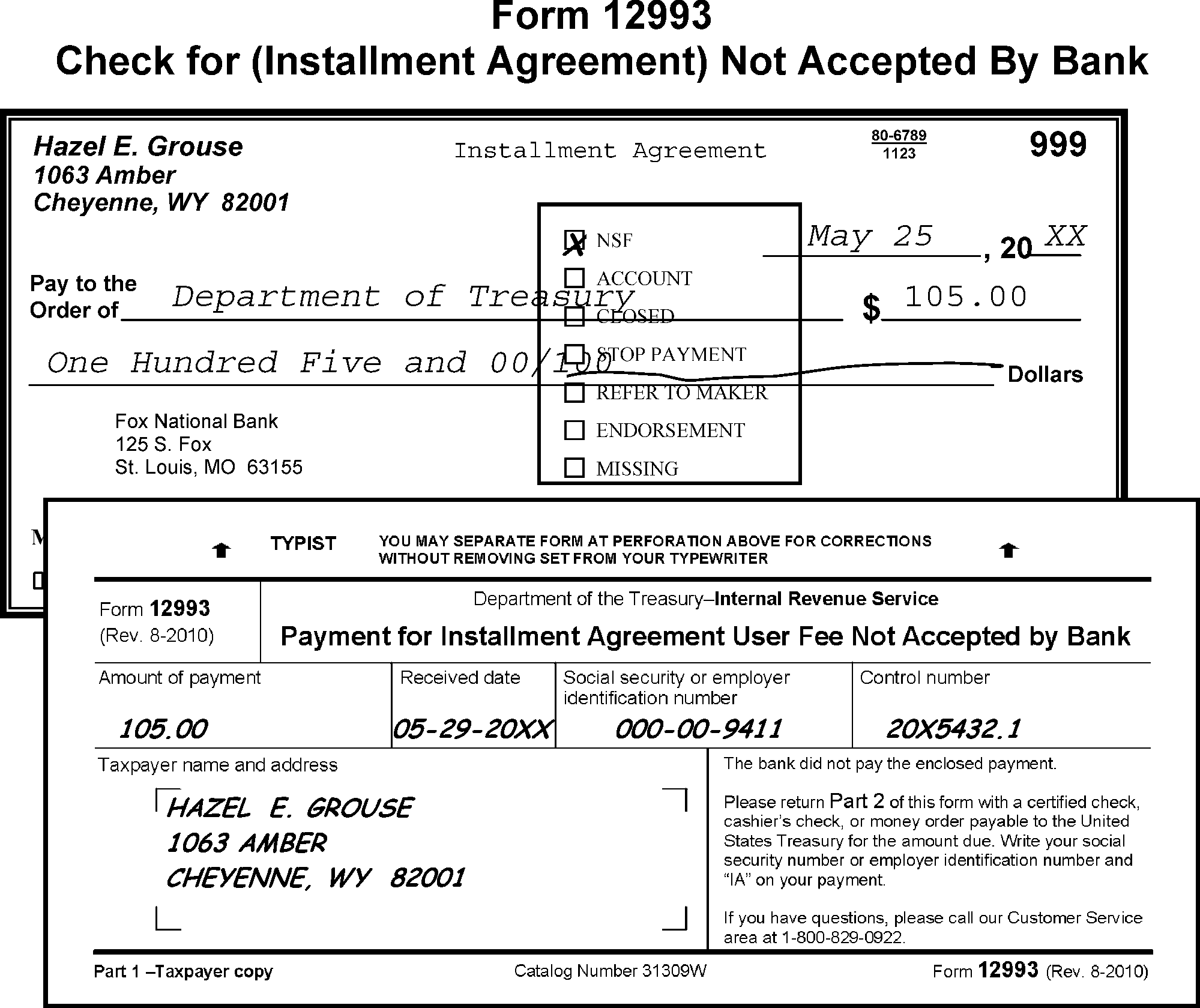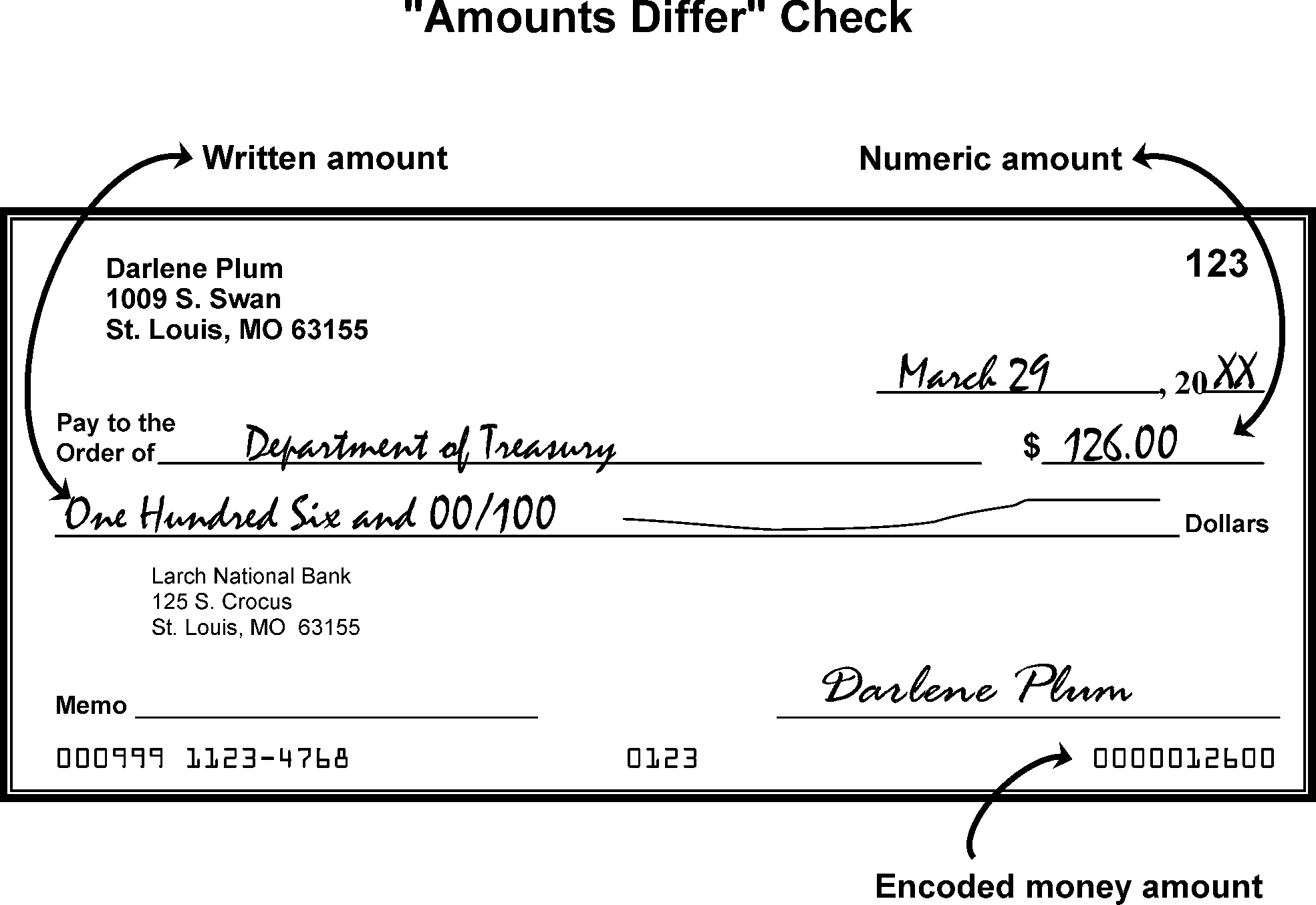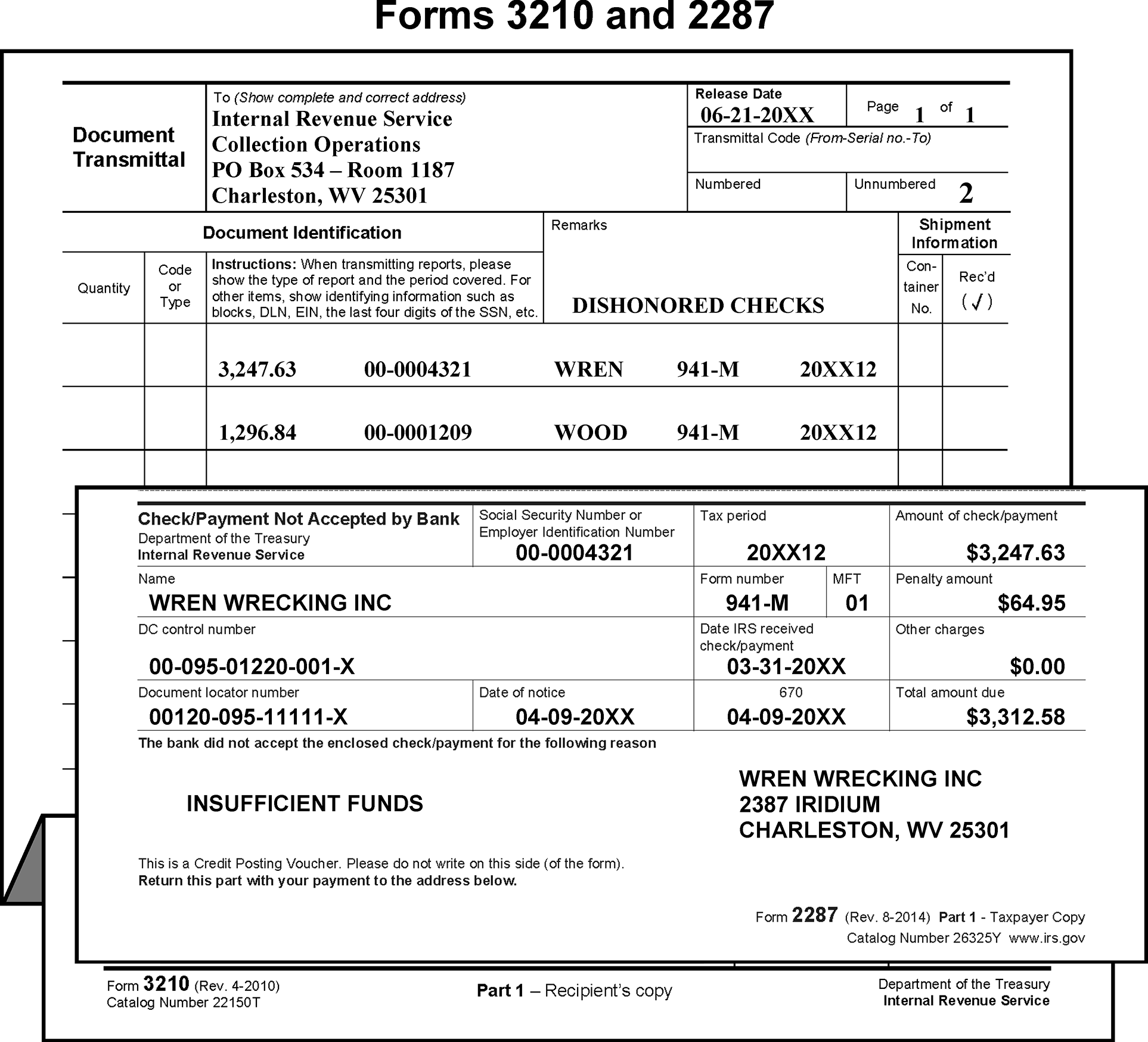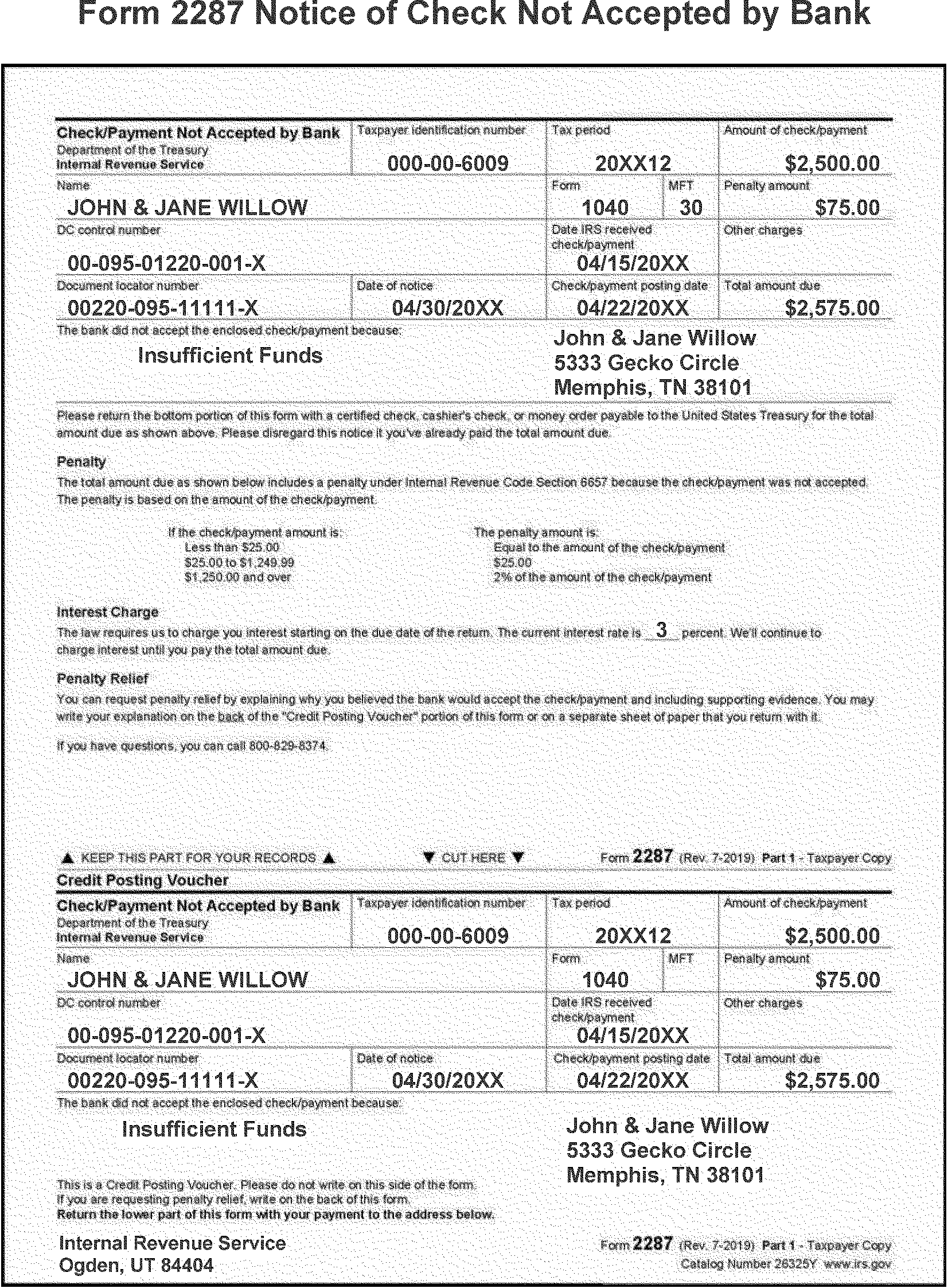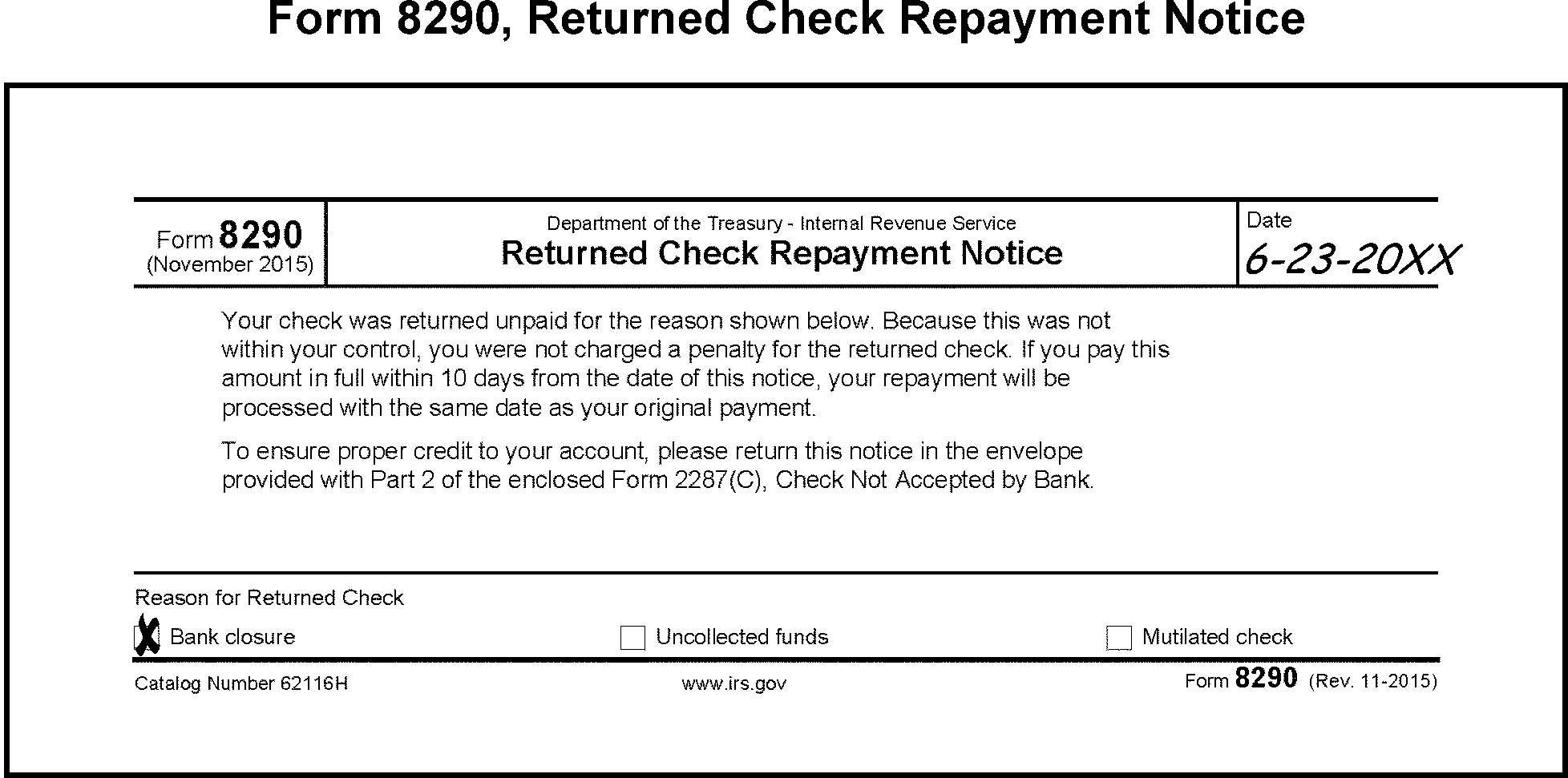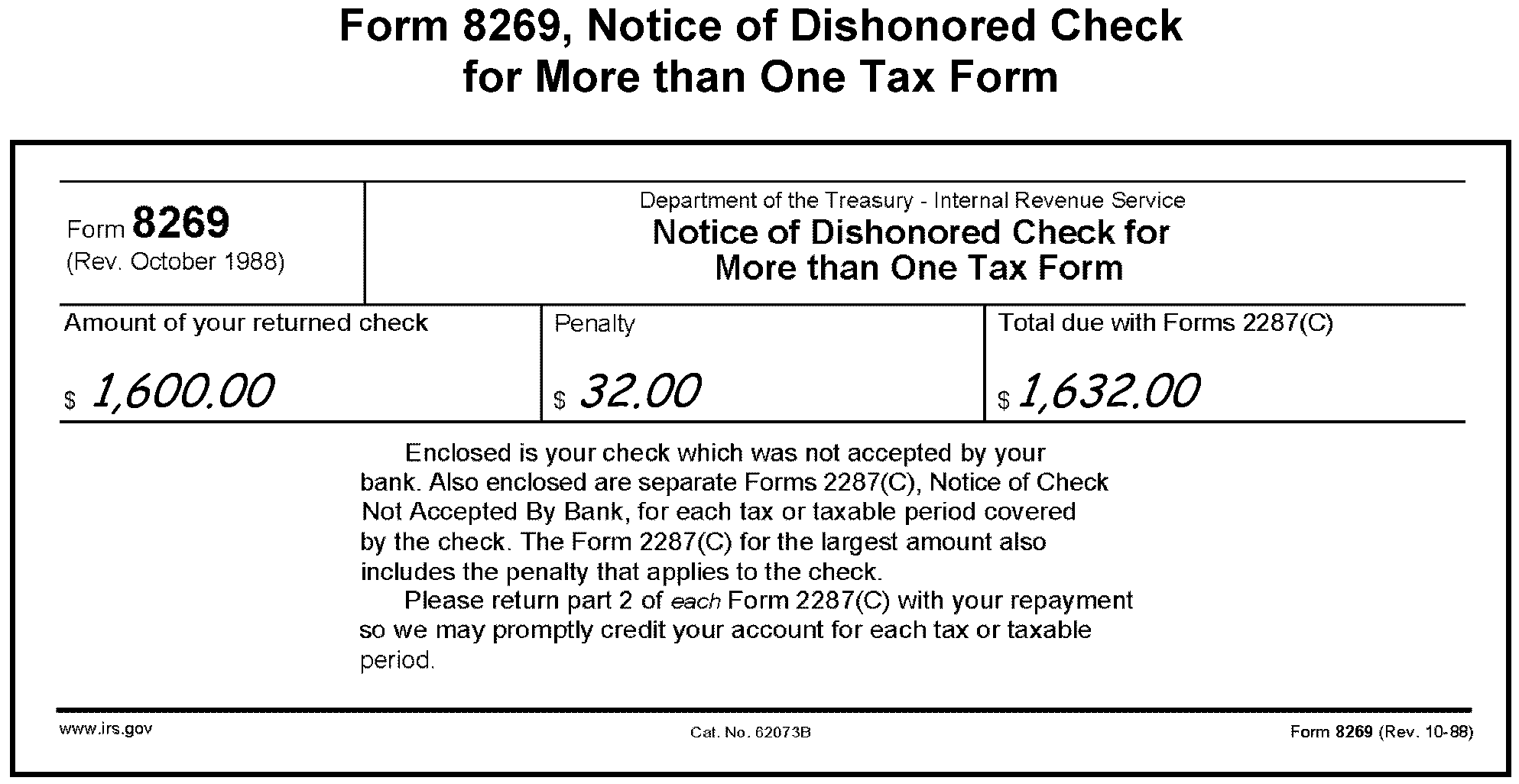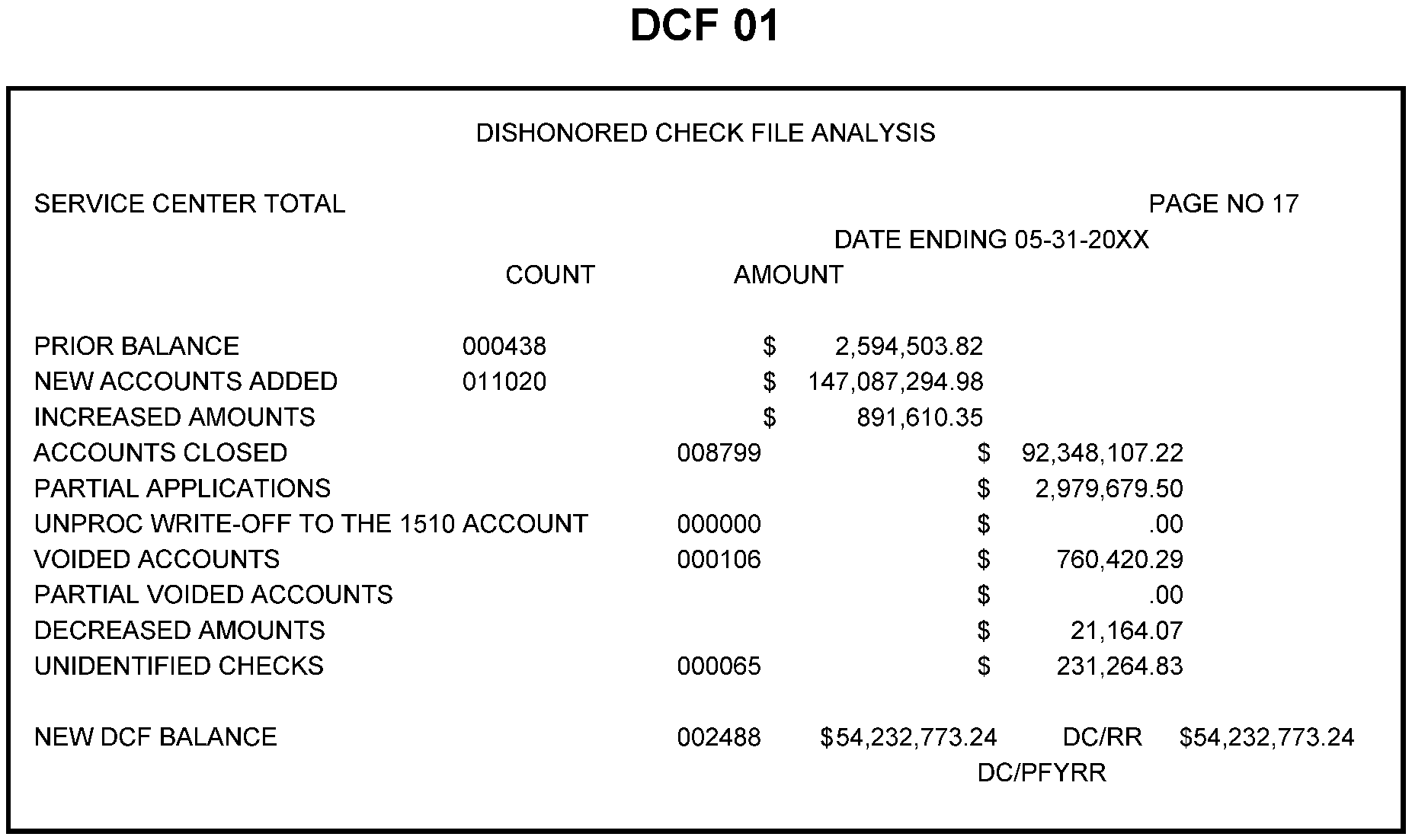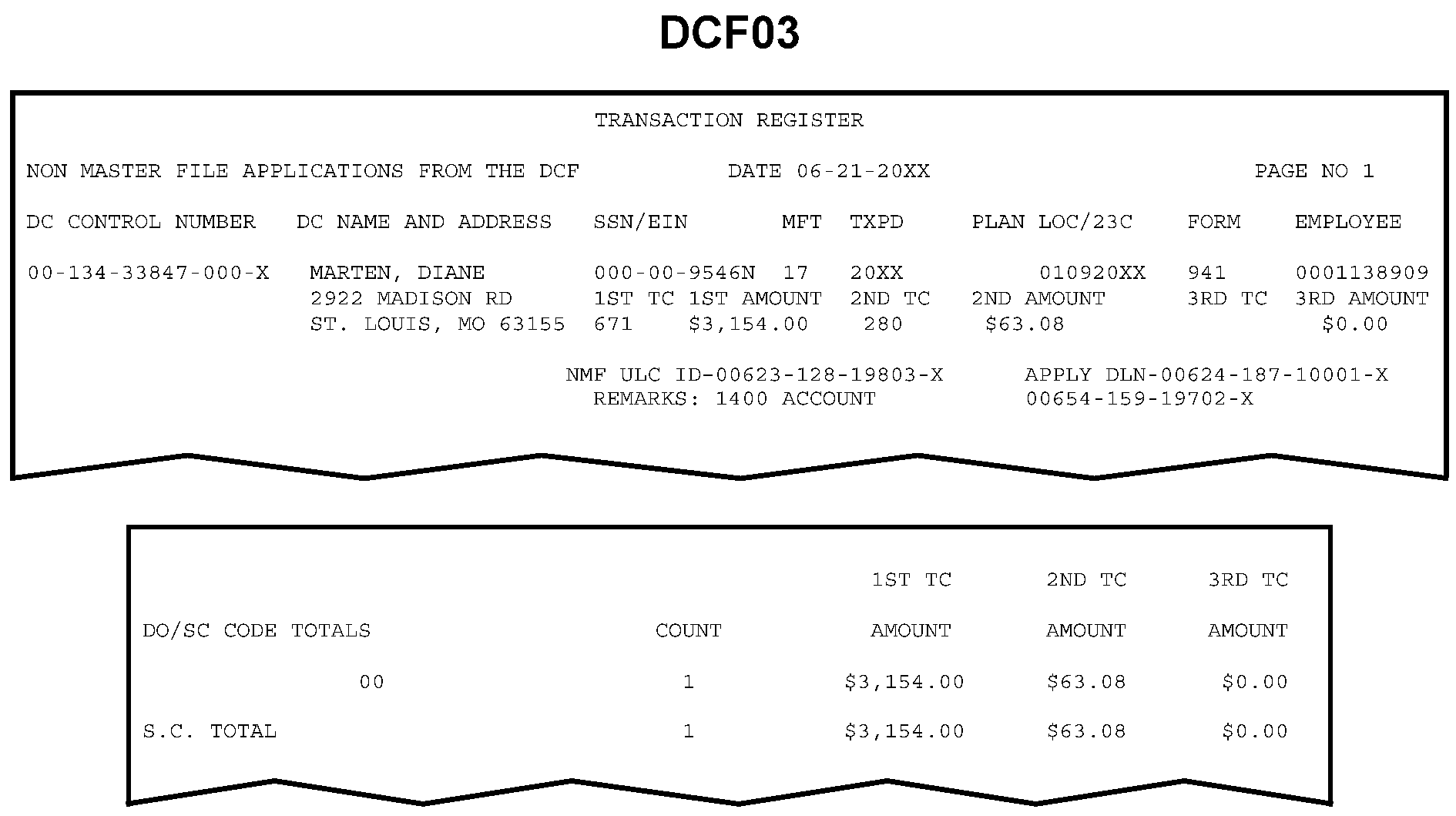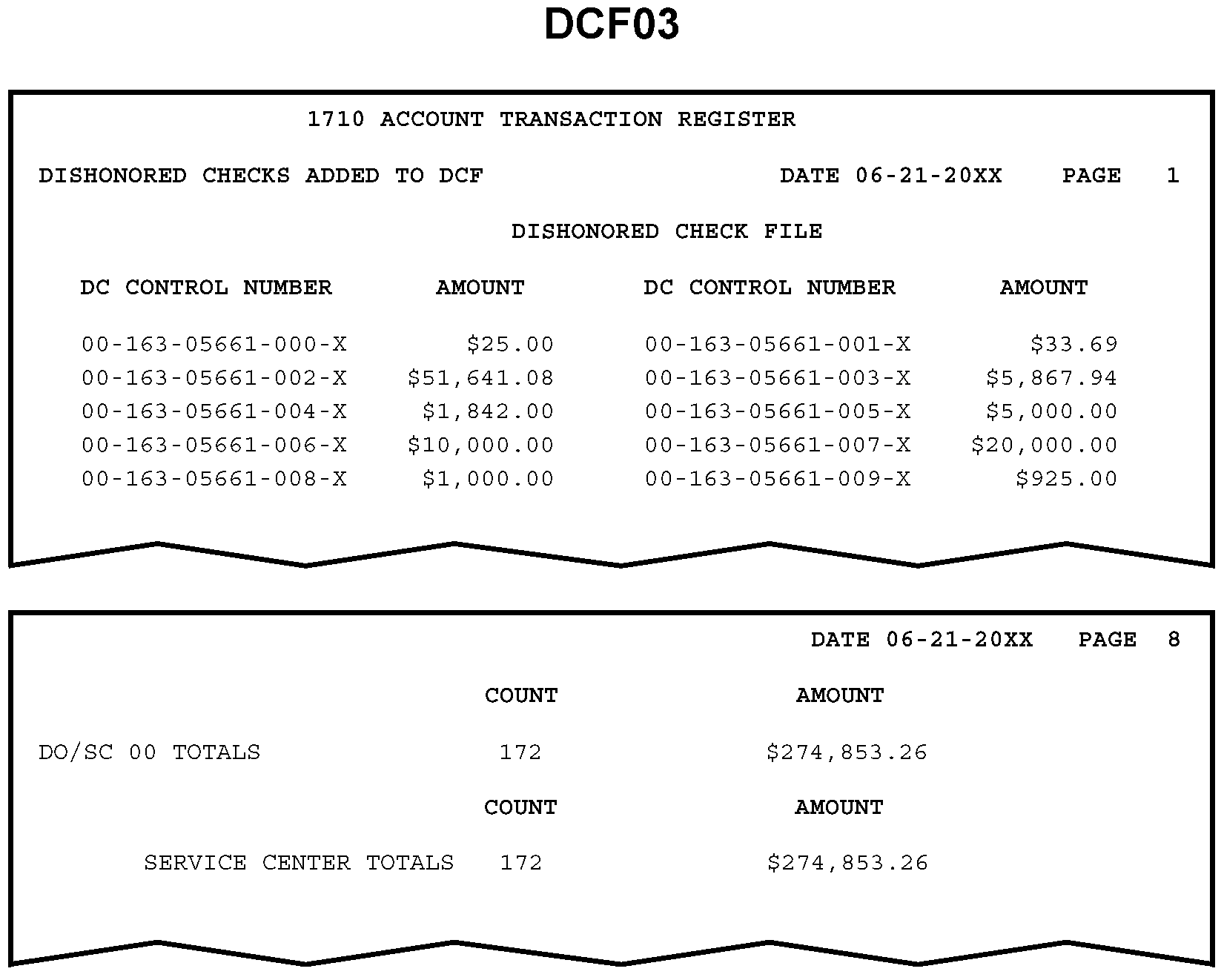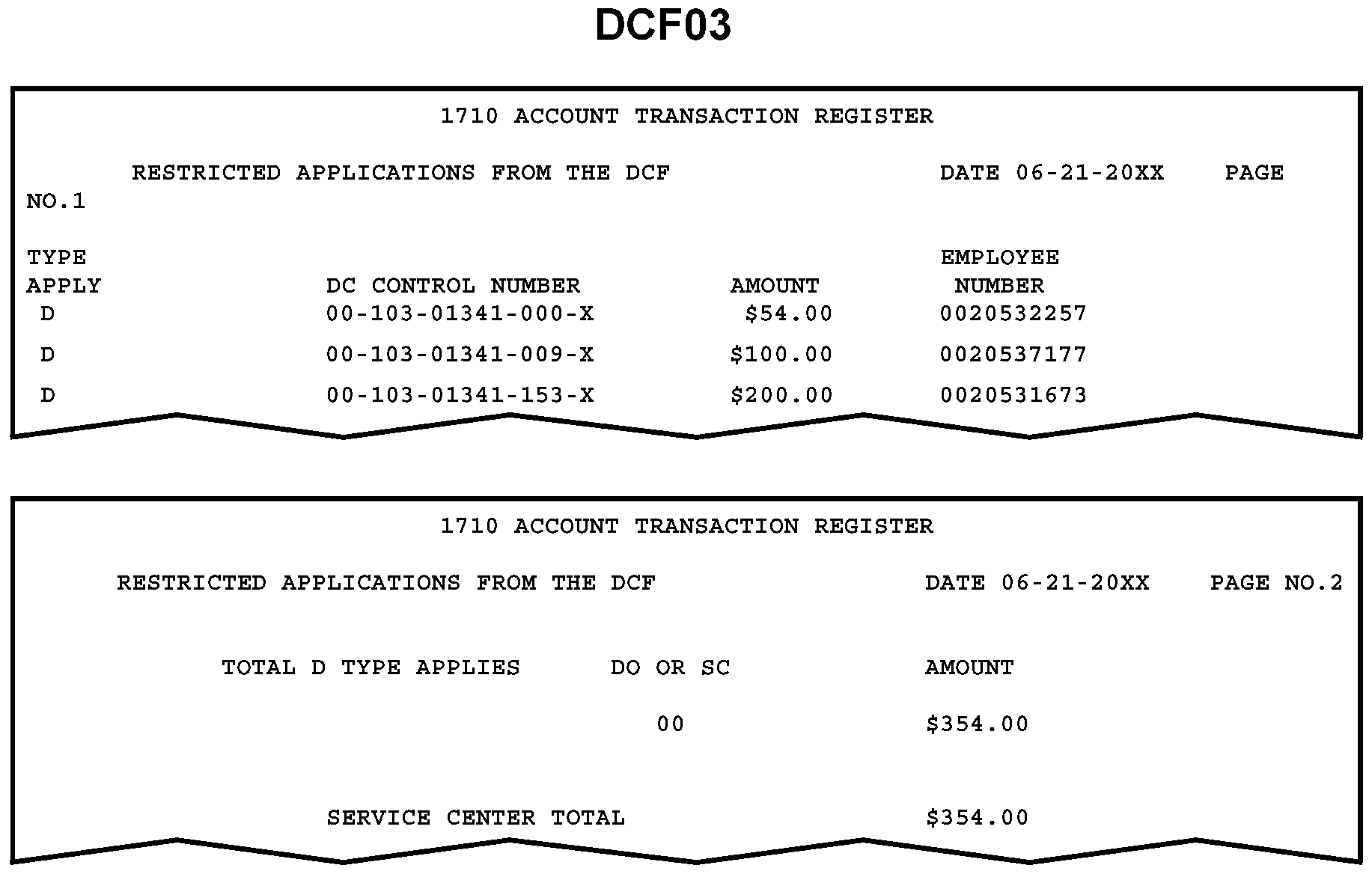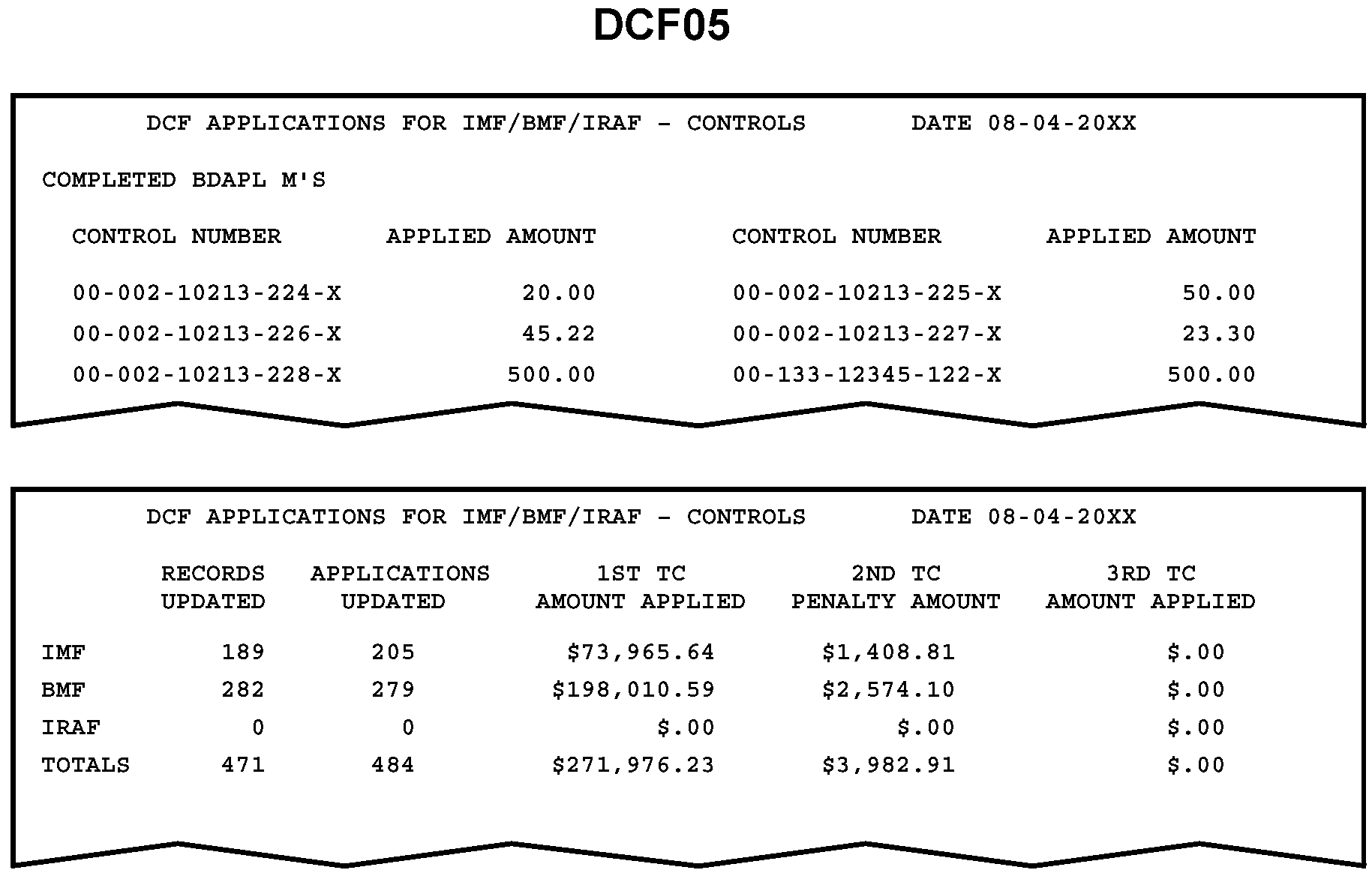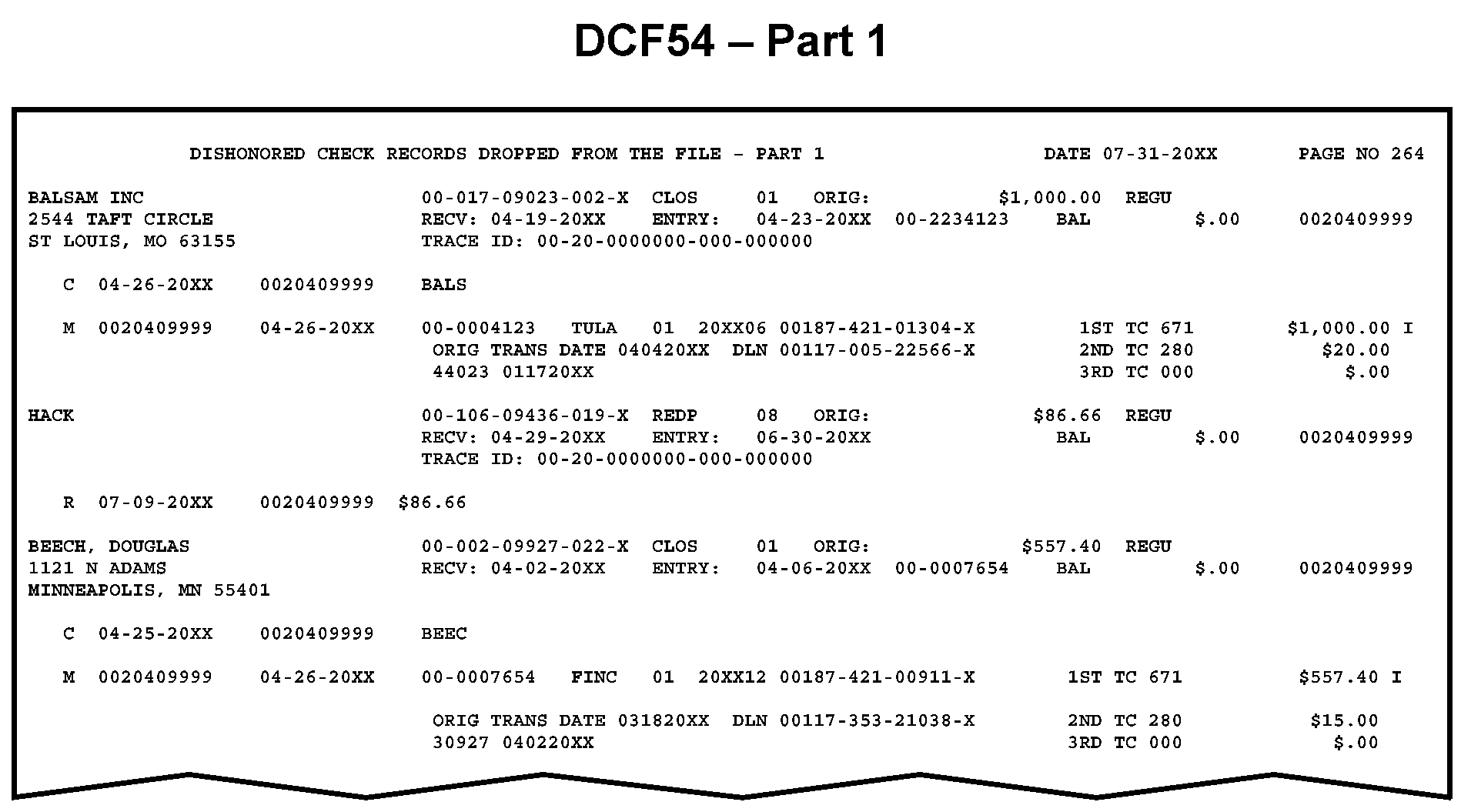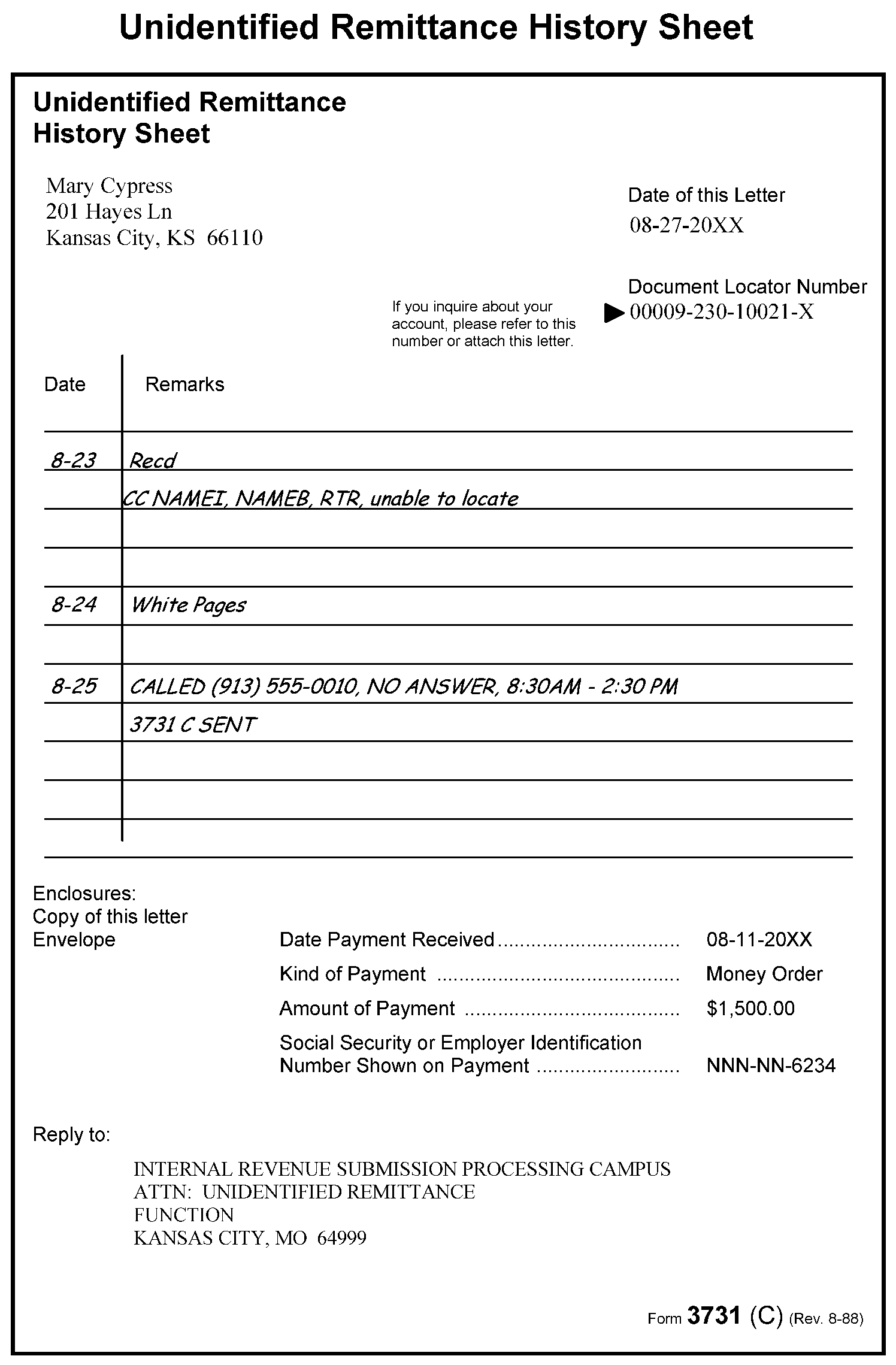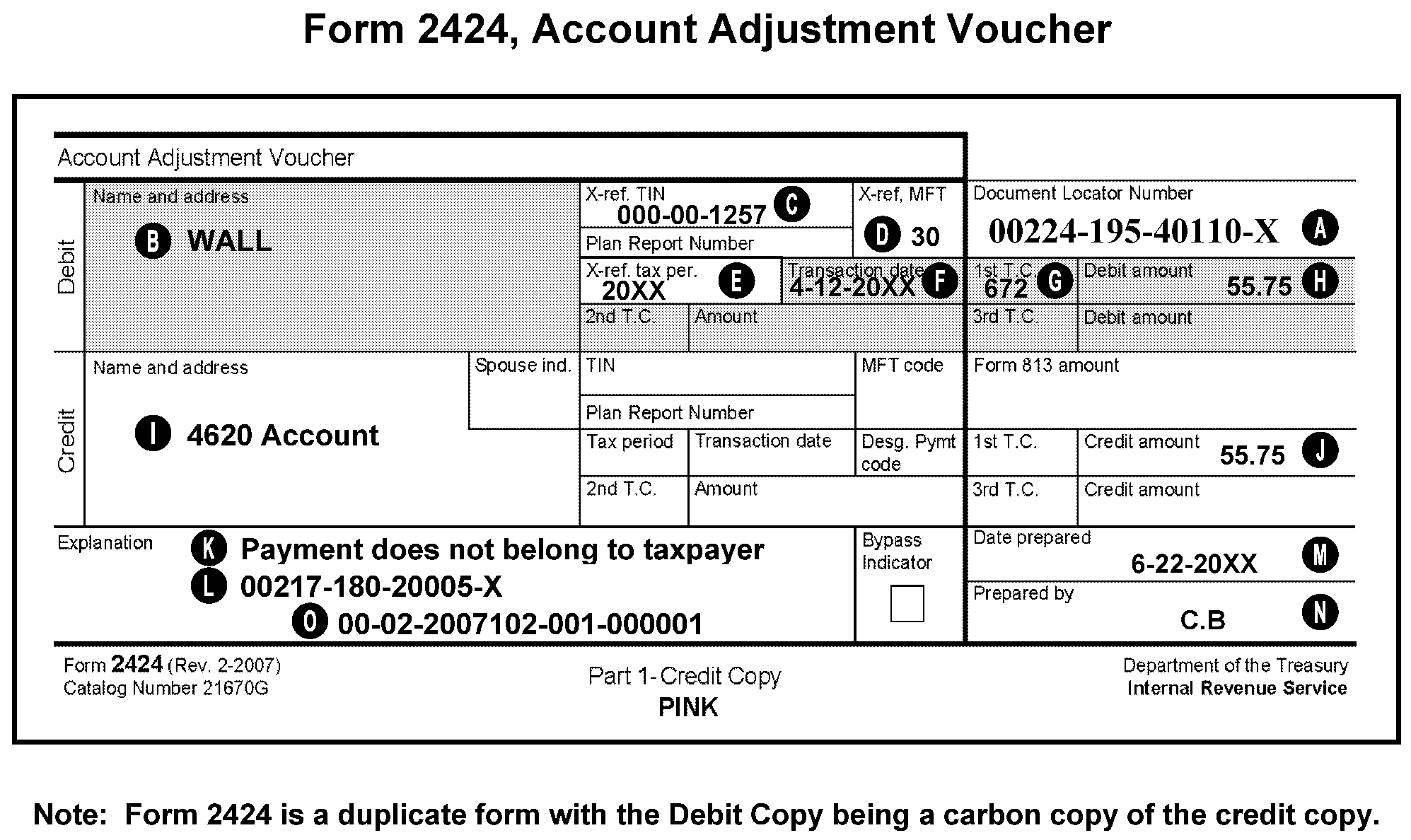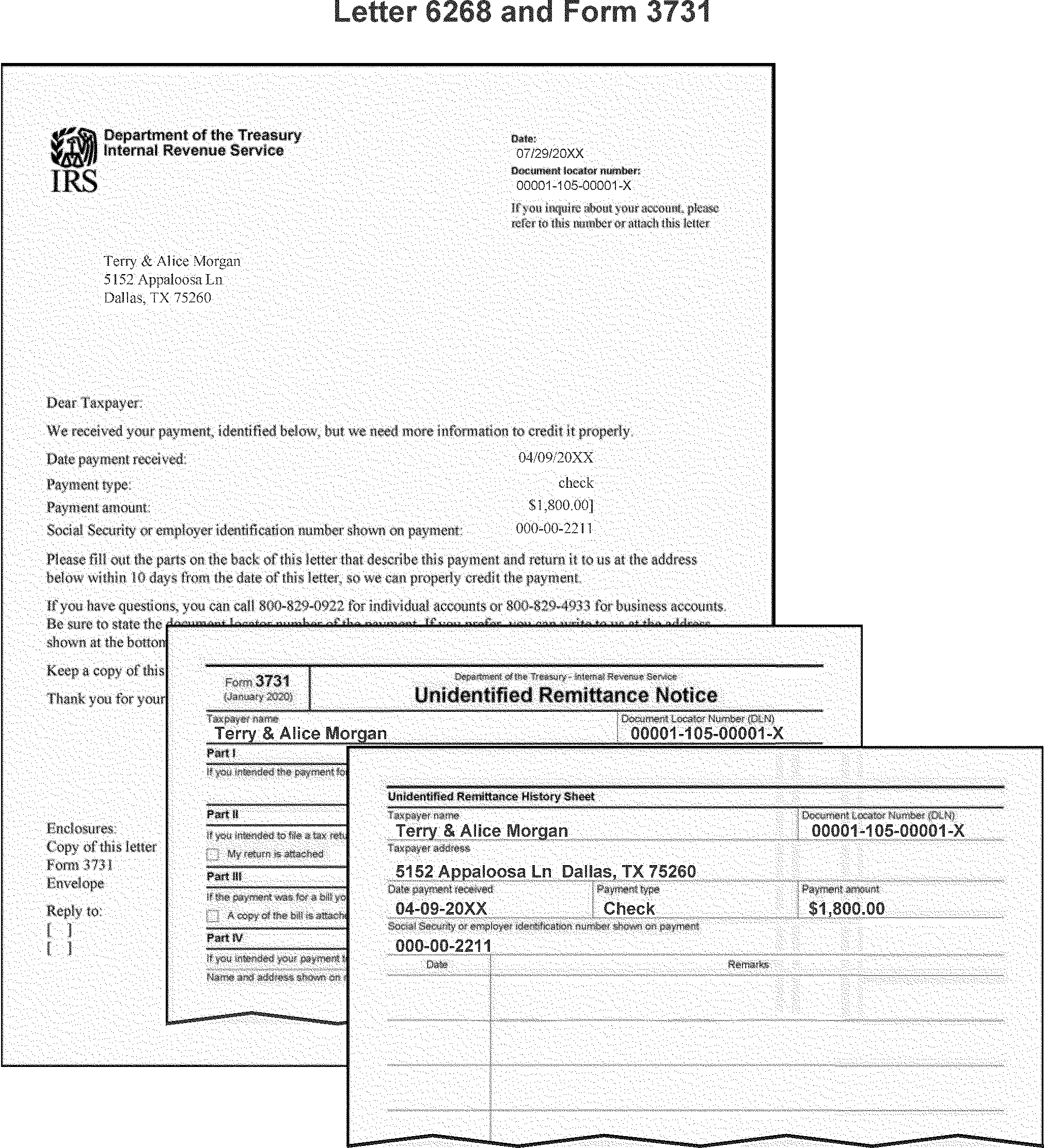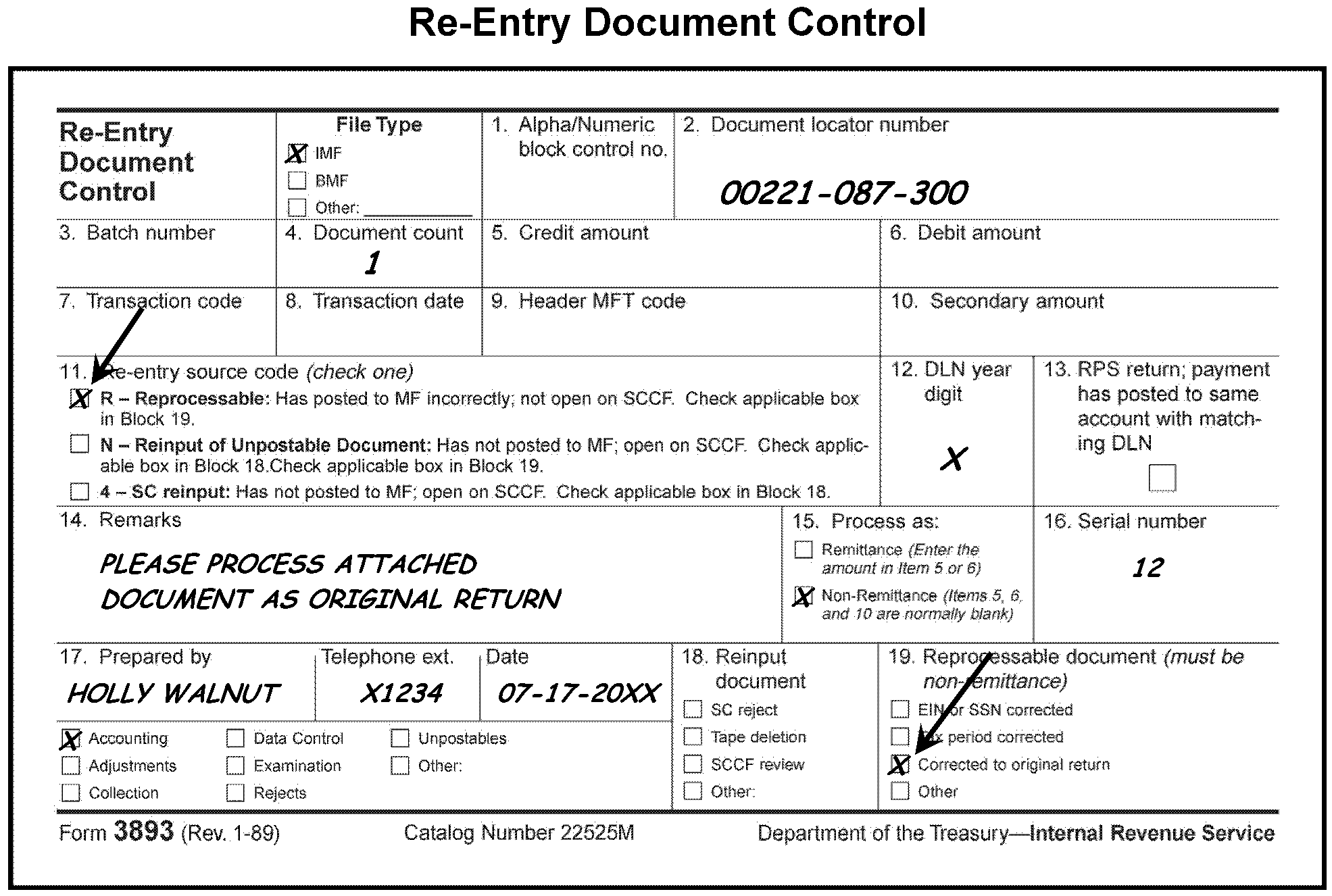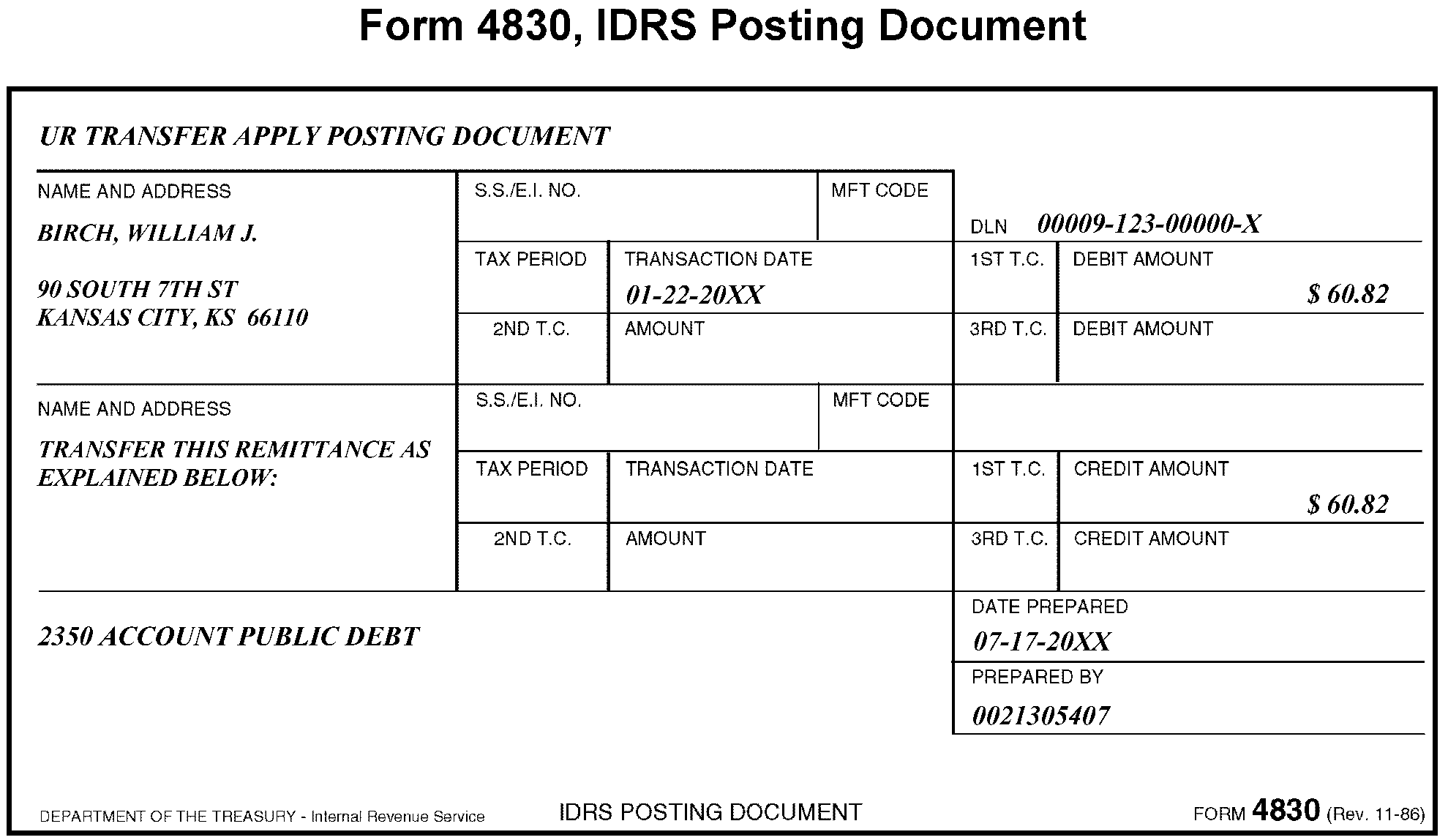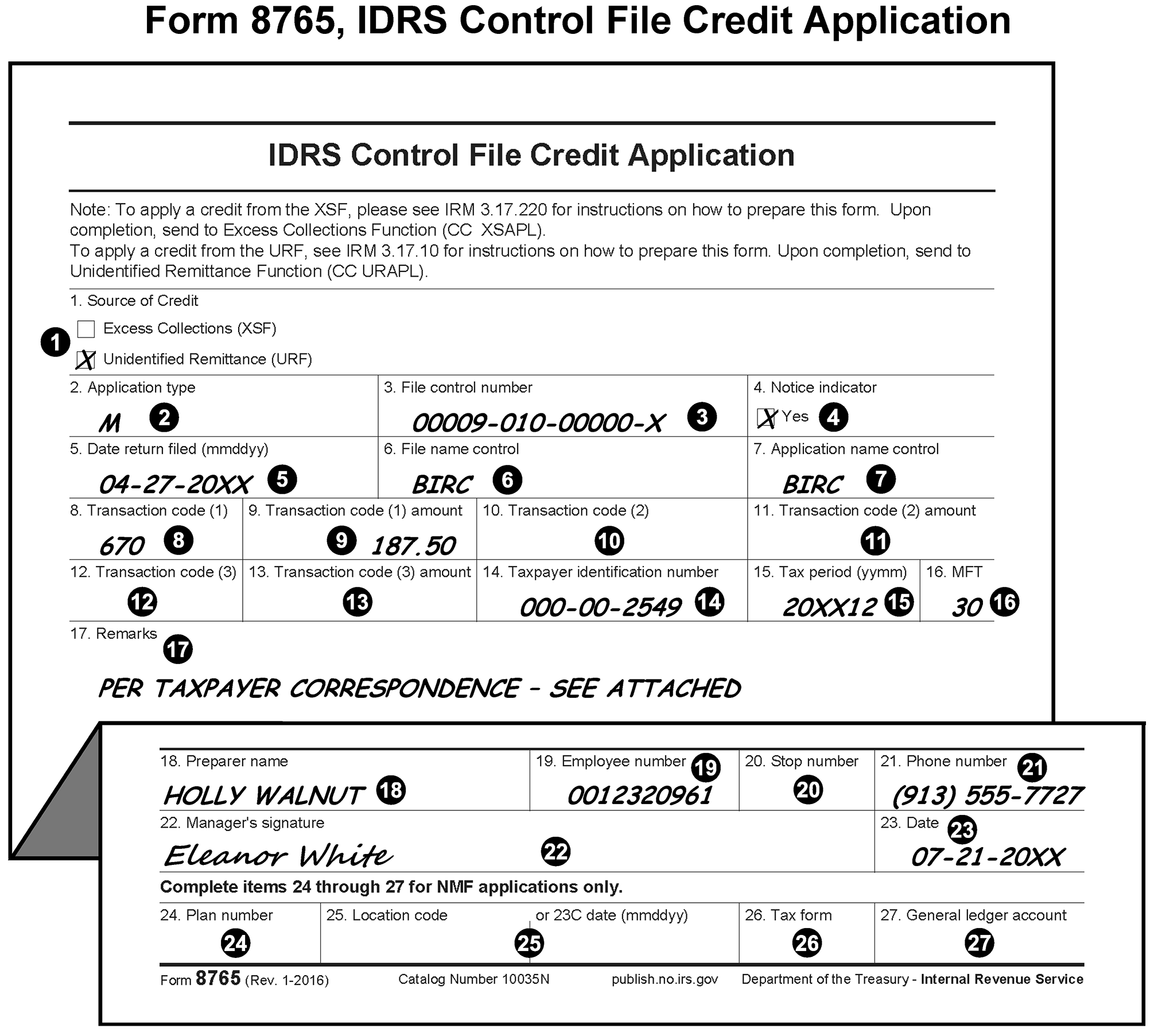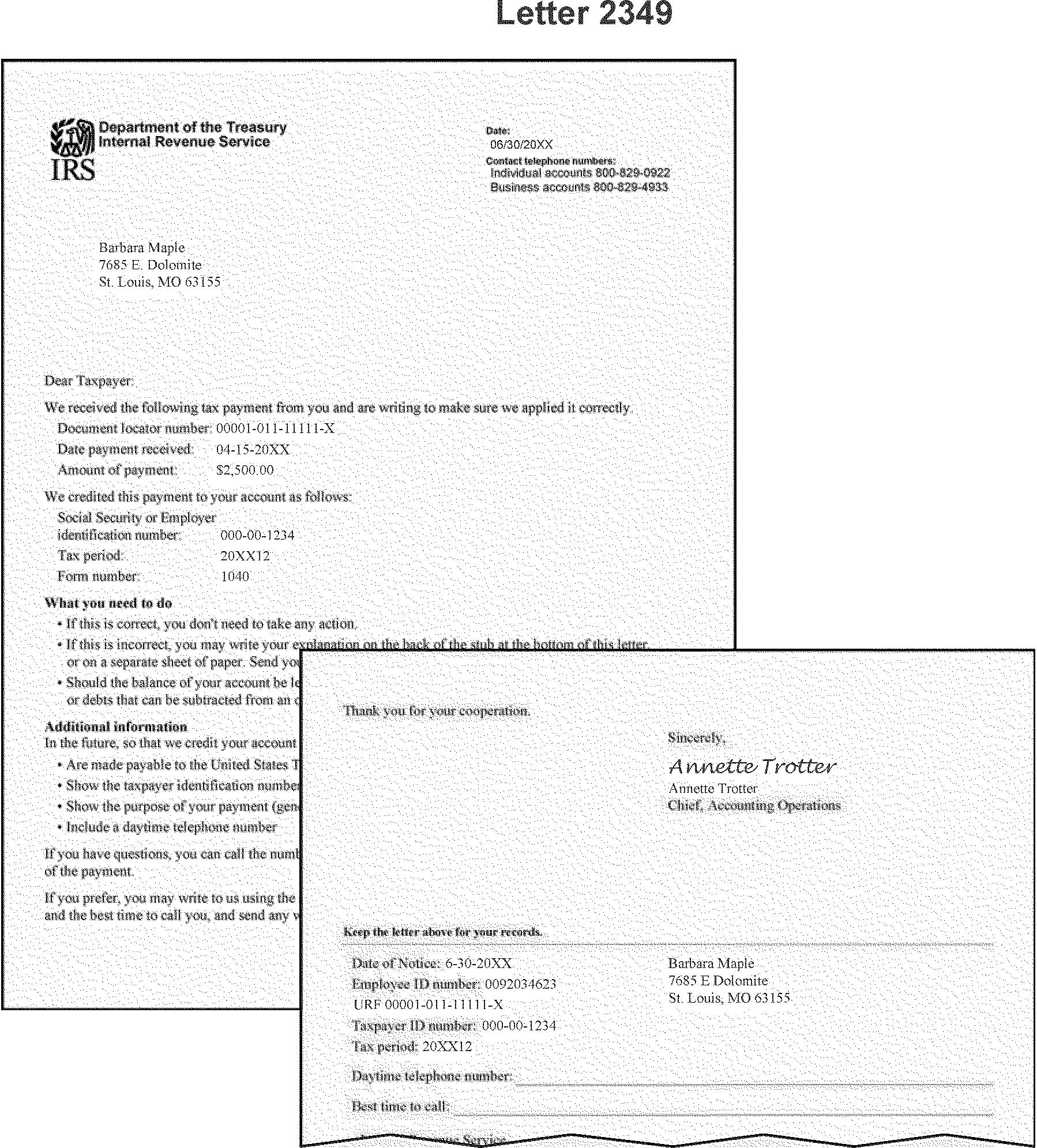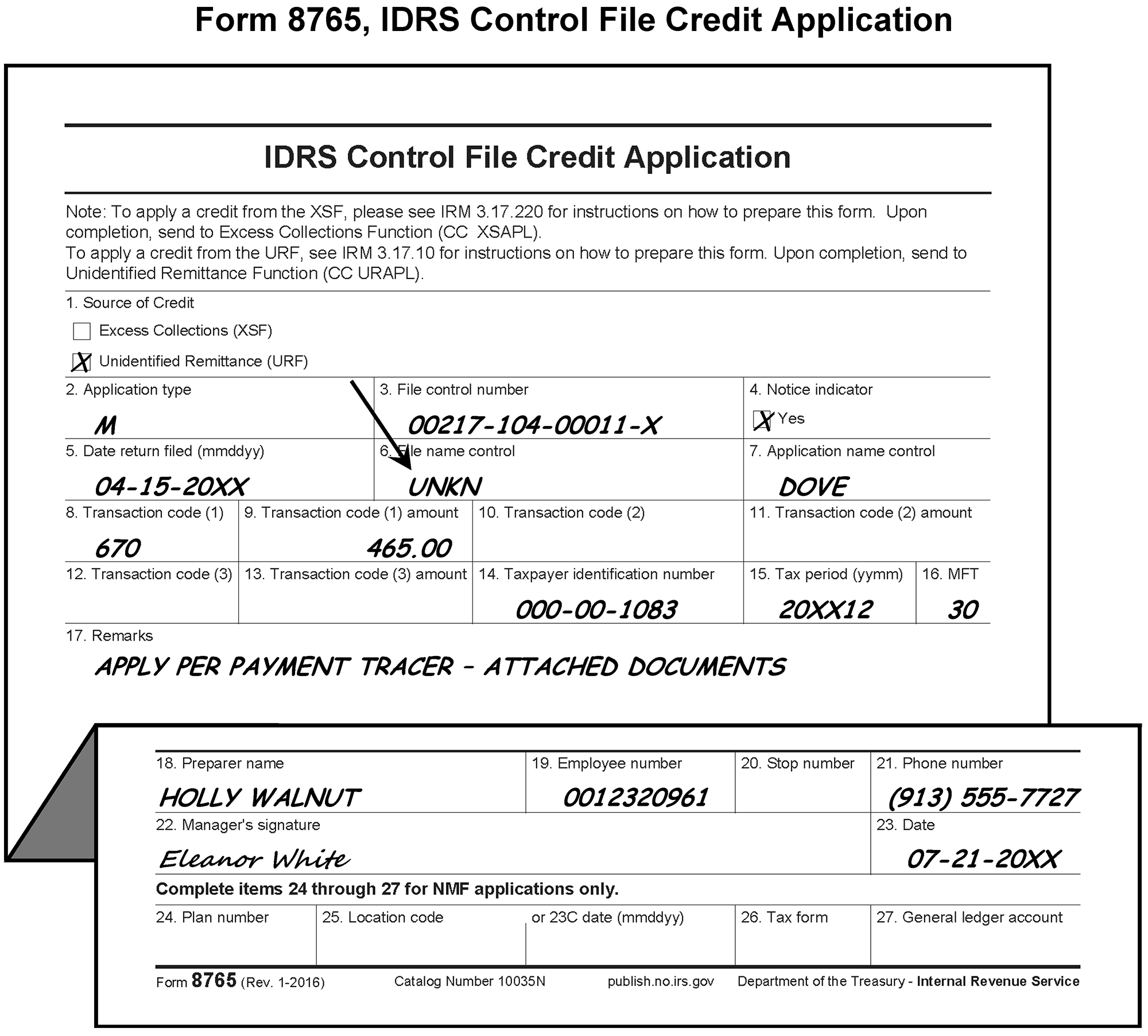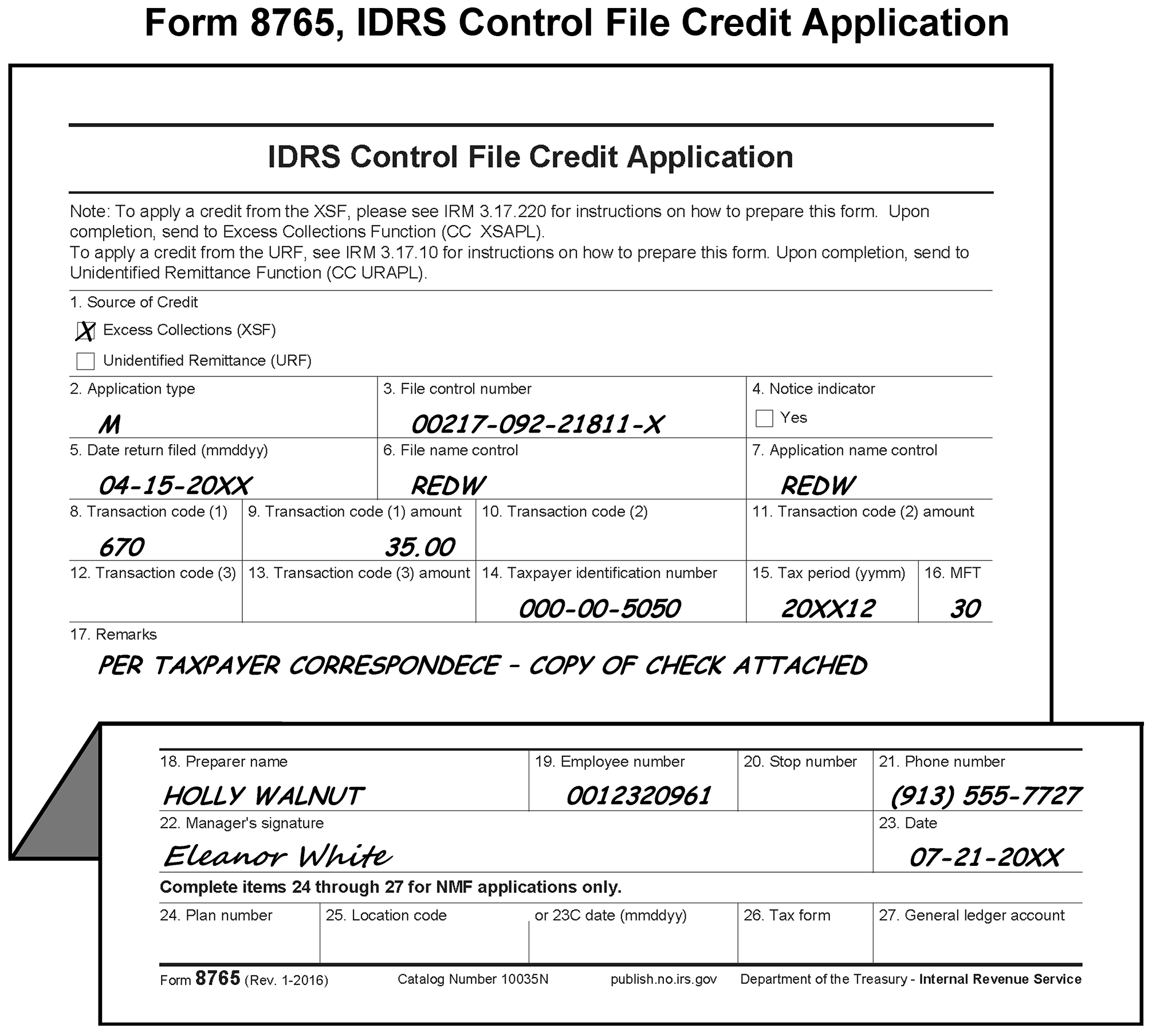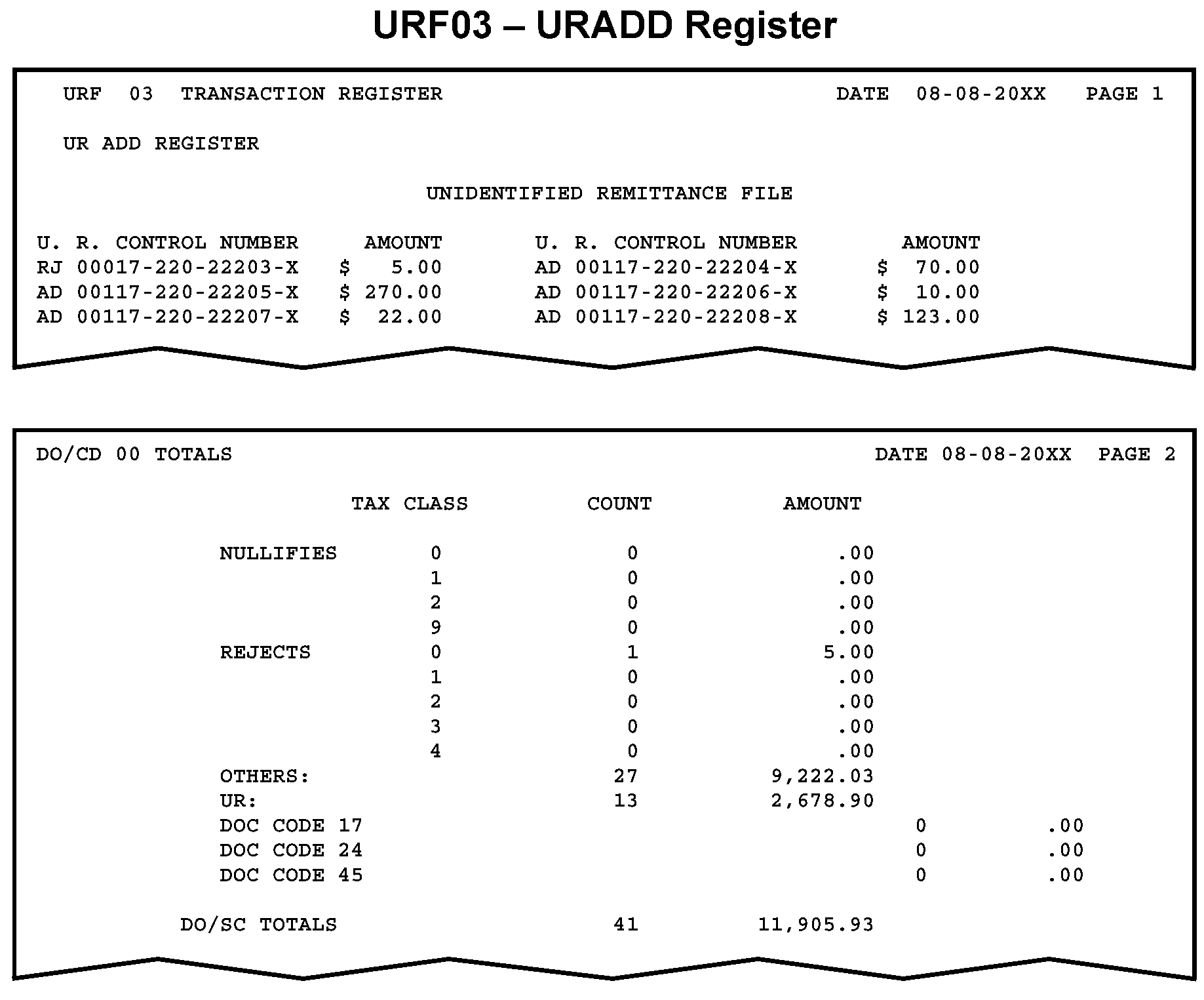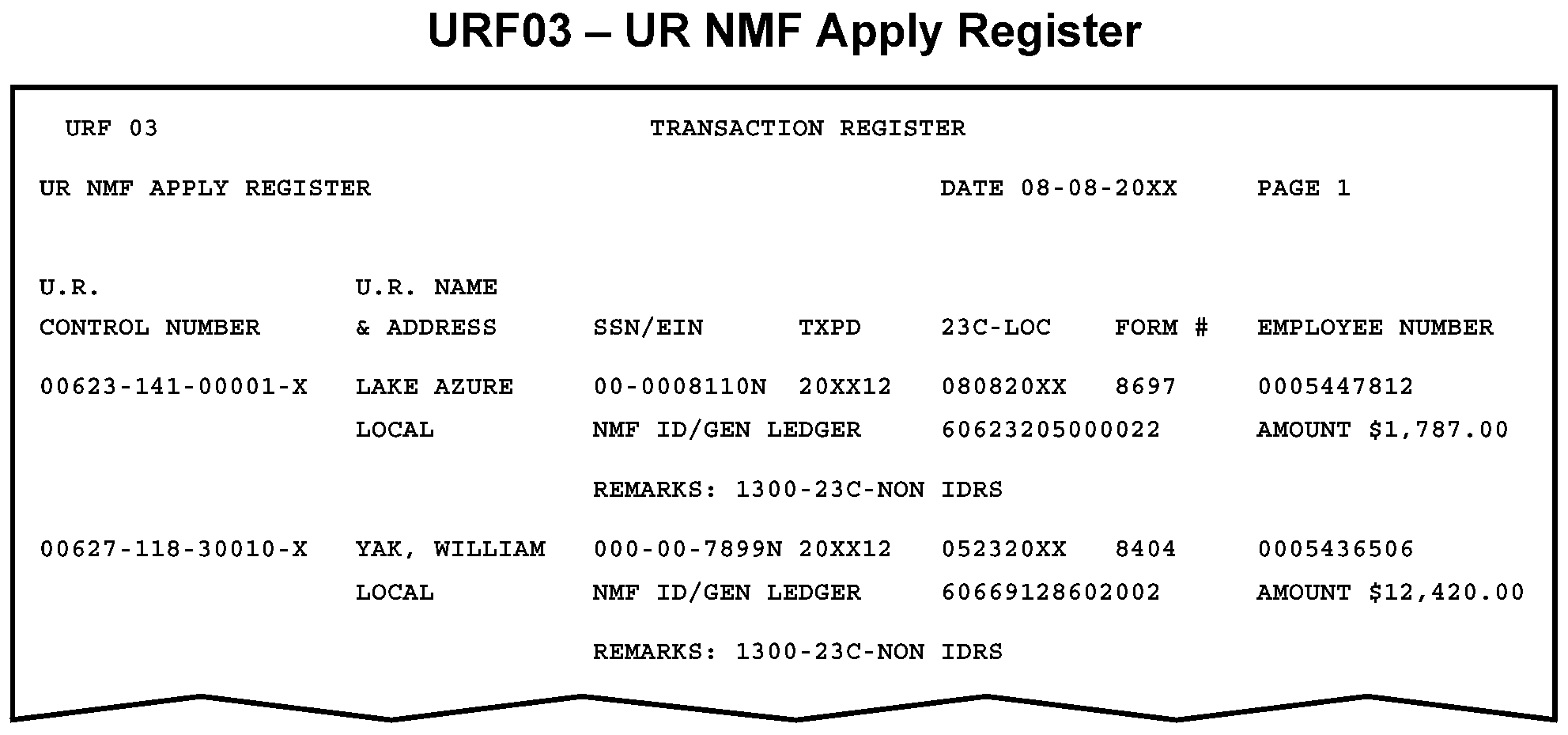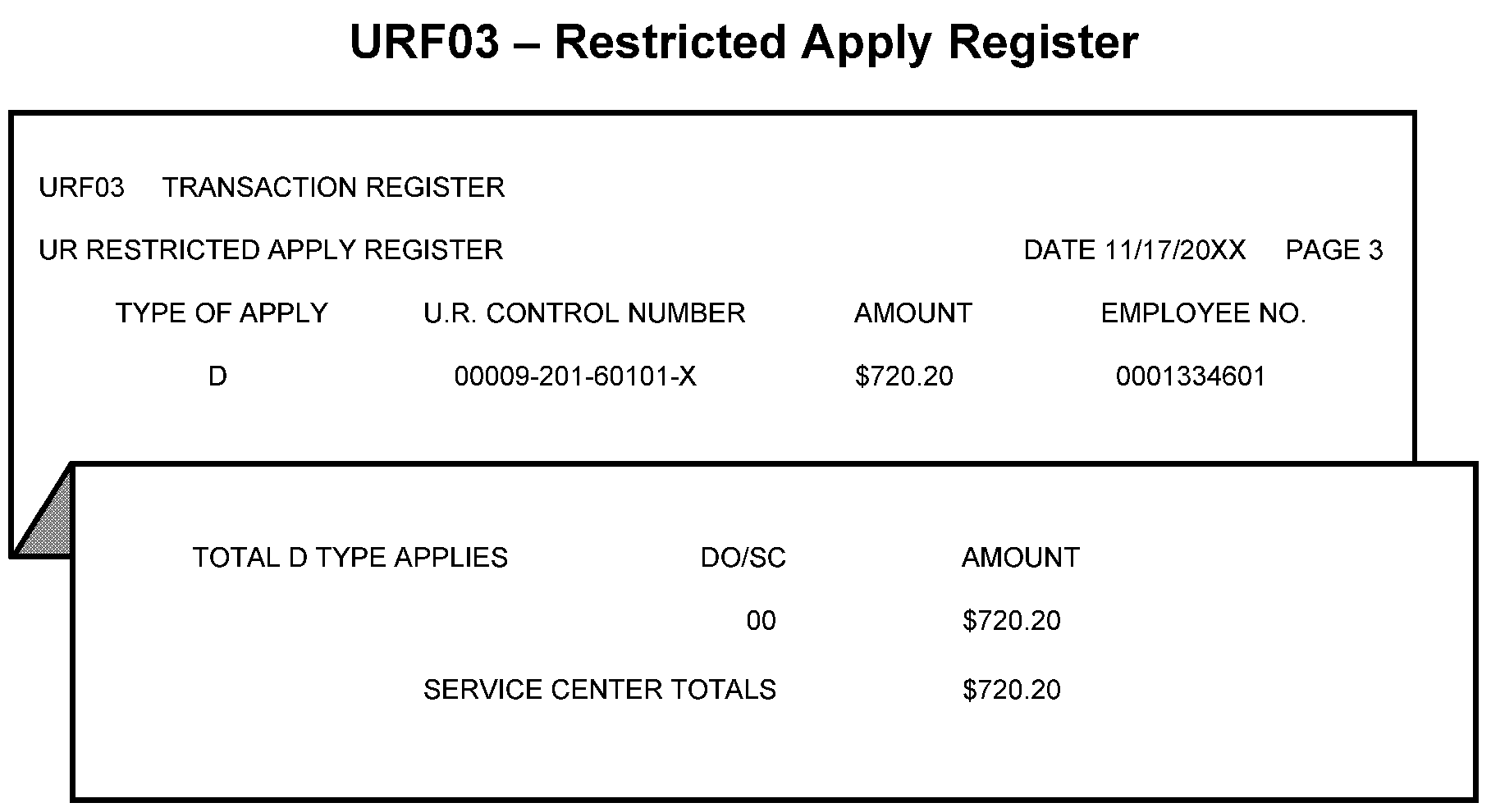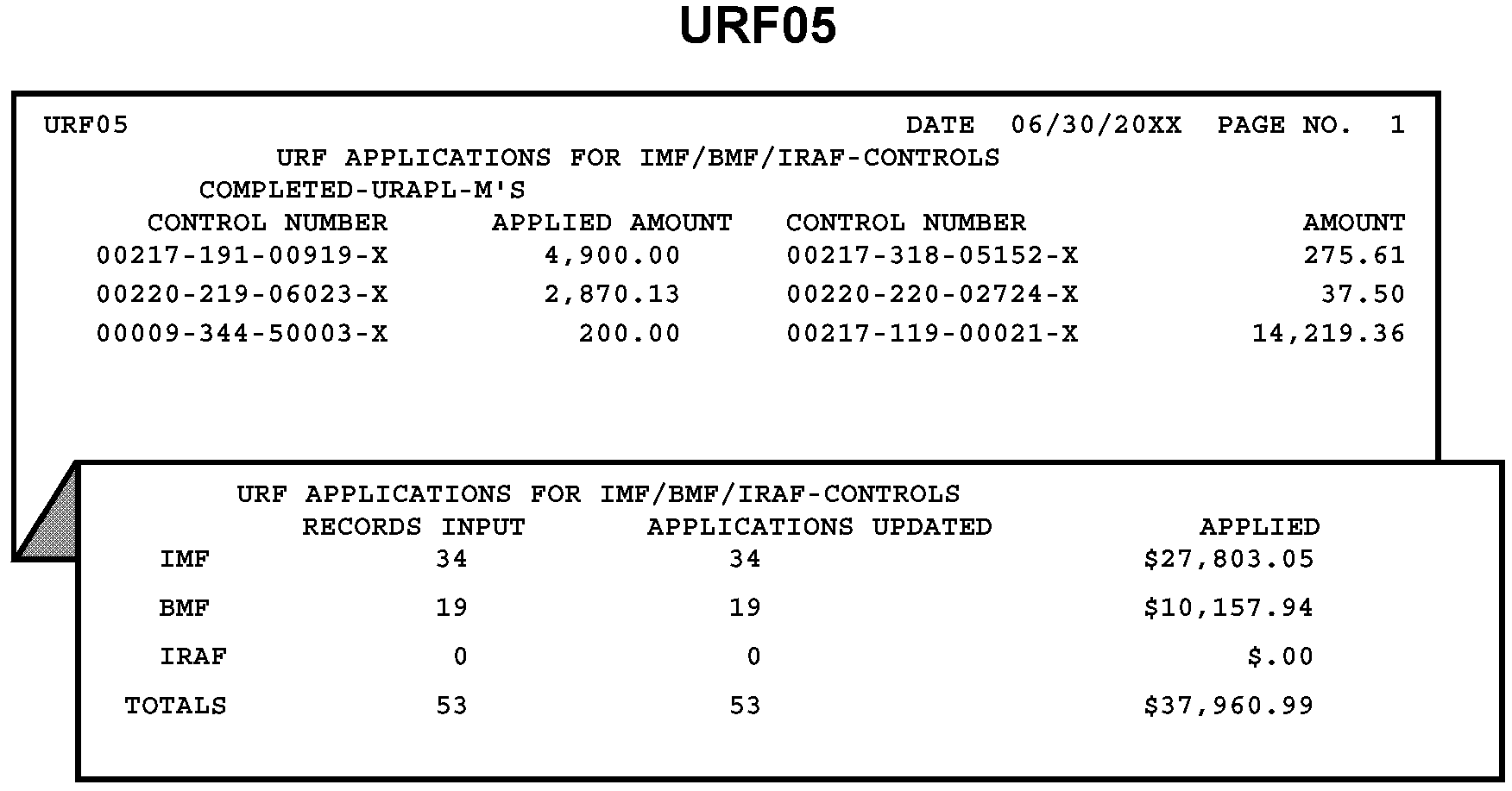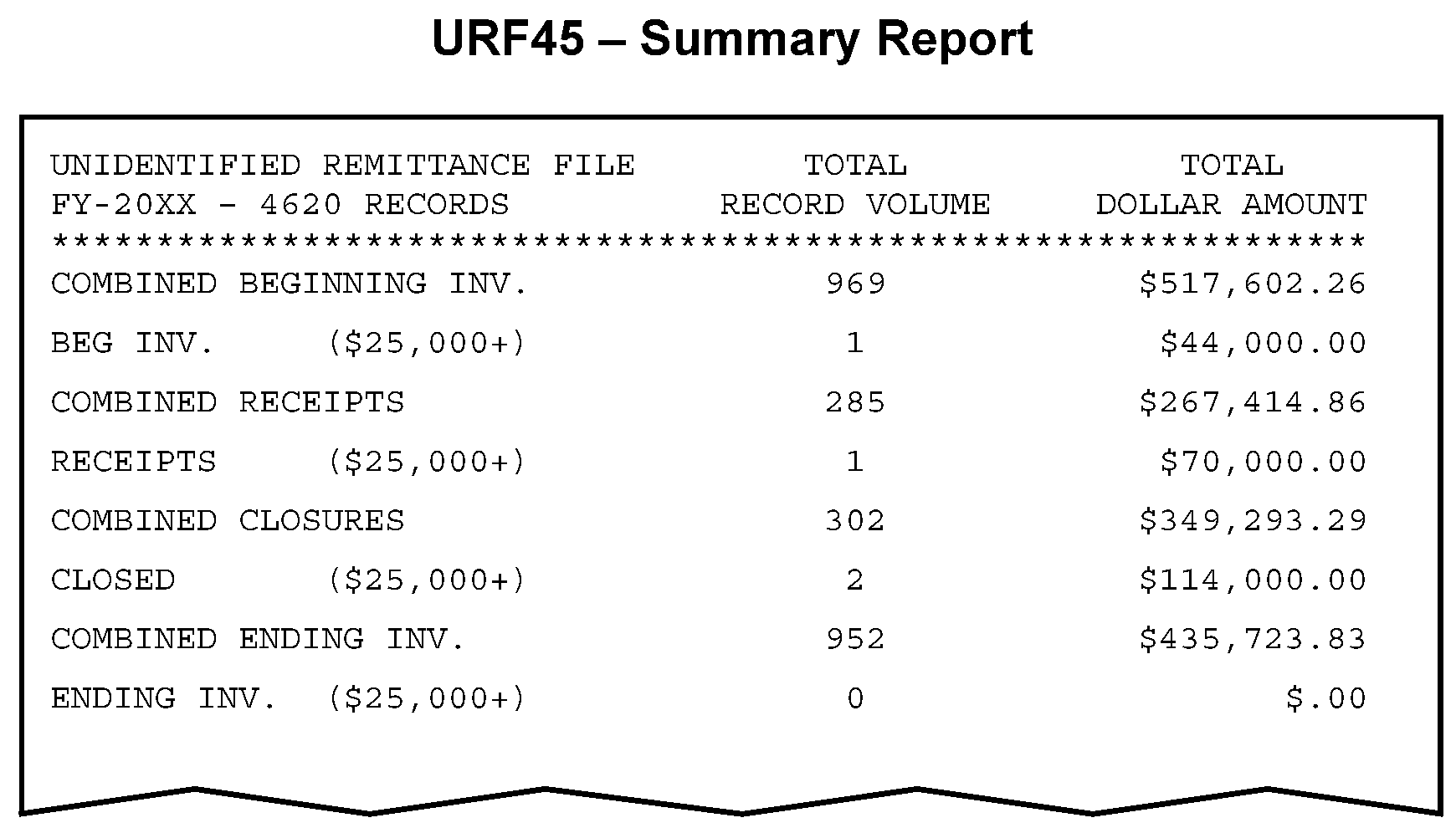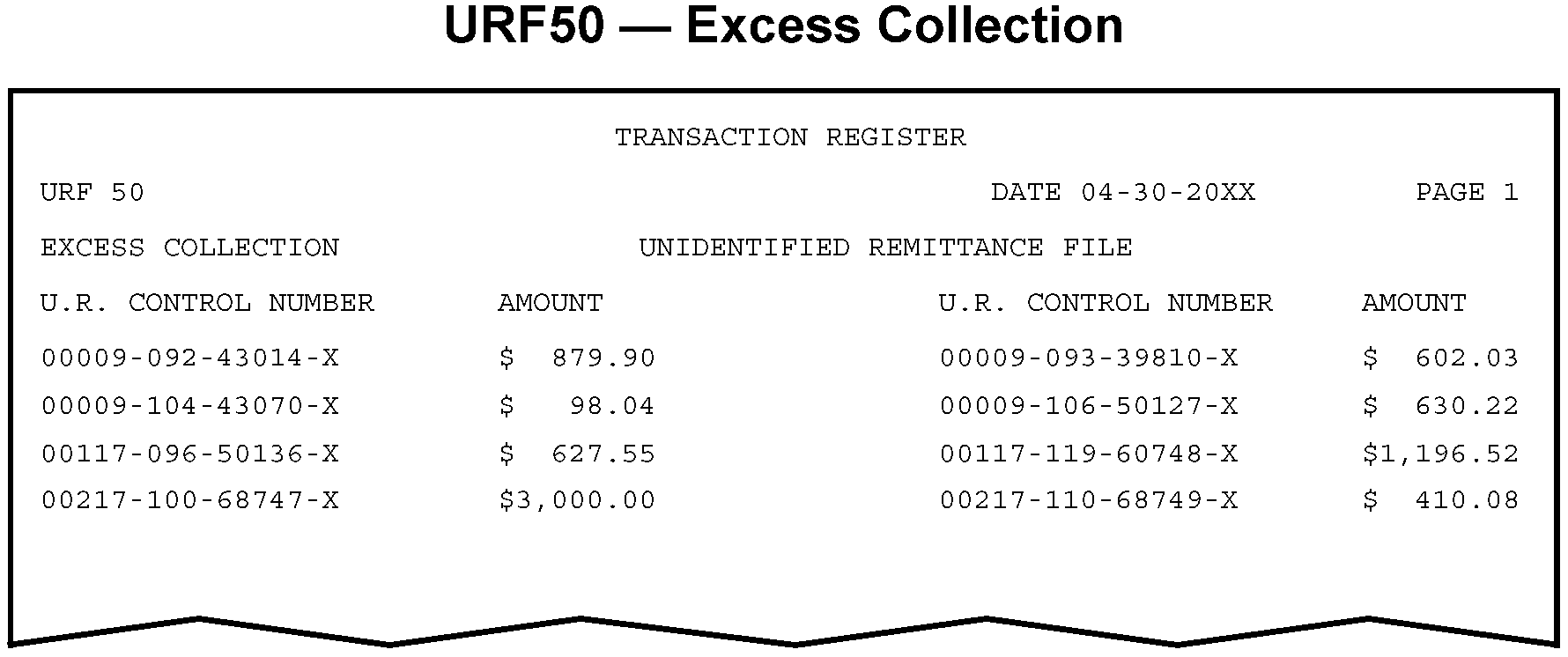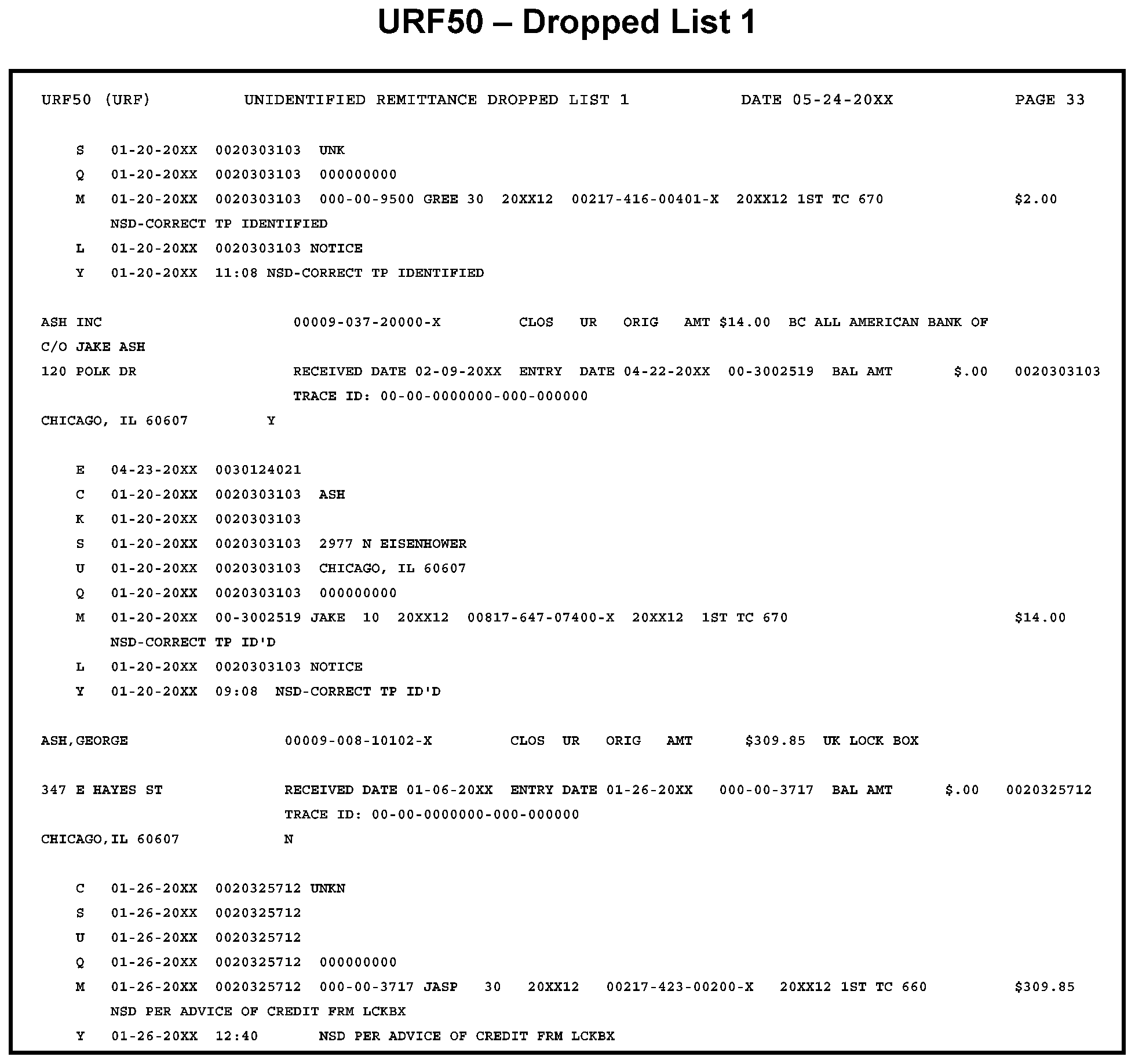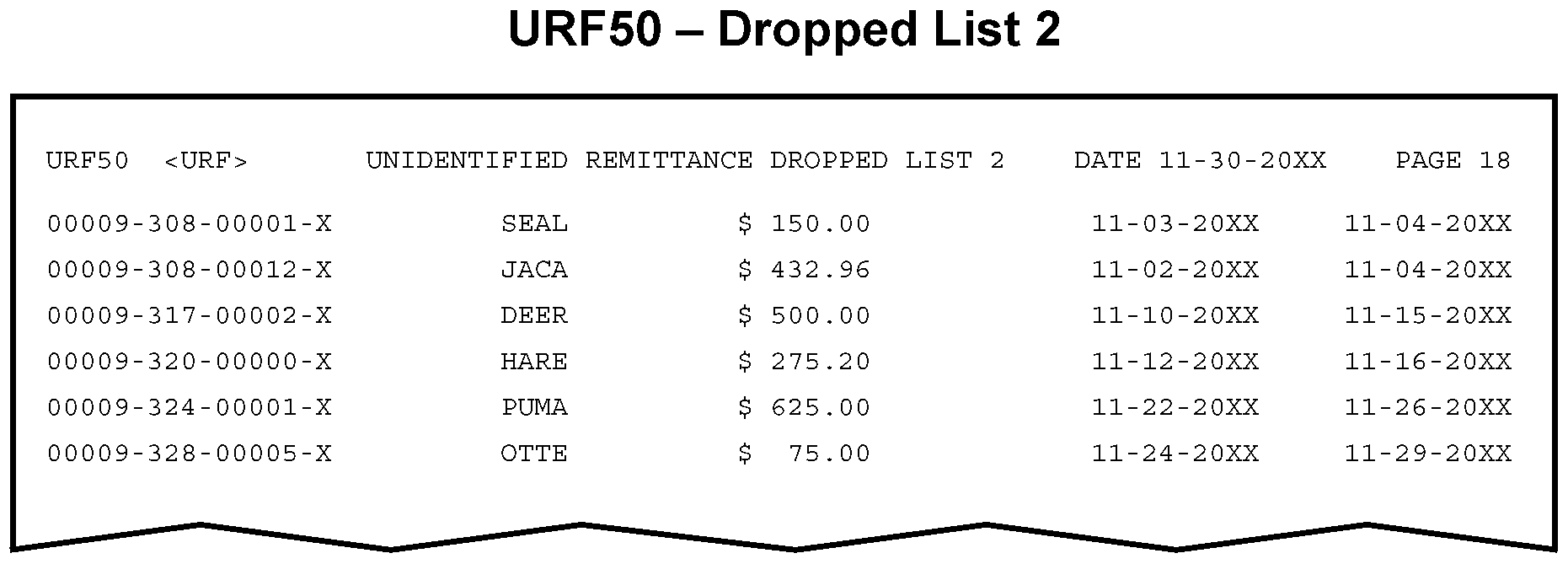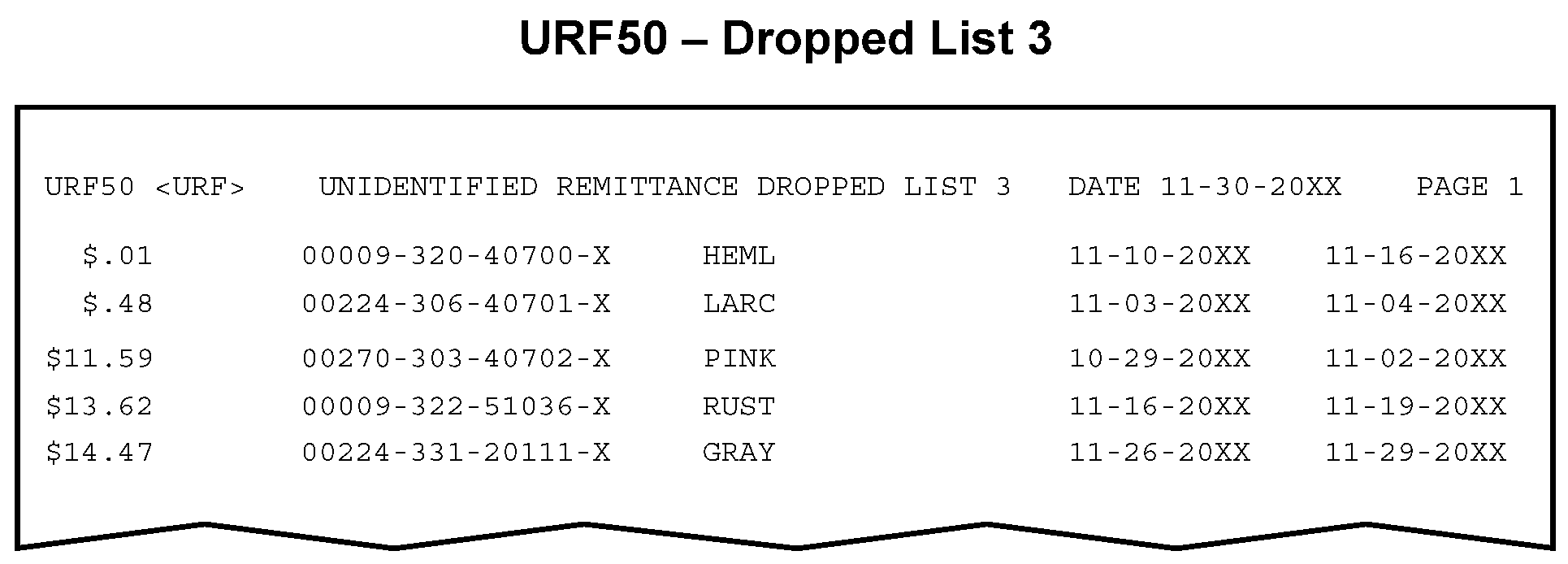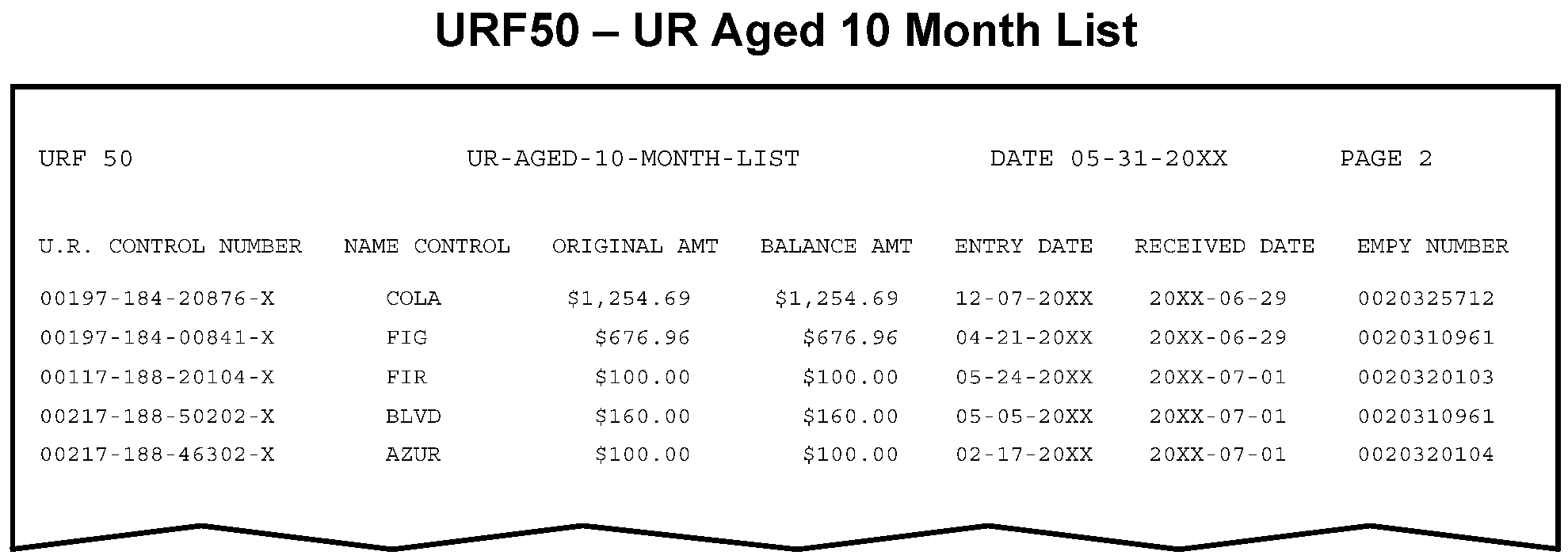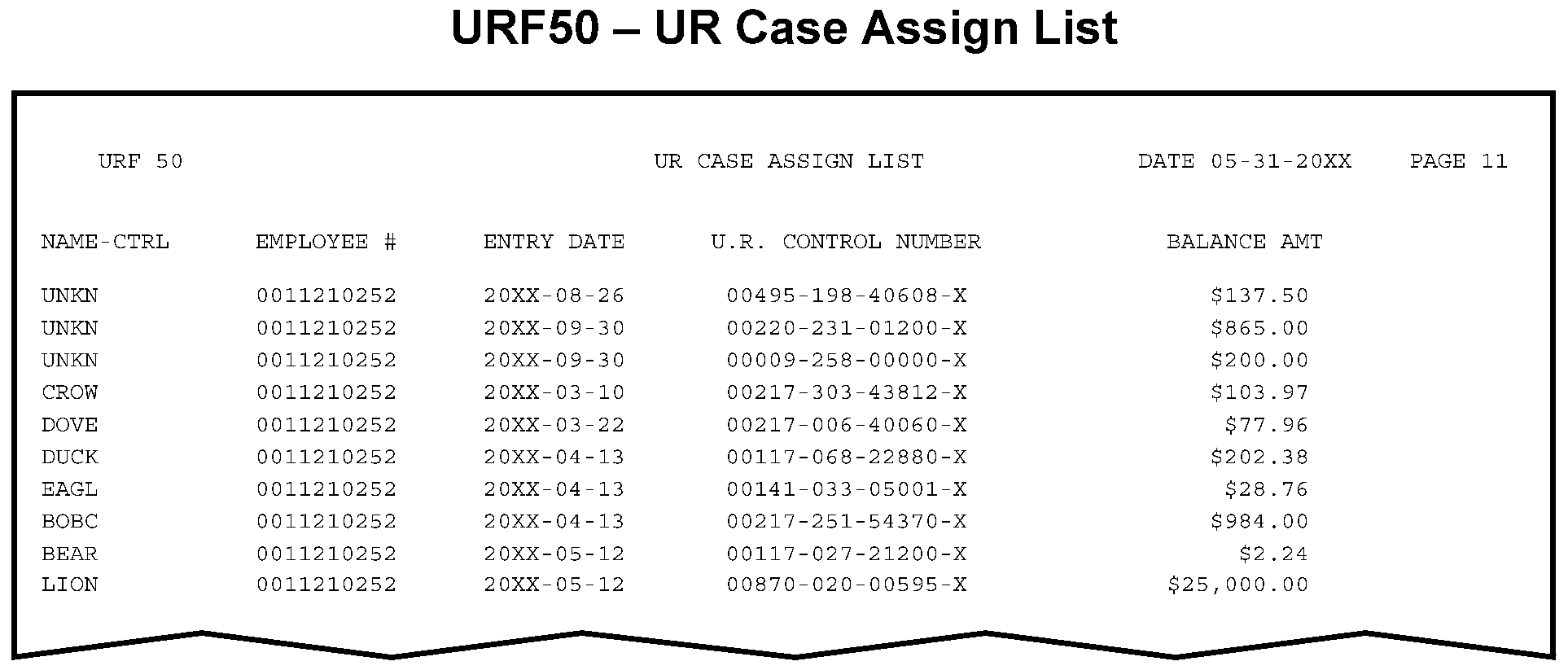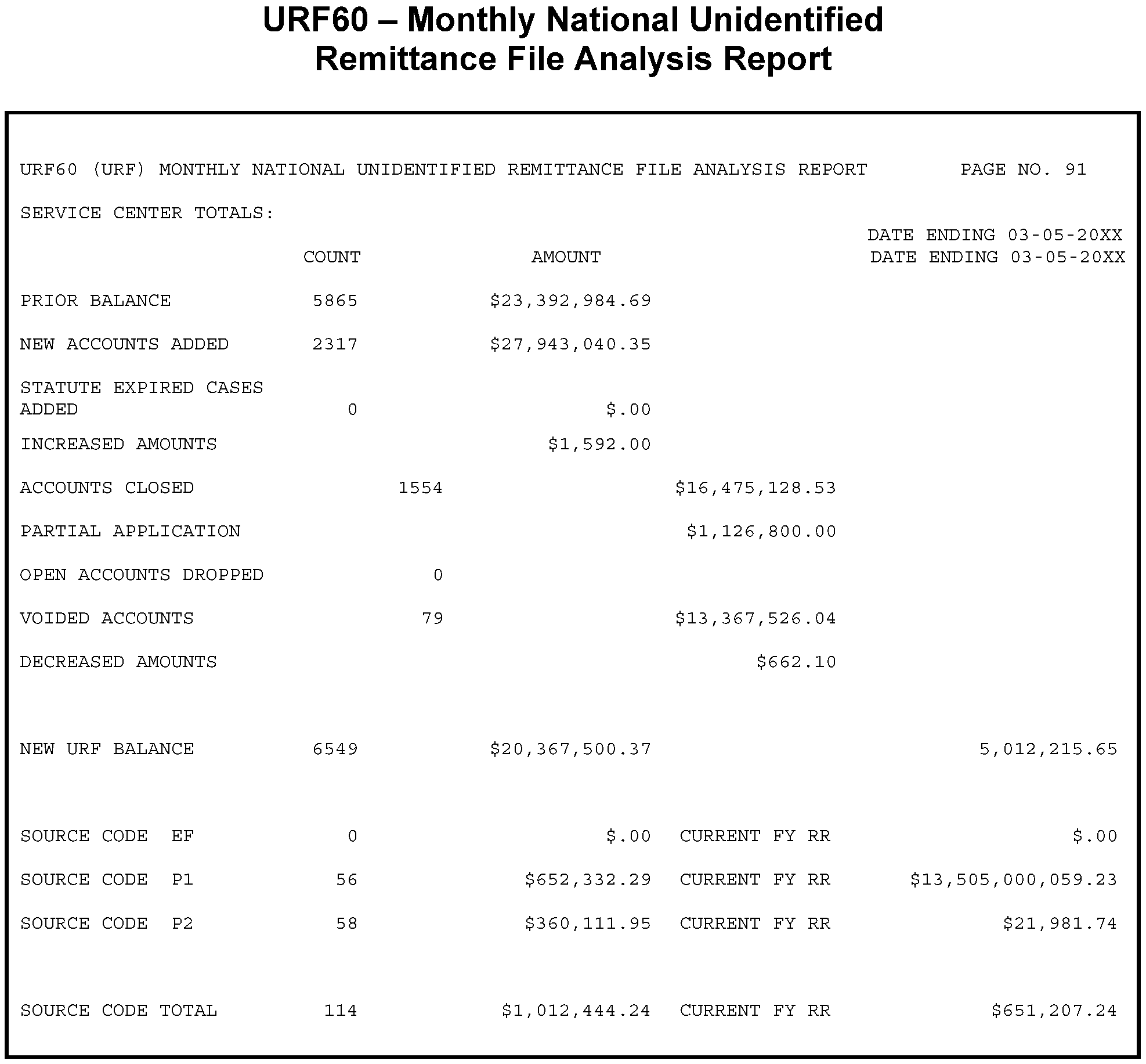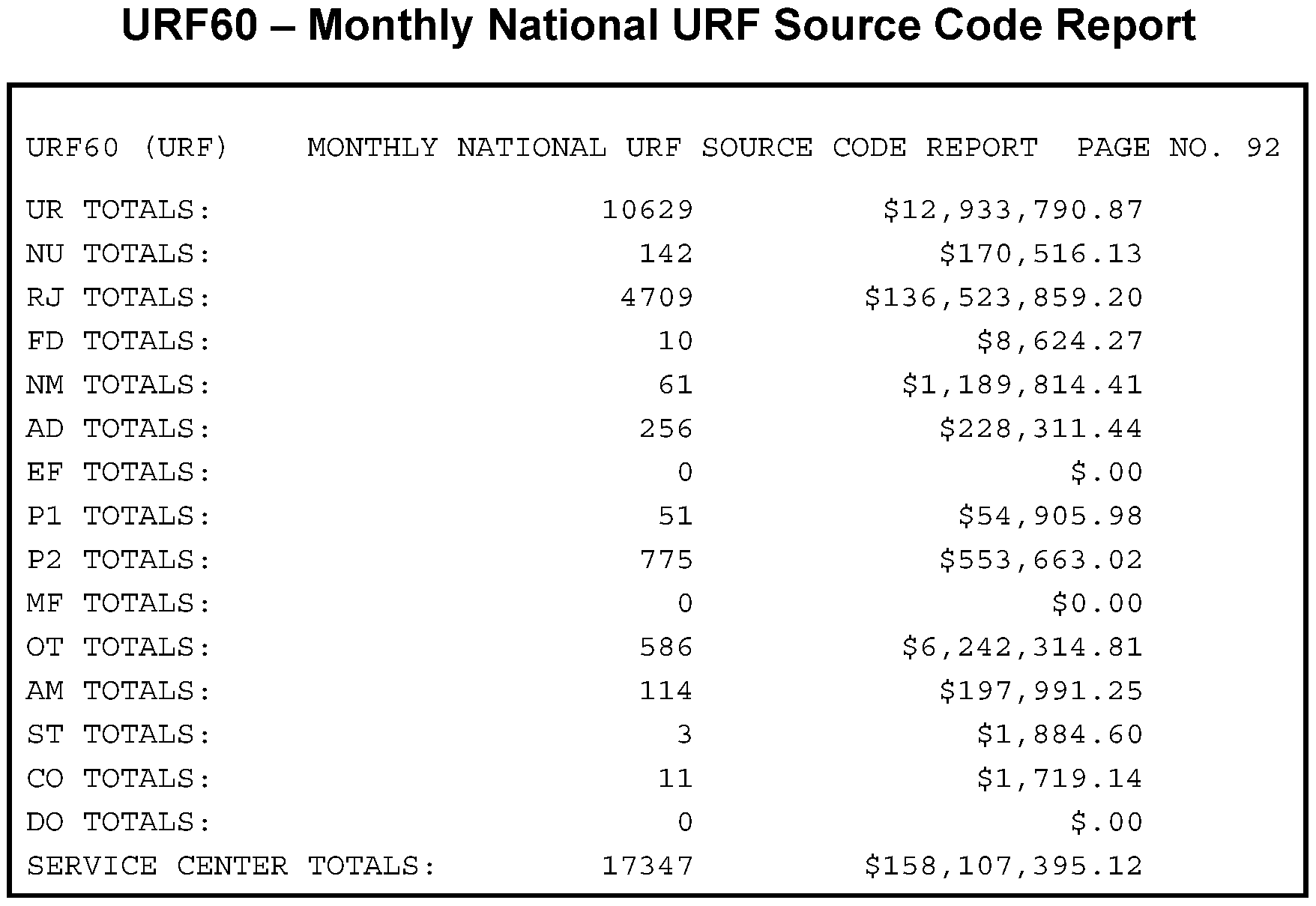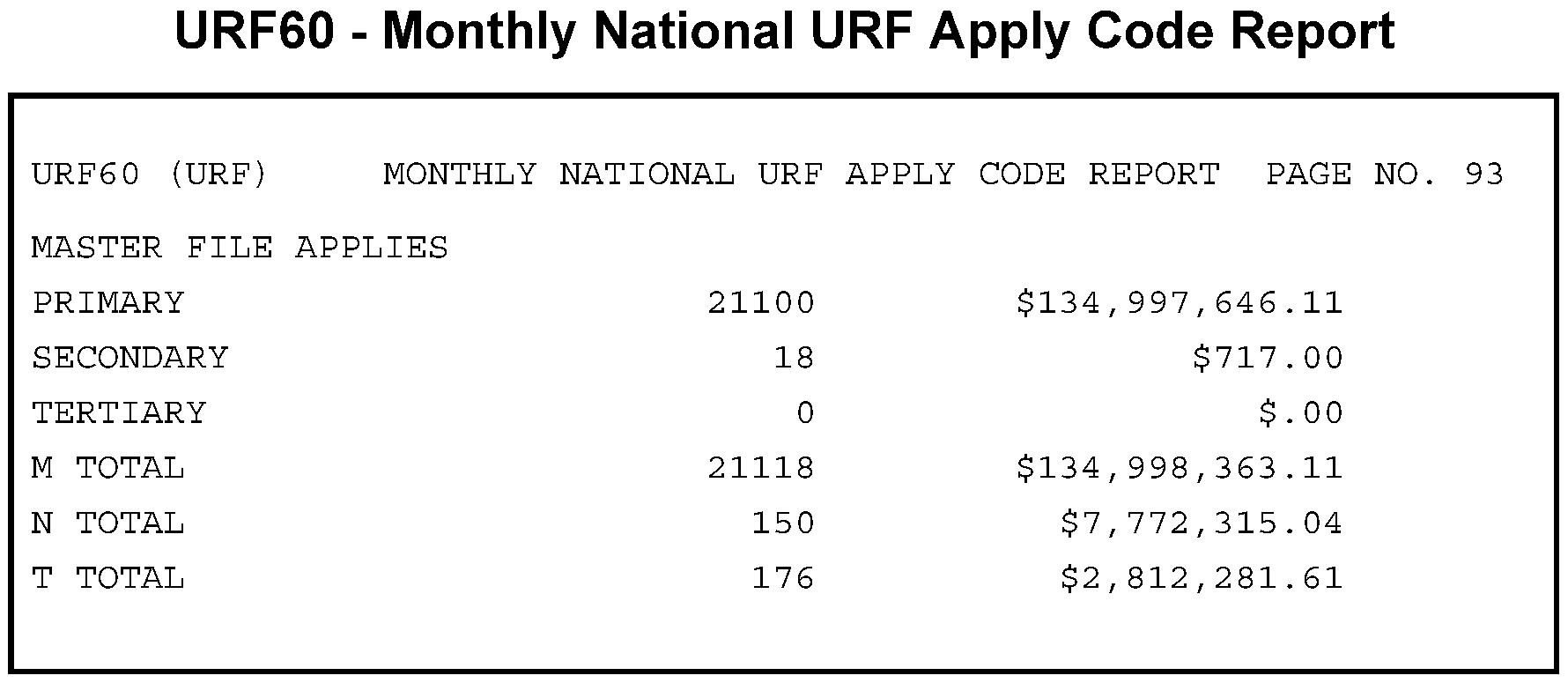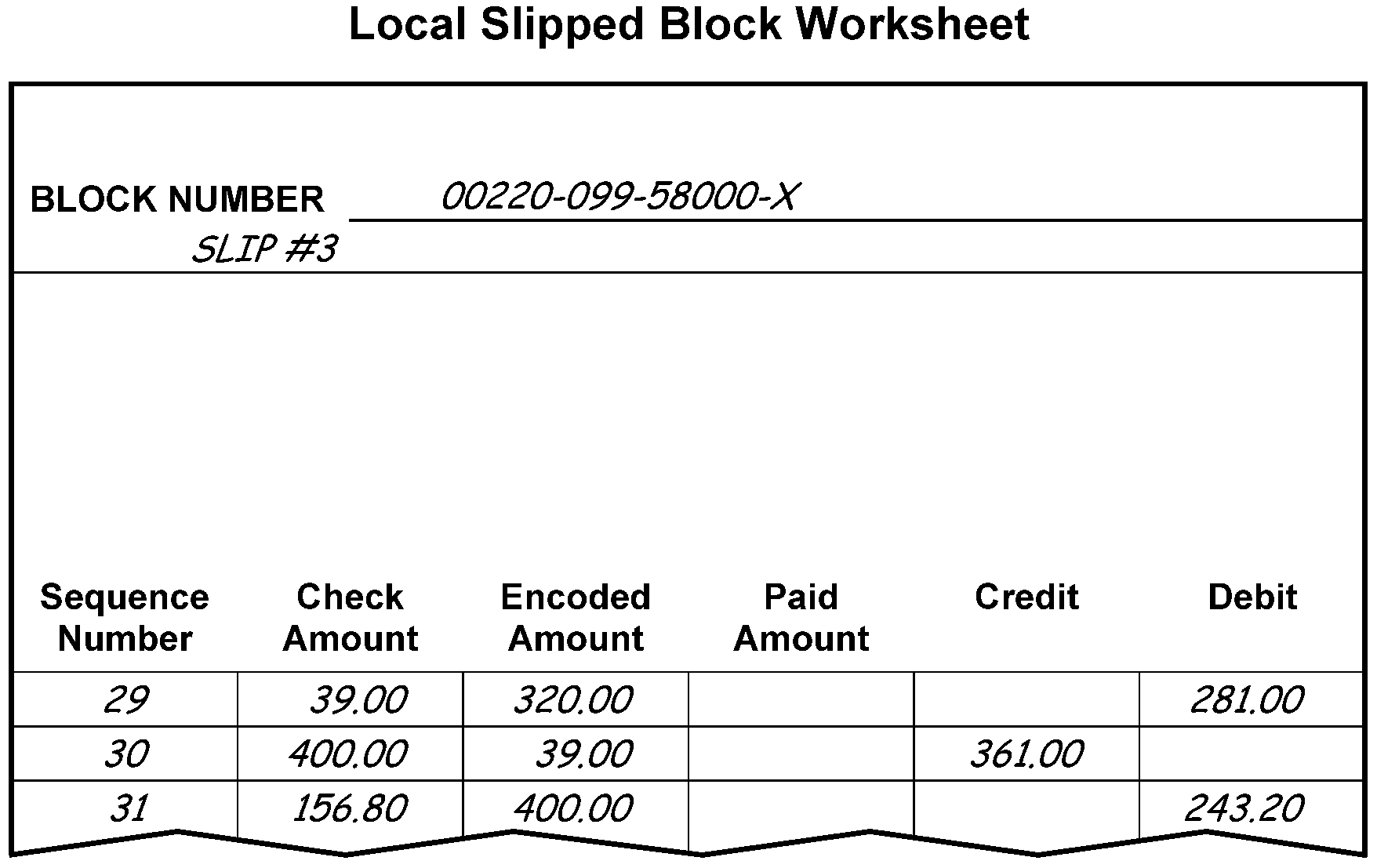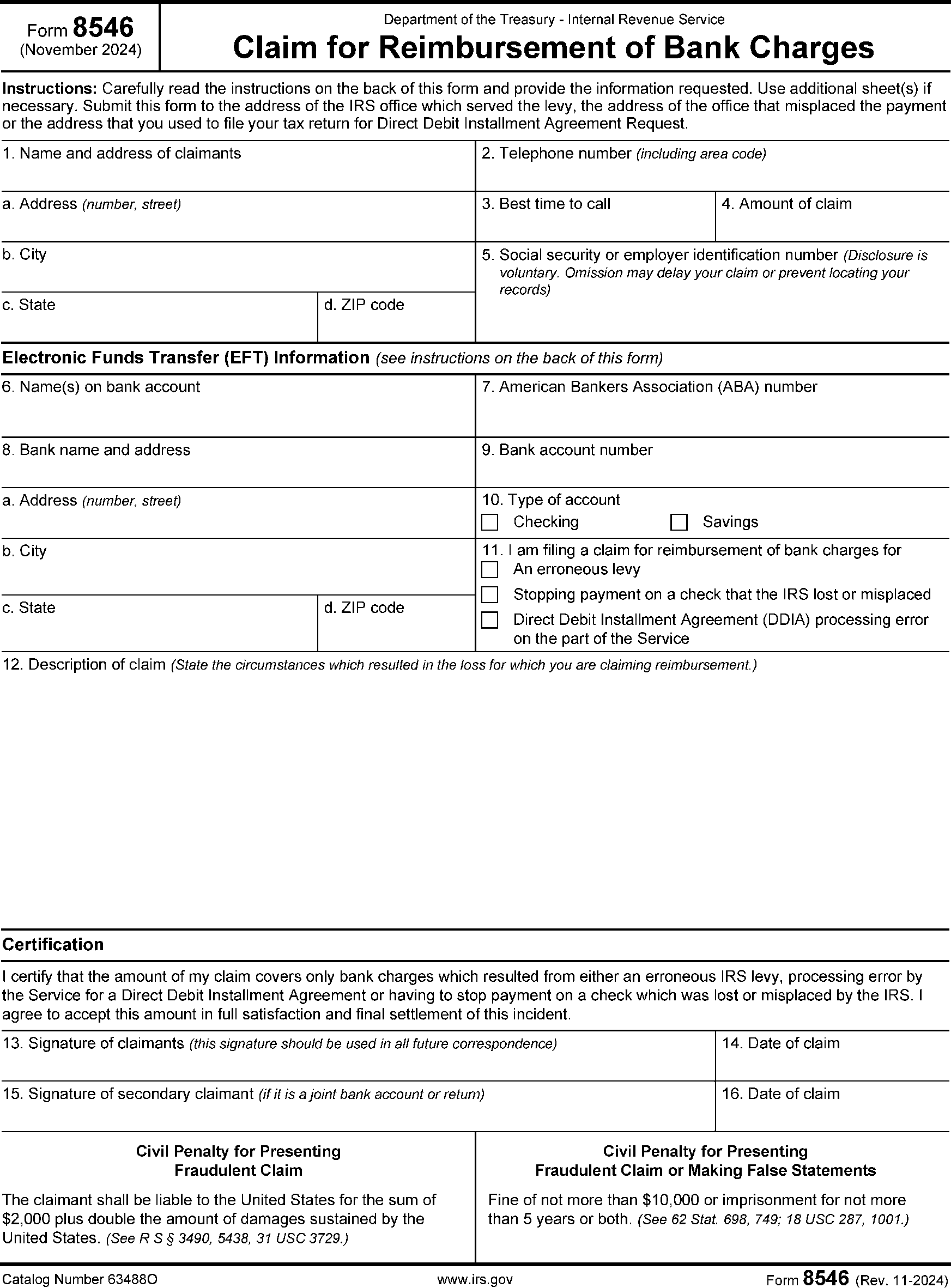- 3.17.10 Dishonored Check File (DCF) and Unidentified Remittance File (URF)
- 3.17.10.1 Program Scope and Objectives
- 3.17.10.1.1 Background
- 3.17.10.1.2 Authority
- 3.17.10.1.3 Roles and Responsibilities
- 3.17.10.1.4 Annual Clearance of IRM
- 3.17.10.1.5 Program Management and Review
- 3.17.10.1.6 Program Reviews
- 3.17.10.1.6.1 Vulnerability Assessments
- 3.17.10.1.7 Terms and Acronyms
- 3.17.10.1.8 Related Resources
- 3.17.10.1.9 IDRS Notice Issuance Criteria
- 3.17.10.1.10 Taxpayer Advocate Service Case (TAS) Procedures, National Service Level Agreements (SLAs)
- 3.17.10.1.11 Criminal Restitution Payments
- 3.17.10.2 Dishonored Check File (DCF)
- 3.17.10.2.1 Timely Processing for Dishonored Checks
- 3.17.10.2.1.1 Deposit Discrepancies
- 3.17.10.2.1.2 Deposit Discrepancy Case File
- 3.17.10.2.2 Receiving the Debit Voucher/SF 5515 with Checks
- 3.17.10.2.2.1 Check 21
- 3.17.10.2.2.2 Electronic Check Processing (ECP)
- 3.17.10.2.2.3 Integrated Submission and Remittance Processing for the Electronic Check Process
- 3.17.10.2.3 Dishonored Check Site Shutdown/Emergency Contingency Procedures
- 3.17.10.2.4 Coding and Editing the Checks
- 3.17.10.2.4.1 Creating the Dishonored Check Number (DCN)
- 3.17.10.2.4.2 Trace ID Number
- 3.17.10.2.5 Entering and Balancing Checks on IDRS
- 3.17.10.2.6 Creating a Dishonored Check Worksheet, Form 8252
- 3.17.10.2.7 Balancing to the Transaction Register
- 3.17.10.2.8 Redepositing Returnable Checks
- 3.17.10.2.9 Receiving Researching Form 215, Replacement Certificate of Deposit (Credit Voucher)
- 3.17.10.2.10 Processing Payments on Offers in Compromise (OIC)
- 3.17.10.2.10.1 Processing Payments on Offers in Compromise (OIC) Application Fees
- 3.17.10.2.10.2 Payments Processed Through the Paper Check Conversion System (PCC) and Remittance Strategy for Paper Check Conversion (RS-PCC)
- 3.17.10.2.10.3 Paper Check Conversion Standard Operating Procedures (SOP) - Ogden Submission Processing Campus Accounting Operations Only
- 3.17.10.2.11 Researching Dishonored Checks-General Instructions
- 3.17.10.2.12 Researching Dishonored Checks for Payment of IRS Tax Liability
- 3.17.10.2.12.1 Command Codes to Research
- 3.17.10.2.12.1.1 Research NMF
- 3.17.10.2.12.1.1.1 Research the Area Office Remittance Register
- 3.17.10.2.12.1.1.2 Research Other Areas
- 3.17.10.2.12.1.1.3 IMF Erroneous Refunds caused by Dishonored Checks
- 3.17.10.2.12.1.1.4 BMF Erroneous Refunds caused by Dishonored Checks
- 3.17.10.2.12.1.1 Research NMF
- 3.17.10.2.12.1 Command Codes to Research
- 3.17.10.2.13 Processing Dishonored Checks for Payments Other Than IRS Tax Liabilities
- 3.17.10.2.14 Other Dishonored Check Processing Actions
- 3.17.10.2.14.1 Processing Missing Checks
- 3.17.10.2.14.1.1 ≡ ≡ ≡ ≡ ≡ ≡ ≡ ≡ ≡ ≡ ≡ ≡ ≡ ≡ ≡ ≡ ≡
- 3.17.10.2.14.1.2 External Bank Lead Check Returns
- 3.17.10.2.14.1 Processing Missing Checks
- 3.17.10.2.15 Penalties on Electronic Payments
- 3.17.10.2.16 Applying the Debit to the Taxpayer's Account
- 3.17.10.2.17 Changing Entity Information on the DCF
- 3.17.10.2.17.1 Processing Unpostables Involving Dishonored Checks
- 3.17.10.2.18 Processing Dishonored Checks for Section 965 Payments
- 3.17.10.2.19 Researching the DCF
- 3.17.10.2.20 Initial Processing of Form 2287/Form 2287 (SP)
- 3.17.10.2.20.1 Processing Undelivered Notices (Form 2287/Form 2287 (SP) or Form 14219)
- 3.17.10.2.20.2 Assessing a Dishonored Check Penalty
- 3.17.10.2.21 Dishonored Check Computer-Generated Reports
- 3.17.10.2.22 Reporting of Inventories
- 3.17.10.2.1 Timely Processing for Dishonored Checks
- 3.17.10.3 Unidentified Remittance File (URF)
- 3.17.10.3.1 Overview
- 3.17.10.3.1.1 Unidentified Remittance Case File
- 3.17.10.3.1.2 Trace ID Number for Tracking Credits
- 3.17.10.3.2 Receiving Unidentified Remittance Cases
- 3.17.10.3.2.1 Identity (ID)Theft-General Instructions
- 3.17.10.3.2.2 Processing Installment Agreement User Fees (IAUF)
- 3.17.10.3.2.2.1 Receiving Statute Credits
- 3.17.10.3.2.2.2 Processing Payment Expired CSED (PMTEXPCSED) Credits
- 3.17.10.3.3 Entering Unidentified Remittance (UR) Cases on IDRS
- 3.17.10.3.4 Working Procedures for Preliminary Processing Clerks
- 3.17.10.3.4.1 Perform Initial IDRS Terminal Operations
- 3.17.10.3.4.1.1 Routing Attachments
- 3.17.10.3.4.1 Perform Initial IDRS Terminal Operations
- 3.17.10.3.5 Initial Processing by UR Technicians
- 3.17.10.3.6 Processing URs for Payments Other Than Open Tax Liabilities
- 3.17.10.3.7 Researching the URF
- 3.17.10.3.8 Changing Information on the URF
- 3.17.10.3.9 Changing Other Information on URF
- 3.17.10.3.10 Applying Credit to a Taxpayer's Account
- 3.17.10.3.11 Manually Refunding from URF
- 3.17.10.3.12 Working IRA Withholding Cases
- 3.17.10.3.13 Processing Taxpayer Correspondence and Other Responses
- 3.17.10.3.14 Working Form 8288, U.S. Withholding Tax Return for Dispositions by Foreign Persons of U.S. Real Property Interests and Form 8288-A, Statement of Withholding on Dispositions by Foreign Persons of U.S. Real Property Interests (Processed at OSPC only)
- 3.17.10.3.15 Form W-7, Application for an Individual Taxpayer Identification Number, Procedures for Processing
- 3.17.10.3.16 Closing and Post-Closing Procedures
- 3.17.10.3.17 Unidentified Remittance Computer-Generated Reports
- 3.17.10.3.18 Balancing Computer-Generated Reports
- 3.17.10.3.19 Reporting of Inventories
- 3.17.10.3.1 Overview
- 3.17.10.4 Deposit Discrepancies
- 3.17.10.4.1 Timeframes for Resolving Deposit Discrepancies
- 3.17.10.4.2 Controlling Deposit Discrepancies
- 3.17.10.4.2.1 The Bank Discrepancy Application
- 3.17.10.4.3 Encoding Errors
- 3.17.10.4.4 Slipped Blocks/Mixed Data/Mixed Entity
- 3.17.10.4.5 Piggyback Remittances
- 3.17.10.4.6 Improper SF 5515 Charge Backs
- 3.17.10.4.7 Counterfeit Currency
- 3.17.10.4.8 Federal Tax Deposit Discrepancies
- 3.17.10.4.9 Contacting Taxpayer
- 3.17.10.5 Reimbursement of Bank Charges Due to Service Loss or Misplacement of Taxpayer Checks
- 3.17.10.6 Over the Counter Network (OTCnet)
- 3.17.10.6.1 Accessing OTCnet
- 3.17.10.6.2 Adjustments and Reports
- Exhibit 3.17.10-1 Table of Valid TC/MFT/Doc Codes (BDAPL)
- Exhibit 3.17.10-2 CC BDADDR / CC BDADD
- Exhibit 3.17.10-3 CC BDOUT
- Exhibit 3.17.10-4 CC BDAPLR / CC BDAPL
- Exhibit 3.17.10-5 CC BDENT
- Exhibit 3.17.10-6 CC BDINQ
- Exhibit 3.17.10-7 CC FMADD / CC URADD
- Exhibit 3.17.10-8 CC URINQ
- Exhibit 3.17.10-9 CC URENT
- Exhibit 3.17.10-10 CC UROUT (Z, V, and D)
- Exhibit 3.17.10-11 Valid URAPL M Transaction Table
- Exhibit 3.17.10-12 CC FMAPL / CC URAPL (M, N, and T)
- Exhibit 3.17.10-13 CC FMREF / CC URREF
- Exhibit 3.17.10-14 URF/DCF Error Messages: Their Conditions and Solutions
- Exhibit 3.17.10-15 FMS Form 197, Judgment Fund Voucher for Payment
- Exhibit 3.17.10-16 OTCnet User Standard Operating Procedures Agency Viewer
- 3.17.10.1 Program Scope and Objectives
Part 3. Submission Processing
Chapter 17. Accounting and Data Control
Section 10. Dishonored Check File (DCF) and Unidentified Remittance File (URF)
3.17.10 Dishonored Check File (DCF) and Unidentified Remittance File (URF)
Manual Transmittal
December 09, 2025
Purpose
(1) This transmits revised IRM 3.17.10, Accounting and Data Control-Dishonored Check (DCF) and Unidentified Remittance File (URF).
Material Changes
(1) IRM 3.17.10.1(6) Added section for the Program Stakeholders, IMD review.
(2) IRM 3.17.10.1.2 Added section for the Authority per IMD review.
(3) IRM 3.17.10.1.3 Added the specified Roles to this section per IMD review.
(4) IRM 3. 17.10.1.9 Added note See IRM 2.4.48 Command Codes STAUP, per review.
(5) IRM 3.17.10.2.2 Removed the word Stamp and Machine Tape, per review.
(6) IRM 3.17.10.2.2.3 Remove the words Naming Convention, per review.
(7) IRM 3.17.10.2.4 Remove the words Underline Name Control, per review.
(8) IRM 3.17.10.2.4.2 Remove the word Stamp to input on the bottom right hand corner of the check image, per review.
(9) IRM 3.17.10.2.6 Updated note for the Form 8252, Dishonored Check Worksheet, IPU 25U0421 issued 04-02-2025.
(10) IRM 3.17.10.2.11 Replacing DC with Form 8252, per review.
(11) IRM 3.17.10.2.13 Remove one copy to the photocopy unit, and added both copies to RACS, per review.
(12) IRM 3.17.10.2.13(3) Added routing instructions for Form 8157, Check for Copy of Tax Return Not Accepted by Banks, IPU 25U3223 issued 04-28-2025.
(13) IRM 3.17.10.2.14.1.1(5) Added instructions for fraudulent/bogus remittances, IPU 25U0220 issued 02-14-2025.
(14) IRM 3.17.10.2.17.1 Added note See IRM 2.3.37 Command Codes UPTIN, per review.
(15) IRM 3.17.10.2.20 Adding additional verbiage to (7), per review.
(16) IRM 3.17.10.3.1.2 Added instructions for tax return credits to move to URF, IPU 25U0286 issued 02-28-2025.
(17) IRM 3.17.10.3.2(5) Updated the remark section, IPU 25U0286 issued 02-28-2025 .
(18) IRM 3.17.10.3.2(22) Updated IRM reference for processing decedent account refund, IPU 25U0421 issued 04-02-2025.
(19) IRM 3.17.10.4 Replace DCF with Trace ID#, per review.
(20) Figure 3.17.10-59 Updated graphic to revised Form 8546
(21) Editorial changes made throughout the IRM.
Effect on Other Documents
IRM 3.17.10, Accounting and Data Control-Dishonored Check (DCF) and Unidentified Remittance File (URF) dated April 28, 2025 (effective January 1, 2025) is superseded. The following Interim Procedural Updates (IPU) have been incorporated: IPU 25U0220 issued February 14, 2025, IPU 25U0286 issued February 28, 2025, IPU 25U0421 issued April 2, 2025, and IPU 25U3223 issued April 28, 2025.Audience
Taxpayer Services, Small Business/Self Employed, Large Business and International, Taxpayer Advocate Service, and Tax Exempt/Government Entities personnel.Effective Date
(01-02-2026)
Scott Wallace
Director, Submission Processing
Taxpayer Services
-
Purpose: This IRM describes the processes and procedures for adding and applying payments to the Dishonored Check File (DCF) and the Unidentified Remittance File (URF).
-
Guidance that deviates from IRM 3.17.10 or that establishes new practices (even if temporary) must be:
-
Approved by a first line executive with program responsibility (or documented designee),
-
Communicated to the employee in writing, and
-
Reviewed annually if the deviation is effective for more than one year.
-
-
Audience: Submission Processing Accounting Dishonored Check and Unidentified Remittance functions.
-
Policy Owner: The Director of Submission Processing.
-
Program Owner: Submission Processing Accounting and Deposit Section.
-
Program Stakeholders: The stakeholders impacted are the employees within the Submission Processing campuses and employees throughout the IRS who submit requests for processing.
-
These instructions are for employees in Submission Processing Accounting to add and apply dishonored checks to the Dishonored Check File and unidentified/unprocessable remittances to the Unidentified Remittance File.
-
The extent of research conducted on both Dishonored Checks and Unidentified Remittances will not depend upon the dollar amount of the item. Both large and small cases are to receive equal attention, but large-dollar cases will be worked first.
-
The Dishonored Check File is a separate file within the Integrated Data Retrieval System (IDRS) containing records of all remittances returned to IRS by depositaries upon which payment was refused.
-
A record of a check will remain on the DCF for 367 days (from the debit voucher/bank date) or until its entry has been voided or the amount of the check has been applied to the correct account.
-
Each DCF record within the file contains the Dishonored Check Number (DCN), reason code, amount of check, type of check, IRS received date and entity information (if known).
-
-
The Unidentified Remittance File is separate file within IDRS containing all received remittances that cannot be immediately identified or applied.
While working assigned cases, Submission Processing employees may come across some that are blocked on IDRS and can be identified by an IDRS security message, Unauthorized Access to This Account. Forward the case to your manager. Managers will contact the local Planning and Analysis staff who will scan the case and send encrypted information to the "≡ ≡ ≡ ≡ ≡ ≡ ≡ ≡" mailbox to request access to the account. Managers will keep the original case in a file awaiting access (can take up to 5 business days). Once notified access has been granted, the case can be worked following applicable procedures.-
Each URF record in the file represents a Revenue Receipt less than one year of the IRS received date.
-
Each URF record contains the Unidentified Remittance Number, amount of remittance, type of remittance, received date, taxpayer’s name and any other identifying information.
-
-
The IRS mission is to provide America’s taxpayers top quality service by helping them understand and meet their tax responsibilities and by applying the tax law with integrity and fairness to all.
-
Standards for Internal Control in the Federal Government, GAO-14-704G sets the standards for an effective internal control system for federal agencies.
-
The authorities for this IRM include but are not limited to:
-
Policy Statement 5-39, Reimbursement of Bank Charges Due to Erroneous Levy and Service Loss or Misplacement of Taxpayer Checks
-
Delegation Order 1-4, Settlement of Tort Claims, Claims under the Small Claims Act, and Claims Made by an Employee of the Internal Revenue Service for Damage to or Loss of Personal Property Incident to Service
-
-
The Submission processing Director oversees the policies in this IRM, approves and authorizes the issuance of this Internal Management Document.
-
The Submission Processing Headquarters Dishonored Check/Unidentified Remittance analyst is responsible for the oversight to ensure that all guidelines are followed by conducting program reviews to ensure compliance with IRM requirements, address TIGTA/GAO findings, identify risks to internal controls, address error trends, and training needs.
-
The Submission Processing, Planning and Analysis (P&A) is responsible for the DCF and URF processing within the Accounting Operations.
-
The Dishonored Checks/Unidentified Remittance manager oversees the DCF/URF teams to ensure guidelines in this IRM are followed and ensure proper actions are taken, and submit managerial reviews to HQ.
-
New hire and annual refresher training are required for all Dishonored Check and Unidentified Remittance employees.
-
The below training courses are available in the new learning plan, The Integrated Talent Management (ITM) System.
Dishonored Check File ITM Course Numbers Course Name Course 54941 Adding Checks and Balancing the Dishonored Check File (Clerical) Course 10778 Processing Dishonored Checks Unidentified Remittance File ITM Course Numbers Course 56211 Adding, Balancing and Correcting the Unidentified Remittance File (Clerical) Course 10781 Processing Unidentified Remittances -
All new hire DCF and URF clerks and technicians will complete the new hire training within 30 days of their start date.
-
All DCF and URF clerks and technicians will annually complete the refresher training by January 31. Notification of scheduling/completion of the refresher training will be sent annually to HQ by the Friday of the first full working week in February.
-
This IRM is updated and published annually after review and concurrence by impacted stakeholders according to the clearance process established in IRM 1.11.9, Internal Management Documents, Clearing and Approving Internal Management Documents (IMDs). Functional areas are responsible for reviewing the information in this IRM annually to ensure accuracy, consistency, and to promote effective program administration.
-
First line managers of personnel working Dishonored Check File (DCF) and Unidentified Remittance File (URF) cases will conduct periodic reviews of cases assigned to all employees. The purpose of the review process is to make certain that employees are properly closing cases in a timely manner, identifying Erroneous Refunds, and referring cases to the Erroneous Refund Unit. Managerial Reviews should be submitted to the DCF/URF headquarters analyst via e-mail by the 15th of the month following the month or quarter.
-
Reviews should be conducted, at least monthly, during January to June (quarterly for the remainder of the year) for DCF. Reviews should be conducted quarterly for URF.
-
DCF-Sample cases under 21 days old, including Bank Adjustments; review all cases over 21 days old.
-
URF-Sample cases under 10 months old. Review all cases over 10 months old.
-
All reviews will be documented.
-
-
In addition to the caseload reviews, samples of the following output listings shall be reviewed quarterly to ensure that all employees are taking adequate and proper actions.
-
DCF- Restricted Application Register (DCF03), Applications for IMF/BMF (DCF05), IMF Erroneous Refund Report (DCF25), BMF Erroneous Refund Report (DCF45) and Dropped Listing/Transfers to Unapplied Debits Account (DCF54).
-
URF- Restricted Application Register (URF03) and Dropped Listing/Transfers to Excess Collections (URF50).
-
-
First line managers of personnel working Dishonored Check File (DCF) must ensure that erroneous refunds caused by dishonored checks are properly identified and stopped. Management must ensure that tax examiners are trained to identify and intercept pending refund.
-
Program Reviews are mission critical to the health of deposit programs to ensure integrity of the financial statements. It is essential that each function conducts its operations with an emphasis on mitigating risks, identifying best practices, and adhering to IRM requirements. An objective assessment of program compliance, including all applicable procedures and guidelines, is necessary to ensure that adequate internal controls are in place.
-
Program Effectiveness: The program effectiveness includes conducting reviews and analysis to detect and identify material or significant deficiencies that could adversely impact IRS audits and/or financial statements. These reviews are necessary to ensure Submission Processing is conducting business as prescribed in the governing IRM's and are designed to identify potential internal control deficiencies that may impair the integrity of financial reporting.
-
Program Review by Designee of Field Director Submission Processing: At least annually, the Field Office Payment Processing Program must be reviewed by a designee of Field Director Submission Processing. The Field Office Payment Processing Program Guide is a tool to assist reviewers.
-
Program Review by HQ: A program review ensures actions are in accordance with IRM procedures. HQ Submission Processing (SP) Accounting and Deposit Section conducts program reviews to verify compliance with IRM requirements, address TIGTA/GAO findings, identify risks to internal controls, address error trends, and training needs, as needed. In addition, the reviews ensure IRM procedures are applicable, adequate, and adhere to Department of the Treasury and/or IRS guidelines.
-
Program reviews will be planned and conducted based on business needs and priorities.
-
Notification will be provided to the SP campus leadership in advance.
-
Reviews will be conducted to evaluate program delivery and conformance to administrative and/or IRM compliance requirements.
-
Program review summary report will outline observations and recommendations for program guidance, corrective actions, and/or mitigation strategies, as appropriate.
-
Memorandum signed by the Director, SP will be forwarded to the Field Director, SP with a high-level overview of the areas of improvement.
-
All functional areas will retain a copy of the report and all applicable supporting documentation in a centralized location.
-
The campus is required to provide a Corrective Action Plan within 30 days of receiving a memorandum citing areas of improvement.
-
SP HQ Accounting and Deposit analyst will follow-up to ensure corrective actions have been taken and to provide any additional and/or ongoing support, if needed.
-
-
Corrective Action Plan: The Corrective Action Plan is a plan of action that is developed to resolve the condition that resulted in noncompliance with IRM requirements. In addition, an effective Corrective Action Plan identifies the root cause of problems to minimize or eliminate their recurrence. Corrective actions are developed, implemented, managed, and monitored to promote program improvement.
As part of the Program Review process, functional areas are required to provide a written Corrective Action Plan response to the review recommendations within 30 days of receiving the program review summary report. The Corrective Action plan must include:-
Date of Review
-
Program Reviewed
-
Recommendation/Risk identified
-
Corrective action
-
Completion date
A copy of the program review and Corrective Action Plan must be retained as substantive documentation and evidence of mitigation and/or remediation of the noncompliance. -
-
A vulnerability assessment identifies, quantifies, and prioritizes the vulnerabilities of government programs and assets including systems/technology, property, funds, and employees. Vulnerability assessments will be conducted on any business process to assess the risks of business failure and/or weakness caused by internal or external factors.
-
The following table contains a glossary of terms:
Acronym/Term Definition Letter 96C, Acknowledgment Letter For General Use Inquiry Sent to the taxpayer whenever requests for more information or Campus action is received. Letter 313(SC), Notification Of Proposed Late Federal Tax Deposit (FTD) Penalty Sent to Federal Tax Deposit (FTD) filers who seem to have made insufficient deposits when due. When remittances for these FTD penalties are received, they are applied to the taxpayer's account with transaction code (TC) 690, Designated Payment of Penalty. Account 1510 Other Receivables, Regular Account 1710 Dishonored Checks Account 1720 Dishonored Checks, Adjustments Account 2340 Photocopy Fees Account 2350 Public Debt Account 2355 Federal Court Order Restitution Account 2360 Conscience Fund Account 2380 Installment Agreement, New Account 2385 Installment Agreement, Reinstated Account 2395 Enrolled Agent Fee Account 4620 Unidentified Remittances Account 4710 Offers In Compromise Account 4970 Unapplied Refund Reversals Account 4975 Liability, DOJ Receipts Account 6400 Miscellaneous Revenue Collections Account 6540 Small Debits and Credits Cleared Account 6800 Excess Collection Account 6950 DOJ Civil Debt Collection Holdback (ATSPC only) Account 7650 Deposit Discrepancy Account Management Services Account Management Services (AMS) formerly known as "Desktop Integration or DI" provides a common Interface that allows users of multiple IRS systems to view history and comments from other systems and to access a variety of case processing tools without leaving AMS. Accounting Package Required information, forwarded to Accounting Operations, to control and balance the Campus Revenue Receipts. Affordable Care Act (ACA) The Affordable Care Act (ACA), also known as the Patient Protection and Affordable Care Act, and informally as the health care law, was signed into law in 2010. The law puts in place health insurance reforms that will roll out over several years. The ACA contains comprehensive health insurance reforms for both individuals and employers and establishes a new Health Insurance Marketplace where health insurance coverage can be purchased. The Department of Health and Human Services is the lead agency implementing the health care law while the IRS is responsible for administering the tax provisions included in it. Affordable Care Act (ACA)
Individual Shared Responsibility Payment (SRP)Starting in 2014, under section 5000A of the Internal Revenue Code, which was added by the ACA, individuals who do not have minimum essential health coverage or a coverage exemption for each month of the year must make a payment, the Individual Shared Responsibility Payment (SRP), when filing their income tax return. SRPs will be processed as IMF. For years after 2018, the SRP was reduced to zero. Affordable Care Act (ACA)
Employer Shared Responsibility Payment (ESRP)Starting in 2015, under section 4980H of the Internal Revenue Code, which was added by the ACA, employers of a certain size must either offer affordable coverage that provides minimum value to their full-time employees and the employees’ dependents or make a payment, the Employer Shared Responsibility Payment (ESRP), if at least one full-time employee is allowed a premium tax credit. ESRPs will be processed as BMF. Automated Collection System (ACS) Automated Collection System. A computerized system which maintains delinquent taxpayer accounts in TDA status 22. Agency Location Code (ALC) Agency Location Code. A numeric symbol used to identify accounting reports and documents prepared by IRS. This code consists of eight digits. The fifth and sixth identify a Submission Processing Center. Automated Lien System (ALS) Unit Automated Lien System Unit, Case Processing, in Accounts Management organization. Annotate To notate on the listings, action taken. Area Office Remittance Register (AORR) Area Office Remittance Register, used in accounting to track revenues generated by the Area Offices, also known as Taxpayer Assistance Centers. Area Office An office of Internal Revenue Service located in a principal city within each state or part of the state; also known as Taxpayer Assistance Centers. Assessment Amount of tax charged to taxpayer. Associate Assemble together the Dishonored Check, Form 2287/Form 2287 (SP) and the worksheet. Automated Collection System (ACS) A paperless inventory system which maintains on computers most delinquent accounts and delinquency investigations formerly handled in paper form in area office Collection Office functions. The computer system is coupled with a concentrated telephone contact effort. Bank Discrepancy Initial deposits are out of balance due to a difference between deposit tickets and supporting remittances. Errors are caused by improper handling of remittances that result in differences between the records of the depositary bank and the campus. Also known as Deposit Discrepancy. Batch A group of returns, documents, or checks; IRS batches usually contain 100 or fewer items. Batch Profile A listing to identify the area in which a certain batch of work is located. BBTS Batch Block Tracking System BEARS Business Entitlement Access Request System Business Master File (BMF) A magnetic tape file containing information on each taxpayer's business returns and related documents. Calendar Year (CY) A tax year ending on December 31. Cash Conversion A document and check taken in at the area office, but processed at the campus. CADE 2 Beginning January 2012, with CADE 2 deployment, IMF began processing and posting individual submissions daily. Only accounts and transactions that have met specific criteria will process and post daily. The remaining accounts and transactions will resequence until the end of the cycle. -
IMF Daily posted transactions will be updated and available for viewing on CFOL by 6 a.m. the following business day providing posted information sooner.
Custodial Detail Data Base (CDDB) The Custodial Detail Data Base is a system created to track all individual payments that comprise a Deposit Ticket. Check 21 The Check Clearing for the 21st Century Act. Check 21 involves creating digital images of original checks. These images are called "substitute checks" . Central Image and Research Archive (CIRA) Central Image and Research Archive, available on OTCnet. Centralized Offers In Compromise (COIC) Centralized Offers In Compromise, a program in Small Business/Self Employment (SB/SE). Command Code (CC) A five or six-character code used to initiate contact with IDRS, i.e., BDADD, URAPL, etc. Credit An amount paid or transferred as payment to an account. Credit Balance A condition in which the amounts of credit on a tax amount exceed the balance due. Compliance Services Collection Operations (CSCO) Compliance Services Collection Operations Collection Statute Expiration Date (CSED) Collection Statute Expiration Date. The last date IRS must collect on an outstanding balance due on an account. Usually ten years from the Assessment Date. Debit Balance The amount owed on an account. The balance due exceeds the total amount of credits. Debit Voucher Contains all debit adjustments of revenue receipts previously credited to the account; covers dishonored checks and other charges by depositary banks. Depository/Depositary The bank contracted by Treasury's Bureau of the Fiscal Services (BFS) to process IRS deposits and established credit for the Treasury into the Treasury's General Account (TGA). Deposit Date The calendar date coinciding with the Julian Date in the DLN. Deposit Discrepancy Initial deposits are out of balance due to a difference between deposit tickets and supporting remittances. Errors are caused by improper handling of remittances that result in differences between the records of the depositary bank and the campus. Also known as Bank Discrepancy. Deposit Ticket The form (SF 215-A) the Deposit Function is required to prepare to deposit each day's balanced remittances. Designated Payment Code (DPC) A two-position numeric code designating either the source of a payment or the type of tax liability (levy, seizure, installment, etc.) the payment is to be applied against.
DPCs 04 and 05 on a line with TC 670, 680, 690, 694 or 700 on CC TXMOD, show a third-party payment made in response to a levy. DPC 06 show a payment made resulting from a seizure.
≡ ≡ ≡ ≡ ≡ ≡ ≡ ≡ ≡ ≡ ≡ ≡ ≡ ≡ ≡ ≡ ≡ ≡ ≡ ≡ ≡ ≡ ≡ ≡ ≡ ≡ ≡ ≡ ≡ ≡ ≡ ≡ ≡ ≡ ≡ ≡ ≡ ≡ ≡ ≡ ≡ ≡ ≡ ≡ ≡ ≡ ≡ ≡ ≡ ≡ ≡ ≡ ≡ ≡ ≡ ≡ ≡ ≡ ≡ ≡ ≡ ≡ ≡ ≡ ≡ ≡ ≡.Desktop Integration Desktop Integration (DI) system provides a common interface that allows users of multiple IRS systems to view history and comments from other systems. Renamed to Account Management Services (AMS) in FY 2009. Dishonored Check A check returned unpaid by the bank. Dishonored Check File (DCF) A separate file within the Integrated Data Retrieval System (IDRS) containing records of all remittances returned to IRS by the depositaries upon which payment has been refused. A record of a check will remain on the file for 367 days (from the debit voucher/bank date) or until its entry has been voided or the amount of the check has been debited to the proper account. Each record within the file contains the DCN, reason code, amount of check, type of check, IRS received date and entity information, if known. Dishonored Check Number (DCN) Dishonored Check Number assigned to each dishonored check. Dishonored Payment An electronic payment unpaid by the bank. Beginning January 1, 2011, electronic payments can be charged a dishonored payment penalty. DM 1 Tape The Social Security Administration tape against which every transaction input is checked by SSN and name control before posting to the Master File. Document A tax return, schedule or paper which establishes or affects a taxpayer's account. Document Code (Doc. Code) The fourth and fifth digits of the DLN which identify the type of document used to record tax data information on a taxpayer's account. For example, Doc Code 41 identifies Form 941, Employer's Quarterly Federal Tax Return. Refer to Document 6209, IRS Processing Codes and Information, for a complete listing of doc codes. Document Locator Number (DLN) A thirteen-digit number which is assigned to every return and document input through the Automatic Data Processing (ADP) System. The DLN is used to identify and locate a document. The campus computer assigns a fourteenth digit-the year of processing. Due Date The date tax or tax return is due and payable, i.e., Forms 1120 U.S. Corporation Income Tax Return are due three and one-half months after the end of the tax year. Dummy Return A substitute return prepared by IRS to serve as an input document when certain remittances are received without a return. Enterprise Computing Centers (ECC) Enterprise Computing Centers. On June 27, 2004, the Martinsburg and Tennessee Computing Centers (previously named MCC and TCC) were realigned into this one organization. Specific sites are referred to as ECC Martinsburg or ECC Tennessee. Edit To underline the name control on a Dishonored Check Electronic Funds Transfer (EFT) The transfer of funds electronically. Electronic Federal Tax Payment System (EFTPS) Electronic Federal Tax Payment System. The following types of payment methods fall within this category: ACH Debit, ACH Credit, FR-ETA, Levy, EFTPS-Online, Credit Card, RRB Link, Government and E-File Debit (EFW). Electronic Check Presentation (ECP) Electronic Check Presentation. Beginning July 2011 Lockbox checks are processed using ECP. Electronic Verification and Image Service (ELVIS) Electronic Verification and Image Services used to view payments processed through Paper Check Conversion (PCC). Encoding The money amount printed at the bottom of a Check or the IRS printed information on the back of a check. Endorsement The authorized name of payee on the back of a remittance to obtain the cash or credit represented on the front. Each check deposited must show the IRS endorsement, date of deposit (manual endorsements excluded) and legend, and must contain the same ALC and depositor address as shown on Form SF215-A, Deposit Ticket. Estimated Tax (ES) Tax due on income not subject to tax withholding. Excess Collections File (XSF) A file within the IDRS containing non-Revenue Receipts which cannot be identified or applied. Each record within the file contains the XS control number, amount of credit, type of credit, received date and other identifying information, if known. XSF reflects contents of Accounts 6800 and 9999 less than seven years and more than one year after the IRS-received date except in true statute cases, where it may be under one year Expedite To speed up processing of any urgent or involved document. Federal Tax Deposit (FTD) The PAYTAX system that processed FTD payments was decommissioned in January 2011. Deposits should be made using the Electronic Federal Tax Payment System (EFTPS). Filing Requirements (FR) A list of the numbers of all forms which a particular taxpayer is required to file. Fiscal Year (FY) A tax year covering any twelve-month period other than a calendar year. Fiscal Year Ending (FYE) Or Month (FYM) A two-digit number show the final month of a fiscal year. Certain tax returns (Forms 1040, 1065, 1120, 1120S) are filed at the end of the fiscal year. For example: Fiscal year begins April 1 and ends March 31; FYM is 03. FMS Form 197, Judgment Fund Voucher for Payment Modified and used to secure payment of taxpayer claims pursuant to IRS Policy Statement P-5-39 through IRS/Beckley Office, Beckley, WV under the Judgment Fund, 31 U.S.C. 1304 (a) (3). Form 783, Remittance Register Used to list IMF and BMF remittances. Form 784, Recapitulation Of Remittances Used to daily summarize and balance remittances by type and amount. Form 809, Receipt For Payment Of Taxes Used as a taxpayer's receipt for cash payment of Federal taxes. Form 813, Document Register Used to list transaction amounts for remittance or assessment documents. Form 813-A, Recapitulation Of Document Registers Used to summarize the Form 813 totals included in a particular deposit ticket. Form 1963, Collection Register-Deposit Funds Refund Repayments, General Fund Receipts Records receipts and deposits of general fund remittances. Form 2287/Form 2287 (SP), Notice Of Check Not Accepted By Bank Sent to the taxpayer with the dishonored check to notify him/her that the check was not accepted for payment by their bank. The dishonored check penalty is shown, and repayment is requested by certified check, cashier's check or money order. Form 2345, Batch Transmittal Used to list and control batches of documents in campus processing operations. Information from this form can be transferred to the dishonored check worksheet during research. Form 3210, Document Transmittal Used as a control for transfer of TDAs, TDIs, RCPs and other types of Collection investigations. Used to transmit and control accounts from area offices to the campus. Form 3244, payment Posting Voucher Used to post payments to taxpayers' accounts; not a taxpayer receipt. Form 3244-A, Payment Posting Voucher-Examination Primarily used to post an advance payment to the taxpayer's account via IDRS as a result of an audit. Form 3245, Posting Voucher-Refund Cancellation Or Repayment Used to input refund cancellations and repayment transactions to a taxpayer's account on the IMF or BMF master files. Form 3893, Reentry Document Control Used to reinput documents/blocks or to reprocess documents. Form 4338, Information Or Certified Transcript Request Used to request information on or a transcript of an Automated Data Processing (ADP) or non-ADP account. Form 4830, IDRS Multi-Purpose Posting Document Used to identify cases which dropped to the Excess Collections account from the Unidentified Remittance File (URF); also used to identify transfers, NMF cases and NMF dishonored checks. Form 8157, Check For Copy Of Tax Return Not Accepted By Bank Used to return check to the taxpayer intended to pay for copies of tax return which the taxpayer's bank did not honor. Form 8250, Request To Redeposit Checks Used to request preparation of a replacement deposit ticket when accompanied by checks for which the bank has debited IRS. Form 8252, Dishonored Check Worksheet A worksheet for recording research performed; also available in paper. Form 8269, Notice Of Dishonored Check For More Than One Tax Form Sent to taxpayer with dishonored check and Form 2287/Form 2287 (SP) when the check was intended to pay more than one tax account. Notice includes information about repayment and penalties. Form 8290, Returned Check Repayment Notice Sent to the taxpayer with Form 2287/Form 2287 (SP) when a dishonored check penalty is not assessed because the check was dishonored for a reason that was not the taxpayer's fault. Form 8290 also states that the repayment will be credited to the account with the date of the original payment if repayment is made within 10 days of the date of the notice. Form 8546, Claim For Reimbursement Of Bank Charges Submitted by taxpayer with documentation to claim reimbursement for expenses incurred when the Campus lost or misplaced the taxpayer's remittance pursuant to IRS Policy Statement 5-39. Form 8758, Excess Collections File Addition Prepared to request inclusion of a credit on the XSF and to debit the account from which it is to be transferred. Designed to mirror CC XSADD format to reduce input errors. Form 8765, IDRS Control File Credit Application Prepared to request application of a credit from the XSF or the URF. Designed to mirror CC URAPL and XSAPL formats to reduce input errors. Form 8822, Change Of Address Completed and submitted by taxpayer to change official IRS record of his/her address. Form 12993, Check for Installment Agreement User Fee Not Accepted By Bank Used to return check to the taxpayer intended to pay for installment agreement user fees which the taxpayer's bank did not honor. Form 12993-A, Check for Offer in Compromise Payment Not Accepted By Bank Used to notify the taxpayer that a check for an Offer In Compromise application was not accepted by the bank. Form 14219, Return of Documentation to the Taxpayer New form developed for the Entity Control Function (ECU) to return original documents to the taxpayer. FRB Federal Reserve Bank. A bank designated to process IRS bank deposits. Freeze A restrictive action applied to a Master File account to prevent normal computer actions of offsets or refunds. Freeze Code A transaction code restricting the computer from refunding or offsetting from an account or from sending notices to the taxpayer. Government On-Line Accounting Link (GOALS) Government On-Line Accounting Link System used to transfer funds between government agencies. Individual Master File (IMF) A magnetic tape file containing information concerning all taxpayers who file individual tax returns. Individual Master File Individual Retirement Account File (IMF IRAF) A magnetic tape file containing information containing individual retirement accounts. Refers to MFT 29 records. Input Documents Approved documents which contain information to be fed into the computer, such as tax returns and posting vouchers. Installment Agreement An arrangement set up between taxpayers and IRS, whereby taxpayers make partial payments until their balance of debt is paid in full. Integrated Data Retrieval System (IDRS) A computer system with the capability to instantaneously retrieve or update stored information which will work in harmony with the Master File of taxpayer accounts. Integrated Submission And Remittance Processing (ISRP) System A computerized system which will convert paper tax and information documents and remittances received by IRS into perfected electronic records of taxpayer data. This system will capture, store, retrieve, archive (vouchers and check images) and route source data through processing activities which subsequently posts to the taxpayer's account on Master File. Intra-Government Payment and Collection (IPAC) Intra-Governmental Payment and Collection (IPAC) System. This is a major component of the GOALS II System. It provides a standardized interagency fund transfer mechanism for Federal Program Agencies (FPAs). Internal Revenue Service Number (IRSN) Temporary identification number used to post a payment for a taxpayer with no Taxpayer Identification Number. Individual Taxpayer Identification Number (ITIN), Identification number for taxpayers who are not United States citizens and are not eligible for Social Security Numbers. Journalization The process of debiting and crediting General Ledger accounts. Every tax transaction that involves money must be journalized to maintain accounting control. Julian Date A system of numbering the days of the year from 001 through 365 (or 366). The Julian Date number is the 6th, 7th, and 8th digits of the DLN. Letter 2179(P) Used to transmit FMS Form 197 vouchers to the taxpayer for his/her signature upon approval of claim pursuant to IRS Policy Statement P-5-39. Letter 2180(P) Used to transmit signed FMS Form 197 vouchers to the IRS/Beckley Office, Beckley, WV for payment to the claimant pursuant to IRS Policy Statement P-5-39 under the Judgment Fund, 31 U.S.C. 1304 (a) (3). Letter 2349/Letter 2349 (SP) Generated through CC URAPL to inform taxpayer of disposition of payment. Letter 6268/Letter 6268 (SP), Unidentified Remittance Request Used to request information from the taxpayer about unidentified tax payments. Levy To collect by attachment or seizure from the taxpayer or a third-party holding assets belonging to the taxpayer. Usually refers to collecting tax from the taxpayer's bank account or from wages to be paid by the taxpayer's employer. Property such as a car or house may be sold. Lockbox The process whereby remittances and documents are mailed to a designated P.O. Box at a commercial bank. The remittances are deposited in an expedite manner with immediate credit availability for the Treasury. Source documents are processed simultaneously and forwarded to campuses. Magnetic Tape Plastic tape, coated with magnetic material, on which information is recorded by a process of electrical impulses forming minute polarized characters. The tape is used in computers. Much the same as the tape used in a standard tape recorder. Manual Processing The type of deposit consisting of manually numbering source documents, manually preparing separate documents and remittance registers and separately recapping both the registers. These deposits will be assigned a Trace ID using Batch Block Tracking System (BBTS). BBTS will create both a 14-digit Trace ID (to be transcribed on the deposit ticket and entered into RRACS) and a 20-digit Trace ID to be stamped on the individual payments that will be processed for posting to MF. Master File (MF) A magnetic tape record containing entity and accounting information concerning taxpayer's tax returns and related documents, including Business (BMF) and Individual (IMF). Master File Tax Code (MFT Code) A two-digit number which identifies the type of tax. (Form 941, MFT Code 01). Magnetic Ink Character Recognition (MICR) Print used in the encoding of the payment amounts, Routing Transit Number, and Account Number shown on the remittance. Microfilm A photographic record of printed data on a reduced scale. Mixed Data This occurs when an operator has transcribed the data from one document and the remaining information from another document. Mixed Entity This occurs when an operator has transcribed entity from one document and the remaining information from another document. Module The part of a taxpayer's account which reflects tax data for one tax class (MFT) and one tax period. Monitored Offer In Compromise (MOIC) Monitored Offer In Compromise a program in SB/SE. Multiple Remittance A remittance that did not completely pay an account and was accompanied by one or more remittances to make the payment on a single document or module. Name Control The first four characters of the principal name of the taxpayer. Blank spaces will be included if the principal name consists of less than four characters. National Archives and Record Administration (NARA) Agency which stores IRS documents at Federal Record Centers. Non-Master File (NMF) A file containing records of returns for which manual procedures must be maintained. Non-Remittance (NR) A document received without a payment. Non-Revenue Receipts Payments received for items other than taxes, i.e., bulk forms, photocopy fees, court fines, installment user fee, erroneous refund repayments, etc. Offer In Compromise (OIC) A proposal for settlement of tax liability for an amount less than that previously assessed (or unassessed) or a liability for specific penalties assessed (or unassessed). OTCnet BFS Over The Counter Channel Application integrates the Paper Check Conversion Over the Counter and Treasury General Account Deposit Reporting Network systems. Paper Check Conversion (PCC) Paper Check Conversion System. PCC scan checks and automates the receipt, acceptance, transferring and recording of funds. Pending Transaction A transaction input to IDRS but not yet effective at the Master File Account. Period Ending The ending year and month indicating the period covered by a tax return; i.e., 200909 show a return for the period ended September 30, 2009. Payment Expired Collection Statute Expiration Date (PMTEXPCSED) A Payment Expired CSED (PMTEXPCSED) transcript will generate when a payment is applied to a module after the Collection Statute Expiration Date (CSED) has expired. Reason Code A two-digit number representing the reason a check was dishonored; not used to determine penalty assessment. Received Date The earliest date payment or document is received by any IRS office. Redesign Revenue Accounting Control System (RRACS) System used by make journal entries to the IRS General Ledger. Refund Money returned to the taxpayer because of overpayment of a tax liability. Reject A document which did not post to an account because of incomplete information. Remittance Amount An amount of money received from a taxpayer. Can be a check, money order, cashier’s check, treasury bond or cash. Remittance Processing System (RPS) A combination of computerized equipment and procedures designed to improve the processing of taxpayer's documents and remittances. Remittance Transaction Research System (RTR) The Remittance Transaction Research (RTR) application consolidates all Integrated Submission Remittance Processing and Lockbox Bank remittance transaction data and images and makes them available to authorized users who need to research remittance transactions. Renumbered Document Locator Number New DLN assigned as because of an audit or adjustment. The document can be located in the file under the new number. Resequence The moving of data from one location on the Master File, rearranging it in another sequence, and applying it to another location on the Master File. (This is also known as a consolidation.) Term also refers to data which is unable to post in the current cycle and is "resequenced" to the next cycle. Restricted Application Register Computer-generated reports, DCF03, 1710 Account Transaction Register; and, URF 03, 4620 Account Transaction Register, which includes "D" (dishonored check) applications, "V" (voided record) applications and "Z" (corrected erroneous money amount) applications. Return A legal form used by the taxpayer to report tax liabilities. Remittance Strategy for Paper Check Conversion (RS-PCC) Remittance Strategy for Paper Check Conversion (RS-PCC) interfaces with EFTPS to post taxpayer information to Master File. The checks are scanned; taxpayer accounts are debited; and the posting information is sent to EFTPS for account posting. Servicewide Electronic Research Program (SERP) Research tool, SERP Website Single Deposit Shortage Only one check is returned per debit voucher/SF 5515, as opposed to multiple checks being returned and included in the total for a specific debit voucher. Single deposit shortages do not affect other payments per the debit voucher. Slipped Blocks/Mixed Data/Mixed Entity This occurs when an operator has mixed data or mixed entity on several documents within a block. Split Remittance A single remittance, the amount of which is to be applied to two or more documents or modules. Standard Form (SF) 215, Replacement Certificate Of Deposit Forwarded to the campus from the depositary bank and containing information about treasury bonds or account discrepancies. Standard Form (SF) 215-A, Deposit Ticket Completed by area office and campus teller and cashier functions to make deposits. Includes information on treasury codes and money amounts divided into tax classes. Standard Form (SF) 1081, Voucher And Schedule Of Withdrawal And Credits Used to transfer charges and credits between the various Treasury agencies, i.e., payment for bulk forms transferred from IRS to the proper distribution center. Complete instructions are in IRM 3.17.79, Accounting Refund Transactions. Standard Form (SF) 5515, Debit Voucher Contains all debit adjustments of revenue receipts previously credited to the account; covers dishonored checks and other charges by depositary banks. Statute of Limitations The Internal Revenue Code states that the IRS will assess, and collect tax within specific timeframes. The Internal Revenue Code also states that a taxpayer will claim a refund or credit within a specific timeframe. These are examples of time limits are known as the "Statute of Limitations." The statute expiration differs for assessment (ASED), collection (CSED), and refund (RSED). Substitute Return A return prepared by the IRS from information sufficient to compute the taxpayer's tax liability. Tax Account A record of all tax data recorded on the Master File, showing all classes of tax and all tax periods identified by one Social Security Number (SSN) or one Employer's Identification Number (EIN). Separate tax accounts are maintained on the Business Master File (BMF) and the Individual Master File (IMF). A person who has both an individual account under their SSN, and a business account under their EIN, has two separate accounts. Tax Class Code The third digit of the DLN which identifies the type of tax each transaction involves. Tax Module A record of tax data for a taxpayer covering only one type of tax for one tax period. A module consists of the MFT Code and the tax period (i.e., 30 [Form 1040] for 200912). Taxpayer Advocate Service (TAS) An independent organization within the IRS whose employees assist taxpayers who are experiencing economic harm, who are seeking help in resolving tax problems that have not been resolved through normal channels, or who believe that an IRS system or procedure is not working as it should. Taxpayer Identification Number (TIN) Every taxpayer on the Master File has a permanent number for identification of the taxpayer's tax account: -
The Employer Identification Number (EIN), assigned by IRS, is used to identify taxpayers on the Business Master File. For Example: The format of an EIN is: XX–XXXXXXX
-
The Social Security Number (SSN), assigned by the Social Security Administration, is used as the account number of the taxpayer on the Individual Master File. For Example: The format of an SSN is: XXX-XX-XXXX
-
The individual taxpayer identification number(ITIN), assigned by the IRS, is used to identify taxpayers on the Individual Master File. For Example: The format of an ITIN is in the same format as an SSN: XXX-XX-XXXX
Taxpayer Information File (TIF) A record of tax data under a specific taxpayer identifying number. Tax Increase Prevention and Reconciliation Act (TIPRA) Tax Increase Prevention and Reconciliation Act of 2005 (TIPRA), enacted on May 17, 2006. Trace ID Number Trace ID is a tracking mechanism to identify each Deposit Ticket (DT) with its corresponding payments and each Debit Voucher (DV) with its corresponding debits. It is mandatory that every DT and DV have a Trace ID number. As of January 2008, all input payment systems automatically assign a 20-digit Trace ID number to each deposit ticket.
a. 14-digits for the Deposit Ticket
b. 20-digits for the individual payments associated with a Deposit Ticket
The unique Trace ID will allow all payments to be identified and added to the CDDB. The format of the Trace ID number is: Site ID, System ID, Deposit Date, Seq Number, and Transaction Seq Number.Transaction Code (TC) A three-digit number which defines the precise nature of the transaction. For example, TC 150 "Return Filed and Tax Liability Assessed.”" Refer to Document 6209, IRS Processing Codes and Information, for complete listing of transaction codes. Treasury Web Application Infrastructure (TWAI) The Treasury Web Application Infrastructure (TWAI) is an environment that houses Treasury web application of all types, including OTCnet. Twenty-Three C Date (23C) The date a liability is assessed. Unidentified Remittance (UR) A remittance received by the IRS which cannot be positively identified and/or applied to its proper account. Unidentified Remittance File (URF) A separate file within the Integrated Data Retrieval System containing all remittances received that cannot be immediately identified or applied. Each record within the file represents a Revenue Receipt less than one year after the IRS-received date and contains the UR control number, amount of remittance, type of remittance, received date, taxpayer's name and other identifying information, if known. Unidentified Remittance List Computer-generated report, URF 50, Unidentified Remittance Dropped List, which includes all URF applications that drop from the URF to the XSF. UNKN Unknown Unpostable (UP) The transactions which do not post at Enterprise Computing Center because of an inconsistency with the Master File. Validation Digit Show whether a SSN is valid or invalid. There are two digits:
0-Valid SSN. Show that this SSN and name control match on the Social Security Administration records
1-Invalid SSN. Show that the SSN and name control failed to match Social Security Administration records.With-Remittance Document (W/R) Any document received with cash, check, money order or other forms of payment. Excess Collections File (XSF) A control file within IDRS containing all non-revenue receipt credits that cannot be identified or applied to their proper tax account. XSF contains both Account 6800, Excess Collections, and Account 9999, Revenue Clearance Accountability data for seven years after the entry date of the payment to the XSF. -
-
The following IRMs are referenced and may be required to research specific instructions or may be used as resources:
-
Document 12990, Records and Information Management Records Control Schedules
-
IRM 11.3.1, Introduction to Disclosure
-
IRM 11.3.3, Disclosure to Designees and Practitioners
-
IRM 13.1.7, Taxpayer Advocate Service (TAS) Case Criteria
-
IRM 2.3, IDRS Terminal Responses
-
IRM 2.4, IDRS Terminal Input
-
IRM 20.1, Penalty Handbook
-
IRM 20.2, Interest
-
IRM 21.1.1.4, Communication Skills
-
IRM 21.10, Quality Assurance
-
IRM 21.2.2, Research
-
IRM 21.3.3, Incoming and Outgoing Correspondence/Letters
-
IRM 21.4, Refund Inquires
-
IRM 21.4.5, Erroneous Refunds
-
IRM 21.5, Account Resolution
-
IRM 21.5.7, Payment Tracers
-
IRM 3.0.167, Losses and Shortages
-
IRM 3.12.32, General Unpostables
-
IRM 3.12.179, Error Resolution-Individual MasterFile (IMF), Payer MasterFile (PMF) Unpostable Resolution
-
IRM 3.12.279, Error Resolution-BMF/CAWR/PMF Unpostable Resolution
-
IRM 3.17.220, Excess Collections File
-
IRM 3.17.46, Automated Non-Master File Accounting
-
IRM 3.17.63, Redesign Revenue Accounting Control System
-
IRM 3.17.64, Accounting Control General Ledger Policies and Procedures
-
IRM 3.17.79, Accounting Refund Transactions
-
IRM 3.17.80, Working and Monitoring Category D, Non-Rebate Erroneous Refund Cases in Accounting Operations
-
IRM 3.30.123, Processing Timeliness: Cycles, Criteria, Critical Dates
-
IRM 3.8.45, Manual Deposit Process
-
IRM 5.1.19, Collection Statute Expiration
-
IRM 5.19.1, Balance Due
-
IRM 3.30.50, Project PCA Production Control Accounting
-
IRM 5.19.9, Automated Levy Programs
-
IRM 5.19.10, Collection Operations Transcript Processing
-
Document 6209, IRS Processing Codes and Information
-
-
All employees must be aware of IDRS notice issuance criteria and the input of CC STAUP on a module if closing action cannot be accomplished before the next notice is issued.
-
The number of cycles must be for a sufficient period to ensure that balance due notices will not be issued prematurely. It may be necessary to extend the previously input STAUP if the transfer procedure is lengthy. Note: Please see IRM 2.4.28 Command Codes STAUP and STATB for instructions.
-
The Taxpayer Advocate Service (TAS) is an independent organization within the IRS whose employees help taxpayers who are experiencing economic harm, who are seeking help in resolving tax problems that have not been resolved through normal channels, or who believe that an IRS system or procedure is not working as it should. TAS criteria include economic burden, systemic burden, best interest of the taxpayer, and public policy (as determined solely by the National Taxpayer Advocate (NTA)). TAS assists taxpayers who have unresolved problems with the IRS. See IRM 13.1.7 Taxpayer Advocacy Panel Program if more information is required. The Taxpayer Bill of Rights adopted by IRS in June 2014 provides taxpayers with ten rights. For more information, refer to the Taxpayer Bill of Rights available at Taxpayer Advocate Service.
-
While the Internal Revenue Service (IRS) is continually working to serve customers in a quality manner, some taxpayers still have difficulty getting solutions to their problems or getting timely and proper responses to their inquiries. Per IRC 7803(c), Congress established the office of the National Taxpayer Advocate (NTA) and its functions within the IRS to help these taxpayers. TAS has identified criteria that qualify taxpayers for TAS assistance. The Case Advocate will conduct an independent review of actions that have been taken or need to be taken to resolve the problems taxpayers are experiencing.
-
Employees should not view TAS Case Criteria as a means of excluding taxpayers from TAS, but rather, as a guide to TAS case acceptance. The criteria under which TAS accepts a case should not govern whether a taxpayer is entitled to relief.
-
If the IRS employee can resolve a taxpayer’s inquiry or provide the relief requested, as outlined in IRM 13.1.7.4, Same Day Resolution by Operations, a referral to a TAS office is not necessary even if TAS case criteria are met. The definition of "same day resolution" is "within 24 hours." However, cases where the employee cannot completely resolve the issue within 24 hours but has taken steps within 24 hours to resolve the taxpayer’s issue, also meet the definition of "same day." Do not refer these cases to TAS unless the taxpayer asks to be transferred to TAS.
Note:
It is important that all IRS employees handle potential TAS cases with the taxpayer's best interest in mind. Refer also to IRM 21.1.3.18, Taxpayer Advocate Service (TAS) Guidelines, for more information. Provide the taxpayer with the number for the NTA toll-free case intake line, 877-777-4778 or TTY/TDD 800-829-4059. The taxpayer should be advised that TAS is available if the taxpayer is not satisfied with the service he or she received.
-
An IRS employee should make a referral to a TAS office if the employee receives a taxpayer contact and cannot initiate action to resolve the inquiry or provide the relief requested. A taxpayer does not have to specifically request TAS assistance to be referred to TAS. IRS employees will advise taxpayers of the option to seek TAS assistance when appropriate. TAS will request documentation from the taxpayer if it is needed to support the requested relief or required by the IRM.
-
TAS has Service Level Agreements (SLAs) with TS, SB/SE, LBI, TE/GE, CI and Appeals to ensure that standards are established within the business operating divisions/functions to process TAS casework when the authority to complete transactions rests with the division/function.
-
The SLAs are located on the TAS intranet home page under the heading "Service Level Agreements."
-
IRS has a specific office to collect and process all criminal restitution payments in which the IRS is the victim of a crime. These restitution payments should be processed by the Kansas City IRS Center only. See IRM 3.17.243, Miscellaneous Accounting, for further information on Criminal Restitution Payments and Department of Justice (DOJ) receipts.
-
If criminal restitution payments are routed to an IRS office or campus other than Kansas City, per IRM 3.8.45.7.26, Department of Justice/Criminal Restitution Program Payments (KCSPC Only), they must be transshipped via overnight traceable method to:
IRS - ACO
Attn: DOJ/Criminal Restitution
Mail Stop 6261, P-6
333 W. Pershing Rd.
Kansas City MO 64108 -
For any questions about the receipt and reconciliation of criminal restitution payments please contact Kansas City Accounting at internal IRS mailbox ≡ ≡ ≡ ≡ ≡ ≡ ≡ ≡ ≡ ≡ ≡ ≡ ≡ ≡ ≡ ≡ ≡
-
Checks deposited to the credit of the Campus Director, on which payment is refused, are returned directly to the campus by the depositary. The depositary is charged with the preparation of the debit voucher/SF 5515. Debit vouchers/SF 5515 will also be received for foreign check collection costs, but these will not be accompanied by the checks unless payment is refused by the drawee bank in addition to the collection cost. See IRM 3.17.10.2.14(7), Other Dishonored Check Processing Actions. All IRS offices will furnish their depositaries with the agency location code of their respective campuses since the campus is the "accountable office" used in the preparation of the debit voucher/SF 5515.
-
The Dishonored Check File (DCF) is a separate file within IDRS, established to keep control of dishonored checks. The debit for the dishonored check can be applied via IDRS and the Form 2287/Form 2287 (SP) notice generated. The DCF provides registers and listings for control and balancing. See IRM 3.17.10.2.21, Dishonored Check Computer-Generated Reports, for description of available DCF computer reports. Revenue Receipts information will be provided monthly, from the Monthly DCF Analysis. The Balancing Function, Accounting control or designated personnel within the Dishonored Check Function will perform the balancing operations. See IRM 3.17.10.2.7, Balancing to the Transaction Register, and IRM 3.17.10.2.20, Initial Processing of Form 2287/Form 2287 (SP) for balancing within the unit.
Note:
When researching and processing dishonored checks, the dishonored checks should never leave the DC Function. If there is a need to take the check's image to a different area, make a photocopy of the check. Secure all checks at the end of the day. This practice will help prevent the loss of a dishonored check. See IRM 3.17.10.2.11, Researching Dishonored Checks-General Instructions.
-
The IDRS DCF contains three separate files on disk: the DC Name File, DC Amount File, and the DC Control Number File.
-
Subsequent activity to the DCF is automatically recorded via the computer and, if appropriate, balance amounts are also adjusted, thus becoming the official DCF.
-
-
Campuses may endorse for deposit checks which have been returned for lack of endorsement; and may also request payment of the correct amount when the written amount and the numeric amount do not agree.
-
Valid CC BDADD cases must be added to the DCF within one day of receipt of the debit voucher/SF 5515. Checks should be processed from addition to application within 21 days from the date the original debit voucher/SF 5515 was prepared.
-
Encoding errors, piggy backs, and improper SF 5515 charge backs must be resolved within 45 calendar days of the date the discrepancy was identified.
-
Single deposit shortages must be resolved within 90 days.
-
Slipped blocks must have all avenues of research exhausted within 150 calendar days of the date the discrepancy was identified.
-
All dishonored checks should be processed through their release from transcription or through application on IDRS within 21 days from the date on the Dishonored Check Number. This processing cycle starts on the date the original debit voucher/SF 5515 is prepared and continues until the account is closed by an application (CC BDAPL) or a void (CC BDOUT). See IRM 2.4.25, Command Codes BDADDR, BDADD, BDAPLR, BDAPL, BDOUTR, BDOUT, BDENT and BDINQ. Area Office Automated Lien Systems (ALS) Unit, Case Processing, must be notified immediately if certain dishonored checks cause the premature release of federal tax liens. ≡ ≡ ≡ ≡ ≡ ≡ ≡ ≡ ≡ ≡ ≡ ≡ ≡ ≡ ≡ ≡ ≡ ≡ ≡ ≡ ≡ ≡ ≡ ≡ ≡ ≡ ≡ ≡ ≡ ≡ ≡ ≡ ≡.
-
Should dishonored checks be frequently received by an incorrect agency, use of the Government On-Line Accounting Link System (GOALS) to IPAC to IRS should be encouraged, along with an immediate FAX of back-up material. The date of the original Debit Voucher must be used for control and aging of these items.
-
Each record in the DCF will be analyzed DAILY, by the status code and age (Julian Date and year digit), for retention and/or necessary action.
-
A cumulative aged listing (Control D Report Name "DISHONORED CHK AGED" ) will be available daily of those OPEN records whose debit voucher date is 15 days old.
-
The listing will be by employee assignment number, area office, by date, bank, voucher, and serial-number.
-
This listing will be used to follow-up or research action to meet the 21-day cycle and to identify possible erroneous refunds caused by a dishonored check.
-
Use the listing as a source to produce a memorandum to the Director for all checks which have not been applied within the 21-day required cycle. This memo will be generated at the Director's discretion, either based on time or on an inventory level that he or she deems appropriate. The Director may also ask that an early warning system be established before the threshold is reached.
Exception:
Missing checks and checks related to out-of-sequence encoding errors will not be expected to meet the 21-day requirement. See IRM 3.17.10.2.1.1, Timely Processing for Dishonored Checks, IRM 3.17.10.2.9, Receiving Researching Form 215, Replacement Certificate of Deposit (Credit Voucher) and IRM 3.17.10.4.1, Deposit Discrepancies. Also excepted are shelved full-paid Form 1040s received during peak. Peak is defined here as April 15 through the end of Cycle 33, at which time these returns have a Program Completion Date. Unless instructed, these items need not be included in the memo to the Director until the end of Cycle 34. These items are to be monitored on a weekly basis and should be completed as soon as they become eligible.
-
-
All items written off to Account 1510, Other Receivables-Regular, at anytime, require prior approval from the Campus Director. When a record has aged 367 days from the debit voucher/bank date, the status of the record will automatically be changed to "Unprocessable" . A listing and posting document will be generated to write the amount off to the 1510 Account, and the amount will be removed from the DCF total.
-
To write off the amount of a check before 367 days, forward the posting documents with the Director's approval to the RACS Unit.
-
If, however, the Director does not approve the write-off and would like the check to continue to be worked, remove the record from the DCF prior to the 367 days with CC BDOUTV. Annotate the Restricted Application Register and process the check using manual procedures.
-
If at anytime the item has rolled into the 1510 account, prepare a memo for the director signature, prepare Form 2424 and forward backup documentation with signed memo and Form 2424 to the RACS unit.
-
-
Single deposit shortages will also be debited against the campus via SF 5515. These items will be entered immediately onto the dishonored check file (Account 1710) for control purposes. Perform necessary research to determine the proper application of the debit.
-
If after 90 days, the debit cannot be resolved, transfer the debit to Account 7650, Deposit Discrepancies.
-
Case must be documented with all actions taken to resolve the discrepancy. This documentation is needed to request relief of the loss per IRM 3.0.167, Losses and Shortages.
-
The case file documents attempt to resolve the identity of the payment. The case file may include:
-
Copy of the debit voucher
-
Copy of the deposit ticket
-
Copy of Form 813
-
Correspondence to/from depository
-
Correspondence to/from drawee bank
-
Copy of taxpayer's check (front/back)
-
Transcript of the taxpayer's account
-
Historical record of attempts to resolve the discrepancy
-
-
Count checks with each debit voucher/SF 5515. Put total on the back of the debit voucher/SF 5515.
-
Balance the checks to the debit voucher/SF 5515.
-
Account 1720 will be used to record any discrepancies between the debit voucher/SF 5515, and the total of the related dishonored checks associated with the debit voucher/SF 5515.
-
If the debit voucher/SF 5515 is overstated or understated, fill out a Form 2424, Account Adjustment Voucher, to debit or credit Account 1720, Dishonored Checks, Adjustments.
-
The Dishonored Check File Team contacts the bank for an adjustment.
-
Items in this account will be cleared upon receipt of a supplemental or adjusting DT or DV.
-
-
If notification is received that an electronic fund transfer or automated clearing house payment is dishonored, all incoming information should be forwarded to Accounting Control for proper action.
-
Some campuses have a person responsible for contacting the depository banks when there is a discrepancy between IRS and the depository bank. This person may also work with missing checks and other related problems that require contact with banks.
-
Remittances (usually money orders) which are received without debit vouchers/SF 5515 should be flagged for "special attention" to avoid applying the same credit twice.
-
When an IRS campus' agency location code (ALC) is erroneously debited, the total debit should be added to the DCF rather than the individual returned items, pending return of the deposit ticket described below. A letter should immediately be sent to the initiating bank with:
-
The date the bank's action was taken
-
The amount
-
The correct and incorrect ALCs
-
Copies of the original debit voucher
-
The returned remittance(s)
-
A SF 215A deposit ticket with a blank date
-
-
Form 2424 prepared by the employees in accounting must be reviewed by the manager or their designee, before being sent through for processing.
-
The manager, or their designee, must sign the Form 2424 and the history sheet if applicable to show that the case was reviewed. The signature can be a wet signature or a digital signature.
-
The Check Clearing for the 21st Century Act was signed into law and became effective October 28, 2004. This act is also known as Check 21. All checks, including cashier's checks, payroll checks, personal checks and business checks are subject to Check 21.
-
Check 21 involves creating digital images of original checks. They are still processed under the same laws and regulations as paper checks. This reproduction from the digital image of the original check is called a "substitute check."
-
Check 21 legislation sets standards for quality and allows for a substitute check to be a legal copy of the original check. A bank that creates a substitute check must warrant that it is accurate. A substitute check should have all endorsements and is about the size of a business check.
-
A substitute check shall be the legal equivalent of the original check for all purposes if the substitute check:
-
Accurately represents all information on the front and back of the original check as of the time the original check was truncated; and,
-
Bears the legend: "This is a legal copy of your check. You can use it the same way you would use the original check."
-
-
If a substitute check is received make sure it contains the image of the front and back of the original check, as stated in (4) above, and it bears the MICR (Magnetic Ink Character Recognition) line containing all the information appearing on the MICR line of an original check.
-
Substitute checks should not be sent for redeposit unless they meet the requirements in IRM 3.17.10.2.8, Redepositing Returnable Checks. If a substitute check is returned for any other reason, it should be treated as a dishonored check and subject to the dishonored check penalty.
-
Lockbox processing sites implemented Electronic Check Processing (ECP) in July 2011. The Lockbox sites will send electronic check images and corresponding data through the ECP system to the Federal Reserve Bank of Cleveland.
-
The Federal Reserve Bank of Cleveland is now the bank of first deposit for all Lockbox payments. FRB-C will handle the Cashlink deposit, return and adjustment reporting. The ECP system is managed by Citibank and housed on a secure internet web which will provide direct user access to tax payment information processed by the Lockbox Network.
-
215 deposit tickets and 5515 debit vouchers will be downloaded daily from ECP to be journaled into RRACS.
-
Credit adjustments will be shown at the bottom of the daily 215 Deposit Ticket Report. Debit adjustments will be shown in the 5515 Debit Voucher Report.
-
Dishonored Checks will be downloaded and printed daily from ECP 5515 Check Image Report.
Note:
ECP check copies do not contain the Check 21 statement "This is a Legal Copy of your check. You can use it the same way you would use the regular check." Because ECP checks are processed through the Debit Gateway, the format meets the Check 21 legal requirements. They are considered legal copies but cannot be redeposited. If the check was dishonored for reasons codes I, J, K or L, open a ticket with Citibank Customer Service requesting that FRB-C represent the check. For all other reason codes, a replacement check must be requested from the taxpayer.
-
Occasionally, FRB-C will reject an item from the daily deposit. When this happens, FRB-C will send an e-mail to the Lockbox and SPC. The item will be viewable on ECP and the Remittance Transaction Research (RTR) system the day before it posts to Masterfile. Query ECP in the Payment Query menu for 'Failed Items' for using the date of the deposit ticket.
Note:
These items must be worked within 5 days of receipt because of the potential impact to Tape Edit Processor (TEP). Contact the Data Control function to determine if the item needs to be deleted from the (TEP).
-
Research the account and, if the account is in credit status, input a TC 570 to hold any refunds.
Note:
≡ ≡ ≡ ≡ ≡ ≡ ≡ ≡ ≡ ≡ ≡ ≡ ≡ ≡ ≡ ≡ ≡ ≡ ≡ ≡ ≡ ≡ ≡ ≡ ≡ ≡ ≡ ≡ ≡ ≡ ≡ ≡ ≡ ≡ ≡ ≡ ≡ ≡ ≡ ≡ ≡ ≡ ≡ ≡ ≡ ≡ ≡ ≡ ≡ ≡ ≡ ≡ ≡ ≡ ≡ ≡ ≡ ≡ ≡ ≡ ≡ ≡ ≡ ≡ ≡ ≡ ≡ ≡ ≡ ≡ ≡ ≡ ≡ ≡ ≡ ≡ ≡ ≡ ≡ ≡≡ ≡ ≡ ≡≡ ≡ ≡ ≡ ≡ ≡ ≡ ≡ ≡ ≡ ≡ ≡ ≡ ≡ ≡ ≡ ≡ ≡ ≡ ≡ ≡ ≡ ≡ ≡ ≡ ≡ ≡ ≡ ≡ ≡ ≡ ≡ ≡ ≡ ≡ ≡ ≡ ≡ ≡ ≡ ≡ ≡ ≡ ≡ ≡ ≡ ≡ ≡ ≡ ≡ ≡ ≡ ≡ ≡ ≡ ≡ ≡ ≡ ≡ ≡ ≡ ≡ ≡ ≡ ≡ ≡ ≡ ≡ ≡ ≡ ≡ ≡ ≡ ≡ ≡ ≡ ≡ ≡ ≡ ≡ ≡ ≡ ≡ ≡ ≡ ≡ ≡ ≡ ≡ ≡ ≡ ≡≡ ≡ ≡ ≡≡ ≡ ≡ ≡ ≡ ≡ ≡ ≡ ≡ ≡ ≡ ≡ ≡ ≡ ≡ ≡ ≡ ≡ ≡ ≡ ≡ ≡ ≡ ≡ ≡ ≡ ≡ ≡ ≡ ≡ ≡ ≡ ≡ ≡ ≡ ≡ ≡ ≡ ≡ ≡ ≡ ≡ ≡ ≡ ≡ ≡ ≡ ≡ ≡ ≡ ≡ ≡ ≡ ≡ ≡ ≡ ≡ ≡ ≡ ≡ ≡ ≡ ≡ ≡ ≡ ≡ ≡ ≡ ≡ ≡ ≡ ≡ ≡ ≡ ≡ ≡ ≡ ≡
-
Prepare the Form 2424 to debit the taxpayer; obtain DLN and prepare Form 813.
-
Process the Form 2424 as a walkthrough to prevent an erroneous refund.
-
-
Contact the DCF HQ analyst for information on ECP user access.
-
ECP now has a 5.0 version in the Electronic Check Processing (ECP) system. The new 5.0 version provides users with the ability to login via Common Approach to Identity Assurance (CAIA) method. The users can access the CAIA login by using the link Electronic Check Processing System.
-
The Citibank Customer Service telephone number is 866-855-5735, and their hours of operation are 6:00 a.m. EST to 7:00 p.m. EST. On-call support will be provided off-hours.
-
The ISRP paper check processing system now processes checks electronically through Treasury OTCnet System. Returned/Dishonored check 21 images will now be returned systemically to OTCnet instead of hard copy checks being returned in the mail from the bank of first deposit.
-
Austin, Kansas City and Ogden Submission Processing sites began the ISRP electronic check process in November 2020 and December 2020. The Receipt & Control operations will send electronic check images and corresponding data through the OTCnet system to the Federal Reserve Bank of Cleveland.
-
The Federal Reserve Bank of Cleveland (FRB-C) is now the bank of first deposit for all ISRP payments at Austin, Kansas City and Ogden SPCs. FRB will process the Cashlink deposit, return and adjustment reporting in OTCnet.
-
The Clerk will log into the OTCnet database OTCnet for fiscal treasury system. Access the Report tab and click on the Check Processing Reports menu. Pull the 215 deposit tickets and 5515 debit vouchers daily from OTCnet to be journaled by RRACS.
-
The Credit adjustments will be shown at the bottom of the 215 Deposit Ticket Report. Debit adjustments will be shown in the 5515 Debit Voucher Report.
-
Dishonored Checks will be downloaded daily from OTCnet by accessing the Check image report. Upload and save the checks to the Dishonored Check SharePoint site.
Note:
OTCnet check copies do not contain the Check 21 statement "This is a Legal Copy of your check. You can use it the same way you would use the regular check" . OTCnet checks are processed through the Debit Gateway, the format meets the Check 21 legal requirements. They are considered legal copies, but cannot be redeposited. If the check was dishonored for reasons codes I, J, K or L, open a ticket with Treasury OTCnet Customer Service requesting that FRB represent the check. For all other reason codes, a replacement check must be requested from the taxpayer.
-
Occasionally, FRB-C will reject an item from the daily deposit. When this happens, (RCO) Deposit will send an e-mail to the *TS OTCnet organizational mailbox. The item will be viewable on OTCnet and the Remittance Transaction Research (RTR) system the day before it posts to Masterfile. Check for OTCnet failed items daily. Log into the OTCnet. Click the Check Processing tab then select CIRA Query. Scroll down to the settlement status box and select "Failed" from the drop-down menu. Scroll down to the received date menu and enter the deposit date or deposit date range using the calendar feature. The display of failed item(s) appears at the bottom of the screen. Click on the IRN number and the failed item image appears.
Note:
The failed item must be resolved no later than five business days to prevent erroneous refund.
-
Austin campus e-mail is &TS OTCnet AUSC ACO on global address directory or ts.otcnet.ausc.aco@irs.gov.
-
Kansas City campus e-mail is &TS OTCnet KCSC ACO on global address directory, or ts.otcnet.kcsc.aco@irs.gov.
-
Ogden campus e-mail is &TS OTCnet OSC ACO on global address directory or ts.otcnet.osc.aco@irs.gov.
IF Then The failed item is a Duplicate transaction Research to determine if an actual duplicate or if the taxpayer used the same check number twice. Prepare the Form 2424 Account Adjustment Voucher to make the adjustment. Obtain the DLN on IDRS database and prepare Form 813. Forward this information over to RACS to be journaled. Once this process is complete, notify the campus deposit unit by responding to the original failed transaction email stating in the subject line “Action has been completed.” The originator of the email in the campus deposit unit will take action to either re-run the check, route to Manual Deposit for deposit of the check or return the check/document to the taxpayer. The failed item is a Non-negotiable withdrawal slip Research the taxpayer’s account to see if the payment has posted. Prepare the Form 2424 to make the adjustment. Obtain the DLN on IDRS database and prepare Form 813. Forward this information over to RACS to be journaled. Once this process is complete, notify the campus deposit unit by responding to the original failed transaction email stating in the subject line "Action has been completed." The originator of the email in campus deposit unit will take action to return the document to the taxpayer. See IRM 3.8.45 (Manual Deposit Process) for further description of the Unacceptable payments listing. The failed item is a Foreign Check Research the taxpayer’s account to see if a payment has posted. Prepare Form 2424 to make the adjustment. Obtain the DLN on IDRS database and prepare Form 813. Forward this information over to RACS to be journaled. Once this process is complete, notify the campus deposit unit by responding to the original failed transaction email stating in the subject "line Action has been completed." The originator of the email in campus deposit unit will take action to either re-run the check, route to Manual Deposit for deposit of the check or return the check/document to the taxpayer. The failed item is an invalid Routing Number Research the taxpayer’s account to see if a payment has posted. Prepare Form 2424 to make the adjustment. Obtain the DLN on IDRS database and prepare Form 813. Forward this information over to RACS to be journaled. Once this process is complete, notify the campus deposit unit by responding to the original failed transaction email stating in the subject line “Action has been completed.” The originator of the email in campus deposit unit will take action to either re-run the check, route to Manual Deposit for deposit of the check or return the check/document to the taxpayer. -
-
Contact the Local Security Administrator (LSA) for information on OTCnet user access.
-
The Treasury OTCnet Support Center telephone number is 866-945-7920, and their hours of operation are 6:00 a.m. EST to 7:00 p.m. EST. Or via email at FiscalService.OTCChannel@citi.com
-
The Effective dates:
-
Kansas City (KCSC) Effective date November 9, 2020
-
Ogden (OSC) Effective date December 7, 2020
-
Austin (AUSC) Effective date December 14, 2020
-
-
These procedures are for the contingency purposes when the Dishonored Check processing sites shutdown due to local or national emergency.
-
The Dishonored Checks will be pulled from the ECP database. The 5515 debit checks will be pulled from the date your campus shutdown. Review and separate the bank adjustments from dishonored checks. The DCF headquarters analyst will provide a list of the debit vouchers on a spreadsheet for each campus for balancing.
-
Research and pull the following Control-D reports from the date your campus was shutdown. Save each report in the Portable Document Format (PDF) in the Dishonored Check SharePoint site using the following naming convention: MM.DD.YYYY Control-D ???? report. The link is; Dishonored Check Share Point - Home
-
DCF0140 (DISHONORED CHK ANALY) (save page 12)
-
DCF0340 (1710 ACCT TRANS REG)
-
DCF0341 (1710 ACCT REG-REST) (save 2 copies)
-
DCF0540 (APPLIC IMF/BMF/IRAF)
-
DCF0342 (TRANSACTION REGISTER) (KC only)
-
-
The Clerk will:
-
Log into the ECP database. Pull the check images and check vouchers for each lockbox bank for your campus daily. Save the vouchers and checks to your desktop. Upload and save the vouchers and checks to the Dishonored Check SharePoint site in each individual bank folders. When saving use the naming convention: Lockbox name, Voucher number, MM.DD.YYYY. The link is: Dishonored Check Share Point - Home
-
Create a DCN and Tracer ID from BBTS and assign to each voucher.
-
Save the check images to your desktop to edit the DCN and Tracer ID numbers.
-
E-mail the DCN and Tracer ID information to the Work leader. You will then receive a list of assignments from the work leader. Start adding the checks. Once all the checks are added, send another secured e-mail to the Work leader to assign work to the TE’s.
-
Prepare Form 3210 and list all daily D/V/Z/T applies information.
-
Upload a PDF Form 3210 and URINQ/BDINQ information to ACO RRACS Sharedrive.
-
-
The TE will:
-
Review the assigned cases in your TE’s folders on the Dishonored Check SharePoint Site daily. Verify all the information on the vouchers. If there is any discrepancy to inform the work leader. Use the pdf copies of the voucher and the checks to research, create Form 8252 (history sheet) and close the cases. Upload the completion of the folders to the Dishonored Check SharePoint Site. (When saving use naming convention: Voucher number, name control and MM.DD.YYYY). E-mail a list of closed cases to the work leader daily. So the work leader can balance for the next day.
-
-
The Work Leader will:
-
Pull morning reports and add to the Dishonored Check SharePoint Site folders.
-
Assign work and send e-mail to the clerks to add the checks. Once clerks have completed adding the work. The workleader will upload assigned work in TE’s folders.
-
Balance previous day production.
-
Balance the MISTLE on Friday and other reports by Monday morning.
-
Prepare the necessary documents, Trace ID and DCN for RRACS journal you will upload them to the RRACS sharedrive.
Note:
The Dishonored Check SharePoint migrated to the new M365 SharePoint online (SPO). The new SPO URL is: Dishonored Check Share Point - Home. Access to the Dishonored Check SharePoint site must be requested by a manager level employee and submitted to the Headquarters by close of business each Monday.
-
-
Receipt and Control will scan the Dishonored check copies as pdf and upload the Dishonored Checks and Form 3210 to RRACS DCF sub-folder. RRACS will assign the Trace ID and journal number.
-
The Clerk will retrieve the check copies from the DCF sub-folder and add to the Dishonored Check File.
-
The Work leader will assign the casefile to the TE to process and close the case per IRM 3.17.10.2, Dishonored Check File (DCF).
-
The TE will save the original check to their assigned closure folder located on the SharePoint database.
Note:
If the returned checks/attachments are not received within 7 days of receipt of the debit voucher package from Receipt and Control to balance, then the Dishonored Check manager will need to notify the bank and the Submission Processing HQ analyst by sending an e-mail to the bank with a carbon copy to DCF HQ analyst.
-
Write a code for the reason the check was dishonored in upper left front of check. The following is a list of reason codes to use when determining reason codes; do not rely upon it when determining whether a penalty should be applied: (See IRM 3.17.10.2.20.2, Assessing a Dishonored Check Penalty for information on penalizing.)
Reason Code Definition 01 Insufficient Funds 02 Stop Payment 03 Refer to Maker or Refer to Item 04 Account Closed or Account Stopped 05 No Account in Existence 06 Lien on Account 07 Signature Missing 08 Multiple Signatures Needed—at least one, but not all, present 09 Signature Not Same as Bank Record 10 Uncollected Funds 11 Written/Numeric Amount Mismatch 12 Date Missing 13 Date Altered 14 Postdated 15 Stale Date 16 Foreign Check 17 Endorsement Not as Drawn 18 Guarantee of Amount 19 Cannot Handle as Cash 20 Not MICRO-Coded 21 Maker Deceased 22 Invalid Power of Attorney 23 Other (For example, bankruptcy or the reason for the dishonored check must be entered.) 24 Mutilated Check 25 Exceeds Cash Advance Limit 26 Under Minimum Withdrawal Amount -
Determine name control as directed in Document 7071, Name Control Job Aid. If no name is available, put "UNKN" .
-
As a rule, ECP uses alphas as their returned reason codes. The below codes will need to be converted to IRS reason codes for input to the DCF. If you see a returned reason code that is not in the below list, check the Return Reason Code drop down menu in the Payment Query screen in ECP and convert it to the right IRS Return Reason Code.
Note:
If the returned reason code is "ADJ" a manual voucher will also be received from Citibank, BFS MCA. Associate the manual voucher with the 5515 debit voucher received on ECP. Do not apply a second debit to the taxpayer's account.
ECP Reason Code Definition IRS Reason Code A Insufficient Funds 01 ADJ Federal Reserve Bank Adjusted 23 B Uncollected Funds Hold 10 C Stop Payment 02 D Closed Account 04 E Unable to Locate Account 05 or 23 F Frozen/Blocked Account 04 or 23 G Stale Dated 15 H Post Dated 14 I Endorsement Missing 17 or 23 J Endorsement Irregular 17 K Signature(s) Missing 07 L Signature(s) Irregular 09 M Non Cash Item 19 N Altered/Fictitious Item 09, 13 or 23 O Unable to Process 23 P Item Exceeded Dollar Limit 18 or 25 Q Not Authorized 07, 08, 09, 17 or 23 R Branch/Account Sold 23 S Refer to Maker 03 T Stop Payment Suspect 02 or 23 U Unusable Image 20, 23 or 24 V Image Fails Security Check 23 W Cannot Determine Account 05 Y Duplicate Presentment 23 Z An Affidavit Should Be Available Upon Request 22 or 23 -
ECP uses numeric as their returned reason codes for ACH payments. The below codes will need to be converted to IRS reason codes for input to the DCF.
ECP ACH Reason Code Definition IRS Reason Code 01 Insufficient Funds 01 ADJ Federal Reserve Bank Adjusted 23 02 Account Closed 04 03 No Account/Unable to Locate 05 or 23 04 Invalid Account Number 05 06 Returned per ODFI Request 23 07 Auth Revoked by Customer 17 or 23 08 Payment Stopped 02 09 Uncollected Funds 10 13 Invalid ACH routing number 05 14 Representative Payee Deceased 21 16 Account Frozen 23 20 Non-Transaction Account 05 24 Duplicate entry 23 38 Stop payment on Source Document 02 51 Not Provided Signature 07
-
Assign each check a Dishonored Check Number (DCN). The DCN is created from information on the debit voucher/SF 5515. SeeFigure 3.17.10-1a, Incoming SF 5515 with DCN Formation and Figure 3.17.10-1b, OTCnet Debit Voucher.
-
DCN Element Description:
-
AREA: The SPC location determines the area number. Refer to Document 6209, IRS Processing Codes and Information, for list of area file location codes.
-
BANK DATE: Convert the Voucher Created Date to a Julian Date. For example, if the bank date is February 4, 2011, the Julian Date is "035" . The bank date must be 001 -366 and cannot be greater than the current date.
-
BANK NUMBER: Each depositary bank has an ABA (American Bankers Association), or routing number.
-
VOUCHER NUMBER: The last three digits in the voucher number box form the voucher number.
-
CHECK NUMBER: The checks in a batch will be numbered "000" through "099" .
-
YEAR DIGIT: Always use the last digit of the current calendar year.
-
-
List the DCNs in the Dishonored Check Log and the Bank Discrepancy Application when numbering the checks. See IRM 3.17.10.4.2.13.17.10.4.2.1, The Bank Discrepancy Application.
-
As of January 1, 2008, all credits/payments were assigned a Trace ID Number for tracking purposes. The Custodial Detail Data Base (CDDB) was established with the EFTPS payments January 1, 2006. CDDB tracks all individual payments that comprise a Deposit Ticket, balancing the individual transactions against the Deposit Ticket totals, which have been entered in the RRACS General Ledger. The Trace ID Number allows all credits/payments to be identified and added to the CDDB.
-
All Debit Vouchers (Dishonored Checks/Returned Items) should be assigned a new Trace ID Number when received from the Bank. Either the Dishonored Check Function or the RRACS function should generate the Trace ID Number on Batch Block Tracking System (BBTS) depending on the flow of work at each site. The Trace ID Number must be generated from BBTS with System ID 20. The Trace ID format for a Debit Voucher is the first 14 characters:
Parts Characters Definition Site ID NN SP Campus FLC or another Site ID System ID NN The values are identified as follows:
01 - EFTPS
02 - ISRP Payment Transactions
05 - Lockbox Bank Transactions
10 - SITLP Levy Payments
12 - Receipt and Control Manual Deposits for External Leads and Accounting CIR deposits for External Leads (Effective July 15, 2013)
15 - Receipt Control Manual Deposits
20 - RRACS DCF Debit Voucher (DV)
25 - Accounting Deposit Ticket and DV
30 - FTD Deposit Ticket/Debit Voucher
35 - IDRS IA User Fee Sweep
40 - Automated Insolvency Manual DT
45 - Automated Offer in Compromise Manual DT
50 - ITIN
55 - Field Assistance (Share) Function, Taxpayer Assistance CenterDeposit Date YYYYDDD Julian Date Seq Number NNN For each Deposit Date, begin with 001 and increment each additional Deposit by 1. Last field for Trace ID Number (6 characters) Transaction Seq Number NNNNNN Or zero For each payment summarized in a Debit Voucher, beginning with 000001, sequentially increment the Transaction Seq Number. The Trace ID Number assigned from BBTS plus the Transaction Sequence Number will result in a 20-digit Trace ID Number for each dishonored check (example: 00–20–2008023–002–000003 for the third dishonored check in the second debit voucher produced on January 23, 2008). This number will be INPUT on the bottom lower right-hand corner of the check image/copy of returned item and input to CC BDADD.
Note:
All dishonored check items (checks or copies of the checks) that are received with a specific debit voucher must be INPUT with the same Trace ID Number before being distributed to a technician for input. The first 14 digits of the Trace Id Number should remain the same for all items associated with the Debit Voucher when adding the items to the DCF with CC BDADD.
Example:
A Dishonored Check Debit Voucher is received with 20 items attached. The Debit Voucher will be numbered with the 14-digit Trace ID Number. Each of the 20 items associated with the Debit Voucher will be stamped with the SAME 14-digit Trace ID Number plus the 6-digit Transaction Seq Number, beginning with 000001 and ending with 000020.
-
Enter checks on IDRS using CC BDADD (generated by CC BDADDR). See Exhibit 3.17.10-2 As you add the dishonored check on IDRS, you are establishing the check on the DC file. The BDADD format has a running total. This total must balance to the debit voucher/SF 5515. If the total does not balance, look at each check entered by using CC BDINQ. When you find your error, correct the erroneous BDADD by using CC BDOUTZ. See Exhibit 3.17.10-3. It is suggested the Dishonored Checks be input on IDRS in groups of 25. If an error is made, it will be easier to find it in a group of 25 than in a larger group.
-
Form 8252 is required for all DCF cases. Create a worksheet using Form 8252, Dishonored Check Worksheet, for each check. If the check is coded in the upper-left hand corner with Multiple/Split Remittance Indicator "S," indicating a split payment, make several copies of the check so each separate application of the check will have its own worksheet.
-
Action taken on cases for which worksheets have been prepared will be appropriately recorded on the Form 8252. Few cases will require research in all areas listed on Form 8252.
Note:
The documentation of actions must be annotated on the history sheet; pending actions, telephone calls, letters issued, etc. All actions must be dated and recorded in detail on the history sheet and must be legible. The history sheet will be retained in the case file. A pdf fillable Form 8252 is located on the Publishing web site at Publish internal forms website.
-
Add money totals from all debit vouchers/SFs 5515 input through IDRS with CC BDADD from the previous workday. Balance to DCF 0340, 1710 Account Transaction Register (Dishonored Checks Added to DCF) daily.
-
Add volume totals (number of checks) from all debit vouchers/SFs 5515 input through IDRS with CC BDADD the previous workday. Balance to DCF 0340.
-
Subtract corrected money amounts (BDOUT "Z" s) from total on transaction register.
-
Annotate on the DCF 0341, 1710 Account Transaction Register (Restricted Application From the DCF) any item which has been removed from the DC file using CC BDOUT.
-
Send all debit vouchers/SFs 5515, transaction registers and analysis to the RRACS function. Attach a Form 2424, Account Adjustment Voucher, for each discrepancy and a Form 4830, IDRS Posting Document, for each NMF application.
-
File a copy of the debit voucher/SF 5515 in the Accounting Control area by accounting station symbol and date for month-end reporting, and keep another copy of the debit voucher/SF 5515 in the permanent closed file.
-
IDRS DCF will be received from the Accounting Control clerk daily.
-
The Balancing Function in Accounting Control will balance the daily and monthly DCF Analysis using the various transaction registers, vouchers and schedule of payments, the IDRS PJ Recap (for DCF) and the controls produced from the DCF Processing.
-
Monthly Dishonored Check File Analysis (DCF5040)-reports the prior balance, total items and amounts added this month, and items and amounts applied from the DCF. The report also contains a breakout reflecting current year revenue receipts. Forward the Monthly Dishonored Check File and Analysis to the RRACS function after it has been balanced by the Dishonored Check function.
-
-
The DC records with a "closed" status for 3 months will be aged out of the DCF monthly Dishonored Check Records Dropped from the File (DCF54). This listing contains two parts. Part one (DCF 5403) contains complete documentation of each record dropped from the DCF in alpha sequence within area order. Part two (DCF 5404) is an abbreviated record of Part one. It is in DC control number sequence and contains DC control number, DC name control, original amount, IRS Received Date, Entry Date. These listings now become the permanent record of the DCF Dropped File. The DCF54 is viewable on Control D.
-
The following are examples of checks that can be returned to the bank:
-
Check with missing IRS endorsement.
-
Uncollected funds (only if the check has not already been redeposited).
-
Shares not held 15 days.
-
Payee not endorsed.
-
Payee missing.
-
Guarantee of amount.
-
Post-dated check.
-
-
If the payee is missing, stamp "United States Treasury" in the correct line. Complete Form 8250, Request to Redeposit Checks. Make two photocopies of the front and back of check. Make two photocopies of debit voucher/SF 5515. Keep one copy of each and file in a deposit ticket file. Forward check and remaining copies to Receipt and Control to be redeposited. See Figure 3.17.10-2, Request to Redeposit Checks.
-
If the check is returned because a signature is not present on the receipt or voucher that is attached to a check that has been previously endorsed by IRS, the designated space on the front of the receipt must be signed. A local decision will be made as to who will sign the receipt/voucher. Prepare Form 8250, Request to Redeposit Checks, to redeposit the check and proceed as outlined in (2) above.
-
Redeposited checks are sent to the campus' bank even though they may have originally been deposited elsewhere.
-
A copy of the Form 8250, a copy of the redeposited checks and the white copy of SF 5515 are returned to the DC Unit from Receipt and Control when checks are redeposited. When you receive this notification, use CC BDOUT plus code "R" to void these DCs from the Dishonored Check File. See Exhibit 3.17.10-3
-
When a debit voucher/SF 5515 is overstated, contact the depositary bank. The bank will forward a Form 215 (credit voucher) to DC function which then forwards it to the RRACS function.
-
When an error is found by the bank, the bank will forward a Form 215 with a copy of the check and a copy of Form 813, Document Register. For example, if a check was written for $2,000.00 and was encoded for $200.00, the Form 215 will show a credit for $1,800.00.
-
When this type of Form 215 is received, research the account to determine if the taxpayer received the correct amount or if the credit is needed. Forward the credit to the RRACS function for input to Account 4620 (Unidentified Remittances) if the original IRS-received date is less than one year or to Account 6800 if the original IRS-received date is one year or more. If the proper application can be determined, apply the credit to the taxpayer's account using CC FMAPL if in URF or CC XSAPLR if in XSF.
-
In some instances, your case work may require DLN assignment. Number Form 3244 using the following series of numbers and date of the Form 215.
Return Type Tax Class/Doc Code Block 1040–ES (current year) 220 785-789 WFP 117 895-899 IMF, 1040-ES 217 895-899 Corp 317 895-899 Excise 417 895-899 Estate, 1041-ES 217 (BMF) 545-549 Gift 517 595-599 CT 717 895-899 FUTA 817 895-899
Note: Use TC 670.
Exception: For Form 1040-ES, TC/DC 220 use TC 430.
-
Examine each check to identify payments on offers in compromise. These checks may be processed as BMF, IMF or NMF payments.
-
OIC payments processed through BMF or IMF will be identified with DPC 09, Offer in Compromise, only if it is an accepted offer. ≡ ≡ ≡ ≡ ≡ ≡ ≡ ≡ ≡ ≡ ≡ ≡ ≡ ≡ ≡ ≡ ≡ ≡ ≡ ≡ ≡ ≡ ≡ ≡ ≡ ≡ ≡ ≡ ≡ ≡ ≡ ≡ ≡ ≡ ≡ ≡ ≡ ≡ ≡ ≡ ≡ ≡ ≡
-
The application fee payment processed through the Paper Check Conversion System (PCC) will originally be applied to Account 4710, Offers In Compromise. Under the Tax Increase Prevention and Reconciliation Act of 2006 (TIPRA), enacted on July 17, 2006, the $205.00 Application Fee for OICs will be applied as a payment to reduce the taxpayer's tax liability as well as serve as a user fee payment. Form 2424, Account Adjustment Voucher, will be prepared to move the payment from Account 4710 to the Master File with TC 670.
-
-
OIC Payments applied to the Master File should be processed accordingly:
-
If a check is dishonored after the payment has been applied to the Master File, or if a subsequent installment payment becomes dishonored, the payment should be reversed with a TC 671. There may be a time delay on cases where the Form 2424 has been prepared to move the payment from Account 4710 to the Master File. The Form 2424 may be in the pipeline at the time the payment is dishonored. The dishonored check process will be suspended until the payment has posted.
-
Debit the taxpayer's account without assessing the penalty.
-
Send a copy of the dishonored check and Form 12993-A, Check for Offer in Compromise Payment Not Accepted by Bank, to COIC/MOIC for monitoring of the replacement payment. The location of the taxpayer's address determines whether the check should go to Brookhaven or Memphis.
If Then there is a TC 480 on the account forward to COIC there is a TC 780 on the account forward to MOIC-see -
Return the check to the taxpayer with Form 12993-A.
-
-
NMF payments have:
-
Tax class 6 as the third digit of the DLN.
-
Document code 56 as the fourth and fifth digits of the DLN.
-
Blocking series 200–249 (ninth, tenth and eleventh digits of the DLN).
-
-
NMF Payments identified as made on offers in compromise:
-
Must be voided from the DCF using CC BDOUTV.
-
Must be photocopied front and back and the copy hand carried to the RACS Unit for proper action on Account 4710 (Offers in Compromise).
-
The check may be hand carried or faxed to Campus Compliance as local procedures dictate.
-
COIC function will send a letter to the taxpayer informing them of the returned check.
-
The Dishonored Check function may return the check to the taxpayer with Form 12993-A.
-
-
Taxpayers submitting OICs will either check the box for low income certification in Form 656 or will attach an application fee with their offer application. Under TIPRA, the application fee will be applied as a payment to reduce the taxpayer's tax liability as well as serve as a user fee payment. The application fee will not post to master file or to the taxpayer's account unless a Form 2424 is prepared to move the payment from Account 4710 to the Master File with TC 670.
Note:
TIPRA requires taxpayers submitting requests for lump sum OICs to include a payment equal to 20 percent of the offered amount with the offer request. TIPRA also requires taxpayers submitting requests for periodic payments OICs to include the first proposed installment payment with the offer request. This can be identified by a TC 670 with a DPC 34 for the first initial TIPRA payment. Any subsequent TIPRA payments will be identified as a TC 670 DPC 35 and Accepted TIPRA payments are identified as a 670 DPC 09.
Note:
TIPRA COIC payments can be identified by the presence of a TC 780 in the tax module followed by a TC 670 and DPC 09.
-
Taxpayers are instructed to send a separate payment for the application fee. If the taxpayer sends a single check for the OIC application fee and TIPRA payment or a check for the combination of the OIC application fee, TIPRA payment and other tax payments; the portion of the check representing other tax payments will be sent through normal pipeline processing and will be posted to master file and the taxpayer's account.
-
For checks processed through the Paper Check Conversion System (PCC), IRM 3.17.10.2.10.2, Payments Processed Through the Paper Check Conversion System (PCC) and Remittance Strategy for Paper Check Conversion (RS-PCC).
-
-
Examine each check to identify application fee payments on offers in compromise.
-
Such payments will be identified by a unique offer number hand-written on the face of the check. The offer number will be written in the upper left-hand corner of the check.
-
The back of the check should also have the accounting symbols 20X5432.4.
-
-
Payments identified as OIC application fees must be voided from the DCF using CC BDOUTV. Photocopy the front and back of the check.
-
Hand carry a copy to the RRACS function for proper action on Account 4710, Offers In Compromise.
-
Fax or mail a copy to the Centralized Offers in Compromise function (COIC) at the Brookhaven or Memphis campus. COIC will notify the taxpayer of the closed OIC.
-
-
Return the check to the taxpayer with Form 12993-A.
-
As of April 1, 2005, IRS began using a new technology to process COIC checks. This technology is known as Paper Check Conversion System (PCC). The PCC system scans paper checks and automates the receipt, acceptance, transferring and recording of funds. PCC is a process for converting checks into electronic fund transfers. The paper check will no longer be sent to the bank.
-
COIC payments are processed through Campus Support in Brookhaven and Memphis. As of October 2008, IRS began processing COIC using Remittance Strategy for Paper Check Conversion (RS-PCC). RS-PCC process single payments. Single payments are one check for the offer and one check for the OIC fee. RS-PCC uses Electronic Federal Tax Payment System (EFTPS) to electronically post to master file.
Note:
Ogden Only - As of July 1, 2007, IRS also began using this same technology to process Centralized Insolvency Operation (CIO) checks. As of January 2008, CIO began processing single payments using RS-PCC.
-
When a complete, signed check is presented, the information from the check is scanned into the PCC computer and used to generate an electronic transfer of funds from the taxpayer's account. The electronic funds transfer will usually occur within 24 hours.
-
The captured data is uploaded into the Financial Management Service Electronic Verification (ELVIS), where the payments will be applied against the taxpayer's accounts or to the General Ledger Accounting String. At the end of the day, the information will be transmitted to the Treasury-Bureau of the Fiscal Service (BFS) or a specified Financial Agent.
-
A deposit or deposit ticket (SF 215) is automatically created and a computerized confirmation is provided if any check is drawn on insufficient funds, closed accounts, or any type of reason that makes it dishonored.
-
If the Treasury-Bureau of the Fiscal Service (BFS) cannot collect the funds upon initial presentment, it may try to collect them through re-presentment up to two more times. If the BFS can't collect the funds, it debits the agency's account in the Collection Information Repository (CIR) and e-mails a debit voucher/SF 5515 to the designated agency official.
-
-
The PCC payment will go into the proper General Ledger Account. The RRACS function will receive notification by e-mail of a returned item.
-
The RRACS function will forward this e-mail to the specified COIC or CIO contact person.
-
A print of the Detailed Report and the debit voucher will be sent to the DCF Unit for processing. There should only be one check assigned to a debit voucher number.
-
The PCC payment must be voided from the DCF using CC BDOUTV. Hand-carry a copy of the debit voucher to the RACS Unit.
-
For COIC payments, prepare Form 12993-A to inform the taxpayer that the bank did not honor the check sent for the application fee. COIC will inform the taxpayer of the closed offer.
-
For CIO payments, prepare Form 14219, Return of Documents to the Taxpayer, to inform the trustee that the bank did not honor the check sent. Communications with CIO of dishonored checks is vital.
-
-
The following procedures are for the Accounting Operations functional area for processing a deposit ticket or debit voucher via ELVIS (Electronic Verification and Image Services), Bureau of the Fiscal Service BFS. These procedures are for OIC payments processed through PCC.
-
On a daily basis the Brookhaven and Memphis Campus Perfection/OIC Team will fax a copy of the PCC Deposit Breakdown Sheet and Form 13479 for the current day deposit for PCC/OIC to the RACS function at the Ogden Campus.
-
RRACS, on a daily basis, will access the ELVIS system and retrieve all electronic deposit tickets associated with the Offer in Compromise payments from the Brookhaven and Memphis Campuses.
-
The RACS Accounting Technician will print a copy of the Deposit Ticket and Download the Deposit Ticket Report to a file.
-
The technician will balance the PCC/OIC package to the Deposit Ticket and journal to RACS.
-
-
The Dishonored Check (DC) Accounting Technician, on a daily basis, will retrieve all electronic debit vouchers associated with Offer in Compromise and download the Debit Voucher to a file and print the Debit Voucher.
-
Using the Central Image and Research Archive (CIRA) feature on ELVIS the DC Accounting Technician will query the 21 digit Unique Transaction ID from the Debit Voucher to retrieve a copy of the dishonored check.
-
The DC Accounting Technician will fax a copy of the debit voucher, the detail report, and a copy of the dishonored check to COIC in BSC and/or MSC and send the Debit Voucher to RRACS for journalization.
-
Prepare Form 12993-A to notify the taxpayer of the dishonored check.
-
-
COIC contacts are listed on the SERP Who/Where page at SERP COIC Contacts
-
When researching and processing dishonored checks, the dishonored checks should never leave the DC function. If a photocopy is not made on the worksheet, make a photocopy of the check if there is a need to take the check's image to a different area. Secure all checks at the end of the day. This practice will help prevent the loss of a dishonored check.
-
Transfer the DLN from the DC to the Form 8252 worksheet. See Figure 3.17.10-3, Transferring DLN to Form 8252 Worksheet.
-
The DLN will be one of the following:
-
Manual Encoding DLN-located on the back of the check.
-
IDRS processed DLN-13-digit remittance sequence number stamped on face of check. See Figure 3.17.10-4, IDRS-Processes DLN.
-
Stamped "split" number. See Figure 3.17.10-5, Stamped “Split” DLN. It can be IMF, BMF or NMF.
-
In Figure 3.17.10-5 above, on the check, position 1 is the Area Number, position 2 is the Julian Date, and position 3 is the Sequence Number.
-
Area Office Remittance Number. See Figure 3.17.10-6, DLN and Area Office Remittance Number.
-
Compare the numbers on the check to the numbers in the box to see how this number is divided.
-
Match the number on the check to the number in the Area Office Remittance Register. Copy the information from the Area Office Remittance Register onto the DC worksheet. See Figure 3.17.10-7, Area Office.
-
DLN of remittance processed by Integrated Submission and Remittance Processing (ISRP) - located across middle of back of remittance. See Figure 3.17.10-8, ISRP Audit Trail and Endorsement
-
-
The sequence that should be used when researching Dishonored Checks for payment of IRS tax liabilities is outlined in 3.17.10.2.11(2) (Researching Dishonored Checks for Payment of IRS Tax Liability) through 3.17.10.2.11.1.1.2 (Research Other Areas) below.
-
Examine the audit trail on the reverse of all Integrated Submission and Remittance Processing (ISRP) and Lockbox checks. Complete information to reverse a payment is printed on each check processed via ISRP. See Figure 3.17.10-8, ISRP Audit Trail and Endorsement.
Item # Description 1 RPSID Number 2 Sequence Number 3 Name Control 4 DLN 5 Transaction Code 6 MFT 7 TIN 8 Deposit Date 9 Tax Period 10 Multiple/Split Indicator
M = Multiple
S = Split11 Transaction Date
-
It is required to use the DCF IAT tool to process the returned checks. Research as many checks as possible on IDRS using the DCF Integrated Automation Technologies (IAT) tool. Below is a listing of command codes that can be used if the DCF IAT is not available.
Note:
Refer to IRM 2.3, IDRS Terminal Responses, and 2.4, IDRS Terminal Input, for specific instructions in using these command codes.
-
NAMES to research a nationwide database (Name Search Facility (NSF) at ECC-MTB) of taxpayers' SSNs or NAMEE to research a nationwide database of EINs. NAMEI (IMF) and NAMEB access the NSF of names and addresses to locate an SSN or an EIN. NAMES and NAMEI search for both the primary and secondary filer names. The hardcopy options are NAMEIX and NAMEBX.
-
FINDE to research the NSF for the business' name and address information, using the EIN and FINDS to research for the taxpayer's name and address information, using the SSN.
-
AMDIS to list all records that are on AIMS under the TIN.
-
INTST to compute the correct outstanding balance, including interest and failure to pay accruals, to the date specified in the CC.
-
COMPA to compute interest or estimated tax penalty for a specific amount for a specific period of time.
-
COMPAF to compute failure to pay penalty.
-
COMPAD displays the detail used to compute the interest.
-
EFTPS to research all electronic payments made via EFTPS for the current and/or previous four years. Payment data will be available the day following the settlement date.
-
TDINQ requests display of entity and module data, if present, on the TIF account which is pertinent to delinquent return investigations.
-
STAUP is used to update the status of a module and may be used to accelerate, delay or skip routine notice issuance.
-
ACTON to establish case control and history of cases.
-
LEVYS to research levy source information on the TIF.
-
IADIS to display active or defaulted installment agreements.
-
SCFTR to research Campus Control File and overnight research of records that have been moved to the historical SCCF.
-
CFINK to research the Centralized Authorization File.
-
INOLE to research the National Account Profile (NAP). This CC is particularly helpful in locating information for all Master File accounts.
-
IRPTR (with definer L) to provide two payee addresses, if present; filing status; one payer name and address; cross reference information; and a summary of up to 36 IRP money amounts by income type.
-
IMFOL/BMFOL and RTVUE/BRTVU to do on-line research of master file account and return data.
-
PMFOL to research Form 1096s filed.
-
HCFOL (Help) and ICFOL (Information) to help use the CFOL CCs.
-
TXMOD to research specific tax modules which contain pending and posted transactions and to determine the status of an account.
-
SUMRY to review pending transactions and currently active tax modules under a specific TIN.
-
TPIIP searches for a primary or secondary SSN.
-
URINQ to research the Unidentified Remittance File (URF) for payments not yet applied to a tax module.
-
-
Research the NMF data base using procedures outlined in IRM 3.17.46, Automated Non-Master File Accounting, or request Non-Master File research on Form 4338, Information or Certified Transcript Request. See Figure 3.17.10-35, Information or Certified Transcript Request.
-
Research the Area Office Remittance Register (AORR) or IDRS for information needed and a complete DLN for the area office checks. Match the area office number on the front of the check to the AORR to find information. See Figure 3.17.10-7, Area Office Remittance Register. Copy information from the AORR onto the DC worksheet. The Julian Date is inflated by 400, i.e., if the Julian Date is 123, the DLN will show 523. Research for name and address on IDRS using CC INOLE or ENMOD. You may need to get the return for clarification and/or verification of information.
-
Research by Telephone-Telephone taxpayer if you need to verify information or get more information. Before contacting the taxpayer, always discuss the case with the lead. Be very careful not to make an unauthorized disclosure. Refer to IRM 11.3.1, Introduction to Disclosure and IRM 11.3.3, Disclosure to Designees and Practitioners, for more information.
-
Research with the Return-If the return information cannot be found by regular research methods, you may wish to request the tax return from Files; use IDRS CCs RTVUE/BRTVUE or ESTAB.
-
Research a "Cash Conversion" (CC)—A cash conversion is a check with a return or payment voucher taken in at an area office. This check will not have a DLN or any encoding for a DLN. There may be a stamped received date on the back of the check. There may also be a deposit ticket number. See Figure 3.17.10-9, The Reverse of a Cash Conversion Check. The same deposit ticket number will be on the adding machine tape attached to the Form 783, Remittance Register for the date indicated on the back of the check. To find the Form 813 that matches a Cash Conversion:
-
Look for Form 813s that are dated the same as the back of the check.
-
Look for "CC" on the bottom left portion of the Form 813.
-
If "CC" is present, match the money amounts.
-
If you can match all of the above, copy the DLN and research the document. If you cannot find the Form 813 with the money amount you are researching, go to the Receipt and Control Unit and use the Cash Conversion Book as a research tool.
-
Match the date on the back of the check to the date on the Form 783. Match the number on the back of the check to the adding machine tape for the date. The money amount will be on the adding machine tape attached to the Form 783 listed according to tax class.
-
After you match the money amount on the Form 783, go to the Numbering Unit in Receipt and Control Operation and ask for the DLNs for the date and tax class of the Form 783.
-
Batch the DLN and look on the Batch Profile to determine where the return is located.
-
Go to the area indicated on the Batch Profile and research the return for information.
-
At local option, Form 813A may be retained in the Accounting function.
-
-
Processing checks for erroneous refunds. Checks originally received for repayment of erroneous refunds may have been credited to a master file account or to Account 1510, Other Receivables, Regular. When such a check is returned as dishonored, you must first determine where the original credit was posted. If the credit was posted to a master file account, debit that account using TC 721. If the original credit is in Account 1510, take the following actions:
-
Input BDOUT "V" to remove the check from the DCF.
-
Prepare a Form 2287/ Form 2287 (SP). Hold the check with Form 2287/Form 2287 (SP) until the next day when the "Void" appears on the transaction register.
-
Attach the check to the Form 2287/Form 2287 (SP) to be mailed to the taxpayer.
-
Annotate a copy of Form 2287/Form 2287 (SP) in bold print DR 1510 A/C. This should be forwarded to the RACS Unit for input of the payment reversal.
-
Annotate the transaction register with the copy of the Form 2287/Form 2287 (SP), i.e., Form 2287(CG) DR 1510 A/C.
-
Forward a copy of Form 2287/Form 2287 (SP) with listing to the RACS Unit.
-
Input history item on IDRS, indicating Dishonored Check Debit to Account 1510.
-
Notify the erroneous refund function that the payment is dishonored, Form 2287/Form 2287 (SP) has been issued and the debit has been applied to Account 1510.
-
-
Researching checks with an old dishonored check number. If you receive a check having an "old" DCN, IRS has had this check previously. Request master file account information for the taxpayer. If the old DCN has been debited, look for a new DLN for this transaction.
-
≡ ≡ ≡ ≡ ≡ ≡ ≡ ≡ ≡ ≡ ≡ ≡ ≡ ≡ ≡ ≡ ≡ ≡ ≡ ≡ ≡ ≡ ≡ ≡ ≡ ≡ ≡ ≡ ≡ ≡ ≡ ≡ ≡ ≡ ≡ ≡ ≡ ≡ ≡ ≡ ≡ ≡ ≡ ≡ ≡ ≡ ≡ ≡ ≡ ≡ ≡ ≡ ≡ ≡ ≡ ≡ ≡ ≡ ≡ ≡ ≡ ≡ ≡ ≡ ≡ ≡ ≡ ≡ ≡ ≡ ≡ ≡ ≡ ≡ ≡ ≡ ≡ ≡ ≡ ≡ ≡ ≡ ≡ ≡ ≡ ≡ ≡ ≡ ≡ ≡ ≡ ≡ ≡ ≡ ≡ ≡ ≡ ≡ ≡ ≡ ≡ ≡ ≡ ≡ ≡ ≡ ≡ ≡ ≡ ≡ ≡ ≡ ≡ ≡ ≡ ≡ ≡ ≡ ≡ ≡ ≡ ≡ ≡ ≡ ≡ ≡ ≡ ≡ ≡ ≡ ≡ ≡
-
Researching unidentified checks. "009" as the 3rd, 4th and 5th numbers of a DLN, i.e., 8000924132600, indicates an unidentified check. Follow these steps when researching an unidentified check:
-
Use CC URINQ on IDRS to determine if this case is open or closed. See Exhibit 3.17.10-8 for CC URINQ.
-
If the case is closed, the information will be on IDRS for research.
-
If the case is open, take a copy of the check, front and back, and the worksheet to the Unidentified Remittance Unit. UR will close the case to DC. Void off the DCF with a BDOUT "D" . This void must be done the same day UR closes the case to DC.
-
Mail Correspondex Letter 1687(C) or Letter 3064C and the check to the taxpayer.
-
If the check is a partial unidentified (i.e., part of the check is unidentified and the rest is to pay the taxpayer's Form 1040), apply the debit to the taxpayer's account for the identified parts, and UR will close their amount of the check to DC. Void the unidentified amount of the check with BDOUT "D" . Mail the check, Form 2287/Form 2287 (SP) and Letter 6268/Letter 6268 (SP) or Letter 3064C to the taxpayer.
-
-
Researching a "multiple" check.
-
A "multiple" check is one of two or more checks submitted to pay for one tax account and may be processed via IDRS, RPS or manually. A check of this type can be identified by a letter "M" and the number of checks received with one document in the upper left corner of the remittance. See Figure 3.17.10-10, “Multiple” Check for an example of one of three checks received with one return.
-
Obtain the DLN from the check.
-
Research the return by IDRS or other means. Verify that the check amount was one of two or more remittances submitted to pay one tax account. The largest remittance has been processed with the return (TC 610) and the smaller remittance(s) as subsequent payments (TC 670).
-
Follow the steps shown in Figure 3.17.10-11, Researching “Multiple” Check on Form 813.
-
Checking RTR can also show this breakdown.
1 Compare the money amounts on the encoding tapes to the money amounts on the Form 813. -
Documents 00, 01, 02, and 03 match the first four money amounts on the encoding tape.
-
Document 04 is for $1,725.90; and the encoding tape shows three amounts for $1000.67, $225.23, and $500.00 (which total to $1725.90).
-
Document 05 on the Form 813 is for $87.00 and the new money amount on the encoding tape is $87.00.
2 List the money amounts from the encoding tape on the worksheet. 3 Line through the amounts that match on the Form 813 and the encoding tape. The tape shows the following amounts:
50.23. Line through this amount.
150.00. Line through this amount.
1834.57. Line through this amount.
300.00. Line through this amount.
1000.67.
225.23.
500.00.
87.00. Line through this amount.
The remaining amounts are $1000.67, $225.23, and $500.00 (which total to $1725.90).4 This proves that the amount of Document 04 as $1725.90. 5 A dishonored check for $225.23 was one of the payments made for Document 04. -
-
Researching a "split" check.
-
A "split" check is one remittance paying for two or more returns and is processed via ISRP or manually. A split check will have "S" and the number of documents received with the remittance in the upper left corner.
-
Obtain the DLNs from the check.
-
Research the returns by IDRS or other means.
-
Run an adding machine tape totaling the money amounts for all returns involved in the split. Balance the total of the worksheets to the amount of the check; the total of the worksheets and the amount of the check must balance exactly.
-
Information for applying all amounts to the various accounts must be accumulated before any debits are made.
-
-
A multiple/split remittance indicator input via ISRP at the time the remittance was processed will appear in various research tools:
-
On transcripts between the money amount and the cycle number as "M" (multiple) or "S" (split). Refer to IRM 2.3, IDRS Terminal Responses.
-
On CC TXMOD on the line subsequent to the money amount following the literal "MSRI—" as "M" (multiple) or "S" (split).
-
-
Researching Non-Master File (NMF) (KCSPC Only)
-
Research NMF from AORR, IDRS, etc. These NMF documents must have a new DLN before you can close your case. Obtain a new DLN to close your case. The new DLN must be a tax class 6 and document code 24.
-
For NMF not on IDRS, you will need a new DLN with a tax class 6 and document code 87.
-
Close the NMF on IDRS using the new DLN in the remarks area of the Dishonored Check Worksheet for Non-Master File.
-
Enter "N" (Non-Master File) for type of application.
-
Enter "N" after the TIN to show NMF.
-
Enter 1300 or 23C date or 53C and the new DLN received from Numbering.
-
Other sites should void debit and transfer to KCSPC via Form 2158.
-
-
Other sites may research the Remittance Transaction Research (RTR) System. RTR is a database which stores information from the Remittance Register Report (F813) and the Endpoint Master Listing Report. This system replaces the printing process of these reports produced by ISRP and allows for research to be done on line. Checks processed by Lockbox, EFTPS and PSPCC are also available for viewing on RTR.
-
Erroneous refunds occur when a second payment immediately follows a payment with a dishonored check or when a refund is generated before the Campus receives notification that a check has been dishonored. It is imperative that more IDRS research be performed in every dishonored check case to identify any pending or posted TC 840 or TC 846 on Master File that was issued in error. If no pending or posted TC 840 or TC 846 has been issued, input IDRS CC NOREFP.
Note:
Management must ensure that tax examiners are trained to identify and intercept pending refunds.
Note:
If TC 841 is posted and the account shows a refund due to an overpayment of penalty and/or interest, release the P freeze code by inputting IDRS CC REQ54 with TC 290 and 0.00.
-
DCF IMF Erroneous Refund Report (DCF 25) should be researched weekly. The IMF DCF Erroneous Refund Report contains a listing of all taxpayer accounts that have a TC 280/286 and TC 840/846.
-
Tax Examiners should research IDRS with CC IMFOLT and CC TXMOD to identify and stop the release of erroneous refunds.
If Then No return is posted input CC NOREFP with Reason Code 82 Refund hold and no control base input CC NOREFP with Reason Code 82 Refund hold and control base contact originator -
Refer to IRM 2.4.37, CC NOREF Overview, for a complete description and input requirements. Cutoff times are outlined in IRM 21.4.1.5.10, Refund Intercept CC NOREF.
-
If the cutoff time to stop the refund has expired, issue Letter 510 C to the taxpayer to advise them of the dishonored check/erroneous refund situation. Letter 510 C is generated using CC LETER and is the way IRS "demands" the erroneous refund be repaid. The date of the letter is the Date of Demand.
-
-
Tax Examiners must prepare and forward required documentation to the Erroneous Refund Team to initiate procedures to recover erroneously issued refunds. Erroneous Refund cases must be forwarded to the respective Submission Processing Campus Erroneous Refund function. The case must be documented and accurately prepared, as outlined in IRM 21.4.5, Refund Inquires - Erroneous Refunds.
-
The Category Type of Erroneous Refund must be identified. These cases have already been determined to be Category D (Unassessable) since we failed to stop the refund(s). The Erroneous Refund Categories are explained in IRM 21.4.5.4.1 through IRM 21.4.5.4.5, Erroneous Refund Categories and Procedures.
-
History Sheets must be prepared from the point of discovery.
-
Documentation of actions taken, pending actions, telephone calls, copies of letters, etc. must be annotated on the History Sheet and be retained in the case file. All actions must be dated and recorded in detail on the History Sheet and must be legible.
-
-
Detailed procedures for processing erroneous refunds are outlined in IRM 21.4.5, Refund Inquires and Erroneous Refunds, and IRM 3.17.80, Working and Monitoring Category D, Non-Rebate Erroneous Refund Cases in Accounting Operations.
-
Research and identify any pending or posted TC 840 and TC 846.
-
DCF BMF Erroneous Refund Report (DCF 45) should be researched weekly. The BMF DCF Erroneous Refund Report contains a listing of all taxpayer accounts that have a TC 280/286 and TC 840/846.
-
Tax Examiners should research IDRS with CC BMFOLT and CC TXMOD to identify and stop the release of erroneous refunds.
If Then Refund hold and no control base input CC NOREF with Reason Code 82 Refund hold and control base contact originator -
Refer to IRM 2.4.37, Refund Intercept CC NOREF Overview, for a complete description and input requirements. Cutoff times are outlined in IRM 21.4.1.4.10, Refund Intercept CC NOREF.
-
If the cutoff time to stop the refund has expired, issue Letter 510 C to the taxpayer to advise them of the dishonored check/erroneous refund situation. Letter 510 C is generated using CC LETER and is the way IRS "demands" the erroneous refund be repaid. The date of the letter is considered to be the Date of Demand.
-
-
Tax Examiners must prepare and forward required documentation to the Erroneous Refund Team to initiate procedures to recover erroneously issued refunds. Erroneous Refund cases must be forwarded to the respective Submission Processing Campus Erroneous Refund function. The case must be documented and accurately prepared, as outlined in IRM 21.4.5, Refund Inquires - Erroneous Refunds.
-
The Category Type of Erroneous Refund must be identified. These cases have already been determined to be Category D (Unassessable). The Erroneous Refund Categories are explained in IRM 21.4.5.4.1 through IRM 21.4.5.4.5, Erroneous Refund Categories and Procedures.
-
History Sheets must be prepared from the point of discovery.
-
Documentation of actions taken, pending actions, telephone calls, copies of letters, etc. must be annotated on the History Sheet and be retained in the case file. All actions must be dated and recorded in detail on the History Sheet and must be legible.
-
-
Detailed procedures for processing erroneous refunds are outlined in IRM 21.4.5, Refund Inquires and Erroneous Refunds, and IRM 3.17.80, Working and Monitoring Category D, Non-Rebate Erroneous Refund Cases in Accounting Operations.
-
Processing Dishonored Checks Received for Shipment of Forms-If you receive any such checks, add these checks to DCF and return the check to the bank. On the Request to Redeposit, indicate the distribution center to which the check should be forwarded. When the SF 5515 is returned, void the checks off the DC file with BDOUT "R" . All checks received for shipment of forms should have been forwarded to the National Distribution Center at the address below:
National Distribution Center
2402 E. Empire
Bloomington, IL 61799. -
Processing dishonored checks intended as voluntary contributions to reduce the public debt-Void check from DCF. Send copy of front and back to RACS Unit for journalization to Account 2350, Public Debt. Return check to the taxpayer with a brief explanation. Do not assess a bad check penalty.
-
Processing dishonored checks intended to pay for a photocopy of a tax return.
-
Remittances will be manually deposited and encoded on the reverse as 4506. Void from DCF. Make two photocopies of the front and back of the check and forward both copies to the RACS Unit.
-
Return check to the taxpayer using Form 8157, Check for Copy of Tax Return Not Accepted by Bank. ≡ ≡ ≡ ≡ ≡ ≡ ≡ ≡ ≡ ≡ ≡ ≡ ≡ ≡ ≡ ≡ ≡ ≡ ≡ See Figure 3.17.10-12, Form 8157, Check for Copy of Tax Return Not Accepted by Bank. Send Parts 1 and 2 to the taxpayer with the check. Send a copy of the check with Part 3 of Form 8157 to the photocopy unit.
-
-
Processing a non-IRS check which was originally deposited by IRS-Void check from the DCF using CC BDOUT "I," when returned as "not payable to IRS." Prepare Form 2424, to credit Account 1710 (Dishonored Checks) and to debit the taxpayer account that received the credit when IRS processed the check. Return the check to the taxpayer with an explanatory letter containing an proper apology for processing the remittance in error.
-
Processing a non-IRS check which was not originally deposited by IRS-Contact bank, explaining situation, and ask for the preferred procedure by which the bank will issue a confirmed Form 215 to reverse the SF 5515. Follow the procedure indicated. Void the item from the DCF using CC BDOUT "V," entering "Unprocessed non-IRS check" in Comments section. Prepare Form 8250 for Deposit function, explaining situation and describing bank procedure to be followed in "Reason" section. Annotate in red with "DO NOT ENDORSE." Flag the Form 8250 for special handling. Do not contact the payor.
-
Processing checks intended to pay TE/GE user fees for letter rulings and for determination, notification, advisory and opinion letters. TE/GE user fees are deposited in Ogden.
-
Void check from the DCF using CC BDOUT "V."
-
Access and print the account on the Letter Information Network User Fee System (LINUS). LINUS will show what type of user fee was paid. Treasury fees are RRACS General Ledger account 2330, and IRS fees are RRACS General Ledger account 2335.
-
Photocopy the front and back of the check, forwarding copies with the DCF03, 1710 Account Transaction Register and the LINUS print, to the RACS Unit for journalization. Annotate the report to show the correct User Fee account.
-
Return copy of check, with transmittal, to the TE/GE area office that the original ruling, determination, notification, advisory or opinion letter request was sent. Email the information to the Adjustment unit at *tege.eo.adjustments@irs.gov.
-
-
Processing checks intended to pay Examination and Chief Counsel. Processing checks intended to pay user fees for letter rulings and for determination and opinion letters.
-
Void check from the DCF using CC BDOUT "V" .
-
Photocopy the front and back of the check, forwarding the copies with the DCF03, 1710 Account Transaction Register, to the RACS Unit for journalization. Annotate the report to show "User Fees."
-
Return the check to the taxpayer using Form 12993, sending Parts 1 and 2 to the taxpayer.
-
-
Since March 1,1995, taxpayers are charged a fee for establishing and monitoring Installment Agreements (IA). On January 1, 2017, these fees were increased. In addition to the increase, a new user fee was established for Direct Debit Installment Agreements (DDIA). A reduced fee was also established for taxpayers with income at or below certain U.S. Department of Health and Human Services poverty guidelines.
Note:
Both the old and new fee amounts are valid in 2017. If the installment agreement was made prior to January 1, 2017, the old user fee amount was valid if paid in 2017. Installment agreements made on or after January 1, 2017, were subject to the increased fee.
Note:
Previously, taxpayers were required to submit a paper Form 13844 to request a reduced user fee. Now, a taxpayer may qualify for the reduced fee automatically if there is a low income Indicator on IDRS.
Note:
On February 9, 2018, the President signed into law the Bipartisan Budget Act of 2018. The Act amended IRC 6159 to provide certain limitations to installment agreement user fees. The Act’s amendments to IRC 6159 apply to installment agreements entered on or after April 10, 2018. User fees for IA may not exceed the amount of such fee as in effect on 2/9/2018. Installment agreement user fees will be waived for low income taxpayers who agree to make electronic payments through a debt instrument. Installment agreement user fees will be reimbursed to low income taxpayers that are unable to make electronic payments through a debit instrument upon completion of the installment agreement.
-
Designated Payment Code (DPC) 50 will be used to identify the origination fee.
-
If the taxpayer qualifies for a reduced IA user fee, DPC 47 will be used to identify the reduced fee.
-
If the taxpayer defaults on an Installment Agreement and applies for and is granted a reinstatement, DPC 51 will be used to identify the reinstatement fee.
-
DPC 49 will be used to identify the DDIA user fee.
-
If the taxpayer qualifies for the new reduced user fee for a DDIA, DPC 48 will be used.
-
The Treasury Accounting Symbol for Installment Agreement user fees (and DDIA origination fees) is 20X5432.1 and 20X5432.3 for reinstatement/restructure fees.
-
Dishonored checks for Installment Agreement user fees are returned to the campus via Debit Voucher/SF 5515.
-
The user fee transaction will post with TC 694 as the primary transaction code and TC 360 as the secondary transaction code.
-
To reverse the user fee transaction, use CC BDAPL with TC 695 and the correct DPC. TC 360 must be reversed using CC REQ54.
-
-
Do not assess a bad check penalty against dishonored checks for user fees or portions of split payments representing user fees. Only the portion of the check representing tax payments may be subject to the dishonored check penalty.
-
Existing receipt, balancing and CC BDADD procedures should be followed when adding these checks to the DCF.
-
Prepare Form 12993. See Figure 3.17.10-13, Form 12993 Check for Installment Agreement User Fee Not Accepted By Bank. Mail Parts 1 and 2 of Form 12993 and the dishonored check to the taxpayer.
-
If the dishonored check includes a tax payment(s) as well as Installment Agreement user fees, process the check as a split payment.
-
More research may be required to identify the portion of a payment received through the Lockbox that includes both taxes and user fees. The portion of a Lockbox payment representing a tax payment will automatically be posted to the taxpayer's account.
-
To determine the portion of the payment that represents tax payments, it may be necessary to review the taxpayer's account(s), to request the tax return(s), and/or to research the support listing which accompanies the SF 215A, Deposit Ticket.
-
The support listing is maintained in the Campus Accounting Operations and shows the individual TIN/Payment amount and provides a summary report showing the amount collected and deposited for each account. Payments received that contain both tax payments and user fees will be identified on the listings with an "F."
-
When researching payments and requesting returns, it is important to remember that the DLN assigned to a payment made through the Lockbox will not be the same as the DLN assigned to the return.
-
Debit the taxpayer's account(s) using CC BDAPL for the portion of the payment intended to satisfy the tax liability or liabilities. Compute dishonored check penalties on only the portion of the payment that represents taxes as outlined in IRM 3.17.10.2.20.2, Assessing a Dishonored Check Penalty. A Form 2287/Form 2287 (SP) will be generated for each account to which a debit has been applied.
-
Prepare Form 12993 for the amount of the payment representing user fees only.
-
Return the original check to the taxpayer along with Parts 1 and 2 of Form 12993 and the related Form 2287/Form 2287 (SP). If taxes for more than one account are included in the payment, also send the taxpayer Form 8269, Notice of Dishonored Check for More than One Tax Form. Form 8269 will reflect the amount of the dishonored check, penalties assessed, and the total taxes due with Form 2287/Form 2287 (SP) only. Do not include the amount of the payment representing user fees in the box labeled "Total due with Form 2287/Form 2287 (SP)" . The total shown on Form 12993 added to the total shown on Form 2287/Form 2287 (SP) must equal the total amount of the check.
-
Dishonored checks for Installment Agreement user fees received by the campus will be researched per instructions outlined in IRM 3.17.10.2.12 , Researching Dishonored Checks for Payment of IRS Tax Liability. It may be necessary to request the return(s) to determine the individual amounts comprising the total paid. Return the check to the taxpayer following either the Form 12993 or split payment procedures, as outlined above.
-
-
Affordable Care Act (ACA) Individual Shared Responsibility Payments (SRP) will be applied to MFT 35 with a corresponding DPC. If no DPC is listed, default to DPC 36. The individual SRP for taxable year 2019 and subsequent years is zero.
-
ACA Employer Shared Responsibility Payments (ESRP) will be applied to MFT 43 with DPC 43.
-
An Encoding Error is a check encoded for a money amount different than that for which the check was written. To process an Encoding Error type check, you will need to get "back-up" documentation. Back-up consists of a copy of the document, a copy of the Form 813 and a copy of the encoding tape, if the document is manually encoded. Obtain an IDRS printout of the tax module, using CC TXMODA, to see if the taxpayer was given the correct credit. If the module is not on IDRS, request information from the Master File using CCs IMFOL/BMFOL.
-
Identifying an "Amounts Differ" Check-An "Amounts Differ" check occurs when the written amount differs from the numeric amount. Process amounts differ checks using the same procedures for Encoding Error. (See Figure 3.17.10-14, “Amounts Differ” Check)
-
A "guarantee amount" is an Amounts Differ check i.e., the written amount differs from the numeric amount. You can guarantee a check only if the written amount and the numeric amounts are different. Process Guarantee Amount checks as indicated for Encoding Error.
-
After you research checks for encoding errors, amounts differ and guarantee amounts, take the cases to the work leader. Each case is different. In some instances, the taxpayer will have received the correct credit and you will not debit the account. Send these checks back to the bank on Form 8250, Request to Redeposit Checks. On other cases, the taxpayer's account did not receive the correct credit. Debit the taxpayer's account and prepare Form 3244, Payment Posting Voucher, and carry the Form 3244 and the check to Receipt and Control. List the check being redeposited in the redeposit book for our records and for Receipt and Control to initial.
-
A mutilated Check will not be accepted by the bank because it has been partially destroyed. From what is left of the check, find the return and get "back-up" documentation. Debit the taxpayer's account and mail a letter of explanation to the taxpayer. Send Form 2287/Form 2287 (SP) and 8290, Returned Check Repayment Notice, to the taxpayer to request that a new check be mailed to IRS. Do not assess a bad check penalty.
-
Identifying Form 941M and Form 720M-When you are researching CC INOLE or ENMOD, the filing requirements (FR) will show FR 941-09 or 10 or FR 720-09. This show the taxpayer is a monthly filer. When you see this, "flag" the check to show the taxpayer is a monthly filer. There will be no contact between taxpayer and campus at this point. Forward check and Form 2287 /Form 2287 (SP) to the Area Collection Office Function, on Form 3210, Document Transmittal. See Figure 3.17.10-15, Forms 3210 and Form 2287/Form 2287 (SP).
-
Processing Foreign Checks
-
Foreign remittances are deposited with:
Bank of America
Foreign Transit Items
CA9-705-LA-17
1000 W Temple St
Los Angeles CA 90012 -
Dishonored foreign remittances made payable in foreign currency will be returned to the taxpayer with a request to resubmit the remittance in US dollars made payable through a US bank.
-
Any collection costs charged to process foreign remittances will be charged back on a SF 5515. Void the charges using CC BDOUT "V" and forward to RRACS.
-
Foreign checks made out in US dollars, but made payable through a foreign bank, will be debited against the taxpayer's module as any other dishonored check.
-
-
Processing a Levy Check-A levy check will have the following endorsement on the back: "This check (money order, draft) and the proceeds thereof have been seized under authority of Title 26, United States Code, Section 6331, for application on the unpaid tax liability of (name of taxpayer), and is herewith deposited to the credit of the Treasurer of the United States (name of Area Director) Area Director of the Internal Revenue Service (City or State)" .
-
If the check was returned for personal endorsement missing, although endorsed as above, telephone the bank and alert them to our authority. Whenever a check is stamped as above, the check does not need an endorsement for the bank to honor it.
-
Redeposit the check.
-
Void off DC file with CC BDOUT "R" when Form 215 is received.
-
When a cash register seizure is made, the Revenue Officer stamps each check with a levy endorsement stamp. If the stamp is missing, research further to make certain this is a seizure check. An indication would be if the check is made out to a business or an individual other than IRS. Handle as a check from other than the taxpayer (see 9. below).
-
Other levy checks may be submitted to IRS directly by a third party in response to a Notice of Levy; these remittances may not bear the endorsement described in a. above. ALL levy checks will, however, be identifiable by a designated payment code (DPC) on CC TXMOD. The DPC appears on the line following, TC 670, 680, 690, 694, or 700 as a literal followed by one of the following: 04, 05, or 06. If a third-party remittance carries a levy endorsement stamp OR if one of the above DPCs is present on CC TXMOD, do not assess a bad check penalty. Otherwise, handle as a check from other than the taxpayer. (See 9. below).
-
-
A check submitted by one party to pay another taxpayer's liability or a third-party check (one originally written payable to someone other than IRS but endorsed "payable to IRS" by the taxpayer) are to be handled the same way. When one of these checks is received as dishonored, do not contact the original maker of the check. Such contact could have disclosure implications. Only the taxpayer should be contacted and asked to submit another remittance. Therefore, If the check was made out to the taxpayer and subsequently endorsed over to the IRS, send the check back to the taxpayer using Form 14219. Send the check back to the original maker using Form 14219 only if the check was made out to the IRS by the third party.
-
If a check is returned for a missing date, enter the original deposit date (from the back of the check). These checks should then be promptly delivered to the Deposit Activity for redeposit.
-
Deposit discrepancy situations described above differ from those described in IRM 3.17.10.2.8 , Redepositing Returnable Checks in that these are errors on single payments which do not affect other payments in the block.
-
If research of CC ENMOD/TXMOD show only check digits or no name control on the module, before using CC BDAPL, you must change the name control on the dummy module to correspond to that shown on the ACTRA hard copy transcript. To do this, use CC ACTON.
-
If research show that a refund may be issued from the account before application of the dishonored check debit, follow the instructions in IRM 3.17.10.2.12.1.1.3, IMF Erroneous Refunds caused by Dishonored Checks for IMF and the instructions in IRM 3.17.10.2.12.1.1.4, BMF Erroneous Refunds caused by Dishonored Checks for BMF. See IRM 3.17.10.2.12, Researching Dishonored Checks for Payment of IRS Tax Liability.
-
A missing check is a check listed on the deposit ticket but is not in the batch of checks attached to the deposit ticket. It may have been lost by IRS or the bank. Take the following steps when processing Form SF 5515 for missing checks:
-
Add items to the DCF using the name "Unknown" .
-
Search for return reflecting the related credit to identify the taxpayer. Correct the name with CC BDENT.
-
-
If the chargeback item is resolved quickly between IRS and the bank, it will not be necessary to debit the taxpayer's account. If the taxpayer must be contacted to resolve the problem, the taxpayer's account will be debited at the time the taxpayer correspondence or telephone contact is initiated as described in (7) below. This will preclude an erroneous refund if the taxpayer sends another remittance that posts to his/her account before IRS has reversed the previous credit.
-
Initiate correspondence with the taxpayer advising him/her of the processing problem on a missing check and request that reply be made within 10 days to avoid interest and penalties.
-
Request a photocopy of the front and back of the check.
-
If the taxpayer has not received the cancelled check, request the taxpayer to reissue a new check.
-
Telephone the taxpayer if a reply is not received within 18 days of the initial correspondence date.
-
Send a follow-up letter to the taxpayer if telephone contact cannot be made.
-
Close case if no reply is received to the follow-up letter after 15 workdays of its sending.
-
-
Upon receipt of the requested photocopies from the taxpayer, initiate correspondence with the IRS depositary bank to request the proper credit following the enclosed evidence submitted. Telephone the depositary bank if a reply is not received within 10 working days of the correspondence date.
-
An unpaid missing bank money order may require an indemnity agreement. Refer to IRM 3.0.167, Losses and Shortages.
-
Upon receipt of the requested credit from the depositary bank, remove it from the DCF with CC BDOUT "X" if the account has not been debited. If the account has been debited, credit the account using Form 3244 with the original received date.
-
Missing checks will be included on the weekly report to the Director. (This memorandum will be generated at the Director's discretion, either based on time or on an inventory level that he or she deems proper.) They will not be expected to meet the 21-day cycle. They should be categorized by UNKNOWN, in correspondence with taxpayer, or in correspondence with the bank.
-
≡ ≡ ≡ ≡ ≡ ≡ ≡ ≡ ≡ ≡ ≡ ≡ ≡ ≡ ≡ ≡ ≡ ≡ ≡ ≡ ≡ ≡ ≡ ≡ ≡ ≡ ≡ ≡ ≡ ≡ ≡ ≡ ≡ ≡ ≡ ≡ ≡ ≡ ≡ ≡ ≡ ≡ ≡ ≡ ≡ ≡ ≡ ≡ ≡ ≡ ≡ ≡ ≡ ≡ ≡ ≡ ≡ ≡ ≡ ≡ ≡ ≡ ≡ ≡ ≡ ≡ ≡ ≡ ≡ ≡ ≡ ≡ ≡ ≡ ≡ ≡ ≡ ≡ ≡ ≡ ≡ ≡ ≡ ≡ ≡ ≡ ≡ ≡ ≡ ≡ ≡ ≡ ≡ ≡ ≡ ≡ ≡ ≡ ≡ ≡ ≡ ≡ ≡ ≡ ≡ ≡ ≡ ≡ ≡ ≡ ≡ ≡ ≡ ≡"≡ ≡ ≡ ≡ ≡ ≡ ≡ ≡ ≡ ≡ ≡ ≡ ≡ ≡ ≡ ≡ ≡ ≡ ≡ ≡ ≡ ≡ ≡" ≡ ≡ ≡ ≡ ≡ ≡ ≡ ≡ ≡ ≡ ≡ ≡ ≡ ≡ ≡ ≡ ≡ ≡ ≡ ≡ ≡ ≡ ≡ ≡ ≡ ≡ ≡ ≡ ≡ ≡ ≡ ≡ ≡ ≡ ≡ ≡ ≡ ≡ ≡ ≡ ≡ ≡ ≡ ≡ ≡ ≡ ≡ ≡ ≡ ≡ ≡ ≡ ≡ ≡ ≡
-
≡ ≡ ≡ ≡ ≡ ≡ ≡ ≡ ≡ ≡ ≡ ≡ ≡ ≡ ≡ ≡ ≡ ≡ ≡ ≡ ≡ ≡ ≡ ≡ ≡ ≡
-
≡ ≡ ≡ ≡ ≡ ≡ ≡ ≡ ≡ ≡ ≡ ≡ ≡ ≡ ≡ ≡ ≡ ≡ ≡ ≡ ≡ ≡ ≡ ≡ ≡ ≡ ≡ ≡ ≡ ≡ ≡ ≡ ≡ ≡ ≡ ≡
-
≡ ≡ ≡ ≡ ≡ ≡ ≡ ≡ ≡ ≡ ≡ ≡ ≡ ≡ ≡ ≡ ≡ ≡ ≡ ≡ ≡ ≡ ≡ ≡ ≡ ≡ ≡ ≡ ≡
-
≡ ≡ ≡ ≡ ≡ ≡ ≡ ≡ ≡ ≡ ≡ ≡ ≡ ≡ ≡ ≡ ≡ ≡ ≡ ≡ ≡ ≡ ≡ ≡ ≡ ≡ ≡ ≡ ≡ ≡ ≡ ≡ ≡ ≡ ≡ ≡ ≡ ≡ ≡ ≡ ≡ ≡ ≡ ≡ ≡ ≡ ≡ ≡ ≡ ≡ ≡ ≡ ≡ ≡ ≡ ≡ ≡ ≡ ≡ ≡ ≡ ≡ ≡ ≡
-
≡ ≡ ≡ ≡ ≡ ≡ ≡ ≡ ≡ ≡ ≡
-
≡ ≡ ≡ ≡ ≡ ≡ ≡ ≡ ≡ ≡ ≡ ≡ ≡ ≡ ≡ ≡ ≡ ≡ ≡ ≡ ≡ ≡ ≡ ≡ ≡ ≡ ≡ ≡ ≡ ≡ ≡ ≡ ≡ ≡ ≡ ≡ ≡ ≡ ≡ ≡ ≡ ≡ ≡ ≡ ≡ ≡ ≡ ≡ ≡ ≡ ≡ ≡ ≡ ≡ ≡ ≡ ≡ ≡ ≡ ≡ ≡ ≡ ≡ ≡ ≡ ≡ ≡ ≡ ≡ ≡ ≡ ≡ ≡ ≡ ≡ ≡ ≡ ≡ ≡ ≡ ≡
-
≡ ≡ ≡ ≡ ≡ ≡ ≡ ≡ ≡ ≡ ≡ ≡ ≡ ≡ ≡ ≡ ≡ ≡ ≡ ≡ ≡ ≡ ≡ ≡ ≡ ≡ ≡ ≡ ≡ ≡ ≡ ≡ ≡ ≡ ≡ ≡ ≡ ≡ ≡ ≡ ≡ ≡ ≡ ≡ ≡ ≡ ≡ ≡ ≡ ≡ ≡ ≡ ≡ ≡ ≡ ≡ ≡ ≡ ≡ ≡ ≡ ≡ ≡ ≡ ≡ ≡ ≡ ≡ ≡ ≡ ≡ ≡ ≡ ≡ ≡ ≡ ≡ ≡ ≡ ≡ ≡ ≡ ≡ ≡ ≡ ≡ ≡ ≡ ≡ ≡ ≡ ≡ ≡ ≡ ≡ ≡ ≡ ≡ ≡ ≡ ≡ ≡ ≡ ≡ ≡ ≡ ≡ ≡ ≡ ≡ ≡ ≡ ≡ ≡ ≡ ≡ ≡ ≡ ≡ ≡ ≡ ≡ ≡ ≡ ≡ ≡ ≡ ≡ ≡ ≡ ≡ ≡ ≡ ≡ ≡ ≡ ≡ ≡ ≡ ≡ ≡ ≡ ≡ ≡ ≡ ≡ ≡ ≡ ≡ ≡ ≡ ≡ ≡ ≡ ≡ ≡ ≡ ≡ ≡ ≡ ≡ ≡ ≡ ≡ ≡ ≡ ≡ ≡ ≡ ≡ ≡ ≡ ≡ ≡ ≡ ≡ ≡ ≡ ≡ ≡ ≡ ≡ ≡ ≡ ≡ ≡ ≡ ≡ ≡ ≡ ≡
-
≡ ≡ ≡ ≡ ≡ ≡ ≡ ≡ ≡ ≡ ≡ ≡ ≡ ≡ ≡ ≡ ≡ ≡ ≡ ≡ ≡ ≡ ≡ ≡ ≡ ≡ ≡ ≡ ≡ ≡ ≡ ≡ ≡ ≡ ≡ ≡ ≡ ≡ ≡ ≡ ≡ ≡ ≡ ≡ ≡ ≡ ≡ ≡ ≡ ≡ ≡ ≡ ≡ ≡ ≡ ≡ ≡ ≡ ≡ ≡ ≡ ≡ ≡ ≡ ≡ ≡ ≡ ≡ ≡ ≡ ≡ ≡ ≡ ≡ ≡ ≡ ≡ ≡ ≡ ≡ ≡ ≡ ≡ ≡ ≡ ≡ ≡ ≡ ≡ ≡ ≡ ≡ ≡ ≡ ≡ ≡ ≡ ≡ ≡ ≡ ≡ ≡ ≡ ≡ ≡ ≡ ≡ ≡ ≡ ≡ ≡ ≡ ≡ ≡ ≡ ≡ ≡ ≡ ≡ ≡ ≡ ≡ ≡ ≡ ≡ ≡ ≡ ≡ ≡ ≡ ≡ ≡ ≡ ≡ ≡ ≡ ≡ ≡ ≡ ≡ ≡ ≡ ≡ ≡ ≡ ≡ ≡ ≡ ≡ ≡ ≡ ≡ ≡ ≡ ≡ ≡ ≡ ≡ ≡ ≡ ≡ ≡ ≡ ≡ ≡ ≡ ≡ ≡ ≡ ≡ ≡ ≡ ≡ ≡ ≡ ≡ ≡ ≡ ≡ ≡ ≡ ≡ ≡ ≡ ≡ ≡ ≡ ≡
-
≡ ≡ ≡ ≡ ≡ ≡ ≡ ≡ ≡ ≡ ≡ ≡ ≡ ≡ ≡ ≡ ≡ ≡ ≡ ≡ ≡ ≡ ≡ ≡ ≡ ≡ ≡ ≡ ≡ ≡ ≡ ≡ ≡ ≡ ≡ ≡ ≡ ≡ ≡ ≡ ≡ ≡ ≡ ≡ ≡ ≡ ≡ ≡ ≡ ≡ ≡ ≡ ≡ ≡ ≡ ≡ ≡ ≡ ≡ ≡ ≡ ≡ ≡ ≡ ≡ ≡ ≡ ≡ ≡ ≡ ≡ ≡ ≡ ≡ ≡ ≡ ≡ ≡ ≡ ≡≡ ≡ ≡ ≡≡ ≡ ≡ ≡ ≡ ≡ ≡ ≡ ≡ ≡≡ ≡ ≡ ≡≡ ≡ ≡ ≡ ≡ ≡ ≡ ≡ ≡ ≡ ≡ ≡ ≡ ≡ ≡ ≡ ≡ ≡ ≡ ≡ ≡ ≡ ≡ ≡ ≡ ≡ ≡ ≡ ≡ ≡ ≡ ≡ ≡ ≡ ≡ ≡ ≡ ≡ ≡
-
≡ ≡ ≡ ≡ ≡ ≡ ≡ ≡ ≡ ≡ ≡ ≡ ≡ ≡ ≡ ≡ ≡ ≡ ≡ ≡ ≡ ≡ ≡ ≡ ≡ ≡ ≡ ≡ ≡ ≡ ≡ ≡ ≡ ≡ ≡ ≡ ≡ ≡ ≡ ≡ ≡ ≡ ≡ ≡ ≡ ≡ ≡ ≡ ≡ ≡ ≡ ≡ ≡ ≡ ≡ ≡ ≡ ≡ ≡ ≡ ≡ ≡ ≡ ≡ ≡ ≡ ≡ ≡ ≡ ≡ ≡ ≡ ≡ ≡ ≡ ≡ ≡ ≡ ≡ ≡ ≡ ≡ ≡ ≡ ≡ ≡ ≡ ≡ ≡ ≡ ≡ ≡ ≡ ≡ ≡ ≡ ≡ ≡ ≡ ≡ ≡ ≡ ≡ ≡ ≡ ≡ ≡ ≡ ≡ ≡ ≡ ≡ ≡ ≡ ≡ ≡ ≡ ≡ ≡ ≡ ≡ ≡ ≡ ≡ ≡ ≡ ≡ ≡ ≡
-
-
≡ ≡ ≡ ≡ ≡ ≡ ≡ ≡ ≡ ≡ ≡ ≡ ≡ ≡ ≡ ≡ ≡ ≡ ≡ ≡ ≡ ≡ ≡ ≡ ≡ ≡ ≡ ≡ ≡ ≡ ≡ ≡ ≡ ≡ ≡ ≡ ≡ ≡ ≡ ≡ ≡ ≡ ≡ ≡ ≡ ≡ ≡ ≡ ≡ ≡ ≡ ≡ ≡ ≡ ≡ ≡ ≡ ≡ ≡ ≡ ≡ ≡ ≡ ≡ ≡ ≡ ≡ ≡ ≡ ≡ ≡ ≡ ≡ ≡ ≡ ≡ ≡ ≡ ≡ ≡ ≡ ≡ ≡ ≡ ≡ ≡ ≡ ≡
≡ ≡ ≡ ≡ ≡ ≡ ≡-
≡ ≡ ≡ ≡ ≡ ≡ ≡ ≡ ≡ ≡ ≡ ≡ ≡ ≡ ≡ ≡ ≡ ≡ ≡ ≡ ≡ ≡ ≡ ≡ ≡ ≡ ≡ ≡ ≡ ≡ ≡ ≡ ≡ ≡ ≡ ≡ ≡ ≡ ≡ ≡ ≡ ≡ ≡ ≡ ≡ ≡ ≡ ≡ ≡ ≡ ≡ ≡
-
≡ ≡ ≡ ≡ ≡ ≡ ≡ ≡ ≡ ≡"≡ ≡ ≡ ≡ ≡ ≡ ≡ ≡ ≡ ≡ ≡ ≡ ≡ ≡ ≡ ≡ ≡ ≡" ≡ ≡ ≡ ≡ ≡ ≡ ≡ ≡ ≡ ≡ ≡ ≡ ≡ ≡ ≡ ≡ ≡ ≡ ≡ ≡ ≡ ≡ ≡ ≡ ≡ ≡ ≡ ≡ ≡ ≡ ≡ ≡ ≡ ≡ ≡ ≡ ≡ ≡ ≡ ≡ ≡ ≡ ≡ ≡ ≡ ≡ ≡ ≡ ≡ ≡ ≡ ≡ ≡ ≡ ≡ ≡ ≡ ≡ ≡ ≡ ≡ ≡ ≡ ≡ ≡ ≡ ≡ ≡ ≡ ≡ ≡ ≡ ≡ ≡ ≡ ≡ ≡ ≡ ≡ ≡ ≡ ≡ ≡ ≡ ≡ ≡ ≡ ≡ ≡ ≡ ≡ ≡ ≡ ≡ ≡ ≡ ≡ ≡ ≡ ≡ ≡ ≡ ≡ ≡ ≡ ≡ ≡ ≡ ≡ ≡ ≡ ≡ ≡ ≡ ≡ ≡ ≡ ≡ ≡ ≡ ≡ ≡ ≡ ≡ ≡ ≡ ≡ ≡ ≡ ≡ ≡ ≡ ≡ ≡ ≡ ≡ ≡ ≡ ≡ ≡ ≡ ≡ ≡ ≡ ≡ ≡ ≡ ≡ ≡ ≡
-
-
≡ ≡ ≡ ≡ ≡ ≡ ≡ ≡ ≡ ≡ ≡ ≡ ≡ ≡ ≡ ≡ ≡ ≡ ≡ ≡ ≡ ≡ ≡ ≡ ≡ ≡ ≡ ≡ ≡ ≡ ≡ ≡ ≡ ≡ ≡ ≡ ≡ ≡ ≡ ≡ ≡ ≡ ≡ ≡ ≡ ≡ ≡ ≡ ≡ ≡ ≡ ≡ ≡ ≡ ≡ ≡ ≡ ≡ ≡ ≡ ≡ ≡ ≡ ≡ ≡ ≡
-
≡ ≡ ≡ ≡ ≡ ≡ ≡ ≡ ≡ ≡ ≡ ≡ ≡ ≡ ≡ ≡ ≡ ≡ ≡ ≡ ≡ ≡ ≡ ≡ ≡ ≡ ≡ ≡ ≡ ≡ ≡ ≡ ≡ ≡ ≡ ≡ ≡ ≡ ≡ ≡ ≡ ≡ ≡ ≡ ≡ ≡ ≡ ≡ ≡ ≡ ≡ ≡ ≡ ≡ ≡ ≡ ≡ ≡ ≡ ≡ ≡ ≡ ≡ ≡ ≡ ≡ ≡ ≡ ≡ ≡ ≡ ≡ ≡
-
≡ ≡ ≡ ≡ ≡ ≡ ≡ ≡ ≡ ≡ ≡ ≡ ≡ ≡ ≡ ≡ ≡ ≡ ≡ ≡ ≡ ≡ ≡ ≡ ≡ ≡ ≡ ≡ ≡ ≡ ≡ ≡
≡ ≡ ≡ ≡ ≡ ≡ ≡ ≡ ≡ ≡ ≡ ≡ ≡ ≡ ≡
≡ ≡ ≡ ≡ ≡ ≡ ≡ ≡ ≡ ≡ ≡ ≡ ≡ ≡ ≡ ≡ ≡ ≡ ≡ ≡ ≡ ≡ ≡ ≡ ≡ ≡ ≡ ≡ ≡ ≡ ≡ ≡ ≡ ≡ ≡ ≡ ≡
≡ ≡ ≡ ≡ ≡ ≡ ≡ ≡ ≡ ≡ ≡ ≡ ≡
≡ ≡ ≡ ≡ ≡ ≡ ≡ ≡ -
≡ ≡ ≡ ≡ ≡ ≡ ≡ ≡ ≡ ≡ ≡ ≡ ≡ ≡ ≡ ≡ ≡ ≡ ≡ ≡ ≡ ≡ ≡ ≡ ≡ ≡ ≡ ≡ ≡ ≡ ≡ ≡ ≡ ≡ ≡ ≡ ≡ ≡ ≡ ≡ ≡ ≡ ≡ ≡ ≡ ≡ ≡ ≡ ≡ ≡ ≡ ≡ ≡ ≡ ≡ ≡ ≡ ≡ ≡ ≡ ≡ ≡ ≡ ≡ ≡ ≡ ≡ ≡ ≡ ≡ ≡ ≡ ≡ ≡ ≡ ≡ ≡ ≡ ≡ ≡ ≡ ≡ ≡ ≡ ≡ ≡ ≡ ≡ ≡ ≡ ≡ ≡ ≡ ≡ ≡ ≡ ≡ ≡ ≡ ≡ ≡ ≡ ≡ ≡ ≡ ≡ ≡
-
≡ ≡ ≡ ≡ ≡ ≡ ≡ ≡ ≡ ≡ ≡ ≡ ≡ ≡ ≡ ≡ ≡ ≡ ≡ ≡ ≡ ≡ ≡ ≡ ≡ ≡ ≡ ≡ ≡ ≡ ≡ ≡ ≡ ≡ ≡ ≡ ≡ ≡ ≡ ≡ ≡ ≡ ≡ ≡ ≡ ≡ ≡ ≡ ≡ ≡ ≡ ≡ ≡ ≡ ≡ ≡ ≡ ≡ ≡ ≡ ≡ ≡ ≡ ≡ ≡ ≡ ≡ ≡ ≡ ≡ ≡ ≡ ≡ ≡ ≡ ≡ ≡ ≡ ≡ ≡ ≡ ≡ ≡ ≡ ≡ ≡ ≡ ≡ ≡ ≡ ≡ ≡ ≡ ≡ ≡ ≡ ≡ ≡ ≡ ≡ ≡
-
-
≡ ≡ ≡ ≡ ≡ ≡ ≡ ≡ ≡ ≡ ≡ ≡ ≡ ≡ ≡ ≡ ≡ ≡ ≡ ≡ ≡ ≡ ≡ ≡ ≡ ≡ ≡ ≡ ≡ ≡ ≡ ≡ ≡ ≡ ≡ ≡ ≡ ≡ ≡ ≡ ≡ ≡ ≡ ≡ ≡ ≡ ≡ ≡ ≡ ≡ ≡ ≡ ≡ ≡ ≡ ≡ ≡ ≡ ≡ ≡ ≡ ≡ ≡ ≡ ≡ ≡ ≡ ≡ ≡ ≡ ≡ ≡ ≡ ≡ ≡ ≡ ≡ ≡ ≡ ≡ ≡ ≡ ≡ ≡ ≡ ≡ ≡ ≡ ≡ ≡ ≡ ≡ ≡ ≡ ≡ ≡ ≡ ≡ ≡ ≡ ≡ ≡ ≡ ≡ ≡ ≡ ≡ ≡ ≡ ≡ ≡ ≡ ≡ ≡ ≡ ≡ ≡ ≡ ≡ ≡ ≡ ≡ ≡ ≡ ≡ ≡ ≡ ≡ ≡ ≡ ≡ ≡ ≡ ≡ ≡ ≡ ≡ ≡ ≡ ≡ ≡ ≡ ≡ ≡ ≡ ≡ ≡ ≡ ≡ ≡ ≡ ≡ ≡ ≡ ≡ ≡ ≡ ≡ ≡ ≡ ≡ ≡ ≡ ≡ ≡ ≡ ≡ ≡ ≡ ≡ ≡ ≡ ≡ ≡ ≡ ≡ ≡ ≡ ≡ ≡ ≡ ≡ ≡
-
≡ ≡ ≡ ≡ ≡ ≡ ≡ ≡ ≡ ≡ ≡ ≡ ≡ ≡ ≡ ≡ ≡ ≡ ≡ ≡ ≡ ≡ ≡ ≡ ≡ ≡ ≡ ≡ ≡ ≡ ≡ ≡ ≡ ≡ ≡ ≡ ≡ ≡ ≡ ≡ ≡ ≡ ≡ ≡ ≡ ≡ ≡ ≡ ≡ ≡ ≡ ≡ ≡ ≡ ≡ ≡ ≡ ≡ ≡ ≡ ≡ ≡ ≡ ≡ ≡ ≡ ≡ ≡ ≡ ≡ ≡ ≡ ≡ ≡ ≡ ≡ ≡ ≡ ≡ ≡ ≡ ≡ ≡ ≡ ≡ ≡ ≡ ≡ ≡ ≡ ≡ ≡ ≡ ≡ ≡ ≡ ≡ ≡ ≡ ≡ ≡ ≡ ≡ ≡ ≡ ≡ ≡ ≡ ≡ ≡ ≡ ≡ ≡ ≡ ≡ ≡ ≡ ≡ ≡ ≡ ≡ ≡ ≡ ≡ ≡ ≡ ≡ ≡ ≡ ≡ ≡ ≡ ≡ ≡ ≡ ≡ ≡ ≡ ≡ ≡ ≡ ≡ ≡ ≡ ≡ ≡ ≡ ≡ ≡ ≡ ≡ ≡ ≡ ≡ ≡ ≡ ≡ ≡ ≡ ≡ ≡ ≡ ≡ ≡ ≡ ≡ ≡ ≡ ≡ ≡ ≡ ≡ ≡ ≡ ≡ ≡ ≡ ≡ ≡ ≡ ≡ ≡ ≡ ≡ ≡ ≡ ≡ ≡ ≡ ≡ ≡ ≡ ≡ ≡ ≡ ≡ ≡ ≡ ≡ ≡ ≡ ≡ ≡ ≡ ≡ ≡ ≡ ≡ ≡ ≡ ≡ ≡ ≡ ≡ ≡ ≡ ≡ ≡ ≡ ≡ ≡ ≡ ≡ ≡ ≡ ≡ ≡ ≡ ≡ ≡ ≡ ≡ ≡ ≡ ≡ ≡ ≡ ≡ ≡ ≡ ≡
-
≡ ≡ ≡ ≡ ≡ ≡ ≡ ≡ ≡ ≡ ≡ ≡ ≡ ≡ ≡ ≡ ≡ ≡ ≡ ≡ ≡ ≡ ≡ ≡ ≡ ≡ ≡ ≡ ≡ ≡ ≡ ≡ ≡ ≡ ≡ ≡ ≡ ≡ ≡ ≡ ≡ ≡ ≡ ≡ ≡ ≡ ≡ ≡ ≡ ≡ ≡ ≡
≡ ≡ ≡ ≡ ≡ ≡ ≡
-
The External Bank Leads Program (ELP) represents returned refunds from various banks. These payments are journalized into the 4971 account.
-
These checks may have "AMTAP/IVO" somewhere on the front on the check. There will be no taxpayer information on the back of the check or DLN on the front of the check.
-
Contact the group that maintains the 4971 account to determine if the credit has been applied to Master File or is still in the 4971 account.
-
If the credit is in the 4971 account:
-
Void the debit out of the DCF.
-
Prepare a one-sided Form 3809 to debit the 4971 account.
-
Forward Form 3809 and the DCF 03 run to RACS.
-
-
If the credit is on Master File, apply the debit.
-
As of July 2, 2010, the penalty for dishonored payments applies to all forms of payment, including electronic payments.
-
The penalty is systemically generated with Transaction Code 286.
-
≡ ≡ ≡ ≡ ≡ ≡ ≡ ≡ ≡ ≡ ≡ ≡ ≡ ≡ ≡ ≡ ≡ ≡ ≡ ≡ ≡ ≡ ≡ ≡ ≡ ≡ ≡ ≡ ≡ ≡ ≡ ≡ ≡ ≡ ≡ ≡ ≡ ≡ ≡ ≡ ≡
-
If the electronic payment unposts and needs to be transferred to Kansas City Non-Master File, the penalty will also need to be computed and transferred. Compute the penalty per instructions in 3.17.10.2.20.2, Assessing a Dishonored Check Penalty and then input the amount on Form 3465, Adjustment Request. Forward Form 3465 with the completed Form 2158, Credit Transfer Voucher, and backup to Kansas City.
-
Take all the ISRP checks and researched worksheets to IDRS and verify entity and payment to ensure that the credit is still on the account which you are about to debit. An unpostable condition is created if a dishonored check debit (TCs 611, 621, 641, 661, 671, 681 or 691) try to post in the absence of a matching credit. Such unpostables will be returned to the DC function to be added back to the DCF and for reprocessing. Care should be taken when applying money orders to ensure that the same remittance is not debited twice.
-
Input CC BDAPLR to request CC BDAPL. Transfer information from the worksheet to the IDRS screen. See Exhibit 3.17.10-4
-
If you find when closing a case, the taxpayer used an incorrect TIN and you find the correct TIN, use the correct TIN for application. You may wish to enter in the Remarks area, "X-ref t/p used incorrect TIN" . Ensure corrective action has been taken on the incorrect posting.
-
If research show NMF account, void debit w CC BDOUT "V" and transfer debit to Kansas City via Form 2158.
-
At the end of the fiscal year, if October 1 falls on a Monday thru Friday, do not input applies with a current Julian date until after the following Sunday. Applies with current Julian dates that are input before the first Sunday in October will be considered 'prior year' and will not appear on DCF0540 until the second working day following the first Sunday in October.
-
Change entity information, the Employee Number or Trace ID Number of a record on the Dishonored Check File with CC BDENT. See Exhibit 3.17.10-5
-
For Deceased taxpayers, see instructions in IRM 3.13.5.30, Individual Master File Account Numbers.
-
Research for payments received for IRC 965 repatriation tax under Section 14103 of P.L. 115-97, Tax Cuts and Jobs Act of 2017, enacted on December 22, 2017. Valid IMF MFTs are 30, 31 and 82, BMF MFTs are 02, 05, 06, 34, and 83. All section 965 tax payments will be posted to the tax module where the assessment posted. For example, if the section 965 tax assessment is posted on the 201712 tax module, all section 965 tax payments will be posted to the 201712 tax module, regardless of the year in which the payment is made based on the installment percentages in the subsequent years. Section 965 returns have a posted TC 766, credit reference number (CRN) 263. IMF returns are identified with return processing code (RPC) F, BMF with computer condition code (CCC) J. Taxpayers were instructed to send two checks, one for their non-965 tax liability and one for their section 965 tax liability. Apply the debit transaction to the module with DPC 64.
-
The CC BDINQ format displays a specific record on the DCF. At times you may need to see how a check was added to the DCF or if a record has been closed. On splits, you may wish to make certain that you closed the case correctly. Personnel outside the unit may use CC BDINQ to ensure that a payment to be refunded has not been dishonored.
-
Using CC BDINQ, the DCF can be researched by name control, DCN, or money amount. However, search of the file is narrowed by using as many of the three elements as possible. See Exhibit 3.17.10-6.
-
Associating the DC Checks to the Form 2287/Form 2287 (SP) and the DC Worksheet—After checks have been debited on IDRS with CC BDAPL, an IDRS notice will generate. The notice is printed on Form 2287/Form 2287 (SP). This Form 2287/Form 2287 (SP) will be delivered to the DCU the next working day after the input is made. The date printed on the generated Form 2287/Form 2287 (SP) is that of the third business day after the CC BDAPL input; therefore, all pre-mail activity, including quality review, must be completed by COB that third business day.
-
Match the check to the Form 2287/Form 2287 (SP) and the worksheet; pull the worksheet, the notice and check. Also review for received date, tax period, penalties, etc.
-
Return check and separate Form 2287/Form 2287 (SP) to the taxpayer. If the payment was for multiple modules, staple all of the parts 2 together and attach a Form 8269 show the total amount due and request that all of the parts 2 be returned with the replacement remittance. Staple the check to the parts 1. See Figure 3.17.10-19, Form 2287/Form 2287 (SP) Notice of Check Not Accepted by Bank. At local option, a cover Form 2287/Form 2287 (SP) may be prepared to show to the taxpayer the total amount due.
-
Abating Penalties-If you find a penalty has been assessed when one is not required, abate the penalty by using CC REQ54 which generates the ADJ54 format. The incorrect penalty must be posted before it can be abated.
-
Assessing Penalties-If no penalty was assessed and a penalty is justified, apply a penalty and retype Form 2287/Form 2287 (SP).
-
Erasing the IRS Endorsement-Before mailing checks and Form 2287/Form 2287 (SP), erase the IRS endorsement and stamp the date of the debit voucher inside the erased endorsement stamp. Never erase endorsements on checks that can be redeposited.
-
Resolving an Erroneous Application-If the debit was applied to the wrong taxpayer or only partially applied, send the case to the work lead to have it properly resolved. Erroneously applied debits can be identified by the inflated sequence number in the DCN. All Re-added checks will have the sequence number inflated by 600. .
-
If research or the check reveals a different taxpayer address than that shown on CC INOLE or ENMOD, include Form 8822, Change of Address (For Individual, Gift, Estate, or Generation-Skipping Transfer Tax Returns), or Form 8822B, Change of Address or Responsible Party-Business, with the dishonored check and Form 2287/Form 2287 (SP) to be sent to the taxpayer.
-
Take the check, notice, other inserts to be sent to the taxpayer, and worksheet to quality assurance for review.
-
Filing the Dishonored Check Worksheets-File the DC worksheets in alphabetical order. At the discretion of the Director, the worksheets may be filed by TIN within the Julian Date week indicated by the DLN. Dispose of the file items following Document 12990, Records and Information Management Records Control Schedules.
-
Mailing the Form 2287/Form 2287 (SP) and the Dishonored Checks-Send the Form 2287/Form 2287 (SP) and the dishonored checks and any inserts to Facilities for mailing. The Form 2287/Form 2287 (SP) and the dishonored check must be mailed to the taxpayer within 3 working days from the date of the debit.
-
Mailing Checks and Notices for Form 941-M and Form 720-M- When a check has a note attached indicating a Form 941-M or a Form 720-M, pull the check and the Form 2287/Form 2287 (SP). Using Form 3210, mail the check and Form 2287/Form 2287 (SP) to the area office Collection function for timely collection of the account.
-
Typing Form 2287/Form 2287 (SP) for misplaced notices-As the checks and the Form 2287/Form 2287 (SP) notices are being associated and there is a worksheet indicating the case is closed but no Form 2287/Form 2287 (SP) notice, go to IDRS using CC BDINQ to see if this case has been closed. If the case has been closed, type a Form 2287/Form 2287 (SP) notice and mail the check and the Form 2287/Form 2287 (SP) to the taxpayer. This should be checked each day to avoid missing the 3-day limit on mailing the DC and the Form 2287/Form 2287 (SP) notice to the taxpayer. If the case has not been closed, give the worksheet to the work leader to be completed.
-
There may be some taxpayer correspondence received after issuance of Form 2287/Form 2287 (SP). Procedures should be developed to ensure that proper adjustments are made to the taxpayer's account. DC worksheets or drop listings may be useful in the research process.
-
When correspondence concerning balance due accounts is received from a taxpayer stating that he/she refuses to pay, will pay the bill in the future, is unable to pay, or wishes to pay in installments, route the case to the Compliance Services Collection Operations.
-
Taxpayer correspondence may likely contain requests for reasonable cause abatement of the dishonored check penalty. In addition to causes which are reasonable as described in IRM 20.1, Penalty Handbook, the following should be accepted as reasonable cause for dishonored checks:
-
The taxpayer furnished evidence that their bank account contained sufficient funds at the time the check was submitted.
-
the taxpayer had more than one bank account, and the check was inadvertently drawn on the wrong account.
-
Stop payment of a check was the recommendation of an IRS employee, or the taxpayer informed IRS of a stop payment order and the reason for the order was approved.
-
-
If the request for penalty abatement is accepted, use CC REQ54 to input TC 281 as directed in IRM 2.4., IDRS Terminal Input. Be sure to properly notify the taxpayer of our response to his request.
-
If the request for penalty abatement is denied, send Letter 854C to the taxpayer giving an explanation for not abating the penalty and input TC 290 with .00 as directed in IRM 20.1.1, Penalty Relief.
-
Within 30 days of receiving undelivered notices, these items must be researched again to see if a repayment has been made. Research IDRS for more current name and address. If a check address is different from old ENMOD address, use the check address to return check and Form 2287/Form 2287 (SP) notice to new address.
-
If repayment has been made, send check and Form 14219, Return of Documentation to the Taxpayer, to the new address. If penalty is due, send Form 2287/Form 2287 (SP) for penalty amount only.
-
If no new address can be found, file undelivered checks and notices in the undelivered file. Periodically dispose of the file items following Document 12990, Records and Information Management Records Control Schedules.
-
Per IRC 6657, a penalty shall be imposed if any tax is paid with a bad check. The penalty varies according to the amount of the bad check:
FROM TO PENALTY ≡ ≡ ≡ ≡ ≡ ≡ ≡ ≡ ≡ ≡ ≡ ≡ ≡ ≡ ≡ ≡ $5.00 $24.99 Penalty equal to amount of remittance $25.00 $1,249.99 Penalty charge is $25.00 $1,250.00 And over Penalty charge is 2 percent of the amount of the remittance -
In addition to the causes which are reasonable as described in IRM 20.1, Penalty Handbook, the following should be accepted as reasonable cause when determining whether a dishonored check penalty should be assessed.
-
The check was not honored because of the death of the taxpayer after the date the check was issued.
-
The check showed an incorrect date or payee.
-
The amount shown in figures and in words on the check differ.
-
The check had no signature.
-
The check did not reflect the name and address of the bank on which it was drawn.
-
The check was prepared with multiple signature lines and at least one, but not all, signatures appear. (Return the check to the taxpayer for more signature(s).)
-
There was a failure to sign voucher receipts or noncompliance with other requirements of the bank on which the check is drawn. Taxpayers who frequently submit incomplete or improperly drawn checks should be penalized.
-
The check is a third party check involved in cash register seizure by Collection.
-
The financial institution which issued the check or money order is now defunct.
-
There is a Combat Zone indicator of "1" (active).
-
The check is from a federal agency (US Treasury check) or has an employment code of "F" .
-
-
No penalty should be assessed when a taxpayer's funds are tied up in a financial institution which is not fully operational. The following instructions should be followed:
-
Dishonored checks will be held in the Dishonored Check Unit until they can be redeposited or returned to the taxpayer for substitute payment. Credit will not be reversed, and the bad check penalty will not be charged at this time.
-
Disposition of the check will be made upon official notification that the affected financial institution is either fully operational or defunct.
-
If the financial institution reopens, a check stamped "Unable to present/process at this time" should be redeposited. A check stamped "Return to Maker" must be returned to the taxpayer and a substitute remittance requested.
-
If the financial institution does not reopen, use the following procedures to debit the taxpayer's account, return the check to the taxpayer, and ensure that no penalty is assessed.
If no penalty should be assessed, enter $.00 in the penalty box of Form 8252.
Debit the taxpayer's account, being certain to input .00 on line 5 of CC BDAPL to ensure that no penalty is automatically computed.
When the Form 2287/Form 2287 (SP) is generated, prepare Form 8290, Returned Check Repayment Notice, taking care to enter the same date as that on the Form 2287/Form 2287 (SP). See Figure 3.17.10-20, Form 8290, Returned Check Repayment Notice. -
Send check, Form 2287/Form 2287 (SP) and Form 8290 to the taxpayer.
-
Record action taken in "Remarks" section of the Form 8252.
-
-
Temporary Relief Period from assessing bad check penalties for Dishonored Checks
-
The Office of Servicewide Penalties has recommended the implementation of a temporary blanket relief policy period because of delays in IRS incoming mail receipt and check processing. SP HQ Accounting is approving a temporary blanket relief policy from assessing the bad check penalty during the processing of dishonored checks.
-
No bad check penalty should be assessed for any paper check that IRS tried to deposit more than 30 days after the IRS received it when the received date falls in the range of March 1, 2020 to July 15, 2020.
-
Any bad check penalties that have been assessed under these circumstances should be abated. Abate the penalty with a TC 281, RC 062, and Penalty Reason Code (PRC) 30. Input the hold code "0" to generate the ADJ notice.
-
-
Applying Penalties for Dishonored Checks
-
On split remittances of $1,249.99 and under, apply the penalty to the largest money amount. Apply $.00 on the smaller amounts of money. Let the computer generate a $25.00 penalty on the largest money amount.
-
On split remittances of $1,250.00 and over, you will figure the penalty and apply the penalty to the largest money amount. For example, if the check is for $1,600.00 and has 3 parts—on the 2 smaller amounts put $.00. On the largest money amount, apply $32.00. If you do not apply the correct penalty, the computer will generate only the penalty for the amount of the one document. The penalty must cover the entire total of the check.
-
On split remittance cases, send the check, Form 2287/Form 2287 (SP) and Form 8269 Notice of Dishonored Check for More than One Tax Form, to the taxpayer. See Figure 3.17.10-21, Form 8269, Notice of Dishonored Check for More than One Tax Form.
-
-
DCF01-Dishonored Check File Analysis
-
Daily inventory lists prior balance, new accounts added, adjustments, accounts closed and new balance by both count and dollar amount for each area processed by the campus.
-
Report also includes summary for the campus. See Figure 3.17.10-22, DCF01- DCF Analysis.
-
-
DCF03-Transaction Register
-
Non-Master File Applications from the DCF lists DC control number, taxpayer's name and address, TIN, tax period, 23C date, form number, employee number and other information, including "Remarks" . The report ends with a campus summary showing counts and amounts for each transaction code for each area reporting activity. See Figure 3.17.10-23, DCF03- Transaction Register.
-
The 1710 Account Transaction Register is a daily report that shows the dishonored check control number and amount for each item added to the DCF by area. A later page summarizes each area's totals by count and dollar amount. See Figure 3.17.10-24, DCF03- 1710 Account Transaction Register.
-
The 1710 Account Transaction Register is a daily report that lists restricted applications (CC BDOUT) from the DCF by type (for example, D, I) showing the DC control number, amount and employee number. A later page of this report summarizes activity for the various types of applications for each area processed by the campus. See Figure 3.17.10-25, DCF03- 1710 Account Transaction Register (Restricted Application- CC BDOUT).
-
-
DCF05-DCF Applications for IMF/BMF/IRAF-Controls
-
Daily report lists completed BDAPL "Ms" in DCN order, and by money amount.
-
Summary breaks down total records input by IMF, BMF and IRAF showing the numbers of the records input and applications updated with money amounts applied. See Figure 3.17.10-26, DCF09- Dishonored Checks Aged 15 Days List.
-
-
DCF09-Dishonored Checks Aged 15 Days List
-
Report shows DC control number, name control, original amount, balance amount, entry date, received date, age of item in number of days and employee assignment number.
-
The first report is in check age order. The second section is in employee number order.
-
Summary on later page lists count and balance amount of cases by area with the campus total of each. See Figure 3.17.10-27, DCF09- Dishonored Checks Aged 15 Days List.
-
At campus option, DCF09 sorted by assignment code may be generated to aid in controlling workload.
-
-
DCF50-Monthly Dishonored Check File Analysis summarizes activity for the fiscal month in the same format shown in (1) above.
-
DCF54-Dishonored Check Records Dropped from the File
-
Part 1 allows research of cases dropped from the DCF alphabetically by taxpayer's name. See Figure 3.17.10-28, DCF54- Dishonored Checks Dropped from the File - Part I (by Taxpayer Name). Dropped Lists are viewable on Control D.
Refer to Document 12990, Records and Information Management Records Control Schedules. -
Dropped List 2 allows research of dropped cases by DCN. See Figure 3.17.10-29, DCF54- Dishonored Checks Dropped from the File - Part 2 (by DCN). Dropped Lists are viewable on Control D.
Refer to Document 12990, Records and Information Management Records Control Schedules.
-
-
Upon receipt, reports should be balanced to employees' work records. Discrepancies should be resolved and reported to the manager and/or the RRACS Data Base Administrator.
-
DCF60- Monthly Dishonored Check File Analysis. See Figure 3.17.10-30, DCF60- DCF Monthly Dishonored Check File Analysis.
-
Monthly inventory summarizes activity for the fiscal month in the same format used for the DCF50.
-
A separate report is generated for each campus and includes a National roll up.
-
The report is available at the Control D web site. See Figure 3.17.10-30, DCF60- DCF Monthly Dishonored Check File Analysis.
-
-
Production data for the weekly WPC Managers Report should match the staff hour reporting period ending Friday or Saturday as directed in IRM 3.30.50, Performance Evaluation Reporting System.
-
Monthly computer-generated reports showing campus totals for dishonored checks (DCF50) are to be used as the source data for input to the MISTLE report. Daily computer generated reports (DCF) should be used as the source data for reporting to the weekly MISTLE report.
-
A report must be submitted showing the number of aged dishonored check cases. The report must be submitted monthly, January through December. In addition to the monthly reporting, weekly reports must be submitted beginning the first week in March through the end of May. The report should include the following:
-
The total number of ALL dishonored checks in the DCF inventory as of the end of the reporting period. This should include bank problems and manually deposited checks.
-
A count of ALL cases more than 21 days old by age: cases 22–65 days old, and 66 or more days old. This should include bank problems and manually deposited checks. As of January 1 ,2002, these items are no longer to be excluded but may be explained in comments.
-
Comments to explain why aged cases cannot be closed; an explanation of why inventory levels remain consistently high, if applicable; and the corrective actions being taken to resolve aged cases.
-
Monthly reports should reflect the inventory as of the last day of the month. Weekly reports should reflect the inventory as of close of business Thursday. As of January 1, 2002, the above aged information is reported to the MISTLE eliminating the need for a paper report.
-
-
An weekly Inventory report, which is located on the Dishonored Check SharePoint must be submitted by the close of business every Monday to the Dishonored Check Headquarters analyst. The Dishonored Check SharePoint link is; Dishonored Check Share Point - Home.
-
The Unidentified Remittance File (URF) is a separate file within IDRS containing all remittances received that cannot be immediately identified, applied or associated to a specific taxpayer and/or tax period.
-
Form 2424 Account Adjustment Voucher is received in the Unidentified function and reviewed for accuracy. If after review, it is determined to be a valid unidentified receipt, F2424 is sent to RRACS for input. Cases received from RRACS function, must be added to the URF within five workdays of receipt in the Unidentified function. This procedure includes any action necessary to remove the credit from its previous location. See IRM 3.17.10.3.3, Entering Unidentified Remittance (UR) Cases on IDRS.
-
All CC URADD cases must be thoroughly researched to the standard outlined in IRM 3.17.10.3.5 , Initial Processing by UR Technicians. Substantial efforts to attain this research standard must be initiated within two workdays of their addition to the URF. IRM 3.17.10.3.2, Receiving Unidentified Remittance Cases for exceptions.
-
Valid CC URAPL cases must be applied from the URF within one workday of receipt of Form 8765, IDRS Control File Credit Application.
-
Each record within the URF contains the Unidentified Remittance (UR) control number and amount of remittance. Other record elements may include type of remittance, received date, check or money order number, telephone number, bank name, taxpayer's name and address, taxpayer's identifying number (if known), and available payment and follow-up information.
-
URF provides a rapid research tool for payment tracing, which is available to all areas serviced by the campus. It provides registers and listings for controlling and balancing. Since the remittance is under the control of IDRS while it is unidentified, the unidentified portion of the Service Center Control File (SCCF) is no longer required. However, once the payment is applied, the account falls under regular SCCF control.
-
Revenue Receipts information will be provided on a monthly basis from the monthly URF Analysis. See IRM 3.17.10.3.17, Unidentified Remittance Computer-Generated Reports for description of available URF computer reports. The balancing operations will be performed by the Accounting Balancing function or by designated personnel within the Unidentified Remittance function. See IRM 3.17.10.3.18, Balancing Computer-Generated Reports for balancing within the function.
-
UR records are established only by the Campus Cashier and Unidentified Remittance functions. There are a number of different types of Unidentified Cases: cases from Cashier function, UNKNOWN, Non-Master File, Rejects, Statutes and Unpostables.
-
Using CC URAPL, application of UR credits may be made only by UR function personnel and only to the module or for the purpose indicated by the taxpayer. Personnel outside the UR function may complete Form 8765, IDRS Control File Application, to request application from the URF.
-
Due to restrictions within the command codes, correction of erroneous records using CC UROUT and URENT are restricted to the terminals located in the UR functions located within Accounting. Instructions on the operation of IDRS and use of the CCs are in IRM 2.4, IDRS Terminal Input.
-
The following steps must be taken in Receipt and Control Operations before a remittance is added to the URF:
-
Perform IDRS research to identify the correct taxpayer account.
-
If IDRS is unavailable, keep work until research can be accomplished. Photocopy front and back of original for later research, depositing the original remittance.
-
Entity Control tax examiner will assign Employer Identification Numbers to BMF cases needing them.
-
If remittance cannot be identified through IDRS research and/or telephone call per IRM 3.8.45.10.1, Manual Deposit Process, request master file transcript for use by the UR function.
-
-
The IDRS URF contains four separate files on disk. They are the UR Name File, UR Amount File, UR TIN File and UR Control Number File. (NOTE: The UR TIN File stores data but cannot be used to retrieve information.) The paper file will contain history sheet, the document, correspondence, photocopy of remittance, etc. Subsequent IDRS activity with the URF is automatically recorded by the computer, and, if appropriate, balance amounts are also adjusted, thus becoming the official URF. A record will be removed from the open file at the time the case is closed on IDRS.
-
Route closed cases to Files in folders other than IDRS source document folders. Frequency and manner of transfer may be arranged locally between the UR function and Files to ensure that records are retained as described in Document 12990, Records and Information Management Records Control Schedules.
-
The case file documents the attempts to resolve the identity of the credit to be applied to the taxpayer's account. The case file may include:
-
Copy of Form 2424
-
Copy of Form 3244
-
Copy of Form 2158
-
Copy of Form 8765
-
Copy of taxpayer's check (front/back) or RTR print
-
Transcript of the taxpayer's account
-
Electronic Federal Tax Payment System Transcript of the taxpayer’s account
-
Historical record of attempts to resolve identity
-
-
As of January 1, 2008, all credits/payments were assigned a Trace ID Number for tracking purposes. The Custodial Detail Data Base (CDDB) was established with the EFTPS payments January 1, 2006. CDDB will track all individual payments that comprise a Deposit Ticket, balancing the individual transactions against the Deposit Ticket totals, which have been entered in the RRACS General Ledger. The Trace ID Number allows all credits/payments to be identified and added to the CDDB.
Note:
The UR function will receive tax return credits; EIC, Credit Elect and Withholding that will not have a trace ID number.
-
For systems that create a Deposit Ticket, a 14 character Trace ID Number will be generated and printed on the Deposit Ticket.
-
Deposit Tickets manually created will receive a Trace ID Number through BBTS.
-
-
The format for a Trace ID Number that is to be included in all Deposit Tickets (14 digits) and stamped on all Payment Transaction records (20 digits) is:
Parts Characters Definition Site ID NN SP Campus FLC or another Site ID System ID NN The values are identified as follows:
01 - EFTPS
02 - ISRP Payment Transactions
05 - Lockbox Bank Transactions
10 - SITLP Levy Payments
15 - Receipt Control Manual Deposits
20 - RRACS DCF Debit Voucher (DV)
25 - Accounting Deposit Ticket and DV
30 - FTD Deposit Ticket/Debit Voucher
35 - IDRS IA User Fee Sweep
40 - Automated Insolvency Manual DT
45 - Automated Offer in Compromise Manual DT
50 - ITIN
55 - Field Assistance (Share) Function, Taxpayer Assistance CenterDeposit Date YYYYDDD Julian Date Seq Number NNN For each Deposit Date, begin with 001 and increment each Deposit by 1. Transaction Seq Number NNNNNN Or zero For each payment summarized in a Deposit Ticket, beginning with 000001, sequentially increment the Transaction Seq Number. -
Each payment added to the URF with CC URADD, will need the Trace ID associated with the payment on Master File. The Trace ID Number for a payment can be identified on IDRS using CC TXMOD. If the payment is from ISRP, RPS or Lockbox, use RTR to find the Trace ID. Once the Trace ID Number is identified it must be transcribed onto the payment document. The Trace ID Number should also be annotated on Form 2424 transferred to URF.
-
Receive Unidentified Remittance (UR) Cases and URADD Transaction Register (URF 03) from Perfection function. The UR cases will include letters, envelopes, and all case material received from the taxpayer (except the remittance), as well as copies of items such as money orders, cashier checks, government checks or illegible remittances. Other information hand copied from the remittance will be either the complete name and address or the check number in those cases in which the photocopy of the remittance is not included in the file.
Note:
Beginning January 9, 2012, Lockbox incomplete remittance documents (also known as unprocessables) will no longer be routed to Receipt and Control Payment Perfection for resolution. These cases will be routed to Error Resolution (ERS) for research. If ERS is unable to resolve the payment, they will be routed through Rejects to URF. These receipts should include the same backup documentation information as above including letters, envelopes, and all case material received from the taxpayer if available.
-
On August 3, 2020, the new letter 6268 (formerly Form 3731C) and Spanish versions of forms and letters are available to print. The generation of the Spanish versions of letters is accomplished by the input of the new notice indicator "E" .
-
When the Perfection function in Receipt and Control Operations adds the unidentified remittance to the URF, a three part letter (Letter 6268/Letter 6268 (SP)) can be generated through IDRS. Parts 1 and 2 are mailed to the taxpayer; in every case, complete IDRS research must be performed in the Unidentified Remittance function before the Letter 6268/Letter 6268 (SP) (Parts 1 and 2) is sent to the taxpayer. Part 3 is used as a history sheet. See Figure 3.17.10-31, Unidentified Remittance History Sheet.
-
UR cases received from Receipt and Control have been numbered with unique document locator numbers (DLNs) showing Tax Class "0" and Document Code "09" . UR block numbers assigned in Receipt and Control are limited to 000 through 499. Figure 3.17.10-32, Unidentified Remittance DLN. The campus number or a "dump" file location code should not be used to form the UR DLN.
-
Cases received with out of campus DLNs should not be transferred to the campus that received the payment. Add the credit to the URF using the "dump" file location code.
Unidentified Remittance DLN
-
Upon receipt of Unidentified Remittances annotated as "ACS" or "levy," research to identify and apply the credits to their correct accounts. Should research be unsuccessful or procedural questions arise on these or other cases resulting from Collection action, contact Compliance Services Collection Operations for assistance.
-
If the Perfection function is unable to locate a valid SSN to apply payments received with obsolete Form 942, Employer's Quarterly Federal Tax Return for Household Employees, the credits will be transferred to the URF. The UR function should not perform research on these cases and Letter 6268/Letter 6268 (SP) should not be issued to the taxpayer. The Error Resolution function will correspond with the taxpayer to determine the disposition of the payment. Existing UR refund and application procedures should be followed.
-
-
Receive "UNKNOWN" Cases from Cashier function. These cases are determined to be unknown (UNKN) when there is no taxpayer information, or the handwriting is illegible. All UNKNOWN cases should have copies of all documentation received. These cases have been numbered with a UR DLN of the type shown above. A history sheet will be attached to each of these cases before assignment to the UR technicians; a blank Part 3 of Form 3731/Form 3731 (SP) may be used for this purpose.
-
Receive and process credits transferred from Nullified Unpostables and/or Reject functions to the URF. You will receive original documents together with the adding machine tape totaling dollar amount of each document attached. A Nullified Distribution Listing will be received in the unit for Unpostable Resolution Code 8, Nullify Area Code 40 cases; the listing includes the following information for each item shown: master file, DLN, TIN, name control, MFT, tax period, amount. See IRM 3.12.32, General Unpostables, for further description of GUF 55-47 listing. The unit is responsible for securing cases shown on the listing for input to URF.
-
Receive and process transfers from IMF, BMF and NMF accounts to the URF using Form 2424, Account Adjustment Voucher. See Figure 3.17.10-33, Form 2424, Account Adjustment Voucher.
Item # Description a DLN for Form 2424 to post the debit to the master file. b-h Taxpayer and remittance data used to define the payment.
b. Name Control.
c. TIN.
d. DLN.
e. Cross Reference Tax Period.
f. Transaction Date.
g. Primary Transaction Code.
h. Debit Amount.i Enter 4620 Account (Unidentified Remittance) j Amount of credit to be added to the URF. This must equal the amount in h. k Reason the credit is being transferred to the URF. l DLN of the payment. m-n Preparer information.
m. Date prepared.
n. Preparer's name.o Trace ID Number -
Cases will be received with complete documentation and back-up as follows: If incomplete documentation is received, return the case to the submitting unit.
-
A hard copy of the IMFOL or BMFOL screen showing the credit being transferred must be attached to Form 2424. The IMFOL or BMFOL data can be dated no more than seven days prior to the receipt date in the URF/XSF Unit.
-
Taxpayer's reply copy of the document ordered from Files and other pertinent information about the case.
-
Research history sheet indicating the research performed and the results, taxpayer contact and responses along with dates actions are taken. Statute credits are exempt from this requirement.
-
If available, attach a copy of the check.
-
The remarks section must show why the credit is being directed to URF. An IRM reference only, is not acceptable.
-
The credit/payment DLN and the Trace ID (if available) must also be indicated in the remarks section.
-
-
Undeliverable refund checks will be transferred to the Unidentified Remittance account when the undeliverable refund check cannot be released through research or correspondence with the taxpayer.
-
URF will search for a better address using various research tools. If a new address is located, update URF with the new address using CC URENT. Contact the taxpayer by letter.
-
If a reply is received, resolve the case according to the taxpayer’s request.
-
If the credit cannot be applied through research or correspondence, or if no reply, it will remain in the URF.
-
-
Unapplied payments can be received from Entity Control function, either directly or through Rejects, which represent payments received from filers who are not liable.
Example:
If ... And ... Form 940 the entity is not liable for FUTA tax. Form 1120/Form 1065 Form 8832 has not been filed or has been filed but not accepted. (Taxpayers with Form 1065 filing requirements who want to be reclassified as a Form 1120 filer.) Note:
The Entity Control function is responsible for informing the taxpayer that they are not liable and will be receiving a refund if they owe no other tax liabilities.
-
The UR function will receive for each case: a copy of the return, if available; a copy of the FTD coupon (if applicable); and Form 3244 annotated that the taxpayer is not liable, and the credit is to be refunded.
-
These cases must be added to the URF via CC URADD and manually refunded via CC URREF, see IRM 3.17.10.3.11, Manually Refunding from URF or applied via CC FMAPL/URAPL IRM 3.17.10.3.10, Applying Credit to a Taxpayer’s Account to any outstanding balances (OBL), found on IMFOL/BMFOL within seven workdays of their receipt. When applying to an OBL, use CC URAPL to generate Letter 2349/Letter 2349 (SP) to explain the disposition of the taxpayer's credit.
-
-
The State Income Tax Levy Program (SITLP) is a Collection program which uses state income tax refunds as levy sources on delinquent taxpayers. If a state sends money to the IRS that was in error due to a tape problem that was not corrected upon receipt, the funds will be transferred to the Unidentified Remittance File for refunding to the state. Extensive documentation and supporting correspondence from the state should accompany the refund request (Form 8765) received from Collection. Any questions or problems concerning the refunding of SITLP monies should be directed to the initiator of the Form 8765.
Note:
SITLP payments should not be added to the URF if the money has already been refunded to the taxpayer. SITLP payments cannot be refunded if the payment created an overpayment and was subsequently refunded to the taxpayer.
Note:
Only the portion of the offset used against the open liability should be refunded. If too much time has passed, the unused portion of the original offset may have already been refunded to the taxpayer. If so, the state will recover directly from the taxpayer. See IRM 5.19.9.2.6.5, Refunding Erroneous SITLP Payments, for more information.
-
Occasional cases, particularly those received from Unpostables, may be too old to add to the URF. See Exhibit 3.17.10-7. These cases must be added to Account 6800, Excess Collections, for accounting purposes. Return these documents to the originator with an explanation that they are to be added to the XSF using Form 8758, Excess Collections File Addition.
-
Do not accept documents numbered with doc codes 48, 58 or 65, even with current year DLN. These credits belong in XSF. Return these documents to the originator with an explanation that they are to be added to XSF using Form 8758, Excess Collections File Addition.
-
Do not accept pre-posted documents representing nullified unpostable or rejected, redeposited, undelivered refund checks or deposited cancelled refund checks (doc code 45, transaction codes 740 or 841). These credits belong in Account 4970, Unapplied Refund Reversal. Return these documents to the originator with an explanation that they are to be added to Account 4970 using Form 3809, Miscellaneous Adjustment Voucher.
-
Cases will be received from Rejects which represent erroneously filed remittances on Form 8752, Required Payment or Refund under Section 7519. Unpostables will have determined that these taxpayers are not liable and will have notified them of that fact. These cases may represent erroneously filed remittances from personal service corporations; Form 1120 filers where a TC 090 is on the account, no TC 055 is present, and the taxpayer has not replied when asked for a copy of an approved Form 8716; or other like situations. These cases must be added to URF via CC URADD and manually refunded via CC URREF ≡ ≡ ≡ ≡ ≡ ≡ ≡ ≡ ≡ ≡ ≡ ≡ ≡ ≡ ≡ ≡ ≡ ≡ ≡ ≡.
-
As of April 2000, cases are no longer received from Account Maintenance (AM) and Collection when taxpayers do not respond to requests for returns when only a payment/credit is present on the taxpayer's account unless the statute has expired for either assessment or credit/refund. This includes AM-12 and AM-18 transcripts only. Exception to AM-18: Accounts with a TC 594, TC 599 or credits with DPCs of 04, 05, 16, 18, 20, or 21. Collection should try to contact the taxpayer prior to any money being moved to URF.
-
Cases will be received which represent remittances received with Form 1065B. These credits should be added to the URF without further research and no attempt should be made to contact the taxpayer.
-
Cases should no longer be received which represent remittances received with Form 5329 (MFT 29) unless there is insufficient information to locate the taxpayer's account. Per IRM 3.8.45.6.6, Manual Deposit Process, these MFT 29 credits should be processed through RRPS/ISRP. If the taxpayer's account cannot be located, a Form 3244, Payment Posting Voucher, will be prepared with a copy of the Form 5329 to move the credit to URF.
-
Cases will be received which represent erroneous refunds caused by misrouted direct deposits.
-
If the person who received the direct deposited refund provides the name of the person who should have received the refund, research for the TIN.
-
If the TIN is found, apply the payment to the correct taxpayer's account with TC 720 via Form 3245, Posting Voucher-Refund Cancellation or Repayment, to hold the credit.
-
If the name is not provided or the TIN is not found, contact the taxpayer who sent the refund back for more information. The name and TIN of the person who should have received the refund may have been listed on the bank statement of the person who received the refund. If the taxpayer responds with the name, follow 1. and 2. above.
-
If the credit cannot be applied through research or correspondence, or if no reply, it will remain in the URF.
-
-
Cases will be received which represent returned refunds from the bank for Refund Anticipation Loans (RAL) or Refund Anticipation Checks (RAC).
-
If the bank sends a check to IRS to repay refunds sent to them for RAL or RAC, check the stub for the taxpayer's information.
-
If attached and the taxpayer's information is available, apply the payment to the correct taxpayer's account with TC 720 via Form 3245 to hold the credit.
-
When the bank returns a refund and a TC 841 has already posted to the SSN, check for an assigned Temp or IRSN number for the application.
-
If the taxpayer's identity is not known, contact the bank for taxpayer information. See Exhibit 21.4.1–3, Most Common Refund Anticipation Loan Banks in IRM 21.4.1, Refund Research. If the bank provides the name and TIN, follow 2 above.
-
If the credit cannot be applied through research or correspondence, or if no reply, it will remain in the URF.
-
-
Credits will be added to IDEN status when:
-
Credit is identified but cannot be applied (i.e., Legal or procedural instructions); or,
-
No further action can be taken by URF (i.e., Research has been completed or exhausted and there is insufficient taxpayer information).
-
-
Fresno and Cincinnati URF received deposits dated December 1, 2011, through April 30, 2012, which represented returned refunds from various banks included in the IVO (Integrity Income Verification Operation, formerly AMTAP) External Bank Leads program. IVO employees performed research and bank contact to resolve the refunds. IVO used Form 3245 for application of the returned refunds.
-
If IVO was unable to identify and apply the credit from the original deposit, the case was routed to URF as External Leads Processing (ELP) on a Form 3244.
-
If conditions on the account prevented the posting of the credit from Form 3245, it should have been received in URF from Unpostables.
-
Contact IVO to resolve the Unpostable credit. If, after research, IVO says they are unable to identify and apply the credit through research with the bank, add the credit to the URF as IDEN.
-
The credit will remain in URF unless IVO reverses their entry.
-
If the deposit is dated after May 1, 2012, transfer the credit to the 4430/4971 account. The remarks should include "ELP deposited after May 1, 2012" .
-
If the deposit is dated after December 1, 2012, transfer the credit to the 4971 account. The remarks should include "ELP deposited in error after December 1, 2012" .
-
-
Offshore Voluntary Disclosure Payments are consolidated to AUSC, but occasionally payments will be received at other SPC's. When a payment has been identified as OVDP, forward the payment to Austin Accounting, using Form 2158, Credit Transfer Voucher.
-
Form 2424 will be received for Bankruptcy payments that the IRS is entitled to per IRM 5.9.15.2.2, Payments In Bankruptcy. Add the credit to URF with status “IDEN.” Remarks on Form 2424 will be annotated, "This credit is a bankruptcy payment and should not be refunded or applied." Also, the form must say, "No follow-up action with taxpayer is required," and a TC 520 must be posted to the account so the service IRS will not try to contact the debtor. If the remarks do not state this, work case as an unidentified remittance. A hard copy of the TXMODA or IMFOLT/BMFOLT screen print showing the credit being transferred must be attached to the Form 2424. The TXMODA or IMFOLT/BMFOLT can be dated no more than seven days prior to the receipt date in the URF unit.
-
No reply to Letter 18C cases will be received when a freeze is set for missing information on a refund claim on a decedent return. For information on Decedent returns, see IRM 21.6.6.2.21.2, Processing Decedent Account Refund.
-
Identity theft can affect tax administration in two primary ways:
-
Employment Related-This occurs when the identity thief uses the victim's Social Security Number (SSN) to obtain employment, resulting in what may appear as unreported income under the victim's account.
-
Refund Related-This occurs when the identity thief uses the victim's SSN to file a false federal income tax return to obtain funds. See IRM 25.23.1 Identity Protection and Victim Assistance, and IRM 25.23.2, Identity Protection and Victim Assistance-General Case Processing.
-
Business Related-BMF identity theft is defined as creating, using or trying to use a business’s identifying information, without authority to obtain tax benefits. See IRM 25.23.9, Business Master File (BMF) Identity Theft Processing.
-
-
The originator of the case will have established that identity theft has occurred prior to the request for the credit/payment to be added to URF. Examples of cases may include:
-
Payments from a taxpayer using another SSN for employment purposes and the true owner of the payments cannot be identified.
-
Credits from a refund return where the taxpayer is using another SSN for employment purposes and the true SSN cannot be established.
-
Credits from a returned or cancelled refund where the true SSN owner cannot be identified.
-
-
Review incoming Form 2424s labeled as ID Theft for:
-
Complete research and documentation attached including any x-ref SSN information.
-
Explanation of why credit/payment cannot be applied.
If Then There is no resolution for the payment/credit: -
and the source of the credit cannot be legally applied
-
because the true SSN owner cannot be identified
-
because the true owner of a payment cannot be located
Add credit as status code IDEN Further action by URF personnel may resolve the credit/payment Add credit as status code OPEN -
-
If there is evidence or documentation that the return may be potentially fraudulent and there is no evidence on the account that the return has ever been reviewed or referred to IVO/CI/Exam or Frivolous, add to URF and contact HQ Accounting to refer the return to the RICS organization.
-
Occasionally after research or taxpayer contact, a payment may be identified as belonging to the "true" victim of identity theft. Check IDRS for ID theft control categories or ID theft IDRS controls indicating a case is being worked. See IRM 25.23.2-16IDTVA IDRS Category Controls by Function.
-
If the account has an active control, contact the IDRS control owner and let them know of the payment in the URF.
-
If the control has been closed and the account is in balance due for the amount of the payment, apply out of URF.
-
If further help is needed to resolve your case for open or closed ID Theft cases, send Form 4442 using the point of contact listing found on SERP at IDTVA Contacts.
-
-
Beginning January 1, 2010, Installment Agreement User Fees are processed systemically by a weekly IDRS Correction Run known as the User Fee Sweep. IDRS research for Installment Agreement User Fees is no longer necessary. Apply the full amount of the payment to the taxpayer's account using the correct payment transaction code.
-
Do not accept documented "true" statute cases meeting the following criteria:
-
Payment received with Form 1040X or other amended return filed after expiration of the statute of limitations for assessment on the original return.
-
Payment received with timely filed Form 1040X or other amended return but, due to IRS error, the assessment of more liability was not made before expiration of the statute of limitations for assessment.
-
Payment received for more liability timely determined by Examination but, due to IRS error, the assessment of more liability was not made before expiration of the statute of limitations for assessment.
-
-
Documented credits meeting the above criteria that are less than one year old from the IRS-received dates, are to be returned to the originator with an explanation that these credits are to be added to the XSF using Form 8758. "True" statute credits do not require further research by URF function.
-
If there is insufficient documentation to determine if the credits meet the above criteria, add to URF with the source code "ST" and the status code "IDEN" until documentation is submitted.
-
If sufficient documentation is received and the credits meet the above criteria, transfer to XSF using CC URAPL "T" and on Line 9, annotate TRANSFER TO 6800 A/C STATUTE CREDIT.
-
Receive the generated Form 4830 for the transaction the following day. Send the yellow copy of the Form 4830 to the RRACS function as back-up for the debit to Account 4620, Unidentified Remittances. Renumber the white copy of the Form 4830 with "58" doc code and a blocking series in excess of "799" . Associate the renumbered Form 4830 with the correct URF case file and hand carry to the XSF manager.
-
-
Take care to recognize situations in which a "new" credit has been erroneously associated with an "old" tax module which has created the "statute" situation, i.e., credit comparatively too large or small for usual liability. When in doubt whether a credit belongs to a particular entity, CC ESTAB for the payment document and secure complete MFTRA. An erroneously associated credit is not a "true" statute and should be worked as any other UR case.
-
A Payment Expired CSED (PMTEXPCSED) transcript will generate when a payment is applied to a module after the Collection Statute Expiration Date (CSED) has expired.
-
When the CSED expires on a balance due account, any balance due remaining on the module is systemically "written off" with TC 608.
-
A payment collected after the expiration of CSED is an overpayment for which the taxpayer is entitled to have credited or refunded. The IRS must receive authorization from the taxpayer for disposition of the payment.
-
-
When a payment is received on a CSED account a TC 609 will post to reverse the TC 608. The new TC 608 balance will be recomputed after subtracting the payment.
-
Compliance Services Collection Operation (CSCO) will perform all necessary research and correspondence according to IRM 5.19.10.5.2, Collection Operation Programs/PMTEXPCSED Transcripts. The payments will be applied or refunded per reply to Letter 672C.
-
If there is no reply to Letter 672C, the payment will be sent to be added to the URF via Form 2424 if the payment date is less than one year old. CSCO will attach the transcript and IDRS prints to the Form 2424.
-
If there is an unreversed TC 608 in the module, add the payment to the URF.
-
If there is not an unreversed TC 608, return the case to the originator so that the payment can be transferred to a full paid account.
-
-
Add the case to the URF using Source Code P2 and Status Code IDEN. If a late response is received by CSCO they will prepare Form 8765 to show the application of the credit.
-
If the taxpayer responds to apply the payment to the CSED module, apply the credit and use DPC 14 (Authorization given by taxpayer to apply payment to expired CSED account).
-
If the taxpayer responds to apply the payment to another module, do so.
-
If the taxpayer requests a refund of the payment, refund the payment.
-
If the taxpayer requests that the payment be other than refunded, or applied to the CSED module, make sure that the case is documented.
-
-
Cases added to the URF may have an IRS-received date no earlier than one calendar year before the current date. For example, on February 11, 2007, a credit other than doc codes 48, 58 or 65 and true statute cases, received by February 11, 2006, or later may be added to URF. The IRS-received date should be the Return Due Date (including any extensions of time to file) for Transaction Code 806 (withholding and excess FICA payments). Use the actual IRS received date, i.e., the earliest date recorded by any IRS office, for all other credits.
-
CC URADD will show a generated running subtotal of items and total money being entered. After all cases have been added, compare the totals by verifying item count and amounts on the IDRS screen with those on the adding machine tape.
-
If the amounts do not agree, locate the erroneous record using CC URINQ and correct it by using CC UROUT "Z" . For an example of how to void a UR record see Exhibit 3.17.10-10.
-
A history sheet will be attached to each case before assignment to the UR Technicians.
-
Add cases to the URF by entering CC FMADD and transmitting. Input "C" in position 7 only to request a new CC URADD format when the running item count and dollar amount must be retained. The valid response is the CC URADD format. See Exhibit 3.17.10-7
-
Verify the case count on URF03 listing.
-
Large dollar cases will be worked first.
-
Credits under $1.00 can be transferred to Account 6540, Small Debits and Credits Cleared. Use CC URAPL "T" to transfer credits under $1.00. See Exhibit 3.17.10-12 for an example of CC URAPL "T" .
-
Research IDRS using all available Command Codes (CCs). See SERP Website - Command Codes listing for additional assistance. Also see IRM 2.4, IDRS Terminal Inquiries for additional information. Documentation of actions taken, pending actions, telephone calls, copies of letters, IDRS employee number, case assignment/reassignment, etc. must be annotated on the History Sheet and be retained in the case file. All actions must be dated and recorded in detail on the History Sheet and must be legible
-
When research reveals that a UR record has an erroneous name, use CC URENT to correct the name on the UR record. See Exhibit 3.17.10-9
-
When taxpayer correspondence positively indicates an address change, use CC INOLE or ENMOD to research current entity information. If the address needs to be changed, use CC ENREQ with CC INCHG (IMF) or CC BNCHG (BMF) to record the updated information on master file. Update address on URF record using CC URENT.
-
Close case by applying credit, if possible, and record this action on the history sheet. Determine the correct application to be made and input information on IDRS with CC FMAPL/URAPL. This information will become a part of the UR record. The record status will automatically be changed to CLOS when the entire credit has been applied. IRM 3.17.10.3.10, Applying Credit to a Taxpayer’s Account for complete instructions. See Exhibit 3.17.10-12 for CCs FMAPL and URAPL.
-
Use CC FMAPL to generate CC URAPL format.
-
Use CC URAPL "M" to apply credit to Master File accounts. Online credit posting will be computer-generated to the correct tax module.
-
Use CC URAPL "N" to apply credit to an NMF account.
-
Use CC URAPL "T" to make a transfer of fund application.
-
-
Use the CC FRM77 format to input specified transactions to any file in IDRS. This may be used to input TC 570 to freeze credit which would be necessary if secondary transaction code TC 570 had been omitted when the credit was applied initially. TC 570 may also be used to correct an erroneous transaction. For example: If a TC 670 was used instead of a TC 640 on an Examination Case, you will need to input a TC 570 to freeze the credit so it will not refund. If TC 570 was input in error, a TC 571 should be input to release the freeze.
-
The input of CC REQ77 generates the CC FRM77 format. CC TXMOD for specific period needing TC 570 or TC 571 must precede CC REQ77. To request a CC FRM77 format, follow these steps:
-
Input CC TXMOD with definer, TIN, MFT, Tax Period and transmit.
-
The response is Page 1 of the TXMOD.
-
Input CC REQ77.
-
If CC TXMODA brings up the Information, then lines 2 and 3 are not necessary, only REQ77.
-
The valid response to CCs TXMOD and REQ77 is a display of the CC FRM77 format. The required data will be entered after the prompts in the CC FRM77 format.
-
Correspondence must be answered within 30 calendar days of the earliest "IRS-received" date, however, every effort should be made to provide quality responses in less time. If it is not possible to respond within this time period, send an interim response which includes the reason for the delay, when a final response may be expected, and an employee contact. See IRM 3.30.123, Processing Timeliness: Cycles, Criteria, Critical Dates. Record this action on the history sheet.
-
-
Mail Letter 6268/Letter 6268 (SP) on all cases with complete address information that cannot be closed by IDRS research or telephone contact. The IDRS system generates Letter 6268/Letter 6268 (SP) at the time the unidentified remittance is added to the URF by Receipt and Control. See Figure 3.17.10-34, Completed Form 3731 (C). Destroy the generated Letter 6268/Letter 6268 (SP) when such correspondence is not necessary, i.e., if information is obtained from the taxpayer by telephone or if the case is closed by IDRS research.
-
On closed cases, route any documents and correspondence pertaining to inability to pay or requests for payment agreements to the Compliance Services Collection Operations.
-
If no action is required on the account by the UR Function, route all related correspondence to Collection.
-
If action is required on the part of the UR Function, route a copy of the correspondence to Collection. Ensure the IRS received date is legible.
-
When correspondence is routed to Collection, follow local procedures for sending an interim letter to the taxpayer.
-
-
Route any loose pages of Forms 1040, U.S. Individual Income Tax Return, or related schedules to the Document Services (Adjustments First Read) function.
-
Route all correspondence that cannot be appropriately answered by the Accounting function to the correct area per campus mail guide.
-
Route all applications for extensions to Code and Edit function.
-
The remaining open cases may be assigned to designated UR Technicians for more detailed research.
-
Receive, count and record all new cases on desk inventory if cases have been reassigned for more detailed work.
-
Review cases before they are filed in the open file.
-
Review for cases needing an interim reply to the taxpayer. Correspondence must be answered within 30 calendar days of the earliest "IRS-received" date, however, every effort should be made to provide quality responses in less time. If it is not possible to respond within this time limitation, you should send Letter 96C containing correct information as described in IRM 3.17.10.3.13 , Processing Taxpayer Correspondence and Other Responses. Also see IRM 3.30.123, Processing Timeliness: Cycles, Criteria, Critical Dates.
-
Review for cases that can be closed without more research. The Cashier function or the Preliminary Processing Clerks may have missed something that would allow immediate application.
-
Check for cases that can be identified as a payment for another government agency or other payee. See IRM 3.17.10.3.11, Manually Refunding from URF for further instructions.
-
Check for cases that can be identified as an Automated Underreporter payment, indicated by transaction code 922 for IMF and transaction code 925 for BMF.
-
-
Review all other cases and determine, if possible, how to research each case.
-
An in-depth review and analysis will be necessary before the payment can be applied accurately. Research all cases on IDRS using all available pertinent CCs. The correct TIN may be located, or a pattern of payments may be established using the various command codes for payment application. Research all cases on IDRS using all available pertinent CCs. IDRS is the place to begin your research. Command Codes which may be helpful are:
-
TXMOD to research specific tax modules which contain pending and posted transactions; and to determine the status of an account.
-
SUMRY to review pending transactions and currently active tax modules under a specific TIN.
-
NAMES to research a nationwide database (Name Search Facility (NSF) at ECC-MTB) of taxpayers' SSNs or NAMEE to research a nationwide database of EINs. NAMEI (IMF) and NAMEB access the NSF of names and addresses to locate an SSN or an EIN. NAMES and NAMEI search for both the primary and secondary filer names. The hardcopy options are NAMEIX and NAMEBX.
-
FINDE to research the NSF for the business' name and address information, using the EIN and FINDS to research for the taxpayer's name and address information, using the SSN.
-
AMDIS to list all records that are on AIMS under the TIN.
-
INTST to compute the correct outstanding balance, including interest and failure to pay accruals, to the date specified in the command code.
-
COMPA to compute interest or estimated tax penalty for a specific amount for a specific period of time.
-
COMPAF to compute failure to pay penalty.
-
COMPAD displays the detail used to compute the interest.
-
TDINQ requests display of entity and module data, if present, on the TIF account which is pertinent to delinquent return investigations.
-
STAUP is used to update the status of a module and may be used to accelerate, delay or skip routine notice issuance.
-
ACTON to establish case control and history of cases.
-
LEVYS to research levy source information on the TIF.
-
IADIS to display active or defaulted installment agreements.
-
SCFTR to research Campus Control File and overnight research of records that have been moved to the historical SCCF.
-
CFINK to research the Centralized Authorization File.
-
INOLE for researching the National Account Profile (NAP). This CC is particularly helpful in locating taxpayers outside of the campus' jurisdiction.
-
IRPTR (with definer L) to provide two payee addresses, if present; filing status; one payer name and address; cross reference information; and a summary of up to 36 IRP money amounts by income type.
-
IMFOL/BMFOL and RTVUE/BRTVU to do on-line research of master file account and return data.
-
PMFOL to research Form 1096s filed.
-
HCFOL (Help) and ICFOL (Information) to help use the CFOL CCs.
-
TPIIP searches for the primary or secondary SSN.
-
-
Research the Automated Non-Master File using the data base procedures and the query symbols for research shown in IRM 3.17.46, Automated Non-Master File. Non-Master File research can also be requested on Form 4338, Information or Certified Transcript Request. See Figure 3.17.10-35, Information or Certified Transcript Request. Be certain to secure the DLN before making this request by calling the NMF Function in KCSPC.
-
Research microfilm as needed.
-
Microfilm Replacement System (MRS) is an automated research system which eliminates most microfilm research done in IRS campuses and area offices. Account research requests are entered through IDRS terminals. Once a day, the requests are transmitted to ECC-MTB where the needed data is extracted from the master files and transmitted back to the requesting campus. The information is usually printed and distributed within the campus within 24 hours of the request.
-
All retention registers and archival microfilm
-
Partnership Name Directory
-
FTD microfilm
-
CAWR Module Register
-
SSA-produced W–2/W–3 CAWR microfilm
Note:
The Wage information Retrieval System has been deactivated as a result of the expanded range of wage data now available through IDRS. The Latham, NY WIRS function will no longer be accepting requests for Form W-2 or Form W-3 microfilm research. Any research request for information on Form W-2, Form W-3 and Form 1099 for the most current nine years can be input to CC IRPTR, IRPTRI, or IRPOL through IDRS.
-
-
Transcripts and IDRS now show whether a payment were part of a multiple/split remittance. See IRM 3.17.10.2.12.1.1.2, Research Other Areas for information about the multiple/split remittance indicator.
-
Use CC RTVUE/BRTVU or ESTAB whenever an original document is needed in your research.
-
Obtain copies of source documents on nullified unpostable cases if unable to apply payment.
-
Request original documents on all rejects if unable to research on IDRS. When you receive an original return, you must determine if it has posted to the taxpayer's account. It will be necessary to request a transcript from master file if this information is not on IDRS. Research the SCCF using CC SCFTR to determine the status of the document. If the return is open on SCCF as non-remit, the return may be reinput. If the return is not open on SCCF, do the following:
-
Make a copy of the return for your case.
-
Prepare a Form 3893, Re-Entry Document Control, and attach it to the original return to be input for processing, checking the "Reprocessable" box on Line 11 and "Corrected to original return" on line 19. See Figure 3.17.10-36, Re-Entry Document Control.
-
-
Use CC EFTPS to research electronic payments made via EFTPS. The following types of payment methods are available: ACH Debit, ACH Credit, FR-ETA, Levy, EFTPS-Online, Credit Card, RRB Link, Government, E-File Debit (EFW) and Direct Pay. An EFT number is assigned to each payment. The second digit of the EFT number identifies the payment method used. Refer to IRM 3.17.277.4.3, Electronic Payments, for the configuration of the EFT Number and the payment method identification codes.
Note:
EFTPS and RS-PCC are now processing unidentified remittances received in contract mailrooms. They are sent through with the TIN 000000001. If EFTPS cannot locate the correct taxpayer through research, the payment will be processed from EFTPS with the TIN 000000002. This will cause the payment to go unpostable. The Unpostables function will send it to Rejects where it will be forwarded to URF.
-
Pull closed files on all cases rejected back to URF. Make a copy of this and refile original in closed file. The material on the closed case will provide information to begin your research.
-
Research the Remittance Transaction Research (RTR) System. RTR is a database which stores information from the Remittance Register Report (F813) and the Endpoint Master Listing Report. This system replaces the printing process of these reports produced by ISRP and allows for research to be done on-line.
-
Research IDRS for evidence of Underreporter indicators: For IMF, CP2000 Indicator TC 922, "F" Freeze code, and/or campus URP control number. For BMF, CP2030 Indicator, TC 925, F Freeze code, and/or campus BMF Automated Underreporter control number. If present on CC TXMODA or IMFOLT/BMFOLT, apply payment with TC 640. Also check for substitute return (SFR) indicators which vary at each SPC.
-
ACCURINT is a research tool for front line employees that may be helpful in processing URF cases. Managerial approval is required, and it is the campus option to approve users to access ACCURINT. Information concerning ACCURINT can be found at Accurint website.
-
Research and copy manually deposited payments with US Bank via US BankSinglePoint System. Contact the HQ analyst for information on US Bank SinglePoint user access. The SinglePoint website address is US Bank SinglePoint. The Commercial Customer Service telephone number is 866-483-3335, and their hours of operation are 6:00 a.m. EST to 7:00 p.m. EST.
-
Research for payments for the Affordable Care Act (ACA) Individual Shared Responsibility Payment (SRP). Apply to MFT 35 with a TC 640. Use the DPC received with the payment, if no DPC is indicated use DPC 36.
-
Research for payments for the ACA Employer Shared Responsibility Payment (ESRP). Apply to MFT 43 with DPC 43 with a TC 640.
-
Research for payments received for IRC 965 repatriation tax under Section 14103 of P.L. 115-97, Tax Cuts and Jobs Act of 2017, enacted on December 22, 2017. Valid IMF MFTs are 30, 31 and 82, BMF MFTs are 02, 05, 06, 34 and 83. All section 965 tax payments will be posted to the tax module where the assessment was posted. For example, if the section 965 tax assessment is posted on the 201712 tax module, all section 965 tax payments will be posted to the 201712 tax module, regardless of the year in which the payment is made based on the installment percentages in the subsequent years. Section 965 returns have a posted TC 766, credit reference number (CRN) 263. IMF returns are identified with return processing code (RPC) F, BMF with computer condition code (CCC) J. Taxpayers were instructed to send two checks, one for their non-965 tax liability and one for their section 965 tax liability. If taxpayer contact or research shows the payment was for section 965, apply as a TC 670, secondary TC 570 with DPC 64.
-
Research no reply to 18C letters for estate refund information casefiles as below:
-
Check AMS for the missing information. If missing information is located, make a copy for the casefile.
-
If missing information is not located in AMS, send another Letter 18C to the taxpayer’s estate. Request a response within 30 days.
-
A refund will be made based on the receipt of the complete response. See IRM 3.11.3.10.3, Documentary Evidence.
-
If the refund should include interest or need penalties abated, apply to the taxpayer's account rather than manually refunding from the URF. See IRM 20.2.4.8.4, Unidentified Remittances, and IRM 21.4 Refund Inquiries Make a copy of the documentary evidence for the casefile and apply the funds to the taxpayer’s account with TC 570 and send the original documentary evidence along with Form 4442 to AM with an explanation the account is that of a decedent and a manual refund may be needed.
-
Issue a manual refund to the person claiming the refund as the payee using CC URREF if the refund should not include interest. See IRM 3.17.10.3.11, Manually Refunding from the URF.
-
Make a photocopy of the documentary evidence for the casefile and send the original information to files to associate with the return.
-
-
Apply the payment as below when research or taxpayer correspondence show the payment was for other than an open liability.
-
Conscience money: This is a remittance received to ease the taxpayer's conscience. Usually there will be a note attached indicating it is for the "conscience fund" . For example: A taxpayer might write a note stating, "I will be able to sleep better now" . Use CC URAPL "T" to transfer conscience funds to Account 2360, General Fund Receipts. (The Contra Account is 6400, Miscellaneous Fees). See Exhibit 3.17.10-12 for an example of CC URAPL "T" .
-
Photocopy Fee: The entire processing of requests for photocopies of tax returns or tax return information is handled by IRS. A taxpayer remittance could be placed in the URF. If a remittance was intended for a photocopy or return information, transfer the credit to Account 2340 (Photocopy Fee) using CC URAPL "T" , and show in the remarks photocopy fee. Forward a copy of Form 4830 to the RACS Unit.
-
Bulk Forms Fee: Remittance received from tax practitioners and other persons for shipment of bulk orders of tax forms should be refunded using CC FMREF/URREF; under no circumstances may these amounts be applied to outstanding tax liabilities. The remitter should be sent a note explaining that the Superintendent of Documents (part of the Government Printing Office) is the only government agency authorized to sell printed materials such as federal tax forms. Refer them to the practitioner gate at the toll-free number 800-829-3676 or send them a copy of Publication 1045, Information for Tax Practitioners.
-
Voluntary Contributions to reduce the Public Debt: If taxpayer contact reveals that the remittance was intended as a contribution to reduce the public debt, transfer the credit to Account 2350 (Public Debt) on IDRS using CC URAPL "T" , and show in the remarks as public debt. Forward a copy of Form 4830 to the RACS Unit. See Figure 3.17.10-37, Form 4830, IDRS Posting Document.
-
Payment other than the partial payments required under TIPRA received with Offer in Compromise: This is a remittance received with Form 656, Offer in Compromise other than the partial payments required under TIPRA and explained in IRM 5.8.1.9, Offer in Compromise. The payment may be received from a third party on behalf of the taxpayer making the offer. Compliance Operations can verify the payment. An OIC payment may be identified by:
-
"-Y" freeze;
-
TCs 480 or 780 on tax module; or,
-
Status code 71.
-
-
User fees for letter rulings and for determination and opinion letters: Contact the Tax Exempt and Government Entity (TE/GE) Unit in the Cincinnati Campus to have them determine which RRACS account these monies should be journaled to.
to transfer the credit to the determined account.-
Annotate "User Fees" on Form 4830.
-
If the EIN, MFT, tax period and/or form type does not print on Form 4830, write the details in the remarks area.
-
Forward 2 copies of Form 4830 along with a screenshot from the Letter Information Network User Fee System (LINUS) to RACS for journalization.
-
-
Wrongful Levy Situations: These are credits received from attaching property belonging to a third party in which the taxpayer has no rights (for example, from a bank account other than the taxpayer's or from the sale of what appeared to be the taxpayer's property, or from attaching property over which the third party has a superior claim which would be destroyed by the levy). See IRC 6343(b) and Treas. Reg. 301.6343-2. When a payment is identified as a wrongful levy situation, immediately hand carry supporting documentation and a print of the CC URINQ module to the Chief, Compliance Services Collection Operations. Collection personnel will follow their procedures for issuing an expedited manual refund. Upon assurance that the expedited manual refund procedures have been followed, annotate the worksheet showing action taken and remove credit from the URF using CC UROUT "V" .
-
Unclaimed Funds: These are credits returned to the IRS by a state and represent bank drafts and cashier's checks purchased by taxpayers which have never been cashed, but were made payable to "Internal Revenue Service" . Research thoroughly to identify the taxpayer entitled to such a credit. A call to the state agency issuing the credit will identify the bank which forfeited the credit if the documentation attached to the incoming credit does not. Contacting the bank which forfeited the credit to the state often yields more information since the forfeiture took place recently. However, if the taxpayer who bought the cashier's check or bank draft cannot be identified, the credit will remain in the URF.
-
Preparer Taxpayer Identification Number (PTIN) Payments: PTIN remittances intended for processing by an outside vendor may be deposited in error by IRS. If the PTIN payment has not posted to a taxpayer's account, it may be refunded back to the taxpayer from the URF using CC FMREF/URREF. Prepare Letter 3064C with a statement requesting the taxpayer to send the payment to:
IRS Tax Pro PTIN Processing Center
1605 George Dieter PMB 678
El Paso TX 79936 -
USDA Discrimination Settlement Payments - KCSPC only: The United States Department of Agriculture (USDA) paid cash settlement and granted loan cancellation to a limited number of farmers. The settlement resulted from a discrimination suit brought against the USDA by the farmers. Awards from the settlement are treated as taxable gross income. Poorman-Douglas Bankruptcy Services forwards to the Internal Revenue Service a list of recipients who received USDA settlement payments. Each claimant who received a $50,000 settlement from Poorman-Douglas is also entitled to receive $12,500 from the IRS to pay their taxes on this settlement. Exception: Cancellation of Debt may be a larger settlement amount in which case IRS pays taxes equal to 25 percent of the settlement amount.
-
The $12,500 tax payment is received in Accounting via IPAC. When IPAC transmission is received, RRACS prepares Form 3244 for current year transactions and routes the Form 3244 with taxpayer data to the Unidentified Remittance Function.
-
The Unidentified Remittance Function will add the total of the IPAC payment to the URF. The credits are then applied to the individual taxpayer's account with a TC 660 and a TC 570 to hold (freeze) the credit.
-
Use program code 85390 when working these USDA cases.
-
-
If unable to determine the application for Form 5330, Return of Excise Taxes Related to Employee Benefit Plans, contact Employee Plans (EP) for a resolution.
-
Health Care Tax Credit (HCTC) Program: this program is for individuals who have lost their jobs due to trade agreements. Payments are made directly to health insurance companies and COBRA administrators and then forwarded to a Lockbox bank. At times the payment is returned by the vendor to HCTC because the individual's insurance expires. The vendor may mistakenly send the payments to BFS or to an IRS office. Forms or correspondence that may be received include:
If these payments are processed by IRS, they should be returned to HCTC via IPAC. HCTC will provide a memo/letter with a short history of the payment. The Unidentified Remittance function will create a Form 2424 to move the payment from the taxpayer's IDRS module and IPAC the payment to IRS/Beckley Office for HCTC.-
Form 13560, Health Plan Administrator (HPA) Return of Funds Form
-
Form 13642, Department of the Treasury-Internal Revenue Service Health Coverage Tax Credit Invoice
-
Form 8885, Health Coverage Tax Credit
-
Payments that reference HPA or COBRA
-
-
CC URINQ researches the Unidentified Remittance File (URF) in three ways: by amount of remittance, by name control or by DLN. If the DLN isn't known, adding the area office number to one of the other data elements narrows the search. See Exhibit 3.17.10-8
-
The URF Drop List may be used to research by Alpha (Part I), DLN (Part II) and Money Amount (Part III) all URF applications closed 4 months, or voids closed one month, prior to the list date. This list provides complete application information and can be used to determine payment application. (See Figures 3.17.10–54 through 57.)
-
Use CC URENT to update the following elements of the URF record:
-
First name line
-
Second name line
-
Street address
-
City, state or ZIP Code
-
Status code
-
Narrative
-
IRS-received date
-
Taxpayer Identification Number
-
Employee assignment number
-
Trace ID Number
-
-
CC URINQ history will contain a record of the data change.
-
Use CC URENT to send Letter 6268/Letter 6268 (SP) to the taxpayer after the record has been added to the URF.
-
See Exhibit 3.17.10-9 for CC URENT format and an example of a completed CC URENT sending a Form 3731/Form 3731 (SP) and changing the taxpayer's address.
-
With the exception of unpostables resulting from incorrect or unavailable money amounts, the Unpostable function will perform research to determine if they can correct the unpostable condition.
-
Correct the erroneous data on the URF database using CC URENT. Do not void and re-add the credit to the URF.
-
Unpostables resulting from incorrect or unavailable money amounts will be returned to the UR function for resolution.
-
To correct or drop UR records before application has been made, use CC URAPL format and overlay with CC UROUT. See Exhibit 3.17.10-12 for CC URAPL formats. CC UROUT formats can be used only in the Accounting UR functions. This procedure is used to record a dishonored check, correct an erroneous UR amount or to void a record. The UR name control cannot be "UNKN" .
-
CC UROUT "Z" is used to correct an erroneous money amount. See Exhibit 3.17.10-10
-
CC UROUT "V" is used to completely void the UR record from the Unidentified Remittance File.
-
UROUT "D" records a dishonored check in whole or in part on the file. The information and a copy of the dishonored check are received from the Dishonored Check function. The dishonored check application updates the status from "OPEN" to "BDCK" and reduces the balance in the UR record. When the dishonored check has been recorded on the URF, make a copy of the URINQ response showing the completed action and forward to the Dishonored Check function.
-
Should a DLN change, or correction be necessary, void the record from the system using CC UROUT "V," and re-add the record to the URF with the correct DLN using CC URADD.
-
After researching for proper application utilizing the various command codes and taxpayer inquiries, determine the correct application to be made and input information on IDRS with CC FMAPL/URAPL. URF credits are to be applied only to the module which the taxpayer originally intended or subsequently directed. If the taxpayer has not clearly designated the application of the payment through inquiries and research did not show a pattern of payments, research for balance due modules and apply the payment to the earliest unexpired Collection Statute Expiration Date (CSED). If multiple periods have the same CSED, apply to the earliest tax period. See IRM 5.1.19.4, CSED Payment Application.
This information will become a part of the UR record. The record status will automatically be changed to "CLOS" when the entire credit has been applied. Partial application will reflect the new balance amount. Applications may be made daily. -
Research for taxpayer directions and source documents. In general, the IRS will apply voluntary partial payments as a taxpayer has designated in writing. See Rev. Proc. 2002-26, section 3.01. Certain payments may be limited to certain periods. For example, a levy is made for a certain period or periods’ liability; the period or periods covered by an installment agreement are listed on the Form 433-D; and an offer-in-compromise may provide for an allocation of payments on Form 656.
-
Undesignated voluntary partial payments and involuntary partial payments are applied to periods in the order of priority that the IRS determines will serve its best interest. Rev. Proc. 2002-26, section 3.02. Usually, the best interest of the IRS is to satisfy the account with the earliest unexpired Collection Statute Expiration Date (CSED). If multiple periods have the same CSED, apply to the earliest tax period. See IRM 5.1.19.4, CSED Payment Application.
-
If research does not produce written taxpayer directions or a source document for payments, but research show a payment is one of a pattern of payments (as required by an installment agreement or an offer, for example), it may be the interests of the IRS to adhere to that pattern.
-
Application of credits from the URF, using CCs FMAPL and URAPL, cannot be made by persons outside the UR Unit. Upon finding the credit using CC URINQ, personnel outside the UR Unit will submit Form 8765, IDRS Control File Credit Application, with attached documentation identifying the credit and indicating its proper application. See Figure 3.17.10-38, Form 8765, IDRS Control File Credit Application.
-
Source of Credit-select IDRS control file where credit is located (URF).
-
Application Type-use M when the credit is to be applied to a Master File account; N when the credit is to be applied to Non-Master File (including EPMF applications); or T when the credit is to be applied to a general account rather than to a taxpayer's account (including NMF and EPMF accounts held in other campuses.)
-
File Control Number-must match number shown on URF record.
-
Notice Indicator-check only if Letter 2349/Letter 2349 (SP) is to be sent to the taxpayer. See Figure 3.17.10-39, Letter 2349/Letter 2349 (SP).
-
Date Return Filed-enter date return was filed if revealed by research.
-
File Name Control-enter 4-position name control as shown on URF. Circle with red pencil if name control on URF is UNKN which must be changed to the correct entry prior to application of the credit from the URF.
-
Application Name Control-enter 4-position name control of module to which credit is to be applied (if M application).
-
Transaction Code (1)- See Exhibit 3.17.10-11 for list of valid primary TCs to be used on M applications.
-
Transaction Code (1) Amount-amount of credit to be applied with 8.
-
Transaction Code (2)- See Exhibit 3.17.10-11 for list of valid secondary TCs to be used on M applications.
-
Transaction Code (2) Amount-amount of credit to be applied with 10. Field will be blank if 10) is 570.
-
Transaction Code (3)- See Exhibit 3.17.10-11 for list of valid tertiary TCs to be used on M applications.
-
Transaction Code (3) Amount-amount of credit to be applied with 12.
-
Taxpayer Identification Number - entry limited to nine numeric; M and N applies only.
-
Tax Period-enter tax period of account to which M or N application is to be made in YYMM format.
-
MFT-enter 2-digit Master File Tax Account code if application is M or N.
-
Remarks-required entry on all applies.
-
Preparer Name-required entry to include name of preparer of Form 8765.
-
Employee Number-required entry to include employee number of preparer of Form 8765.
-
Stop Number-required entry of the stop number of Form 8765 preparer.
-
Phone Number-required entry of the phone number of Form 8765 preparer.
-
Manager’s signature-required for Excess Collections refund requests. See IRM 3.17.220.
-
Date-Date signed by manager for Excess Collections refund requests.
-
Plan/Report Number-enter 3-digit plan/report number if MFT is 46, 74 or 76. If MFT is 46, valid Report Number range is 000, 100–199, 300–399, 500–599 and 700–799. If MFT is 74, valid PLAN-NUM range is 001–999. If MFT is 76, valid PLAN-NUM range is 000–499, 501–999.
-
Location Code or 23C Date-required only for N applies.
-
Tax Form-required only for N applies.
-
General Ledger Account Number-required for N applies.
-
-
Form 8765 mirrors the CC URAPL (and CC XSAPL) format as closely as possible. All Forms 8765 submitted to the UR Unit should have documentation attached identifying the credit on the URF as well as justifying its requested application through correspondence, research performed, etc. Should Form 8765 be received without this documentation or without proper completion of all required entries, return to the requestor immediately. Use CC FMAPL to request the generated CC URAPL format on IDRS. CC URAPL cannot be input to the URF if the name control on the UR record is UNKN; the name must be changed with CC URENT. See Exhibit 3.17.10-12 for examples of CCs FMAPL and URAPL.
-
Use CC URAPL "M" to apply credit to Master File accounts. On-line credit posting will be computer-generated to the correct tax module.
Note:
Estimated tax payments are to be input with TC 660 (current year) or TC 670 (prior year). For processing estimated payments, "current year" is the named calendar year and the next immediate calendar year through August 31. For example, a current year 2006 is calendar year 2006 through August 31, 2007.
-
Use CC URAPL "N" to make application to NMF accounts.
-
Use CC URAPL "T" to make a transfer to Deposit or General Fund application.
-
-
If the name control does not match that on the UR record, use CC URENT before using any CC URAPL format. CC URAPL cannot be input to the URF if the name control of the UR record is UNKN; use CC URENT to correct this before using CC URAPL. See Exhibit 3.17.10-9.
-
Form 4830, IDRS Posting Document, will be generated for each "N" or "T" application.
-
Should an "M" or "N" application not be based upon information received from the taxpayer, send Letter 2349/Letter 2349 (SP) to the taxpayer. See Figure 3.17.10-39
-
Should the outstanding balance of the taxpayer's account be less than the amount of the payment being applied and where no Letter 2349/Letter 2349 (SP) has been sent, send the taxpayer Letter 3064C with an explanation. Should a credit be applied to a full-paid account pending more liability, input TC 570 as a secondary transaction to hold the credit on the account and avoid more work for Unpostables. Record the pending liability and amount as part of the history. All TCs 570 input must be monitored to determine the release for refund (TC 571) when more liability is no longer pending.
-
Use CC FMREF/URREF to issue a manual refund from the Unidentified Remittance File. This type of application is restricted to the UR function and should be used sparingly. The UR record status must be OPEN or IDEN.
-
A refund will be Issued based on the taxpayer's response. Some examples of refunds are: payment sent in error, payment intended for another agency or another payee, taxpayer paying interest on Form 1099, IRS test money, taxpayer having paid the same bill twice and having no outstanding balances, etc.
Note:
If a request for an IPAC to another federal agency or the IRS/Beckley Office is received or discovered through taxpayer contact, do not issue a manual refund. Input URAPL "T" and show IPAC details in the remarks. Forward a copy of all the documentation to RACS to return the funds via the IPAC process.
-
If the taxpayer is to receive interest or needs penalties abated, apply to the taxpayer's account rather than manually refunding from the URF. See IRM 20.1, Penalty Handbook, and IRM 21.4, Refund Inquires, for more instructions.
-
Always check SUMRY or IMFOL/BMFOL to be certain there are no outstanding balances before manually refunding.
-
Manually refund payments received from Entity for Form 8752, Required Payments or Refund Under Section 7519, where the taxpayer did not file a Section 444. Do not offset to an outstanding balance due. See IRM 21.7.4.4.7.6, Form 8752 Overpayments.
-
No remittance which the taxpayer intended for a non-IRS payee (i.e., utility company, state department of taxation) should be applied to an outstanding balance.
-
On parent-subsidiary cases—
-
Research for open liabilities on the parent EIN only. On cases containing the Large Complex Corporation indicator (identified on IDRS and CC TXMOD as Large CORP CD followed by the campus code), contact the Technical Unit or the locally-designated function working these cases prior to any refund or offset action.
-
Large Corporation Indicator instructions for "L–coded" returns appear in IRM 21.2.2, Research.
-
Refer to IRM 3.17.79, Accounting Refund Transactions, and IRM 21.4.4, Manual Refunds, for further instructions in processing manual refunds in parent-subsidiary cases.
-
-
All refunds from the URF will be reviewed by the manager or designate before application.
-
Refund a UR credit by following these steps:
-
Use CC FMREF to request the generated CC URREF format. Input the refund data. See Exhibit 3.17.10-13
-
The valid response is a display of the generated URREF format.
-
Input the refund data.
-
-
After applying the refund from URF, use CC URENT to add audit trail information to the permanent file, including the reason for the manual refund, ATAO case number or other identifying data.
-
When refunding a payment for another agency or payee, send an explanatory letter to the taxpayer containing an proper apology for processing the remittance in error. Special IDRS Letter 3064C may be used.
-
All manual refund requests require the use of Form 14031, Manual Refund Signature Form. See IRM 3.17.79.3.5.4, Form 14031 Processing Requirements for Unidentified/Excess Collections/Photocopy Fee Manual Refunds (Submission Processing ONLY). If your function uses the URF0340 report on Control D that lists the generated URF refunds, scan or save the first page listing the URF refund(s) as a pdf file. The Manual Refund approver will electronically sign the copy of the report being sent to be certified.
-
Manual refunds may be subject to the Treasury Offset Program (TOP) per IRC 6402. See IRM 21.4.6., Refund Inquiries. If a taxpayer mistakenly, but intentionally makes a payment to the IRS, any excess payment would be an overpayment. An over-stamped check by the IRS is an example of a payment which is not subject to TOP offset.
-
If after contact with the taxpayer, a claim is made that the payment was for other than an IRS tax debt such as a state tax debt, it is not subject to TOP offset regardless of whether the payment was made electronically or by paper check.
-
A TOP offset bypass indicator (BPI) is assigned to all manual and systemic refunds issued to BFS by the IRS. For URF manual refunds, the BPI is limited to Yes (allow TOP offset) or No (do not allow the TOP offset).
-
Do not allow a TOP offset where Combat Zone -C freeze is set.
-
On the URF 0303 report, notate to the right of each record whether or not a TOP offset is bypassed. Notate “Y” to allow for TOP offset, “N” for bypass of the TOP offset.
-
Check IDRS for Debit indicator F, TOP offset. If present, inform the taxpayer they are still subject to TOP offsets by BFS.
-
The Tax Equity and Fiscal Responsibility Act of 1982 (TEFRA) provides for withholding of income tax on Individual Retirement Accounts (IRAs) and deferred compensation plans (pensions) unless the payee elects not to have withholding apply. The withheld income tax from these plans can be deposited and reported as follows:
-
The bank may report the withholding on their existing Form 941, Employer's Quarterly Federal Tax Return, along with income tax withheld from their employees.
-
A separate EIN could be obtained to report this type of withholding and a Form 945, Annual Return of Withheld Federal Income Tax, would subsequently be filed.
-
The bank or plan administrator could report the income tax withheld using the EIN of each specific plan. A Form 941 would then be filed.
-
In working these types of remittance, close contact should be maintained with the bank, financial institution or plan administrator to insure proper application of the remittance and the correct filing of tax returns. If an EIN assignment is required, contact Entity Control. After the EIN is assigned, Entity Control will notify the Unidentified Function so the remittance can be applied to the proper module.
-
-
Review all correspondence to determine if you have sufficient information to close your case. It is recommended that correspondence be worked as you receive it.
-
In cases in which the taxpayer show the remittance is for FTD penalty or Letter 1206C, use CC FMAPL/URAPL with TC 690 to make the proper application to close the case.
-
For replies indicating the payment is for a Form 1096, failure to file a correct information return penalty:
-
Post the payment(s) to the TIN and tax period identified on the Form 1096 as a TC 670 with a secondary TC 570 to the civil penalty (MFT 13 BMF or MFT 55 IMF) module.
-
Fax the request for an assessment, including all documentation, to the IRP penalty unit at ≡ ≡ ≡ ≡ ≡ ≡ ≡ ≡ ≡.
-
-
Verify information received from the taxpayer on all cases that have already been closed.
-
Check the closure information on the URF to see if the case was closed as the taxpayer requested.
-
If the case has been closed incorrectly, pull the closed file since the credit will need to be transferred. See IRM 21.5.8, Credit Transfers, for instructions.
-
-
Open File.
-
File incoming cases if not immediately identified.
-
Additional contacts with the taxpayer may be required if incomplete or no response to the initial Form 3731/Form 3731 (SP), correspondex letter or telephone contact is received. All appropriate steps should be taken to resolve unidentified remittance issues since if left unresolved, normal internal processing may cause the taxpayer to possibly receive an incorrect balance due notice or eventually create more work and/or involvement from other IRS functions, including TAS. By taking the proper actions this will help to encourage voluntary compliance and ensure that IRS accounts receivable activity is not artificially inflated.
Note:
Internet research should be used in an attempt to locate taxpayers. Several sites (Google, SEC, ZABA Search, EDGAR, VIVISIMO and SWITCHBOARD) can be used to locate a phone number or address if one cannot be obtained through IDRS or Directory Assistance. Internet access may be provided to all employees or to specific delegated employees. Follow local procedures.
-
If a telephone number is available, telephone contact with the taxpayer must be made. The Internal Revenue Service Restructuring and Reform Act of 1998 (IRS RRA 98), Section 3705(2), provides identification requirements for all IRS employees working tax related matters. Information provided to communicate with a taxpayer is outlined in IRM 21.1.1.4, Communication Skills. Be very careful not to make an unauthorized disclosure. Refer to IRM 11.3.1, Introduction to Disclosure and IRM 11.3.3, Disclosure to Designees and Practitioners, for more information.
-
If no telephone number is available, prepare Letter 6268/Letter 6268 (SP), or other applicable correspondex letter to secure complete information. Include your name, employee ID number and telephone number.
-
When the taxpayer says he/she has applied for an EIN but has not received it, contact the taxpayer. Secure all information concerning the new business. Usually, the new EIN is under a slightly different name or address. Check IDRS for a new EIN using this information. If unable to locate the new EIN, send a request to Entity Control function to expedite assignment of an EIN or call the Tele–TIN function to have one assigned. Monitor for the established entity to post and apply payment to account per taxpayer request.
-
When the taxpayer submits a cash payment at a TAC office and says he/she has received/applied for a new EIN, Form 2424 will be received indicating the new EIN information. Check IDRS for the EIN using this information. If unable to locate the EIN, send a request to Entity Control function to expedite assignment of the new or “applied for” EIN or call the Tele-Tin function to have one assigned. Monitor for the established entity to post and apply the payment to the account.
-
When the taxpayer says the payment should be applied to a valid SSN and CC INOLEX reflects "No Account on Master File", send request to Entity Control function to expedite "TC 000" to establish taxpayer account. Monitor for established entity to post and apply payment to account per taxpayer request.
-
When the taxpayer notates "Amish", "Exempt-Form 4029" or "4029" in the SSN area of the Form 1040, search for an assigned IRSN and if not located, contact Entity, per IRM 3.13.5.76, Special Requests for IRSNs, to assign an IRSN. Monitor for the established entity to post and apply the payment.
-
Use CC URENT to send a second Letter 6268/Letter 6268 (SP) or send applicable correspondex letter to the taxpayer if no response has been received to the first notice within 45 days.
-
It may be necessary to research Non-Master File. If so, request the information on Form 4338, Information or Certified Transcript Request, or research the Automated NMF data base using procedures outlined in IRM 3.17.46, Automated Non-Master File. See Figure 3.17.10-35, Information or Certified Transcript Request for an example of Form 4338.
-
If no response received to the last correspondence, review the case within an additional 120 days for new information that would lead to proper application such as a new address for correspondence, additional filings, x-ref details, new wage document information, other payment information.
-
-
Applications received from Payment Tracers or other functions for action.
-
If Payment Tracer personnel locate a payment in the URF which has an UNKN name control, they will route the case to the UR function for action. A Form 8765, IDRS Control File Credit Application, will show the account to which the money is to be applied and have attached back-up documentation. See Figure 3.17.10-40, Form 8765, IDRS Control File Credit Application.
-
Thoroughly research to ensure that the identified account is correct.
-
If not correct, return package to the Payment Tracer Function with annotation.
-
If correct, apply payment using the CC URAPL format.
-
-
Should taxpayer response indicate a claim of identity theft and there is no indication that the taxpayer has been provided with the ID Theft information, refer them to UAC Identity Protection for more information. See IRM 25.23.1, Identity Theft Protection and Victim Assistance - Policy Guidance, and IRM 25.23.2, Identity Protection and Victim Assistance - General Case Processing.
-
IRC 6311 says in the case of payment made by credit card or debit card transaction of an amount owed to a person as the result of the correction of an error under section 1666 or section 908 of the Electronic Fund Transfer Act (15 USC 1693f), the Secretary is authorized to provide such amount to such person as a credit to that person’s credit card or debit card account through the applicable credit card or debit card system. See IRM 21.4.4.7.2, Refund Inquiries for information on the procedures for working Credit Card Chargebacks. IRM 21.4.4.7.2.1(12), Refund Inquiries, says the credit card company must submit the claim within 150 days from the date of the payment. If the taxpayer response show the credit/debit card payment was in error, and the Electronic Funds Transfer (EFT) number show the payment was from a credit card payment:
-
Search for the correct TIN in case of an error in submission.
-
Check for an open IDRS control base on Command Code TXMODA indicating the refund or chargeback claim has already been received. All claims for credit card refunds or chargebacks are worked in Ogden Accounts Management Campus, Taxpayer Relations Department.
If Then There is an open IDRS control base on Command Code TXMODA which show a refund or chargeback claim has been received: -
Provide the information to the assigned control employee in the Ogden AM Campus, Taxpayer Relations Department.
-
Apply the payment to the controlled tax account with TC 570 if the name and SSN match.
There is no open IDRS control base on Command Code TXMODA and the payment date is over 150 days: -
Input a manual refund using CC URREF.
There is no open IDRS control base on Command Code TXMODA and the payment date is 150 days or less: -
Send the taxpayer Letter 3064C using the open paragraph directing the taxpayer to initiate a credit card refund or chargeback to have the funds credited back to their credit or debit card
-
Leave the funds in URF and wait for a response.
The taxpayer replies that the banking institution or credit card processor was unable to initiate the refund or chargeback due to issues such as the card no longer being active Input a manual refund using CC URREF The refund or chargeback claim is subsequently received from the processor: Apply the funds as directed by the Ogden AM campus. No chargeback or refund reversal is received from the banking institution or processor by 180 days from the payment date Input a manual refund using CC URREF -
-
-
Send detailed information to the HQ CORs located in the EFPPS group if the taxpayer is experiencing issues obtaining the funds back from the processor under normal guidance.
-
If the taxpayer responds they did not make the payment or there is an SSN, name mismatch:
-
Notify Ogden AM of the credit card payment.
-
Use CC URAPL "T" to transfer to Account 6910, Correction of Miscellaneous Revenue when notified that Ogden AM has received the credit card charge back.
-
Forward a copy of Form 4830 along with the documentation to the RACS function.
-
Fax a copy of Form 4830 to Ogden AM.
-
-
Form 8288 is processed to the Business Master File. The first valid tax period is 200512. The tax period is based on the "Date of Transfer" (DOT) of when the U.S. real property interest (USRPI) or a partnership interest under IRC 1446(f)(1) was sold. Payments for foreign withholding under Section 1445, Foreign Investment Real Property Tax Act (FIRPTA) or under IRC 1446(f)(1), remitted without Form 8288 should be processed to tax accounts in the same manner as if the form were submitted.
Note:
When a Form 8288-C is attached to Form 8288 and Part IV of Form 8288 is filled out, process payments under the Partner’s (Transferee’s) entity information. The Partner’s (Transferee’s) entity information is located on the left side of Form 8288-C. These payments must post in the Partner’s Transferee’s BMF account.
Note:
Form 8288 is also used for payments of withholding under section 1446(f), which was added to the Internal Revenue Code by the Tax Cuts and Jobs Act, Public Law 115-97 (2017). Section 1446(f) generally provides rules for withholding on the transfer of certain partnership interests occurring on or after December 31, 2017. See Publication 515 for more information on withholding under section 1446(f).
-
A FIRPTA database is maintained to store information for Form 8288, Form 8288-A, Form 8288-B, and Form 8288-C. Access can be gained by inputting a BEARS request.
-
If Form 8288 is received, apply the payment to the month and year of the Date of Transfer on Line 3. For example, the taxpayer can file a Form 8288 every other month for the U.S. Real Property Interest from a foreign person or entity (202301, 202303, 202305, 202307, 202309, etc.).
-
If Form 8288 is received and the taxpayer does not have a TIN, forward the return to the Entity Function who will establish the SSN/ITIN/IRSN on the BMF MFT 17 with a TC 000. Include the following information:
-
Taxpayer name
-
Name control
-
Current home address
-
Filing status code (notate filing status code 1 if unknown)
-
-
Monitor for the establishment of the TIN and apply the payment.
-
If the response does not include Form 8288, request Form 8288 from the taxpayer using Letter 3064C or Letter 1687C.
-
If there is no response, the funds will remain in the URF.
-
Form W-7 is an application for an Individual Taxpayer Identification Number (ITIN). This form is also used to renew an existing ITIN. An ITIN is a 9-digit number issued by the IRS to individuals who are required for U.S. federal tax purposes to have a U.S. taxpayer identification number but who do not have and are not eligible to get a social security number (SSN). ITINs may not be issued without a return or some proof of a need for an ITIN. That means ITINs will not be issued for two to three weeks from receipt of the request. Remittances received with Form W-7 will be added to the Unidentified Remittance File (URF) at the receiving campus. Form W-7 with all documentation and a photocopy of the check should be routed to the Austin campus per IRM 3.8.45.4.16, Manual Deposit Process.
-
All Form W-7 packages should have been forwarded from Receipt Control via Form 3210 to the ITIN Unit at the Austin Campus. If Form W-7 is received with a remittance, add the credit to the URF. Route Form W-7, attachments, and a photocopy of the check received with Form W-7 to the Austin address below. See IRM 3.8.45.4.16Manual Deposit Process.
IRS-Austin Submission Processing Center (AUSPC)
3651 South Interregional Hwy 35
Austin, Texas 78741
Attn: ITIN Extraction Stop 6052 -
Remittances received with original Form W-7 packages should remain in the receiving campus's URF inventory.
-
AUSC ITIN Unit at the Austin Campus will research the package for assignment of an ITIN. Depending on the assignment, ITIN unit will edit the assignment information on the check copy and return to AUSC URF function. Follow the below instructions for processing per the edited check copy. If the payment is located in another campus URF, AUSC URF function will forward the edited copy to the receiving URF campus.
If Then An assigned ITIN, Name Control is present Apply the payment to the ITIN. Exception: If Form 8288 was received with the application, monitor for posting of Form 8288 and then apply the payment. "ITIN Reject" and the ITIN DLN -
Entity will assign an IRSN to the check copy and provide the number to Accounting URF function.
-
Apply payment to assigned IRSN for the tax period on the copy of the tax return, or current tax period if no copy of the tax return was received.
-
-
For payments over six months old from received date of the payment where no information has been received from the ITIN or Entity units, research IDRS and the ITIN system for any newly posted information.
:Note:
Research of the ITIN system may be used to possibly identify the ITIN for payment application See IRM 3.21.263.9.4.1, IRS Individual Taxpayer Identification Number (ITIN) Real-Time System (RTS). Online BEARS must be input to gain access to the ITIN system for research capabilities. The application ITIN Other RTS Users (ITIN Real-Time System) must be used during input of the BEARS. Employees must have access to the Employee User Portal (EUP) before completing the BEARS for the ITIN system. Employees can register for access to EUP at Employee User Portal.
If Then Assigned TIN and tax period is located Apply the payment to the TIN and tax period. Assigned TIN is located but no tax period is present, and no return information was received when the payment was added to URF. Apply the payment to the current tax period. No TIN is located -
Request an IRSN be assigned by Entity.
-
When the IRSN is received, apply the payment to the current tax period.
-
-
When closing a case which needed research because the taxpayer failed to provide sufficient identifying information or the information provided was illegible, send Letter 2349/Letter 2349 (SP), as appropriate, to the taxpayer.
-
Check all closed cases applied to IMF or BMF accounts against the URF Applications for IMF/BMF/IRAF Controls (URF 05), produced daily.
-
Check all closed cases applied to NMF or cases that were refunded against the UR NMF Apply Register (URF03).
-
All cases that have been on the URF for 10 months (aged cases) will appear on UR Aged 10 Month List (URF50).
-
Review these aged cases to determine if all possible research or taxpayer contact has been accomplished. Special effort should be made to identify these cases because they will automatically go to Excess Collections File (XSF) in two months.
-
Perform any further research.
-
-
Cases that are still unidentified after 365 days, based on the IRS payment received date, will automatically be dropped from the URF. A status code of XCES will be generated to the URF. A posting document and Transaction Register—Excess Collections (URF50) will be generated.
-
At the end of the month, Form 4830, IDRS Posting Document, will be received to identify cases that have dropped to Excess.
-
Pull cases from open file, stamp "Excess Collections" , and date. Move the case file to Excess Collections.
-
Cases that have dropped to Excess will be reviewed by your work leader to verify that all possible research has been accomplished. Do not transfer URF cases to Excess Collections before they are a year old unless research shows they belonged there originally, i.e., doc codes 48, 58 and 65 or "true" statute cases. Cases with received dates less than twelve months old should not generally be transferred to Account 6800, Excess Collections.
-
-
If sufficient information is received to close a case after it has dropped to Excess, prepare a Form 8765, IDRS Control File Application, as directed in IRM 3.17.220, Excess Collections File. See figure below:
-
URF01—Unidentified Remittance File Analysis
-
Daily inventory lists prior balance, new accounts added, adjustments, accounts closed and new balance by both count and dollar amount for each area processed by the campus.
-
Report also includes summary for the campus. See Figure 3.17.10-42, Unidentified Remittance File Analysis.
-
Several specialized source codes are summarized toward the end of the URF01. EF records electronic fund transfers between the times they are received and applied. P1 and P2 may be used, at campus option, to keep track of sub-inventories within the URF such as deposit discrepancies.
-
As of January 2001, an alert line is displayed at the end of the URF01 when the new unidentified balance exceeds a specified amount. When the balance reaches $1,000,000 (one million dollars) an explanation of this balance should be included in the comments section of the MIR report as described in IRM 3.17.10.3.19 , Reporting of Inventories.
-
-
URF01-Monthly Unidentified Remittance File Analysis summarizes activity for the fiscal month in the same format described in (1) above.
-
URF03-Transaction Register
-
URADD Register shows unidentified remittance control number and amount for each item added to the URF by area. The second page of this register summarizes the area totals of these items by tax class, count and amount in such categories as nullifies and rejects. See Figure 3.17.10-43, URF03 - URADD Register.
URF03 - URADD Register
-
URF03 NMF Apply Register lists UR control number, taxpayer's name and address, TIN, tax period, 23C date, form number, employee number and other information, including "Remarks" . See Figure 3.17.10-44, URF03 - UR NMF Apply Register.
URF03 - UR NMF Apply Register
-
URF03 Transfer Apply Register lists UR control number, taxpayer's name and address, employee number and other information. See Figure 3.17.10-45, URF03 - UR Transfer Apply Register.
URF03 — UR Transfer Apply Register
-
UR Restricted Apply Register shows type of application, UR control number, amount and employee number. A later page of this register summarizes the area totals. See Figure 3.17.10-46, Restricted Apply Register.
URF03 — Restricted Apply Register
-
The URF Refund Voucher List reflects manual refunds and includes taxpayer's name and address, TIN (if available), amount of refund, control number, and employee number. A later page of this register summarizes the area totals.
-
URF03 is a daily report but will not be printed if no transactions occurred on the report date.
-
-
URF05-URF Applications of IMF/BMF/IRAF-Controls
-
Daily report lists completed URAPL "M" s in DLN order.
-
Summary breaks down total records input by IMF, BMF and IRAF showing numbers of records input and applications updated with money amounts applied. See Figure 3.17.10-47 3.17.10-47, URF05 - URF Applications of IMF/BMF/IRAF- Controls.
-
-
URF07-Unidentified Remittance File Performance Indicator Analysis
-
Weekly inventory lists both dollar amount and count for prior balance, receipts, closures and new balance of each source code within the URF.
-
Totals of prior balance, receipts, closures and new balance agree with URF01 inventory report of the same date.
-
-
URF45-Accounts Receivable URF Report
-
URF45 is a monthly report in two parts to aid in case management and to provide input to Headquarters.
-
The first section of URF45 lists large-dollar cases in descending order by money amount and shows their DLN, name control, IRS-received date, entry date to the URF, current amount of the credit and cumulative amount of the credit plus that of all others listed above it. See Figure 3.17.10-48, URF45 - Accounts Receivable URF Report.
URF45 — Accounts Receivable URF Report
-
The second section of URF45 is an inventory printed in duplicate showing the volume and amount of the beginning total inventory, beginning inventory of $25,000+ credits, total receipts during the period, receipts of $25,000+ credits during the period, total closures during the period, closures of $25,000+ credits during the period, total ending inventory, and ending inventory of $25,000+. See Figure 3.17.10-49, URF45 - Summary Report.
URF45 — Summary Report
-
One copy of the second part of the URF45 is to be retained in unit records and the other, accompanied by any required narrative, should be sent to Planning and Analysis Staff.
-
-
URF50-Transaction Register
-
Excess Collection lists UR cases which have dropped to excess collections in UR control number order and includes the amount of each item. See Figure 3.17.10-50, URF05 - Excess Collection.
URF50 — Excess Collection, Transaction Register
-
Dropped List 1 allows research of dropped cases alphabetically by taxpayer's name and is viewable on Control D. See Figure 3.17.10-51, URF50 - Dropped List 1.
URF50 - Dropped List 1
-
Dropped List 2 allows research of dropped cases by DLN. Dropped Lists are viewable on Control D. See Figure 3.17.10-52, URF50 - Unidentified Remittance Dropped List 2 (by DLN).
-
Dropped List 3 allows research of dropped cases by money amount. Dropped Lists are viewable on Control D. See Figure 3.17.10-533.17.10-53, URF50 - Unidentified Remittance Dropped List 3 (by Money Amount).
-
UR50-Aged-10-Month–List shows all cases on the URF that are more than 10 months old. Elements of each case shown include UR control number, name control, original amount, balance amount, entry date and received date. See Figure 3.17.10-54, URF50 - UR Aged 10 Month List.
URF50- UR Aged 10 Month List
-
URF50-UR Case Assign List shows all cases on the URF by the employee number of the person who added a particular case to the file or the person to whom the case is assigned, if different from the employee who used CC URADD. The employee's list of cases is secondarily sorted by file entry date, earliest first. Other elements of each case shown are UR control number and balance amount. A new page begins whenever there is a change in employee number. This report has no summary. See Figure 3.17.10-55, URF50 - UR Case Assign List.
URF50- UR Case Assign List
-
-
URF60 - Monthly National Unidentified Remittance Analysis
-
Monthly inventory summarizes activity for the fiscal month in the same format used for the URF01. Also includes a File Source Code Report and File Apply Code Report.
-
A separate report is generated for each campus and includes a national roll up.
-
The report is available on the Control D web site. See Figure 3.17.10-56, URF60 - Monthly National Unidentified Remittance File Analysis Report and Figure 3.17.10-57a, URF60 - Monthly National URF Source Code Report.
-
-
Upon receipt in the Unidentified Remittance Unit, computer-generated reports should be balanced to the employees' work records. Discrepancies should be resolved and reported to the manager and/or the RRACS Data Base Administrator.
-
The extent of balancing performed will vary between individual Unidentified Remittance operations.
-
The following is an example of daily balancing which will immediately reveal any imbalance or problem on the URF as well as facilitate production of a monthly trial balance:
URF01 (prior day) New URF Balance URF03 (Add Register) plus NU Totals, RJ Totals, Other Totals, UR Totals (Restricted Apply Register) minus
?
plusTotal D Type Applies, R and Manual Refunds
Total Z Type Applies (may be ?)(Transfer Apply Register) minus Grand Total (Transfer Applies) (NMF Apply Register) minus Grand Total (NMF Applies) URF05 minus Total Applications to MasterFile URF01 (current day) equals New URF Balance URF01 (prior day) Current FY RR URF03 (Add Register) plus NU Totals, RJ Totals, Other Totals, UR Totals (Restricted Apply Register) plus Total Z Type Applies EOD–16 (IDRS PJ Recap) minus Totals (Current Fiscal Year URF Applies) URF01 (current day) equals Current FY RR URF01 (current day) New Accounts Added URF01 (prior day) minus New Accounts Added equals Net New Accounts Added URF01 (current day) Increased Amounts URF01 (prior day) minus
equalsIncreased Amounts
New Increased AmountsURF01 (current day) Accounts Closed URF01 (prior day) minus
equalsAccounts Closed
New Accounts ClosedURF01 (current day) Partial Application URF01 (prior day) minus Partial Application equals Net Partial Application URF01 (current day Closed Excess Collection URF01 (prior day) minus Closed Excess Collection equals Net Closed Excess Collection URF01 (current day) Dishonored Checks URF01 (prior day) minus Dishonored Checks equals Net Dishonored Checks URF01 (current day) Voided Accounts minus Voided Accounts equals Net Voided Accounts URF01 (current day) Decreased Amounts URF01 (prior day) minus Decreased Amounts equals Net Decreased Amounts EOD–16 (IDRS PJ Recap) Totals (Current Fiscal Year URF Applies) plus Totals (Prior Fiscal Year URF Applies) minus (Net Accounts Closed) minus (Net Partial Application) URF03 (NMF Apply Register) plus Grand Total (NMF Applies) equals (should be zero) Journal (RRACS)
plus
plus
plus# 010861124083
# 010861124085
# 100861113127
# 100861113128URF03 (Add Register) equals NU Totals, RJ Totals and
Other Totals
-
Production data for the weekly WPC Managers Report should match the staff hour reporting period ending Friday or Saturday as directed in IRM 3.30.50, Performance Evaluation Reporting System.
-
The weekly miscellaneous inventory report (MISTLE) described in IRM 3.30.124, Campus Monitoring Reports, includes URF data.
-
Beginning Inventory, Weekly Receipts and Ending Inventory documents and dollars are derived by subtracting immediately prior week's Friday work daily URF01/URF Analysis (Service Center Totals) for Prior Balance; New Accounts Added and Increased Amounts; and New URF Balance, respectively, from corresponding fields of the current week's Friday work daily URF01/URF Analysis (Service Center Totals).
-
Weekly Closures documents and dollars are derived by subtracting the total of Accounts Closed, Partial Application, Closed Excess Collection, Dishonored Checks, Voided Accounts and Decreased Amounts of the immediately prior week's Friday work daily URF01/URF Analysis (Service Center Totals) from corresponding fields of the current week's Friday work daily URF01/URF Analysis (Service Center Totals.)
-
-
Unresolved Debit Vouchers (SF 5515) received from depositaries may show discrepancies (other than checks on which payment has been refused) between the Deposit Ticket (SF 215A) and the supporting checks such as:
-
Encoding errors
-
Slipped blocks
-
Piggy backs
-
Improper SF 5515 charge backs
-
Counterfeit Currency.
-
-
Discrepancies involving more than one payment in a block are to be processed using the procedures in this section. Discrepancies involving only one payment in a block (i.e., single encoding errors, guaranteed amounts) are to be processed using the procedures in IRM 3.17.10.2 , Dishonored Check File.
-
Bank Discrepancies/Bank Adjustments Deposit Tickets and Debit Vouchers (lost check, encoding error, slipped blocks, etc.) should also get a new Trace ID Number when received from the Bank. Function to generate the Trace ID # on BBTS will depend on the flow of work at each site. The 20-digit Trace ID Number must be generated from BBTS with System ID 25. Stamp Trace ID on the front of the Debit Voucher/Deposit Ticket.
-
-
Related discrepancies within a block of payments are to be resolved by a limited number of employees to ensure that all working on the problem(s) are aware of all adjustments made during resolution.
-
In general, debit discrepancies will be entered into 1710 Account, Dishonored Checks, and credit discrepancies will be entered into 4620 Account, Unidentified Remittances.
-
To ensure control of deposit discrepancy cases, these entries to the correct accounts will be made immediately upon identification of a situation as a deposit discrepancy. A technician should not be working on a case which is not controlled.
-
To track deposit discrepancies controlled in the Unidentified Remittance File, use source code P1 or P2 when entering the credits to the URF using CC URADD. The totals of this sub-inventory will then appear on the URF01 report.
-
-
When resolving deposit discrepancies, the field should follow procedures, as stated, in IRM 3.17.10.4, Deposit Discrepancies, making every effort to resolve outstanding items. Depositary banks are required to respond to IRS inquiries within 21 days. However, in the event the bank does not respond in a timely manner to IRS needs on a routine basis, the field is advised to contact their Headquarters analyst for assistance in negotiating with the bank.
Note:
On individual cases where the depositary bank has not responded after 21 days, initiate a follow-up with the bank. Cases with no response after the initial follow-up should be flagged for managerial review. Management may determine if an follow-up letter, signed by the Field Director, is needed.
-
Per IRM 3.0.167.5, Losses and Shortages, the Campus Director is not accountable for funds collected under a Lockbox arrangement. The campus is assigned for resolving deposit discrepancies and properly crediting taxpayers' accounts for amounts paid to the IRS through a Lockbox. Accounting employees will work through their designated contacts at the Lockbox banks to solve these problems.
-
Encoding errors, piggy backs and improper SF 5515 charge backs must be resolved within 45 calendar days of the date the discrepancy was identified.
-
Slipped blocks must have all avenues of research exhausted within 150 calendar days of the date the discrepancy was identified.
-
At the end of these periods, unresolved credits with IRS-received dates older than one year will be transferred into the 6800 Account, Excess Collections, and unresolved debits will be transferred into the 7650 Account, Deposit Discrepancies.
-
≡ ≡ ≡ ≡ ≡ ≡ ≡ ≡ ≡ ≡ ≡ ≡ ≡ ≡ ≡ ≡ ≡ ≡ ≡ ≡ ≡ ≡ ≡ ≡ ≡ ≡ ≡ ≡ ≡ ≡ ≡ ≡ ≡ ≡ ≡ ≡ ≡ ≡ ≡ ≡ ≡ ≡ ≡ ≡ ≡ ≡ ≡ ≡ ≡ ≡ ≡ ≡ ≡ ≡ ≡ ≡ ≡ ≡ ≡ ≡ ≡ ≡ ≡ ≡ ≡ ≡ ≡ ≡ ≡ ≡ ≡ ≡ ≡ ≡ ≡ ≡ ≡ ≡ ≡ ≡ ≡≡ ≡ ≡ ≡ ≡ ≡ ≡ ≡ ≡ ≡ ≡ ≡ ≡ ≡≡ ≡ ≡ ≡ ≡ ≡ ≡ ≡ ≡ ≡ ≡ ≡ ≡ ≡ ≡ ≡ ≡ ≡ ≡ ≡ ≡ ≡ ≡ ≡ ≡ ≡ ≡ ≡ ≡ ≡ ≡ ≡ ≡ ≡ ≡ ≡ ≡ ≡ ≡ ≡ ≡ ≡ ≡ ≡ ≡ ≡ ≡ ≡ ≡ ≡ ≡ ≡ ≡ ≡ ≡ ≡ ≡ ≡ ≡ ≡ ≡ ≡ ≡ ≡ ≡
-
The entire block of payments containing multiple discrepancies should be worked as a unit to facilitate balancing.
-
Cases in which the taxpayer has not received proper credit for his/her payment must be entered to either the Dishonored Check File (DCF) or Unidentified Remittance File (URF) as described in IRM 3.17.10.4, Deposit Discrepancies.
-
Effective April 2006, National Standard Application #118, Bank Discrepancy Application, was released to control the bank discrepancy inventory and produce reports. The application controls the bank adjustment cases by systemically assigned sequence numbers for each debit voucher or deposit ticket number entered. The application is web based, accessed through the INTRANET. It is maintained at ECC Memphis.
-
To receive access to the Bank Discrepancy application input a request in BEARS for "PROD ELEV Bank Discrepancy Java" and add special instruction "Group: BAG-Bank Discrepancy Java Users role" .
-
The baseline application is administered by the Dishonored Check functional area.
-
Access to Bank Discrepancy Application is controlled by a user database, with each user assigned an access level and profile.
-
A Headquarters security administrator has been designated to keep the user management role under the Utilities Menu. This designation includes adding, deleting, unlocking or modifying users using BEARS.
-
Level of access must be approved by the user's manager. These access levels determine the features of the application that the user may access.
-
-
The Bank Discrepancy Application consists of the following modules:
Module Name Module Function Utilities Menu -
User management - Add, delete or change users for this site
-
Bank names - Update bank names for this site
-
Case type - Update case type for this site
-
Suspense Actions - Update suspense actions for this site
Debit Vouchers Enter debit voucher (DV) information. Debit Tickets Enter deposit ticket (DT) information. Reports Run a selection of several different reports that can be viewed or printed. -
-
Any function having a printing problem should open a KISAM Ticket and have the ticket assigned to group EOPS-ECC-USSB-EISS-IMSS.
-
To change your password, you must use the following password rules:
-
First character must start with a letter
-
Must be a minimum of 8 characters
-
Must include at least one uppercase letter
-
Must include at least one lowercase letter
-
Must include at least one numeric character
-
Must include at least one of the following special characters: #, $, ! or _ (underscore)
-
-
If the session is inactive for 15 minutes, the session will terminate.
-
Encoding is used to convert and print the amount of the payment shown on the remittance in a Magnetic Ink Character Recognition (MICR) font on the lower right side of the front of the check. An encoding error occurs when the operator misreads the numeric amount indicated on the remittance.
-
If, for example, a check is written for $1,561.00 but encoded for $582.36 and is returned by the bank, take the following action:
-
Using CC BDADD, add the debit voucher for $582.36 to the DCF.
-
Using CC BDAPL, apply $582.36 to the taxpayer's account. These two actions clear the debit and reduce the credit on the taxpayer's module.
-
Prepare Form 3244, Payment Posting Voucher, for the correct amount, $1,561.00, using the transaction date of the original payment.
-
Send check and Form 3244 to Clearing and Deposit for processing.
-
-
If a correction is not received from the bank for all the erroneously encoded items within the block contact the bank, working through them to resolve the discrepancy.
-
IRM 3.17.10.23.17.10.2, Dishonored Check File for processing documentation needed. (i.e., copy of check, bank statements from taxpayer). As per local procedure, encoding errors may be routed to Accounting through Accounts Management after retrieving required documentation from the taxpayer. See IRM 21.5.7, Payment Tracers.
-
Processing deposit discrepancy encoding errors is much like processing single encoding errors; however, correct amount of these multiple encoding errors is often assigned to an adjoining remittance in the block or the same error (i.e., moving decimal point one or more spaces) has been made in a number of remittances in the block.
-
A slipped block occurs when an operator has transcribed the entity from one document and the remaining information from another document in the block.
-
Receive debit and credit adjustments from the depositary to adjust encoding errors contained in a slipped block.
-
Determine the extent of the slipped block condition.
-
Establish a worksheet encompassing all items in the block. Form 813 may be photocopied, and the copy made into a worksheet similar to that shown in Figure 3.17.10–59, Form 8546, Claim for Reimbursement of Bank Charges Incurred Due to Erroneous Service Levy or Misplaced Payment Check.
-
If the taxpayers each have received the correct credit, but the document number on MFTRA does not match the actual number on the document, renumber the documents. In this case, deposit balances.
-
If the taxpayers have been credited with incorrect amounts and the deposit balances, transfer credits to the correct accounts as described in IRM 3.17.10.4.3 , Encoding Error. In this case, taxpayer 30 received taxpayer 29's credit and taxpayer 31 received taxpayer 30’s credit. See Figure 3.17.10-58, Local Slipped Block Worksheet.
-
In the "true" slipped block, the taxpayer's account is usually credited properly, but the bank has improperly debited the taxpayer's checking account.
-
Assemble documentation to request proper debits and credits from the depositary. Annotated Form 813 with supporting checks and other materials will be necessary.
-
When a credit is received, place into the URF until the block is balanced.
-
When a debit is received, place into the DCF until the block is balanced. If the debit is added to the DCF with the last three digits of the slipped block DLN entered as the name control, it will appear on the Aged report which can be monitored daily.
-
-
After all corrections have been received, the credits and debits should balance.
-
If the debits and credits do not balance, search the taxpayers' accounts for duplicate credits or for accounts not receiving proper credit.
-
Piggyback remittances occur when more than one check stick together and are processed as one check, the top remittance being the only one really processed but not endorsed. The bottom payment is endorsed, but it and any other checks between it and the top remittance have not been included in the deposit ticket and are not processed (free items).
-
Ensure that the taxpayer has not submitted a replacement check.
-
If a replacement check has not been submitted, prepare Form 3244 and Form 4287, listing the information for proper credit application and hand carry to the Deposit Activity.
-
If a replacement check has been processed, compare the payment dates of the original payment and replacement check. If not the same, a date change should be input so that it reflects the earliest received date. See IRM 21.5.8, Credit Transfers, for instructions. Return the piggyback remittance to the taxpayer with a brief note informing the taxpayer that the date will be changed so that they are given credit for the original received date.
-
-
A listing of free items may be received from the depositary with an SF 215, Deposit Ticket.
-
Research taxpayer's account for an open module.
-
If a free item can be identified, prepare Form 3244 using the date of the original deposit ticket with which the check had been sent to the bank as the "Transaction Date" and the entity information of the module you identified.
-
If a free item cannot be identified, prepare Form 3244 using the date of the original deposit ticket with which the check had been sent to the bank as the "Transaction Date" and entering "URF" in "Remarks." Enter item to the URF and include copies of the Form 813, the remittance and MRS in the case file.
-
Hand-carry Form 3244s and free items to the Deposit Activity.
-
-
Contact the bank which generated the erroneous SF 5515, requesting DT 215 to "wash" erroneous debit voucher.
-
Take no adjustment action to journalize until corrective documentation is received.
-
≡ ≡ ≡ ≡ ≡ ≡ ≡ ≡ ≡ ≡ ≡ ≡ ≡ ≡ ≡ ≡ ≡ ≡ ≡ ≡ ≡ ≡ ≡ ≡ ≡ ≡ ≡ ≡ ≡ ≡ ≡ ≡ ≡ ≡ ≡ ≡ ≡ ≡ ≡ ≡ ≡ ≡ ≡ ≡ ≡ ≡ ≡ ≡ ≡ ≡ ≡ ≡ ≡ ≡ ≡ ≡ ≡ ≡ ≡ ≡ ≡ ≡ ≡ ≡ ≡ ≡ ≡ ≡ ≡
-
≡ ≡ ≡ ≡ ≡ ≡ ≡ ≡ ≡ ≡ ≡ ≡ ≡ ≡ ≡ ≡ ≡ ≡ ≡ ≡ ≡ ≡ ≡ ≡ ≡ ≡ ≡ ≡ ≡ ≡ ≡ ≡ ≡ ≡ ≡ ≡ ≡ ≡ ≡ ≡ ≡ ≡ ≡ ≡ ≡ ≡ ≡ ≡ ≡ ≡ ≡ ≡ ≡ ≡ ≡ ≡ ≡ ≡ ≡≡ ≡ ≡ ≡ ≡ ≡ ≡ ≡ ≡ ≡ ≡≡ ≡ ≡
-
Beginning January 1, 2011, the Federal Tax deposit (FTD) PAYTAX system, was decommissioned. FTD payments must be made electronically and processed through EFTPS. Due to the decommissioning of PAYTAX, previously submitted FTD remittances may require adjustments due to bank or taxpayer error. Overpayment adjustments may require a manual refund from the URF back to the Financial Institution making the FTD payment.
-
Beginning June 10, 2011, original requests for adjustments will be routed to or received by the FTD Point of Contact (POC) located in the Accounting function. The Accounting POC will forward the documentation to the Hardcore Payment Tracer function (HPTF), who will monitor all actions and notify the taxpayer if necessary. See IRM 3.17.5, Hardcore Payment Tracers. If the payment is less than 12 months old, HPTF will prepare Form 2424, with documentation, to move the overpayment to the URF to refund the overpayment to the Financial Institution.
-
Copy of taxpayer's check
-
Bank Statement
-
Documentation of FTD block research
-
TC 971, AC 296 on taxpayer's account
-
Prints of all IDRS command codes used
-
Letter from Financial Institution requesting the credit
-
Form 2424 with remarks show "FTD Banking Error" or "Manually refunded from URF"
-
-
Verify all documentation is complete. If not, reject back to the originator.
-
Use IDRS Command Code FMREF/URREF to issue a manual refund from the URF to the Financial Institution. See IRM 3.17.10.3.11.
-
Do not issue taxpayer an explanatory letter.
-
Notify the HPTF of the completed action.
-
Avoid contacting the taxpayer if the deposit discrepancy problem is internal to IRS, being certain to freeze notice issuance which would otherwise be generated by IRS error.
-
No standard form letters are available for use in corresponding with the taxpayer since the letter contents can differ substantially with the particular situation.
-
At campus option, Correspondex Letter 1687(C) may be used in encoding error cases if modified by adding a paragraph:
"Your check may have been processed for a different amount than that shown on your check. Please send us a photocopy of the front and back of your check plus a statement from your bank stating the date and amount actually withdrawn from your account. If an adjustment has already been made, please have your bank provide a copy of the adjustment document" .
-
Policy Statement 5-39 (Reimbursement of Bank Charges Due to Erroneous Levy and Service Loss or Misplacement of Taxpayer Checks) provides that the Internal Revenue Service will reimburse taxpayers for bank charges resulting from Service loss or misplacement of taxpayer checks during processing. In practice, Small Claims are paid from the Judgment Fund, 31 U.S.C. 1304 (a) (3), after they are processed by the IRS/Beckley Office, Beckley, WV, under the authority granted by the Bureau of the Fiscal Service (BFS, formerly FMS), a bureau of the Department of the Treasury. BFS acts under a 6/28/1996 delegation from OMB which has authority pursuant to 31 USC 3702. See also IRM 5.19.6.13.4, Erroneous Levy, Reimbursement of Bank Charges.
-
For purposes of administering Policy Statement 5-39:
-
"Bank" is any financial institution or other institution providing remittance-issuing services, i.e., bank, credit union, savings bank, savings and loan.
-
"Charges" include stop payment, reissue and research or photocopy fees charged by banks for having to stop payment, when the IRS, having mislaid the original remittance, has advised the taxpayer to again make payment or to prove payment;
-
Charges cannot exceed one thousand dollars ($1,000.00)
-
Charges must represent actual expense paid by the taxpayer (cannot be waived by the bank or paid by someone other than the taxpayer or his/her authorized representative); and
-
Charges must be appropriately claimed of the Campus by the taxpayer within one year of its accrual.
-
"Loss or misplacement" includes failure to properly credit the taxpayer's account as well as mishaps occurring during the deposit operation. Malfeasance or misfeasance by agents of the Campus such as Lockbox personnel, Postal Service or couriers and embezzlement by Campus personnel are within the scope of Policy Statement 5-39.
-
"Checks" include remittances such as personal or business checks, bank drafts, cashier's checks, money orders; and
-
Checks must be paid in full to the IRS at the time the taxpayer claims reimbursement under Policy Statement 5-39. (For example, if the misplaced remittance was for $530.00 and the stop-payment charge was $25.00, the taxpayer's replacement payment must be for $530.00. The taxpayer does not qualify for reimbursement by submitting a replacement check for $505.00 [original amount less expense].)
-
IDRS research will be necessary to verify taxpayer's information.
-
-
If the original payment from which the claim arises was made at the area office (i.e., to Revenue Officer, teller function), the claim will be processed by Compliance.
-
If the original payment from which the claim arises was made at the campus, through a Lockbox or the site of the original payment cannot be determined, the claim will be processed by Campus Accounting Operations personnel as described in these procedures.
-
If an employee of any functional area discovers in correspondence or during telephonic contact with the taxpayer or his/her representative indication that a bank charge was incurred due to Campus loss or misplacement of a payment and determines that the criterion in (4) above is met, that employee will immediately:
-
Mail a Form 8546, Claim for Reimbursement of Bank Charges, to the taxpayer or authorized representative with a return envelope addressed to the attention of Accounting Operations with the correct local stop number;
-
Send the original or copy of the taxpayer correspondence with any attachments pertaining to a claim under Policy Statement 5-39 or a record of the telephone conversation to Accounting Operations; and
-
Continue working, according to established procedures of his/her functional area, any part of the taxpayer's case which does not pertain to the taxpayer's claim under Policy Statement 5-39.
-
When it is determined that penalties and interest have been incurred on these lost/misplaced items, take action per IRM 21.5, Account Resolution, at the proper time. When the item involved is an estimated payment, reinput the transaction with the original date.
-
-
Upon receipt of documentation described in (5) a above, Accounting will keep a file of this documentation awaiting association with the taxpayer's completed Form 8546. Unassociated documentation will be purged from this file one year after the accrual of the expense as indicated in the documentation or one year after the taxpayer reveals to the Campus that such an expense has accrued, whichever date is earlier.
-
Upon receipt of the completed Form 8546, associate documentation from the holding file. Some completed Form 8546s may be received without previous contact with the Campus about the claimed bank charge and will, therefore, have no material in the holding file. See Figure 3.17.10-59, Information or Certified Transcript Request for sample completion of Form 8546.
-
Evaluate completed Form 8546 and supporting documentation from the holding file. In addition to the points mentioned in (2) above, an allowed claim must:
-
Result from Campus mishandling of the taxpayer's remittance which may occur through failure to act as well as by taking an incorrect or improper action;
-
Be based upon the Campus's request for a replacement payment or proof of payment;
-
Include documentation substantiating the claimed charge and its payment; and
-
Be signed by the taxpayer or authorized representative.
-
-
The taxpayer need not supply information supporting his/her claim if it is already part of the Campus's records. For example,
-
If the module indicates a notice was sent to the taxpayer, the taxpayer need not submit his/her copy in support of the claim.
-
If the account module indicates replacement credit, the taxpayer need not submit a copy of the bank draft.
-
-
The claim evaluator often must deduce the logical chain of events based on normal prudent behavior and Campus procedures. For example:
-
Remittances are usually sent to the IRS via first class mail with no return receipt requested. Such a taxpayer whose check is not cashed cannot provide documentation of making the payment; Campus records of the taxpayer's account module may not show the credit. However, stop-payment action by the taxpayer may prove that the taxpayer tried to make the initial payment.
-
Account discrepancy resolution is often conducted by telephone with Campus personnel suggesting that the taxpayer stop payment on the original remittance and make repayment. This advice is standard Campus practice of which the taxpayer will have no proof. By stopping payment and making the repayment, the taxpayer proves the requirement of (8)b above.
-
-
If none of the information provided by the taxpayer or Campus records disqualifies the Form 8546 from consideration, any missing information needed to complete the claim should be requested from the taxpayer or his/her representative. If no TIN is available and the taxpayer is not willing to provide it, deny the claim. Use the telephone whenever possible. While awaiting taxpayer response, the case file is to be kept in the holding file described in (6) above.
-
If the verbiage on Form 8546 has been altered by the taxpayer in any way, the claim should not be accepted. Follow procedures in (13) below.
-
If the claim does not meet all of the above criteria, send a brief disallowance letter to the taxpayer indicating the reason for the disallowance, including the name, telephone number and employee ID number of the evaluator. The case file is to be retained in the holding file described in (6) above, but may be segregated with other disallowed cases within that file.
-
If the claim meets all of the above criteria and is approved for the exact amount shown on Form 8546, then:
See Exhibit 3.17.10-15 for additional information.-
Complete FMS Form 197 for each claim. The taxpayer’s TIN must be entered on FMS Form 197 or the IRS/Beckley Office will reject the claim.
-
If the taxpayer requests payment via Electronic Funds Transfer (EFT), the address is also required.
-
If the taxpayer requests payment via EFT but FMS Form 197 is incomplete, issue a check to the taxpayer.
-
If the claim will be paid by check, enter the taxpayer’s mailing address on FMS Form 197 on line (5), Agency/Office Mailing Address.
-
When a signed FMS Form 197 is received from the taxpayer, enter a unique claim number (also called an Agency Reference Number) on each FMS Form 197 on the Claim Number line. The claim number will be the acronym for the Submission Processing Campus followed by the last two digits of the calendar year and a sequential number. For example, the first claim submitted by Kansas City Submission Processing Campus in 2015 will be KCSPC-15-1, the second claim will be KCSPC-15-2, etc.
-
Prepare Letter 2180(P) or IDRS Correspondex Letter 2180C to forward the claim(s) to the IRS/Beckley Office. Attach a photocopy of the signed Form 8546 and FMS Form 197.
-
If more than one FMS Form 197 is being sent to the IRS/Beckley Office, attach Form 3210, Document Transmittal. List the name, TIN and settlement amount of each claim on Form 3210.
-
Enter a unique tracking number on each Form 3210 on the transmittal code line. The tracking number will be the acronym for the Submission Processing Campus followed by the last two digits of the calendar year and a sequential number. Example: the first Form 3210 submitted to the IRS/Beckley Office by Austin Submission Processing Campus in 2015 will be T-AUSPC-15-1, the second will be T-AUSPC-15-2, etc.
-
Forward Letter 2180(P) or IDRS Correspondex Letter 2180C and Form 8546s and FMS Form 197 to the Submission Processing Campus Director or his/her designee. Each FMS Form 197 must be signed. Under Delegation Order 23 the Director’s authority may be redelegated no lower than to first line supervisors.
-
Place a photocopy of the signed FMS Form 197 in the case file.
-
Mail or fax letter 2180(C) or Correspondex Letter 2179C, FMS Form 197 and photocopy of Form 8546 to the IRS/Beckley Office.
-
Record in the case file the date the letter is sent to the IRS/Beckley Office. Return the case to the holding file described in (6) above.
-
Keep case files for approved claims for one year after preparing FMS Form 197. These records may then be retired to the Federal Records Center (FRC) and destroyed after 3 years per Document 12990, Records and Information Management Records Control Schedules.
-
-
If the claim meets all of the above criteria but is approved for a different amount than what is shown on Form 8546, then:
-
Prepare FMS Form 197 using the information provided by the taxpayer on Form 8546.
-
Prepare Letter 2179(P) or IDRS Correspondex Letter 2179C. Attach the original plus two copies of FMS Form 197 and a business reply envelope and mail to the taxpayer for their signature.
-
Notate in the case file the date Letter 2179(P) or IDRS Correspondex Letter 2179C was mailed.
-
When signed copies of Form 197s are received from the taxpayer, assign a claim number and place one copy of the signed FMS Form 197 in the case file.
-
Prepare Letter 2180(P) or IDRS Correspondex Letter 2180C and attach FMS Form 197. DO NOT attach a photocopy of Form 8546 in these cases since the taxpayer’s signature is present on FMS Form 197. Continue processing as outlined in (14)g through (14)l above.
-
-
The IRS/Beckley Office will accept both formats of FMS Form 197. Send claims to address below or submit electronic submission to CFOBFC.InvoiceLink@irs.gov or EFax @ 855-787-4385.
Internal Revenue Service
Miscellaneous Programs Unit
PO Box 9002
Beckley, WV 25801–9002
Overnight Address:
110 North Heber St.
Beckley, WV 25802 -
The IRS/Beckley Office, Miscellaneous Programs Unit takes two to four weeks to process a claim. They will not notify the campuses that a claim has been paid. Campuses must wait a minimum of two weeks from the date the claim was submitted to the Miscellaneous Programs Unit before inquiring about the status of a claim. Status information can be obtained from the Miscellaneous Program Unit via written request or via telephone at (304) 254-3300.
-
When requesting the status by telephone or in writing (to the above address), or to CFOBFC.InvoiceLink@irs.govthe following information must be provided: the name of the SP campus, transmittal code from the Form 3210/FMS Form 197 submitted with claims to IRS/Beckley Office, Miscellaneous Programs Unit, the accurate spelling of the case name, the date the claim was sent and the amount of the award.
-
Claims not covered under Policy Statement 5-39 can be considered under the discretionary authority of the Small Claims Act (SCA) by the IRS Claims Manager. See Delegation Order (DO) 1-4 (Rev 1). Instruct the taxpayer to send claims to IRS Claims Manager:
IRS Office of Chief Counsel, GLS
P.O. Box 7410
Assoc. Chief Counsel
Washington DC 20224
Overnight Address:
IRS Claims Manager
IRS Office of Chief Counsel
General Legal Services CC:GLS
1111 Constitution Ave, NW, Room 6404
Washington DC 62204
-
OTCnet is a secure web-based application developed by the Federal Reserve Bank of St. Louis for the U.S. Treasury. OTCnet was released to IRS on March 19, 2011. The OTCnet system integrates the functionality of Paper Check Conversion Over the Counter (PCCOTC) and Treasury General Account Deposit Report (TGAnet).
-
OTCnet will upgrade paper check conversion processing, so that it can be done end to end over the internet without the need for special software.
-
OTCnet will eventually replace CA$HLINK II.
-
-
Designated employees in the Accounting Operation DCF function will be Agency Viewers. As an Agency Viewer, you will be able to retrieve the confirmed deposits and adjustments, view and search prior deposits and adjustments, and view business reports. A viewer may not be assigned any other roles in OTCnet.
-
All OTCnet users must complete the training provided on the BFS OTCnet web site prior to being given access to OTCnet.
-
A web-based site to provide guidance and training can be found at the BFS OTCnet website at: OTCnet training website.
-
The OTCnet website will be the source of your training. The OTCnet Agency Viewer Manual should be used for instructions on accessing OTCnet, searching adjustments and viewing reports.
-
For questions or assistance using OTCnet, you may contact your Local Security Administrator or the Treasury OTC Support Center at:
Phone: (866) 945–7920 Toll Free.
E-mail: Fiscalservice.otcchannel@citi.com.
-
-
If you have been identified as a OTCnet user, your Local Security Administrator (LSA) will need to create your profile for OTCnet. After completion of the online training course, each user must complete the OTCnet User Authorization Form.
-
The OTCnet User Authorization Form captures information needed to set up an employee as an agency user in OTCnet. Original signature required on form.
-
The OTCnet User Authorization and Rules of Behavior forms can be obtained from your Campus LSA.
-
Your manager will submit your OTCnet User Authorization Form to your LSA to be granted access to OTCnet.
-
-
Once you have been assigned OTCnet permission, you will receive three e-mails. The first e-mail will provide your user ID; the second will provide your temporary password and the last will provide your permission in OTCnet. After you receive a user ID and password, you must login to the Treasury Web Application Infrastructure (TWAI) to change your temporary password and provide answers to your secondary authentication questions.
-
See Exhibit 3.17.10-16 OTCnet User Standard Operating Procedures (SOP), Agency Viewer, for specific guidance on the following procedures:
-
All User Procedures
-
Initial Sign In
-
Password Maintenance
-
Password Rules
-
OTCnet Contingency
-
Agency Viewer Procedures
-
View Reports
-
-
OTCnet may be accessed on a daily basis to search for adjustments under the Manage Deposit Menu. The following searches may be performed: Search Adjustments by Debit Adjustment, Credit Adjustment, Return Item Adjustment or Original Date of Deposit.
-
A daily report of anticipated adjustment inventory may be viewed or printed by selecting the Adjustments by Agency Endpoint under the Business Reports Menu.
The source document will be sent to the campus for processing. Do not perform any activity on an adjustment prior to receiving the source document. Adjustments will be processed according to the procedures in IRM 3.17.10, Dishonored Check File and Unidentified Remittance File.
The chart below shows the valid transaction codes (TC), MFT codes and document codes for CC BDAPL.
1 = valid as 1st (primary) TC only.
2 = valid as 2nd (secondary) TC only.
3 = valid as 3rd (tertiary) TC only.
X = TC valid for the specified doc code.
| 280 | 611 | 621 | 641 | 661 | 671 | 681 | 682 | 691 | 695 | 721 | ||
|---|---|---|---|---|---|---|---|---|---|---|---|---|
| Doc Codes |
24 | 2 | X, 1 | 1 | 2 | X, 1 | X, 1 | X, 3 | X, 1 | |||
| 45 | 2 | X | ||||||||||
| 87 | 2 | 1 | X | 1 | X | 1 | 1 | 3 | 1 | X | ||
| BMF MFTs |
01 | 2 | 1 | 1 | 1 | 1 | 3 | 1 | 1 | |||
| 02 | 2 | 1 | 1 | 1 | 1 | 1 | 1 | 3 | 1 | 1 | ||
| 03 | 2 | 1 | 1 | 1 | 1 | 3 | 1 | 1 | ||||
| 04 | 2 | 1 | 1 | 1 | 1 | 3 | 1 | 1 | ||||
| 05 | 2 | 1 | 1 | 1 | 1 | 1 | 3 | 1 | 1 | |||
| 06 | 2 | 1 | 1 | 1 | 1 | 3 | 1 | 1 | ||||
| 08 | 2 | 1 | 1 | 1 | 1 | 3 | 1 | 1 | ||||
| 09 | 2 | 1 | 1 | 1 | 1 | 3 | 1 | 1 | ||||
| 10 | 2 | 1 | 1 | 1 | 1 | 3 | 1 | 1 | ||||
| 11 | 2 | 1 | 1 | 1 | 1 | 3 | 1 | 1 | ||||
| 12 | 2 | 1 | 1 | 1 | 1 | 3 | 1 | 1 | ||||
| 13 | 2 | 1 | 1 | 1 | 1 | 3 | 1 | 1 | 1 | |||
| 14 | 2 | 1 | 1 | 1 | 1 | 3 | 1 | 1 | 1 | |||
| 15 | 2 | 1 | 1 | 1 | 1 | 3 | 1 | 1 | ||||
| 16 | 2 | 1 | 1 | 1 | 1 | 3 | 1 | 1 | ||||
| 17 | 2 | 1 | 1 | 1 | 1 | 3 | 1 | 1 | 1 | |||
| 33 | 2 | 1 | 1 | 1 | 1 | 1 | 1 | 3 | 1 | 1 | ||
| 34 | 2 | 1 | 1 | 1 | 1 | 1 | 3 | 1 | 1 | |||
| 36 | 2 | 1 | 1 | 1 | 3 | 1 | 1 | |||||
| 37 | 2 | 1 | 1 | 1 | 1 | 3 | 1 | 1 | ||||
| 43 | 2 | 1 | 1 | 1 | 3 | 1 | 1 | 1 | ||||
| 44 | 2 | 1 | 1 | 1 | 1 | 3 | 1 | 1 | ||||
| 46 | 2 | 1 | 3 | |||||||||
| 50 | 2 | 1 | 1 | 1 | 1 | 3 | 1 | |||||
| 51 | 2 | 1 | 1 | 1 | 1 | 3 | 1 | |||||
| 52 | 2 | 1 | 1 | 1 | 1 | 1 | 3 | 1 | ||||
| 58 | 2 | 1 | 1 | 1 | 1 | 3 | 1 | |||||
| 60 | 2 | 1 | 1 | 1 | 1 | 3 | 1 | |||||
| 61 | 2 | 1 | 1 | 1 | 1 | 3 | 1 | |||||
| 62 | 2 | 1 | 1 | 1 | 1 | 3 | 1 | |||||
| 63 | 2 | 1 | 1 | 1 | 1 | 3 | 1 | |||||
| 64 | 2 | 1 | 1 | 1 | 1 | 3 | 1 | |||||
| 67 | 2 | 1 | 1 | 1 | 3 | 1 | 1 | |||||
| 74 | 2 | 1 | 1 | 1 | 1 | 3 | 1 | 1 | 1 | |||
| 76 | 2 | 1 | 1 | 1 | 1 | 3 | 1 | 1 | 1 | |||
| 77 | 2 | 1 | 1 | 1 | 1 | 3 | 1 | |||||
| 78 | 2 | 1 | 1 | 1 | 1 | 3 | 1 | |||||
| 83 | 2 | 1 | 1 | 1 | 1 | 1 | 3 | 1 | 1 | |||
| IMF MFTs |
29 | 2 | 1 | 1 | 1 | 1 | ||||||
| 30 | 2 | 1 | 1 | 1 | 1 | 1 | 3 | 1 | 1 | |||
| 31 | 2 | 1 | 1 | 1 | 1 | 1 | 3 | 1 | 1 | |||
| 35 | 2 | 1 | 1 | 1 | 3 | 1 | 1 | |||||
| 55 | 2 | 1 | 1 | 1 | 1 | 3 | 1 | 1 | 1 | |||
| 82 | 2 | 1 | 1 | 1 | 1 | 1 | 3 | 1 | 1 | |||
| NMF | All | 2 | 1 | 1 | 1 | 1 | 3 | 1 | 1 |
-
NOTE: NMF MFT 29 is invalid with TCs 611, 682, and 691.
NMF MFT 07 is invalid with TC 721.
Refer to IRM 2.4.25 for specific command code information.
(1) Input CC BDADDR to request CC BDADD format.
(2) CC BDADD is used to establish a dishonored check record on the Dishonored Check File.
CC BDADDR Input Screen Format

Please click here for the text description of the image.
Response: CC BDADD. A new CC BDADD format will be displayed after the CC BDADDR input screen.
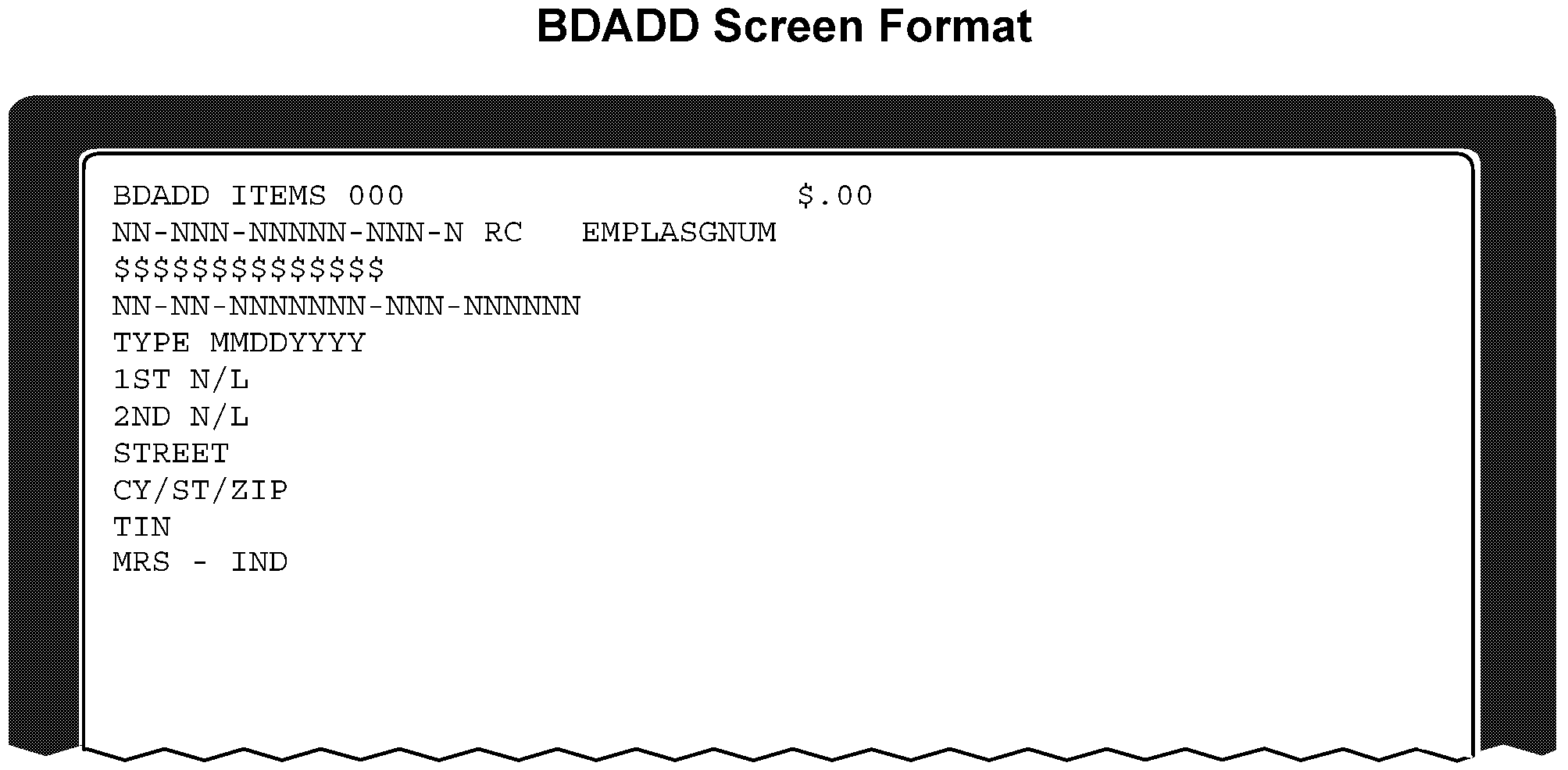
Please click here for the text description of the image.
| Line # | Description |
|---|---|
| Line 1 | BDADD - will remain on the screen. ITEM COUNT - shows how many checks have been added. The count will change with each check entered. RUNNING TOTAL - must balance to the Form 5515. The total will change with each check entered. |
| Line 2 | DISHONORED CHECK NUMBER - Enter the DCN. The number will repeat itself for the twelfth, thirteenth, and fourteenth digits. These three digits (004) are the check number. Input the three-digit check number for each check. RC - Enter the reason code. The reason code tells why the check is dishonored. See the reason code chart in IRM 3.17.10.2.3. EMPASGNUM - Overlay with the employee assignment number if different from the employee of the person who is inputting CC BDADD. |
| Line 3 | AMOUNT OF THE CHECK - Enter the encoded money amount at the bottom of the check. |
| Line 4 | TRACE ID NUMBER - The 20 digit Trace ID Number must be present. |
| Line 5 | TYPE OF THE CHECK - Enter one of the following: "REGU" for a regular check; "SPLIT" for a split check; "MULT" for a multiple check; or, "MUSP" for a split multiple check. IRS RECEIVED DATE - Enter the SF5515 Debit Voucher date of deposit (MMDDYYYY) on which the payment was received by IRS. This date cannot be later than the current date or earlier than the immediately prior year. If the IRS-received date is illegible or not on the remittance, use the earliest readily discernible date after IRS would have received the payment. i.e., SF 5515 voucher date. This date will repeat itself for each item in the group being added; therefore, care must be taken to overlay the correct date for each payment. |
| Line 6 | FIRST NAME LINE - Enter the first name line shown on the check so that the name control underlined on the check is entered first. The length of the First Name Line is limited to thirty-five (35) characters. |
| Line 7 | SECOND NAME LINE - Enter the second name line shown on the check. The length of the Second Name Line is limited to thirty-five (35) characters. This line need not be completed if the check shows no second name line but must be completed for a foreign address. |
| Line 8 | STREET ADDRESS - Enter the street address shown on the remittance. If entry is made on this line, Line 9 must be completed. |
| Line 9 | CITY, STATE, AND ZIP CODE - Enter the city, state, and ZIP Code shown on the check. A major city code is a valid City/State/ZIP input. This line must be completed if there is an entry on Line 8. |
| Line 10 | TAXPAYER IDENTIFICATION NUMBER (TIN) - Enter the Employer Identification Number (EIN) or Social Security Number (SSN), if available. Line 10 must be completed if a transcript is desired. |
| Line 11 | MRS-IND - Enter YES if a transcript is desired. If YES is entered on Line 11, Line 10 must be completed. |
| Line 12 | ERROR MESSAGES - If needed, an error message may appear on this line. If no error message is required, REQUEST COMPLETED will appear on this line. |
| Note: See IRM 2.4.25, Command Codes BDADDR, BDADD, BDAPLR, BDAPL, BDOUTR, BDOUT, BDENT and BDINQ, for specific instructions and error messages. | |
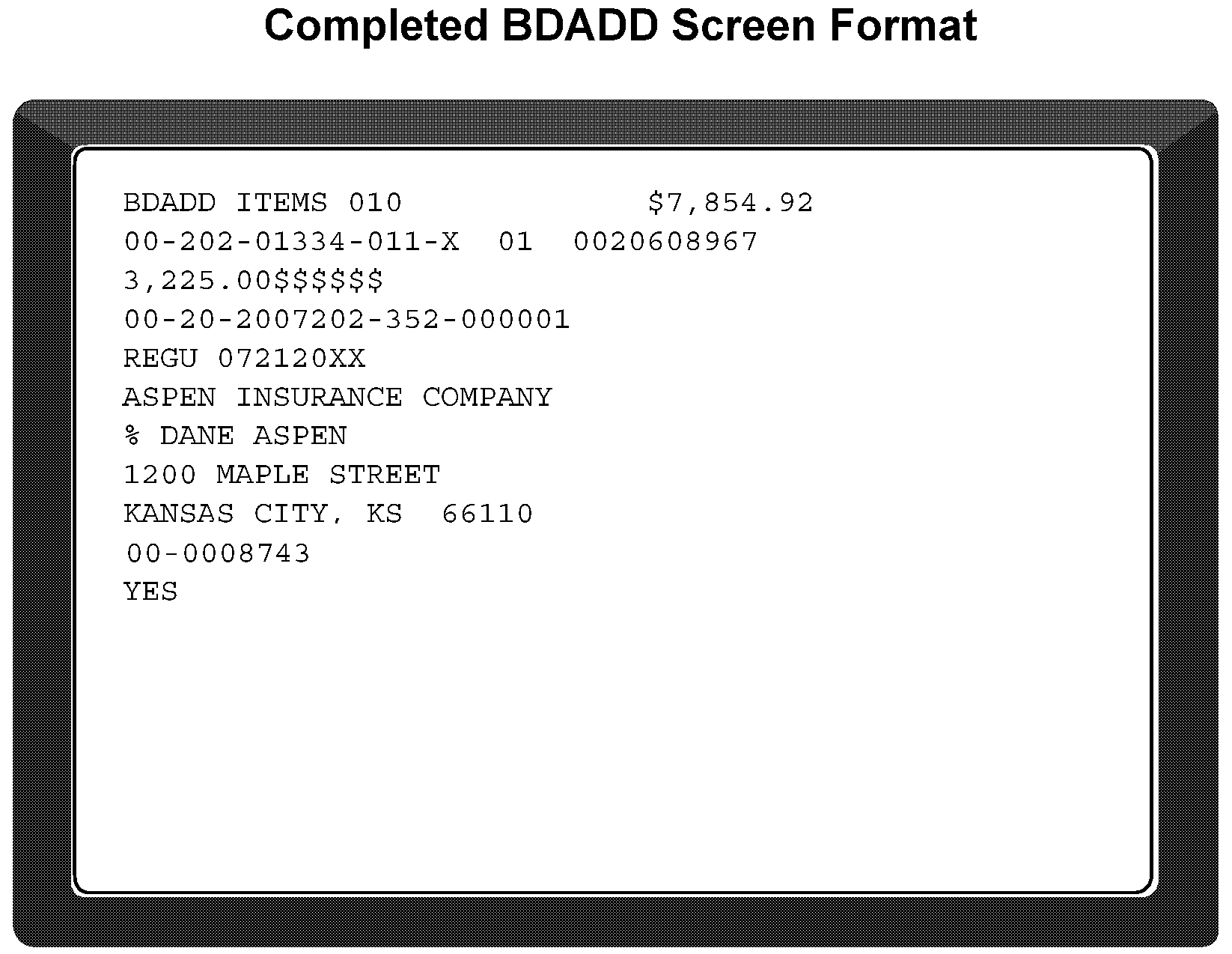
Refer to IRM 2.4.25 for specific command code information.
(1) Input CC BDOUTR to request CC BDOUT format. A new CC BDOUT format will be displayed after each CC BDOUT entry.
(2) CC BDOUT is used to correct or void an erroneous DC record which is on the DCF.
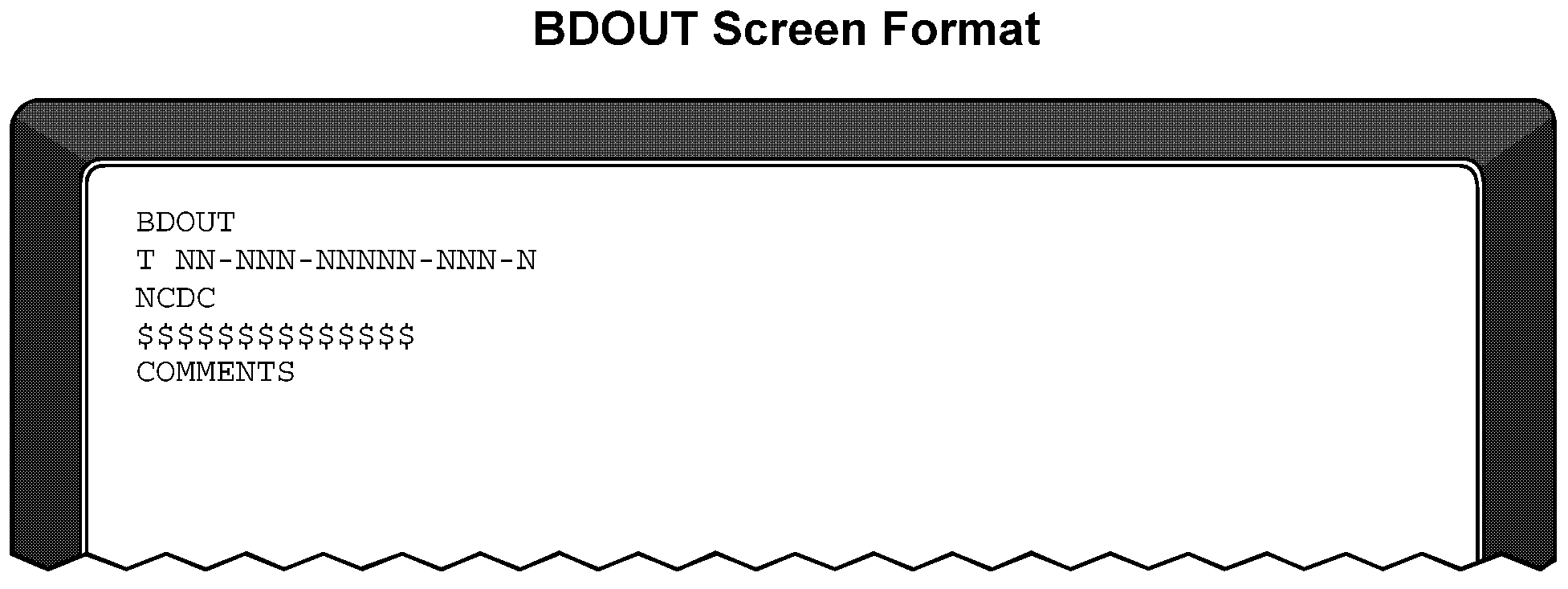
Please click here for the text description of the image.
| Line # | Description |
|---|---|
| Line 1 | BDOUT |
| Line 2 | APPLICATION TYPE - Enter type of void/application. D = Unidentified Remittance File Check. I = Not IRS Check (only if check has been deposited by IRS). R = Redeposited Check. V = Void. X = Missing Check. Z = Change Money Amount. P = Partial Void. A = Payment for Alcohol, Tobacco or Firearms. |
| DISHONORED CHECK NUMBER - Enter the DCN. If D, Z or P are entered on Line 2, Line 4 must be considered. If V or Z are entered on Line 2, Line 5 must be completed. |
|
| Line 3 | NAME CONTROL - Enter the name control as shown on the DCF. |
| Line 4 | MONEY AMOUNT - An entry on Line 4 corrects an erroneous money amount previously entered. If D is entered on Line 2, leave Line 4 blank if the entire balance amount is unidentified. If it is partially unidentified, enter the amount that is unidentified. If Z or P is entered on Line 2, a money amount must be entered on Line 4. |
| Line 5 | REMARKS - If V or Z is entered on Line 2, enter the reason why the DCF record is being changed or voided on Line 5. |
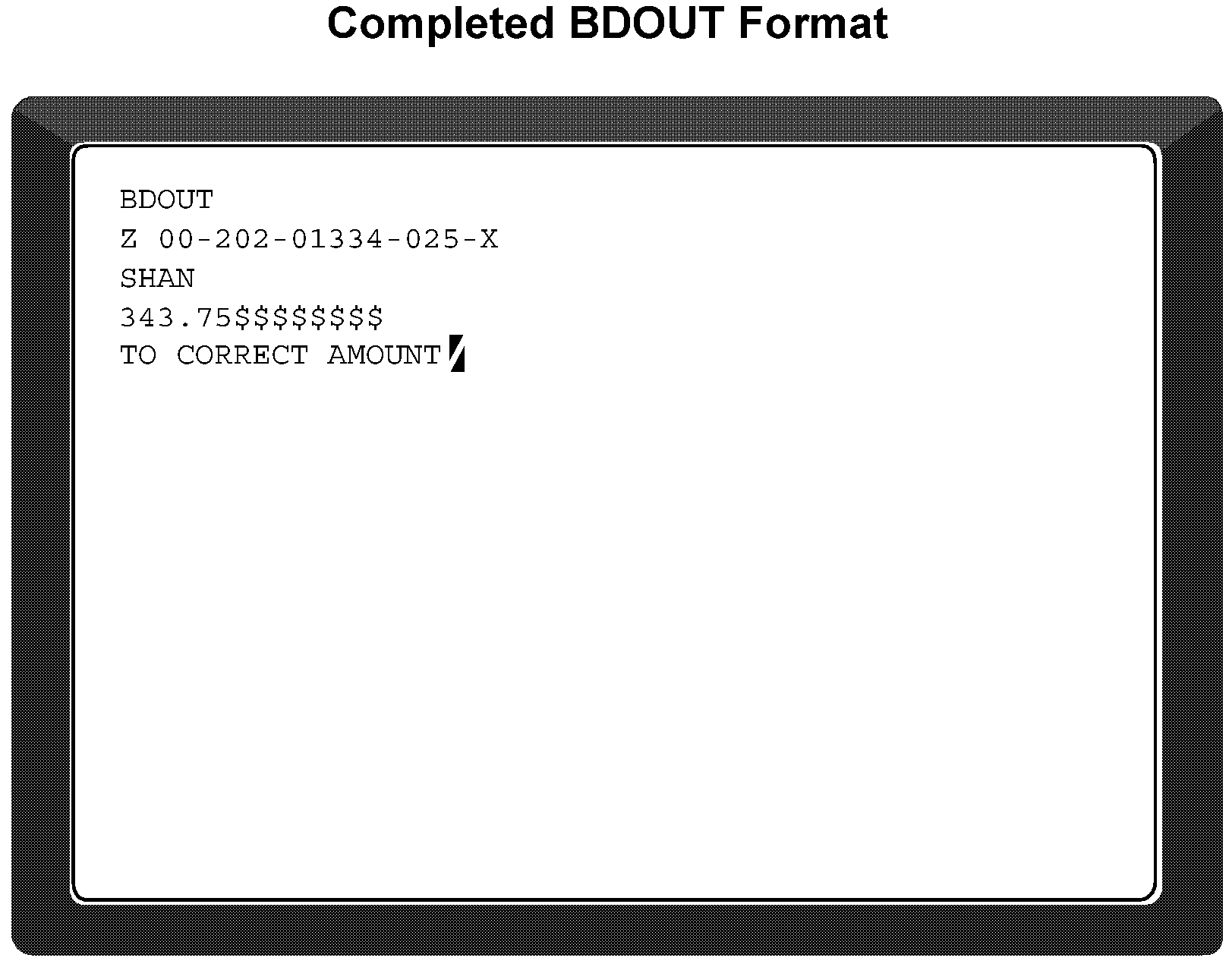
Refer to IRM 2.4.25 for specific command code information.
(1) Input CC BDAPLR to request CC BDAPL format.
(2) CC BDAPL is used to record the application of a dishonored check (in whole or in part) from the DCF to a specific tax module.
CC BDAPLR Input Screen Format

Please click here for the text description of the image.
Response: CC BDAPL. A new CC BDAPL format will be displayed after the CC BDAPLR input screen.
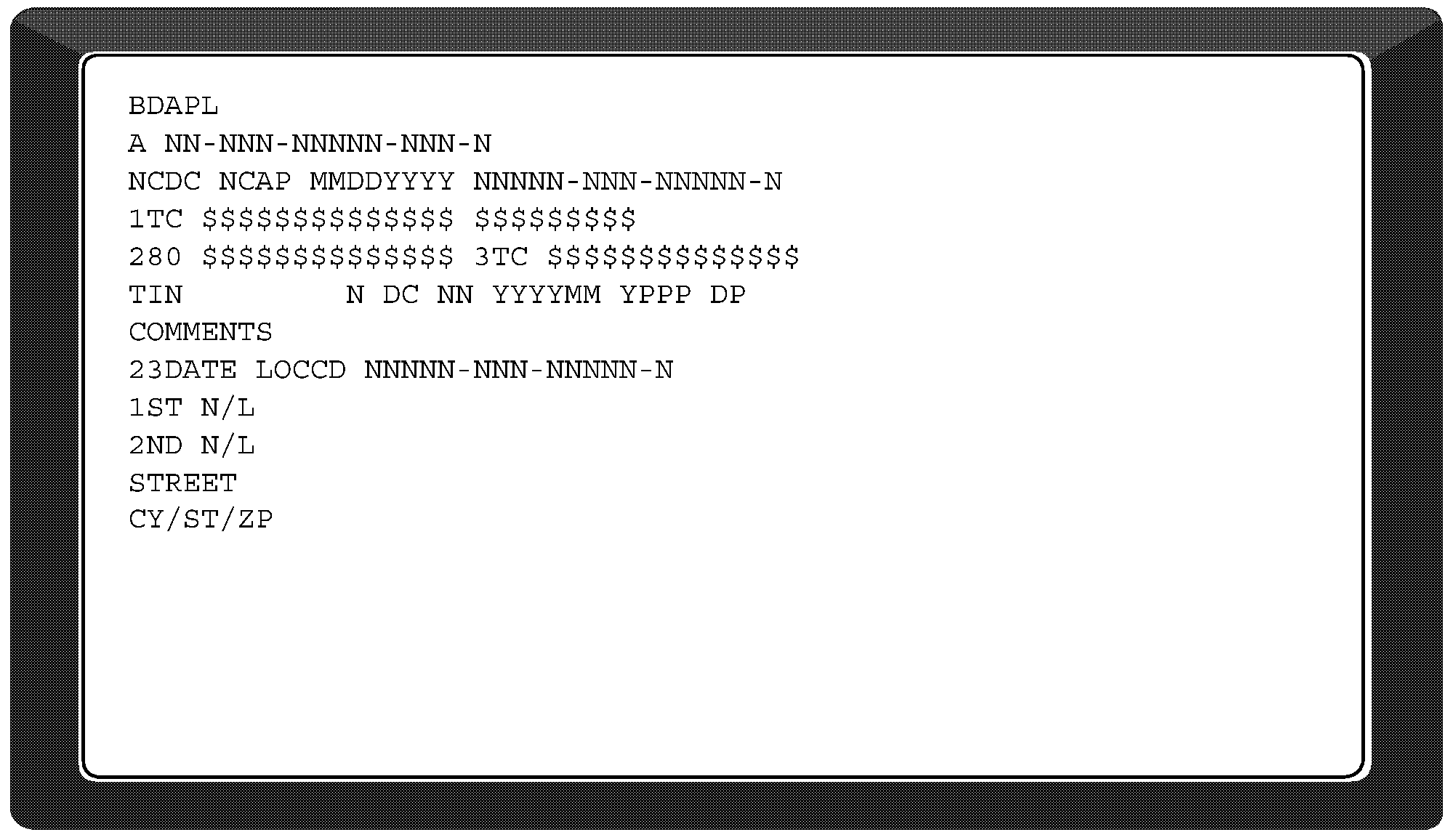
Please click here for the text description of the image.
| Line # | Description |
|---|---|
| Line 1 | BDAPL – will remain on the screen. |
| Line 2 | TYPE OF APPLICATION CODE - Enter "M" for master file, if the document is for IMF or BMF. Enter "N" for NMF. DISHONORED CHECK NUMBER - Enter the Dishonored Check Number. |
| Line 3 | NAME CONTROL FROM CHECK - Enter the name control as recorded on the DCF. CC BDAPL updates the name control on the DCN to the application name control. Any future action requires the use of the "new" name control. Document the "new" name control if changed when inputting split remittance. NAME CONTROL OF DOCUMENT - Enter the name control from return (must match name control on master file). Enter for "M" type application only. RECEIVED DATE - Enter the received date to agree with the date of the credit transaction being reversed. DLN - Enter the DLN of the return or the NMF Unit Ledger Card ID. |
| Line 4 | PRIMARY TRANSACTION CODE - Overlay 1TC with the valid transaction code: 611, 621, 641, 661, 671, 681, 691, or 721. ( Exhibit 3.17.10-1, Table of Valid TC/MFT/Doc Cd (BDAPL), for valid combinations.) MONEY AMOUNT OF PRIMARY TRANSACTION CODE - Overlay $s with the amount of tax credit to be reversed. $s must be completed if any entry is made on Line 4. OTHER PENALTY AMOUNT - If entered, overlay $s with amount which cannot be greater than $999,999,999.99. |
| Line 5 | SECONDARY TRANSACTION CODE - Format will contain a generated TC 280. MONEY AMOUNT OF SECONDARY TRANSACTION CODE- If correct amount of penalty will not be automatically generated or if no penalty is to be assessed, overlay $s with correct amount of penalty to be assessed. Zero cents (.00) is the correct entry when no penalty is to be assessed. TERTIARY TRANSACTION CODE - Enter TC 682 if designated interest payment is to be reversed. MONEY AMOUNT OF TERTIARY TRANSACTION CODE - Overlay $s with amount of designated interest payment to be reversed. |
| Line 6 | TAXPAYER IDENTIFICATION NUMBER - Enter the TIN followed by a valid File Source. Line 2, Item A, must agree with the File Source entered here. DISHONORED CHECK NOTICE INDICATOR - Enter "I" if Form 2287, Notice of Check Not Accepted by Bank, is to be issued. Enter "S" if notice is to be suppressed. Enter "E" if Form 2287 (SP), Notice of Check Not Accepted by Bank, is to be issued. Note: Form 2287/Form 2287 (SP) is IDRS Notice 587. DOCUMENT CODE - Enter the appropriate Document Code: "24" for IDRS NMF; "45" for refund repayments; or" 87" for regular MF and non-IDRS NMF. MFT CODE - Enter the MFT Code. TAX PERIOD - Enter the tax period. EMPLOYEE PLAN/REPORT NUMBER - Enter "y" and employee plan/report number of MFT codes 46, 74 or 76 only. Format is PPP. If MFT is 46, valid Report Number range is 000, 100–199, 300–399, 500–599 and 700–799. If MFT is 74, valid PLAN-NUM range is 001–999. If MFT is 76, valid PLAN-NUM range is 000–499, 501–999. DESIGNATED PAYMENT CD - Must enter 49, 50 or 51 if Primary TC is 695. |
| Line 7 | REMARKS - Enter the necessary information. For example, if an incorrect TIN was used on the return and the correct TIN has been found, enter this information here. The voucher number and date can also be entered for future use in locating worksheets. |
| Line 8 | NMF 23C DATE, LOCATION CODE AND DOCUMENT LOCATOR NUMBER - Entries must be made on this line if Type of Application Code shown in Line 2A is "N" . |
| Line 9 | NAME - Enter the name as shown on the return or CC ENMOD from IDRS, placing the surname first followed by a comma and first name(s). |
| Line 10 | SECOND NAME LINE - Enter as shown or if not present, leave blank. CC BDAPL updates entity information upon application. If a second name line or street address is present on the file which is not part of the new address and will not be overlaid, it must be deleted by using CC BDENT or it will appear on all future communications with the taxpayer. Once the case is closed from the DCF, CC BDENT cannot be used to make entity changes. |
| Line 11 | ADDRESS - Enter as shown from the return or CC ENMOD. Changes to the address can also be made in the following situations: a. Change the address if the taxpayer positively requests the change. Underlining, circling or annotating the printed address on the check constitutes a positive request. b. Change the address if correspondence (including notices and envelopes) sent by the IRS that requires a response is returned by the taxpayer with corrections marked to the taxpayer's address information. Note: The correspondence will constitute clear and concise written notification of a change of address. The taxpayer's signature on the correspondence is not required. c. An address change can be taken from the taxpayer over the telephone only IF the information is received while working another issue (for example, talking to the taxpayer about another tax-related issue). The history sheet must be annotated and remain with the case. If for any reason you do not feel comfortable taking the information over the telephone, ask the taxpayer to submit the information in writing. If the only issue is an address change, the change must be submitted in writing. d. Only if no other address is shown, use the check address. |
| Line 12 | CITY, STATE AND ZIP CODE - The name and address information are extracted from the TIF. If the name and address is not on the TIF, then the address is extracted from the DCF database. If the address information is incorrect, the information will need to be overlaid with the correct information. Note: When entering a foreign address, enter a # sign in the first position of the City/State/ZIP Code line. |
Refer to IRM 2.4.25 for specific command code information.
(1) CC BDENT is used to update the FIRST NAME LINE, SECOND NAME LINE, STREET ADDRESS, CITY-STATE-ZIP, TIN, EMPLOYEE NUMBER and TRACE ID NUMBER of a record on the DCF.
CC BDENT Input Screen Format
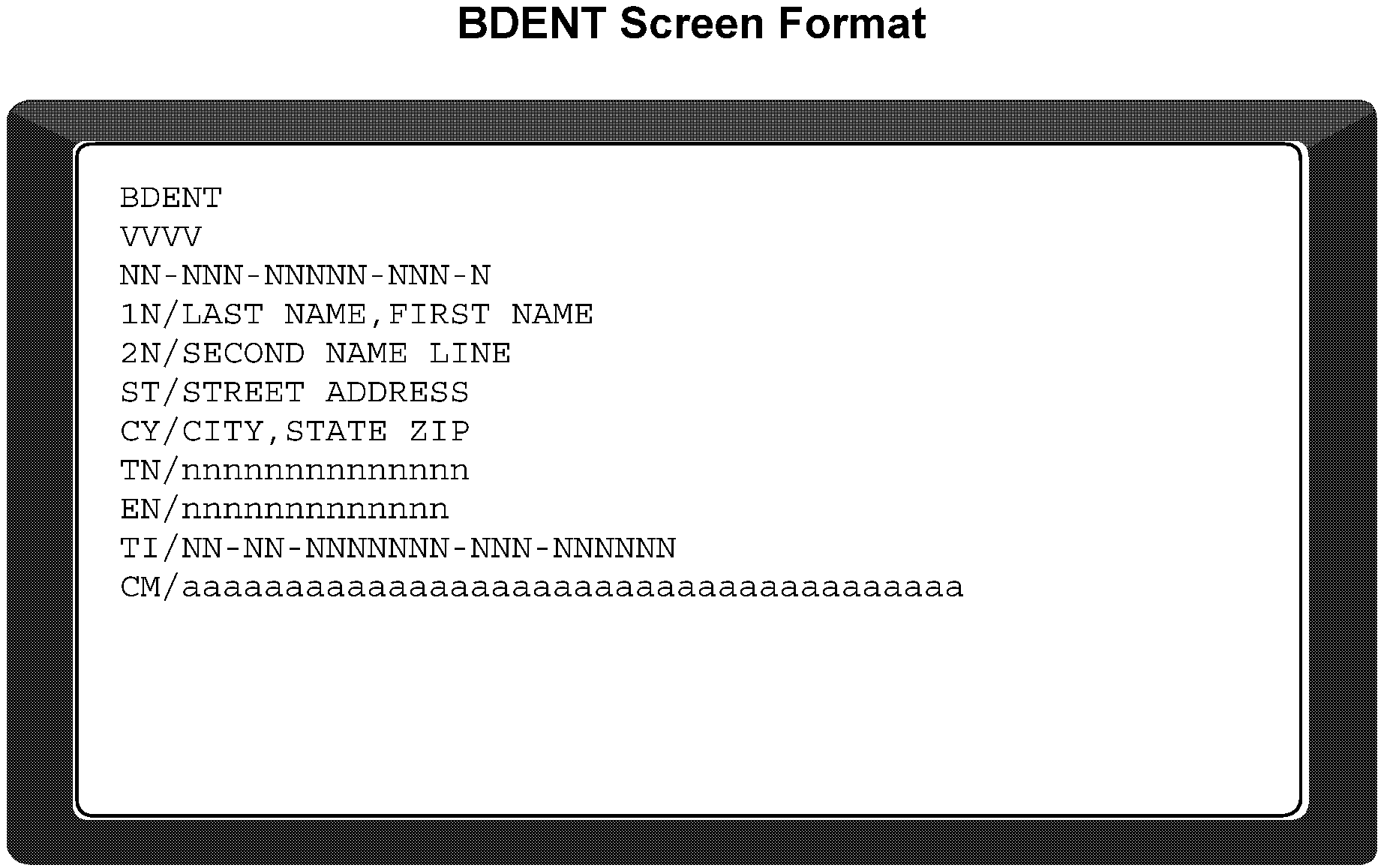
Please click here for the text description of the image.
| Line # | Description |
|---|---|
| Line 1 | BDENT |
| Line 2 | NAME CONTROL - Enter the name control presently on DCF. |
| LINE 3 | CONTROL NUMBER - Enter the DCN. |
| Lines 4-11 | ENTITY ELEMENTS BEING CHANGED - Lines 4-10 are used to update the First Name Line; Second Name Line; Street Address; City, State and Zip Code; TIN, Employee Number and/or Trace ID Number. The first element being changed must be entered on line 4; the next element being changed must appear on Line 5 and so on. a. First Name Line - enter 1N/ immediately followed by the new first name line on Line 4. The length of the first name line is limited to thirty-eight (38) characters. A new name control will be generated for the record from the first four characters entered after 1N/. b. Second Name Line- enter 2N/ immediately followed by the new second name line on the next unused line of the format. The length of the second name line is limited to thirty-eight (38) characters. To delete an existing second name line from DCF, enter SECOND NAME LINE DELETE IND 2N/ZZ. c. Street Address - enter ST/ immediately followed by the new street address on the next unused line of the format. To delete an existing street address from DCF, enter STREET-ADDR-DELETE-IND ST/ZZ. d. City, State and ZIP Code - CY/ immediately followed by the new date on the next unused line of the format. A major city code is valid City/State/ZIP input. e. TIN - enter TN/ immediately followed by the TIN (including hyphens) on the next unused line of the format. f. Employee Number – enter EN/ immediately followed by the new employee number on the next unused line of the format. The length of the employee number is limited to thirteen (13) characters. (No history recorded.) g. Trace ID Number – TI/ immediately followed by the new Trace ID Number on the next unused line of the format. The length of the Trace ID Number is limited to twenty (20) characters. h. Comments – enter CM/ immediately followed by remarks not to exceed thirty-eight (38) characters. |
| Line 13 | Error Messages- If needed, an message will be displayed on Line 13. If no error message is required, REQUEST COMPLETED will appear on this line. |
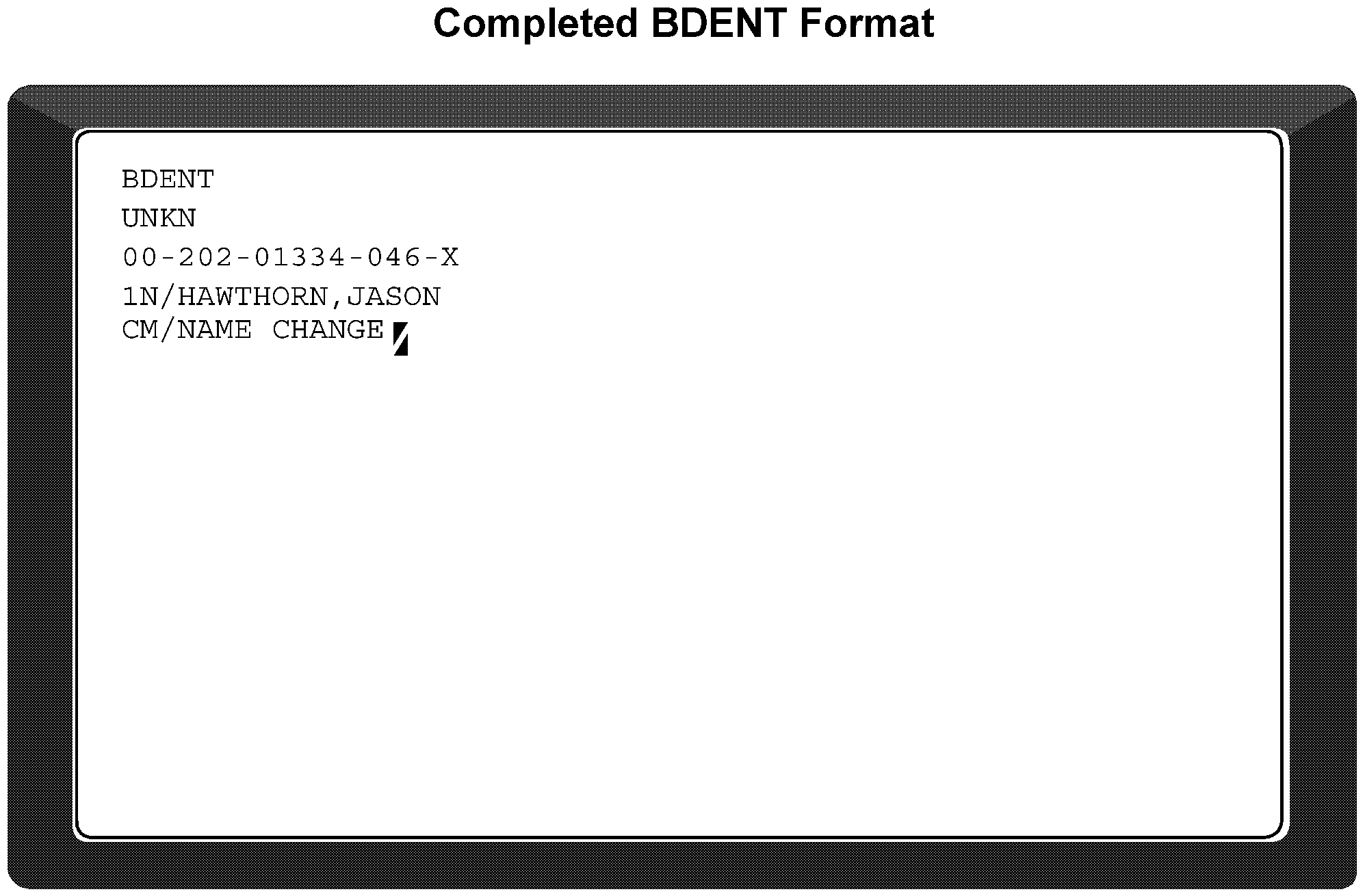
Refer to IRM 2.4.25 for specific command code information.
(1) CC BDINQ is used to display an entire DC record. All data on the DCF pertaining to a particular dishonored check will be displayed. This consists of the basic dishonored check data plus history records of all actions taken and current status.
CC BDINQ Input Screen Format
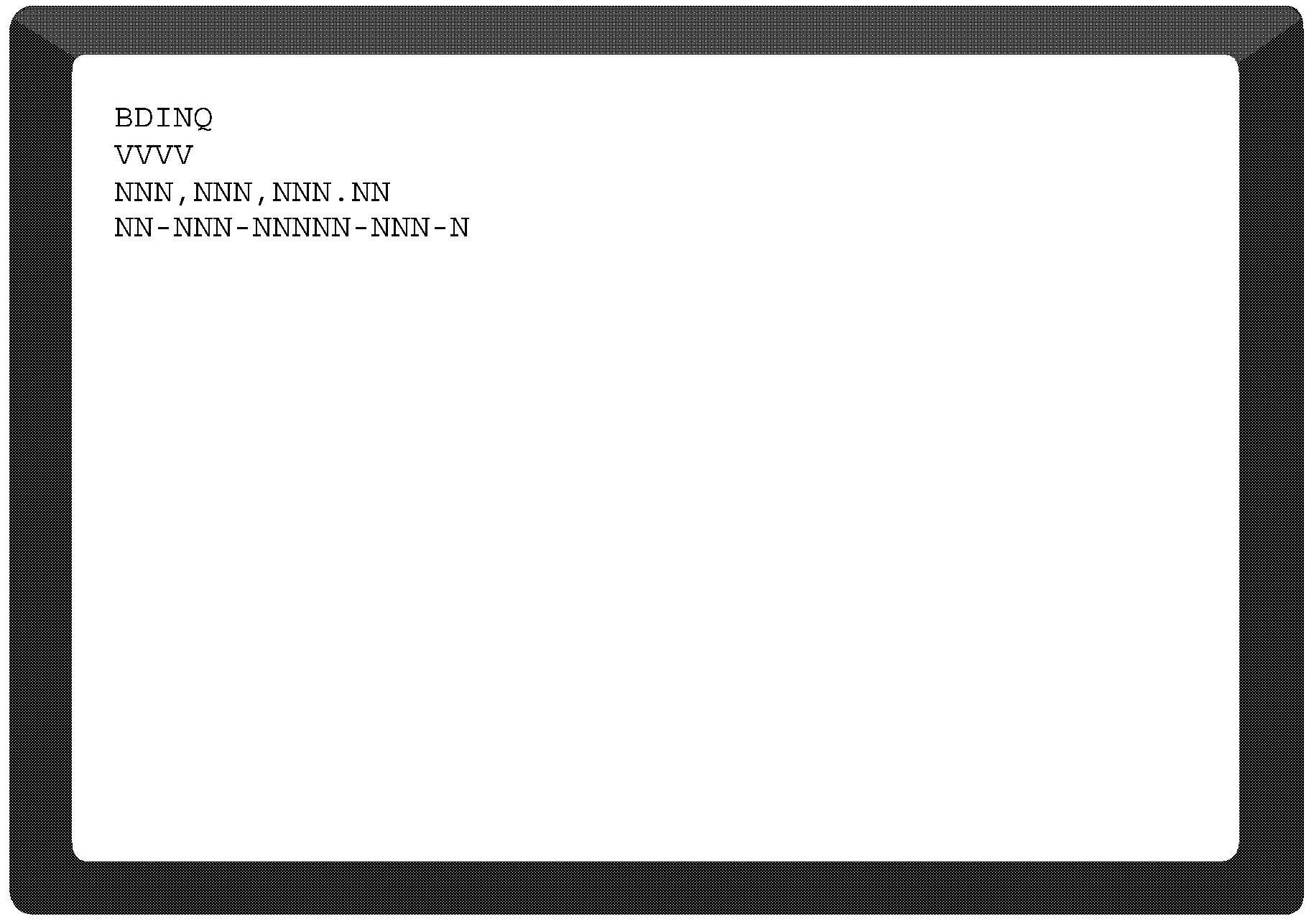
Please click here for the text description of the image.
| Line # | Description |
|---|---|
| Line 1 | BDINQ. |
| Line 2 | DISHONORED CHECK NAME CONTROL. |
| Line 3 | MONEY AMOUNT - Enter the amount of the check with decimal point and comma(s) when present. |
| Line 4 | DISHONORED CHECK CONTROL NUMBER - Enter the complete DCN or its first two digits. |
| Line 5 | ERROR MESSAGES - If needed, an error message as described in IRM 2.4.25 may appear on this line. |
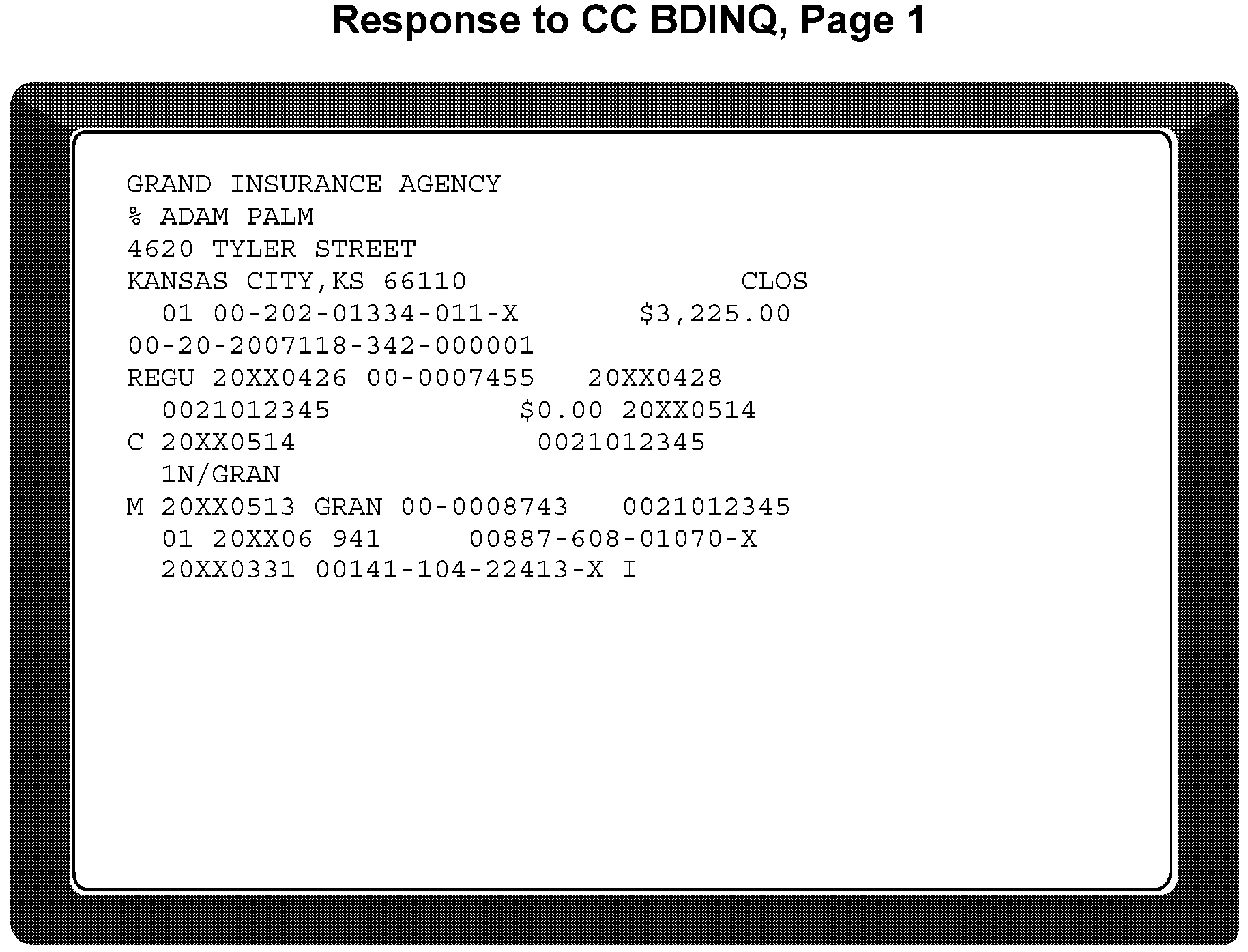
Please click here for the text description of the image.
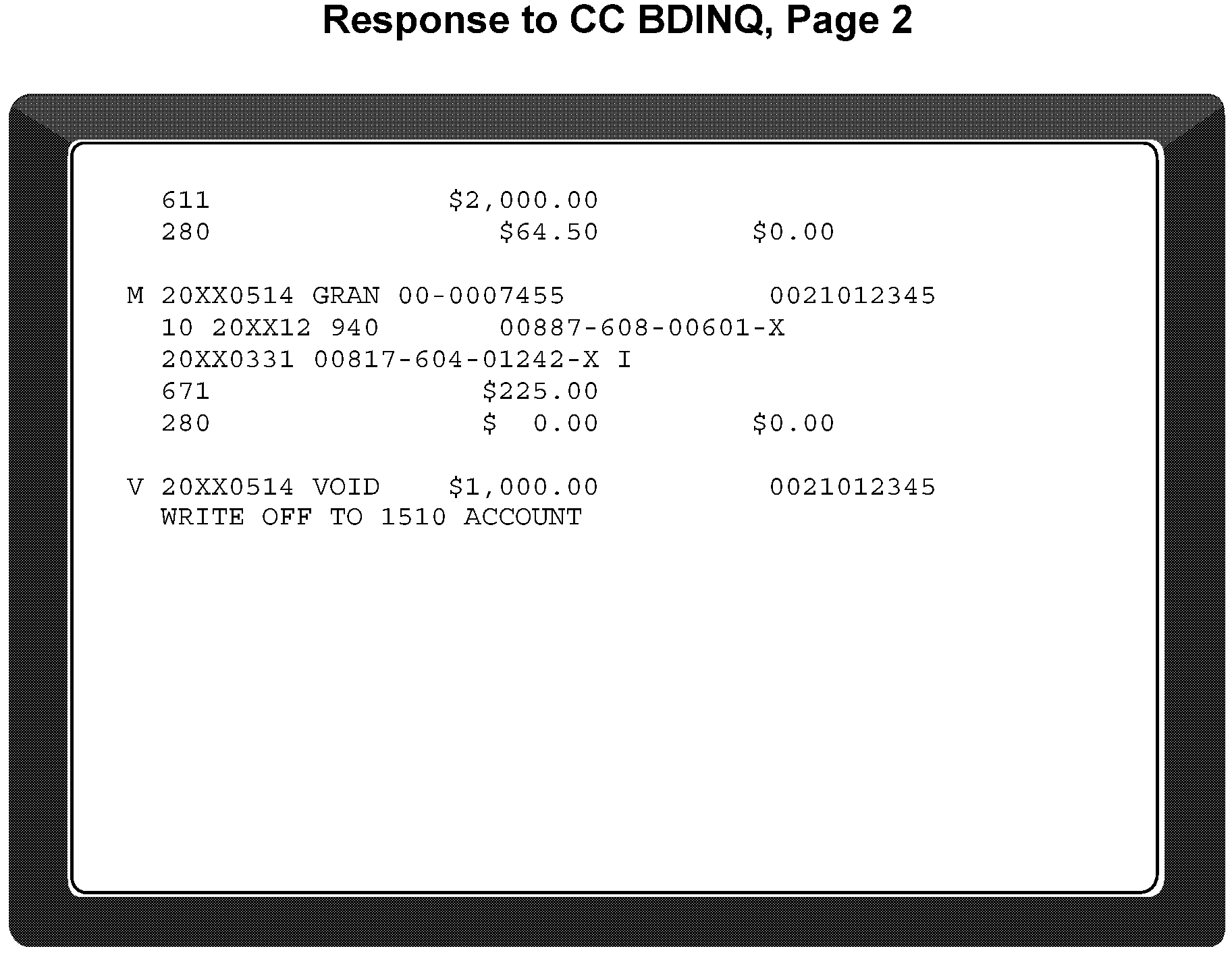
Refer to IRM 2.4.24 for specific command code information.
(1) Input CC FMADD to request CC URADD format.
(2) CC URADD is used to establish a record of an unidentified remittance in the URF.
CC FMADD Input Screen Format

Please click here for the text description of the image.
Response: CC URADD will be displayed after the CC FMADD screen is transmitted.
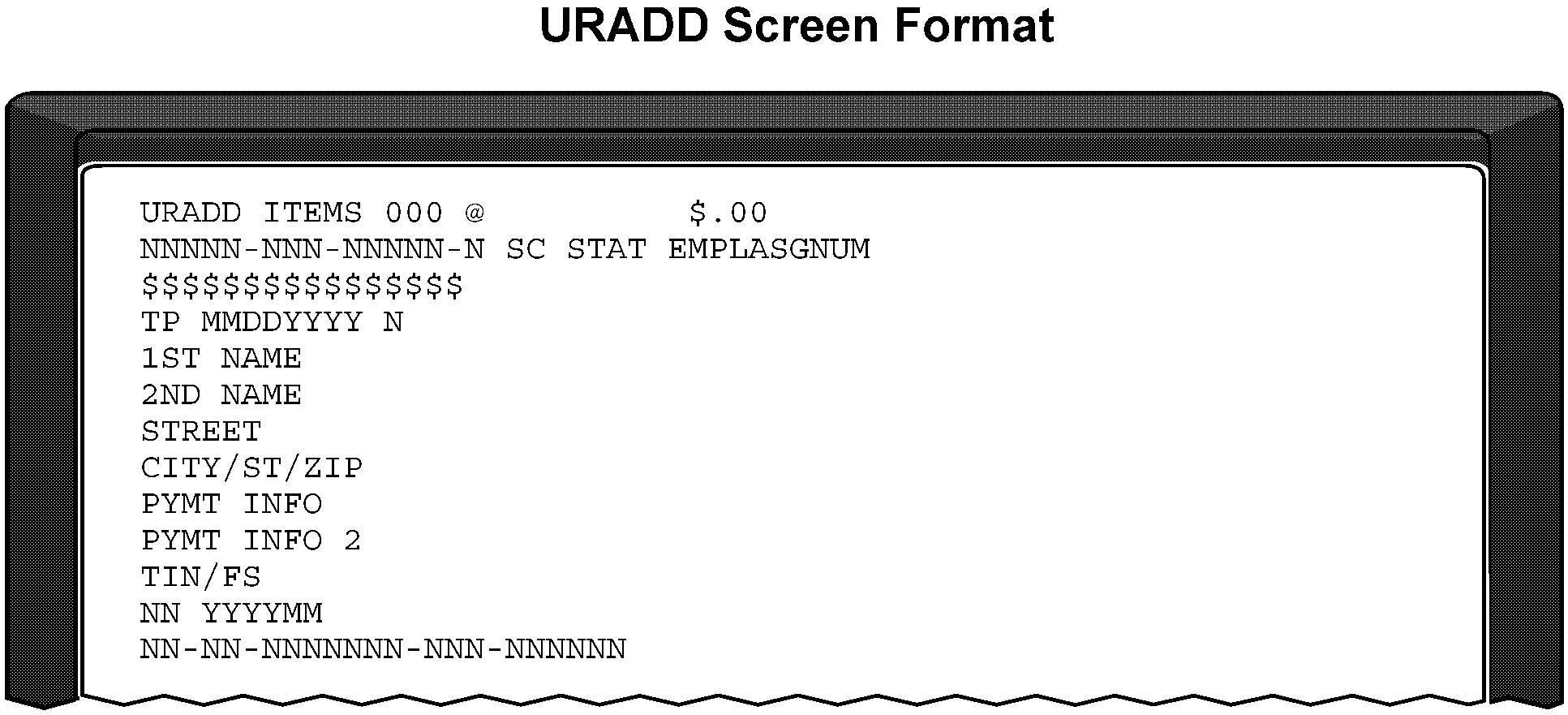
Please click here for the text description of the image.
| Line # | Description |
|---|---|
| Line 1 | CC URADD. ITEM COUNT - The item count shows how many credits have been added. The count will change with each credit entered. RUNNING TOTAL - The running total shows the dollar amount of all credits entered. |
| Line 2 | UR CONTROL NUMBER - Overlay "Ns" with the Unidentified Remittance Control Number (URCN), using the original DLN as the URCN on Adjustment, Reject, Nullified, Reject, Nullified Unpostable and Non-Master file cases. Julian Date "999" is valid on the URF. The URCN on cases having no previous DLN will be numbered. Digits 1-2 - Area Office or Submission Processing Campus (do not use the dump district number). Digits 3-5 - Will be 009 if the payment was added by the Deposit section. Otherwise, it will be the tax class and doc code of the payment DLN. Digits 6-9 - Sunday Julian Date of the current week, regardless of deposit date; or date described in IRM 3.17.10.3.2(1). Digits 9-11 - 000-599. Digits 12-13 - Serial Number Digit 14 - Current Year |
| SOURCE CODE - Enter source code, identifying area in which UR record originated: AD - Adjustments AM - Accounts Maintenance CO - Collection DO - District Office EF - Electronic Fund Transfers FD - Federal Tax Deposit NM - Non-Master File NU - Nullified Unpostables OT - Other P1 - Project 1 P2 - Project 2 RJ - Reject Function ST - Statute UR - Clearing and Deposit Function |
|
| STATUS CODE - Overlay status code, reflecting the classification of the UR record: OPEN - Remittance is not identified and requires research to locate correct tax module. If left blank, status will be OPEN. IDEN - Remittance is identified. Legal or procedural restrictions prevent the intended application of the credit. |
|
| EMPLOYEE ASSIGNMENT NUMBER - Overlay with Employee Assignment Number if different from employee number of the person using CC URADD. | |
| Line 3 | AMOUNT - Overlay "$s" with UR amount, starting with first $ on left, including the period and comma(s) i.e., 157.32$$$$$$. |
| Line 4 | TYPE OF PAYMENT - Enter type of remittance received: BC - Business Check CA - Cash (including cash conversions) CC - Cashier's Check FD - Federal Tax Deposit (including Certificates of Deposit) GC - Government Check MO - Money Order PC - Personal Check UK - Unknown |
| RECEIVED DATE - Enter current or prior received date (not more than one year old) in MMDDYYYY format. Cannot be future date. UR NOTICE INDICATOR - show whether a Letter 6268/ Letter 6268 (SP) is to be generated: Y - Notice to be computer-generated E - Spanish Notice to be computer-generated Blank - No notice to be sent |
|
| Line 5 | 1ST NAME LINE - Overlay with first name line of the taxpayer. The first four positions identify the name control determined as directed in Document 7071Name Control Job Aid for Individual Master File (IMF) Taxpayers or Document 7071-ABMF Name Control Job Aid. Use a comma in the first name line only when the order has been changed to create the correct name control, i.e., Carter Rvoc Tr., John. The length of 1st Name Line is limited to thirty-five (35) characters. These instructions must be followed explicitly so that the taxpayer is addressed properly in the generated Letter 6268/Letter 6268 (SP). |
| Line 6 | 2ND NAME LINE - Overlay with second name line, if there is one. Length of name line is limited to thirty-five (35). |
| Line 7 | STREET - Overlay with street address, if known. |
| Line 8 | CITY/STATE/ZIP CODE - Overlay with city, state, and ZIP Code. These must be present if a Letter 6268/Letter 6268 (SP) is to be generated. Input as follows: City, comma, 2-position standard state abbreviation, space, ZIP Code. The city cannot exceed 16 characters in length. A pound sign (#) in the first position show a foreign address and requires only that the rest of the input field not be blank. A Major City Code followed by a blank and the ZIP Code is valid City/State/ZIP Code input. |
| Line 9 | PAYMENT INFORMATION - Must be present. Entry can include check number, name of bank, telephone number, and any potentially helpful entity information such as filing status or type of return. |
| Line 10 | 2ND PAYMENT INFORMATION - Optional; used as continuation of line 9, if needed. |
| Line 11 | TIN - Overlay in SSN/EIN format, if known. |
| Line 12 | MFT - Overlay with MFT, if known, and line 11 is completed. TAX PERIOD - Overlay with tax period if known, and line 11 is completed. |
| Line 13 | TRACE ID NUMBER - The 20 digit Trace ID Number must be present. |
| Line 14 | ERROR MESSAGES - Any messages denoting erroneous input will appear here. See IRM 2.4.24 for messages, error conditions, and solutions. |
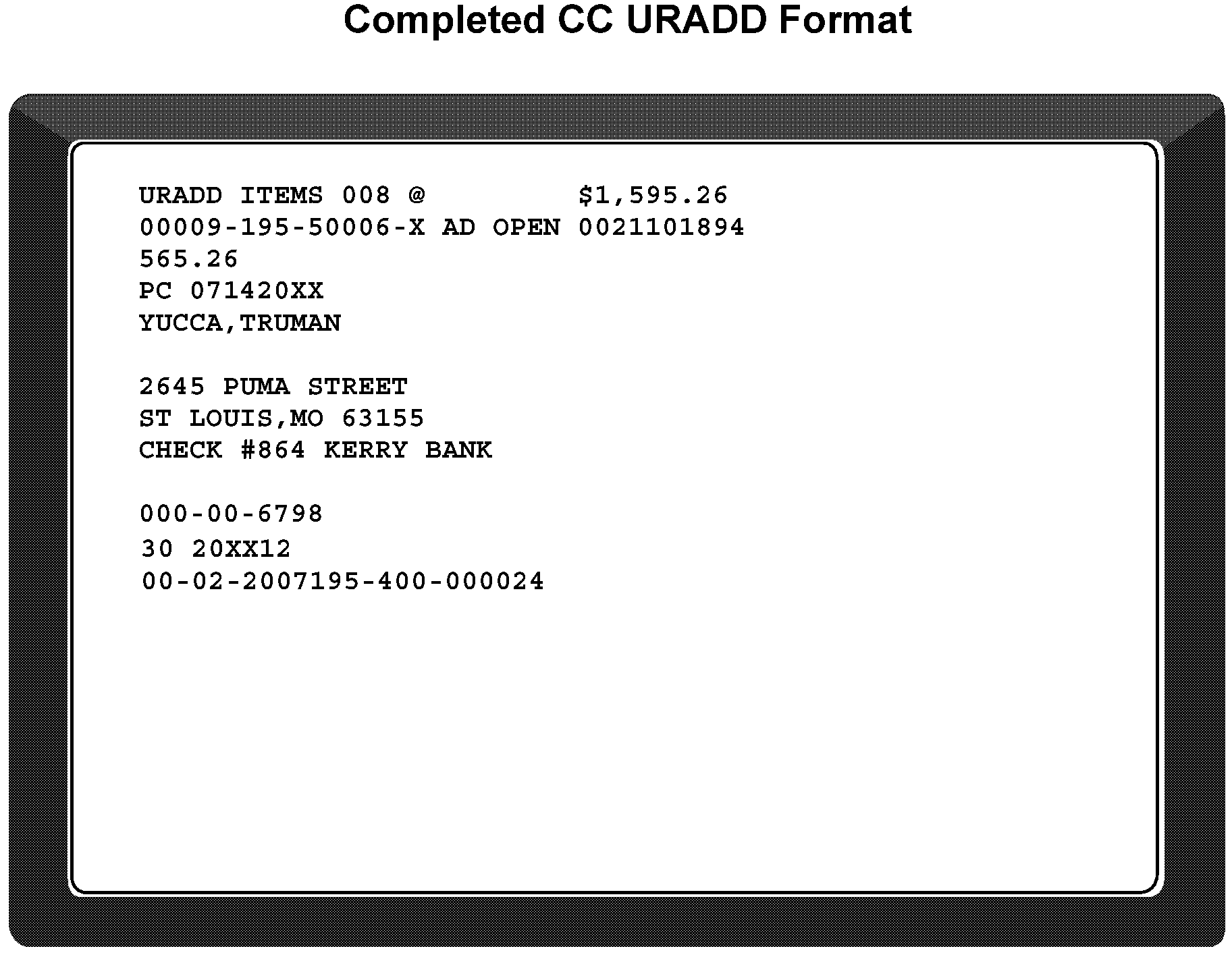
Refer to IRM 2.3.20 for specific command code information.
(1) CC URINQ is used to request for display one or more records in the URF, based on the data elements input.
(2) Research can be done in 3 ways: by amount of the remittance, by name control, or by DLN.
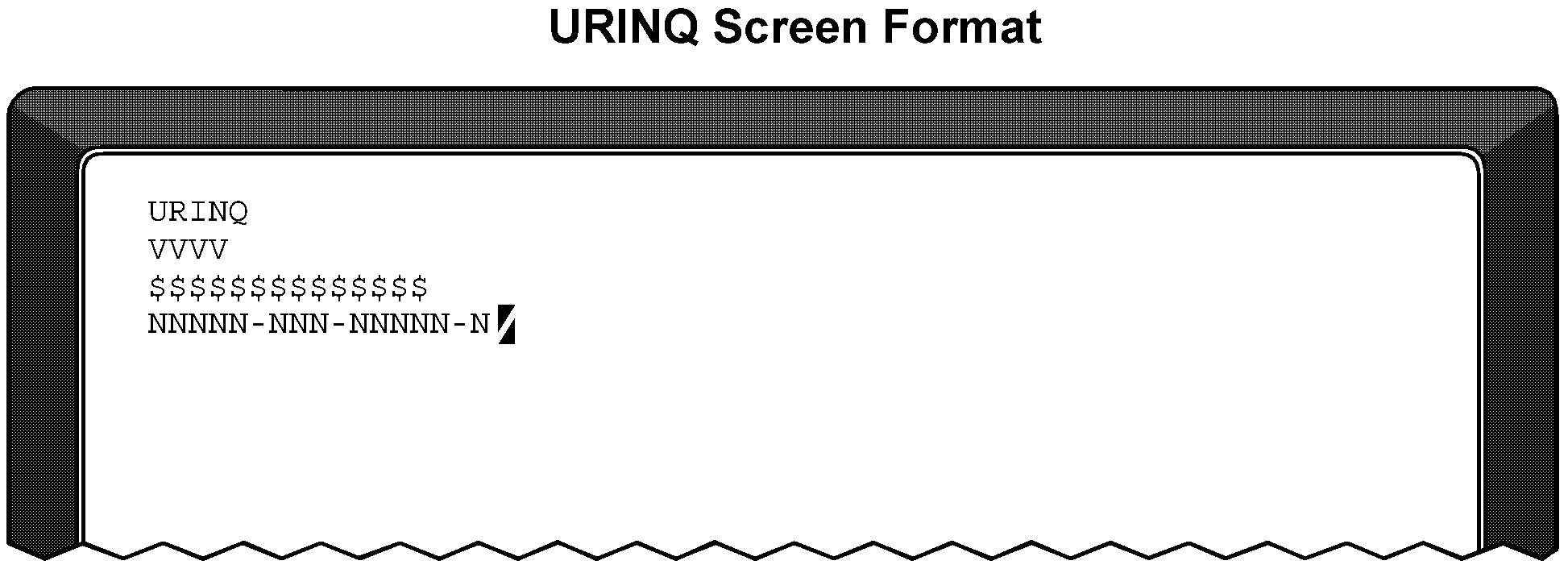
Please click here for the text description of the image.
| Line # | Description |
|---|---|
| Line 1 | CC URINQ. |
| Line 2 | NAME CONTROL - Enter the valid name control from the UR case or form as directed in Document 7071 or 7071-A. Enter "UNKN" if the case has been added to the URF as "Unknown" . Leave line 2 blank if the name control is not known. An inquiry produces a display of the complete UR record. |
| Line 3 | REMITTANCE AMOUNT - Enter the money amount, including decimal point and comma(s). Leave line 3 blank if the amount is not known. An inquiry to the amount file produces a display of only the name control and URCN. a. To display the complete record, place an asterisk in front of the record. b. To return to the menu, move to Line 2 and transmit. The menu will return with the pound sign (#) in front of the last complete record retrieved. |
| Line 4 | DOCUMENT LOCATOR NUMBER - Enter the 2-digit file location number or the complete URCN. An inquiry produces a display of the complete UR record. |
| Line 13 | ERROR MESSAGES - An error message as described in IRM 2.3.20 may appear in this line. |
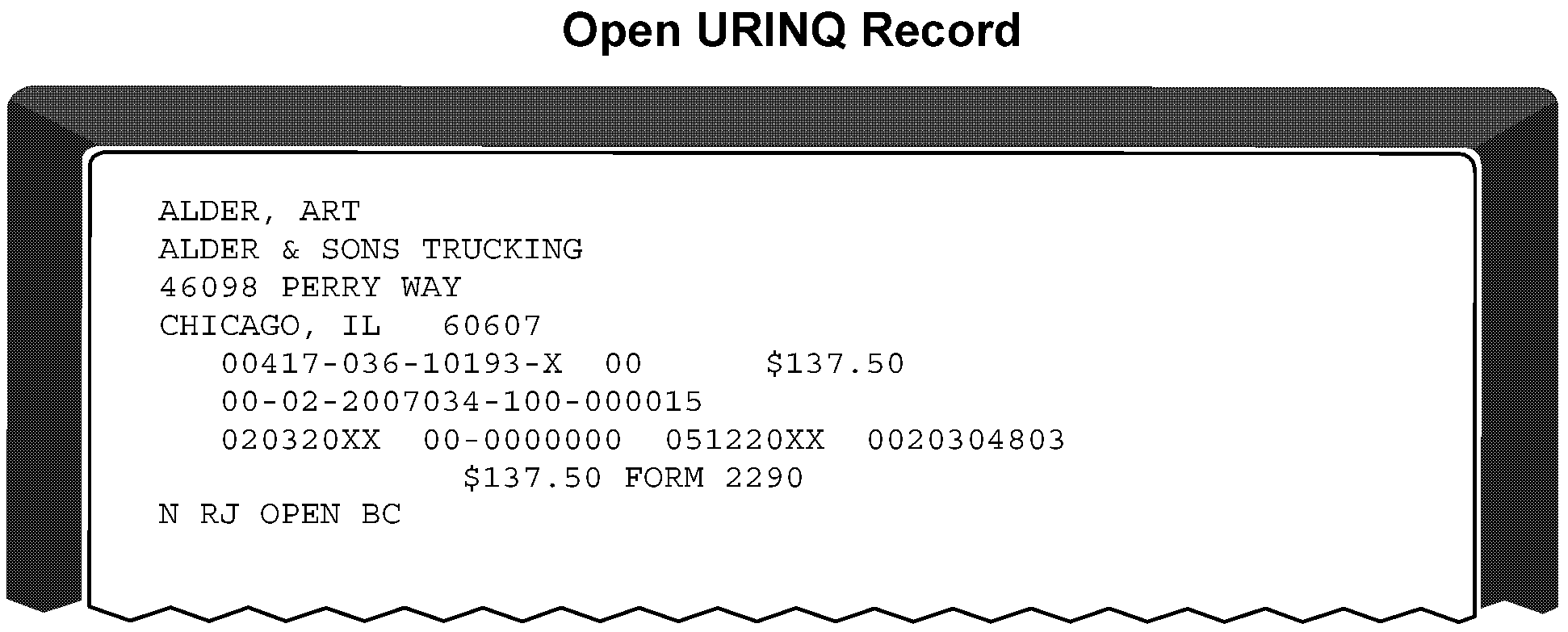
Please click here for the text description of the image.
CC URINQ Response Record
Fields are only completed if information was known at time record was entered on the URF or information has been added via CC URENT. The Name Control and amount will always appear.
| Line # | Description |
|---|---|
| Line 1 | 1ST NAME LINE - The first four positions identify the name control. |
| Line 2 | 2ND NAME LINE |
| Line 3 | STREET ADDRESS |
| Line 4 | CITY/STATE/ZIP CODE |
| Line 5 | UR CONTROL NUMBER - Original DLN of the credit received from Adjustments, Rejects, Nullified Unpostables or Non-Master File. If credit had no previous DLN, it will carry an "009" number assigned by the Cashier Function. UR CAMPUS CODE - A generated 2-digit code identifying the campus entering the payment to the URF. AMOUNT - Original amount of credit added to the URF. |
| Line 6 | TRACE ID NUMBER |
| Line 7 | IRS-RECEIVED DATE TIN ENTRY DATE TO THE URF EMPLOYEE ASSIGNMENT NUMBER |
| Line 8 | AMOUNT PAYMENT INFORMATION - Current amount of credit on the URF. |
| Line 9 | NOTICE INDICATOR SOURCE CODE STATUS CODE TYPE OF PAYMENT |
Refer to IRM 2.4.24 for specific command code information.
(1) Use CC URENT to do one or more of the following: change the status of an UR record from OPEN to IDEN, or IDEN to OPEN; to record follow-up actions; to generate a Letter 6268/Letter 6268 (SP); to change the received date of a record; or to add/change the employee number, or SSN/EIN.
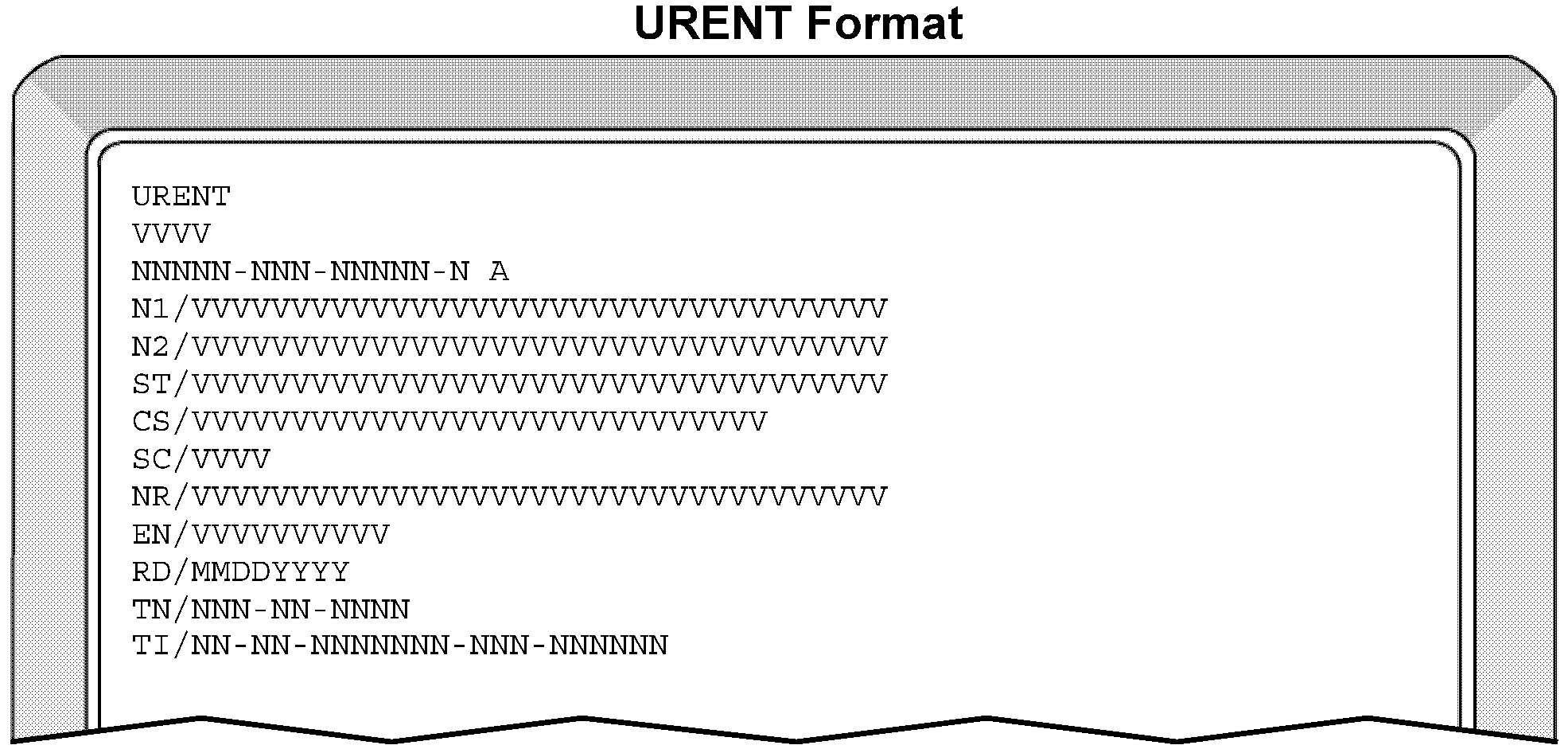
Please click here for the text description of the image.
| Line # | Description | |
|---|---|---|
| Line 1 | CC URENT | |
| Line 2 | NAME CONTROL - Overlay name control as shown on the UR record | |
| Line 3 | UR CONTROL NUMBER - Type in the UR control number as shown on the UR record. NOTICE INDICATOR - show whether a Letter 6268/Letter 6268 (SP) is to be sent. |
|
| Y - Notice to be computer-generated blank - No notice to be sent E - Spanish letter to be computer-generated |
||
| Lines 4-10 | URF ELEMENT CHANGES - Lines 4-10 are used to make changes. The first element being changed or added must be entered on Line 4. The next element being changed or added must be entered on Line 5, etc. | |
| a. New name line - If being changed, enter N1/ immediately followed by the new name line. Length of name line is limited to thirty-five (35) characters. A new name control will be generated for the URF record. The first position of the new name line must be alpha or numeric. | ||
| b. New second name line – If being changed, enter N2/ immediately followed by the new second name line. First position must be alpha or numeric. Length of name line is limited to thirty-five (35) characters. | ||
| c. New street address – enter ST/ immediately followed by the new street address. The first position of the new address line must be a valid character other than a blank. Optional when changing city/state ZIP. | ||
| d. New city/state/ZIP Code - Must be present when electing Y on Line 3 if there is no city/state/ZIP Code present on the URF for this account. Enter CS/ immediately followed by the new entry of one of the following: 1. A valid major city code followed by a blank and the ZIP Code. 2. City, comma, 2-position standard state abbreviation, blank, ZIP Code. 3. Pound sign (#) in position one followed by the foreign address. |
||
| e. New status code - Enter literal SC/ immediately followed by the status change. Values are: 1. OPEN – remittance unidentified. 2. IDEN – remittance identified. 3. FROZ – record is frozen. All other status changes are generated. |
||
| f. New narrative - Enter NR/ immediately followed by new entry. First position cannot be blank. The field is limited to 38 characters (N/R + 35 characters). | ||
| g. New employee assignment number - Enter EN/ immediately followed by new 10-digit employee assignment number. Must be numeric. | ||
| h. New IRS-received date - Enter RD/ immediately followed by the correct received date in MMDDYYYY format. (It is acceptable to change the received date to over one year. However, if it is not closed or changed back, it will drop to Account 6800, Excess Collection, at month's end.) | ||
| i. New Taxpayer Identification Number - Enter TN/ immediately followed by new Social Security or Employer Identification Number. Field cannot exceed 11 characters. | ||
| j. Trace ID Number - Enter TI/ immediately followed by new 20 digit Trace ID Number. | ||
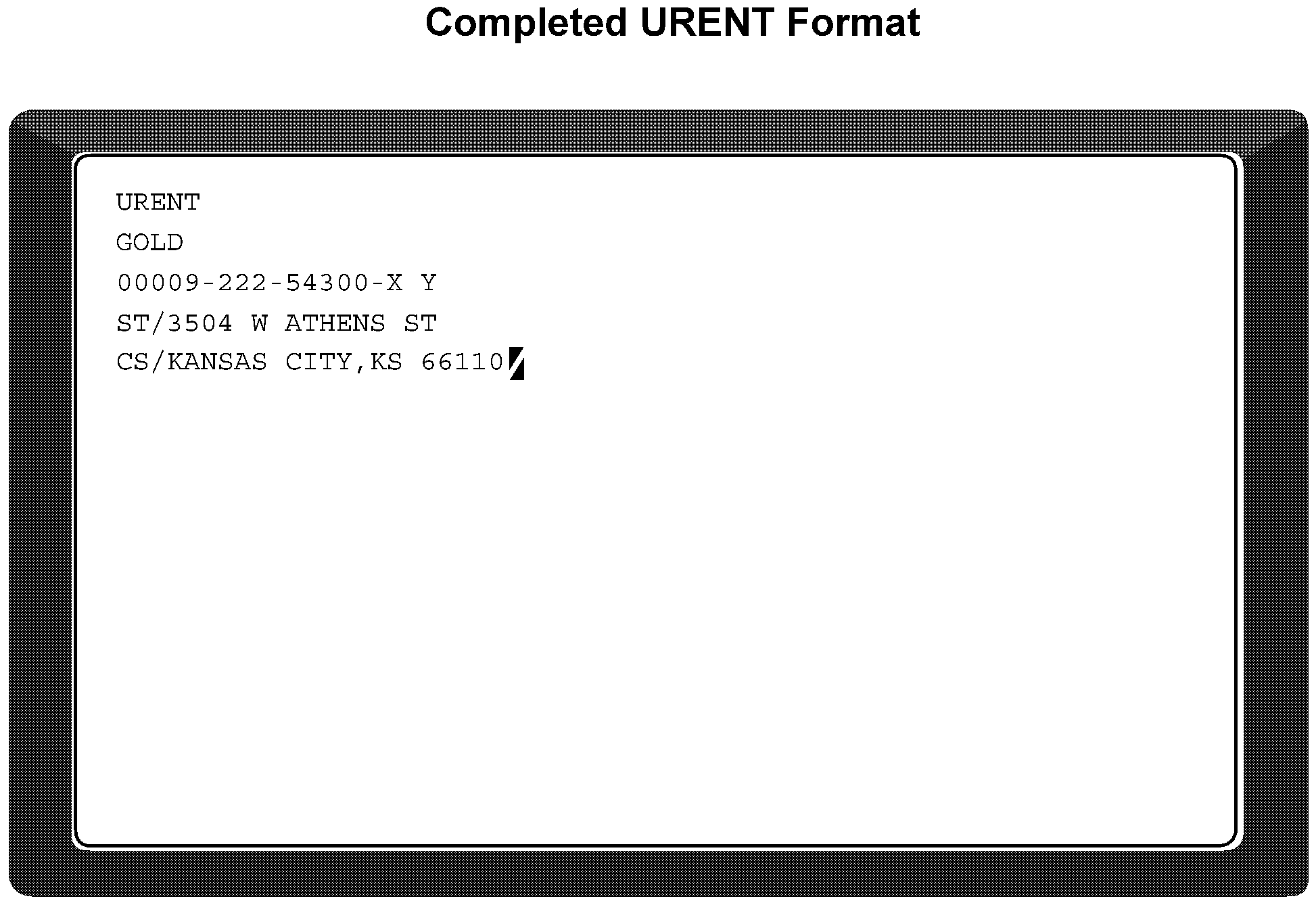
Refer to IRM 2.4.24 for specific command code information.
(1) Use CC UROUT in conjunction with a TYPE-OF-APPLICATION code (Z, V or D) to record a dishonored check, or to correct an erroneous UR record, or to void a record.
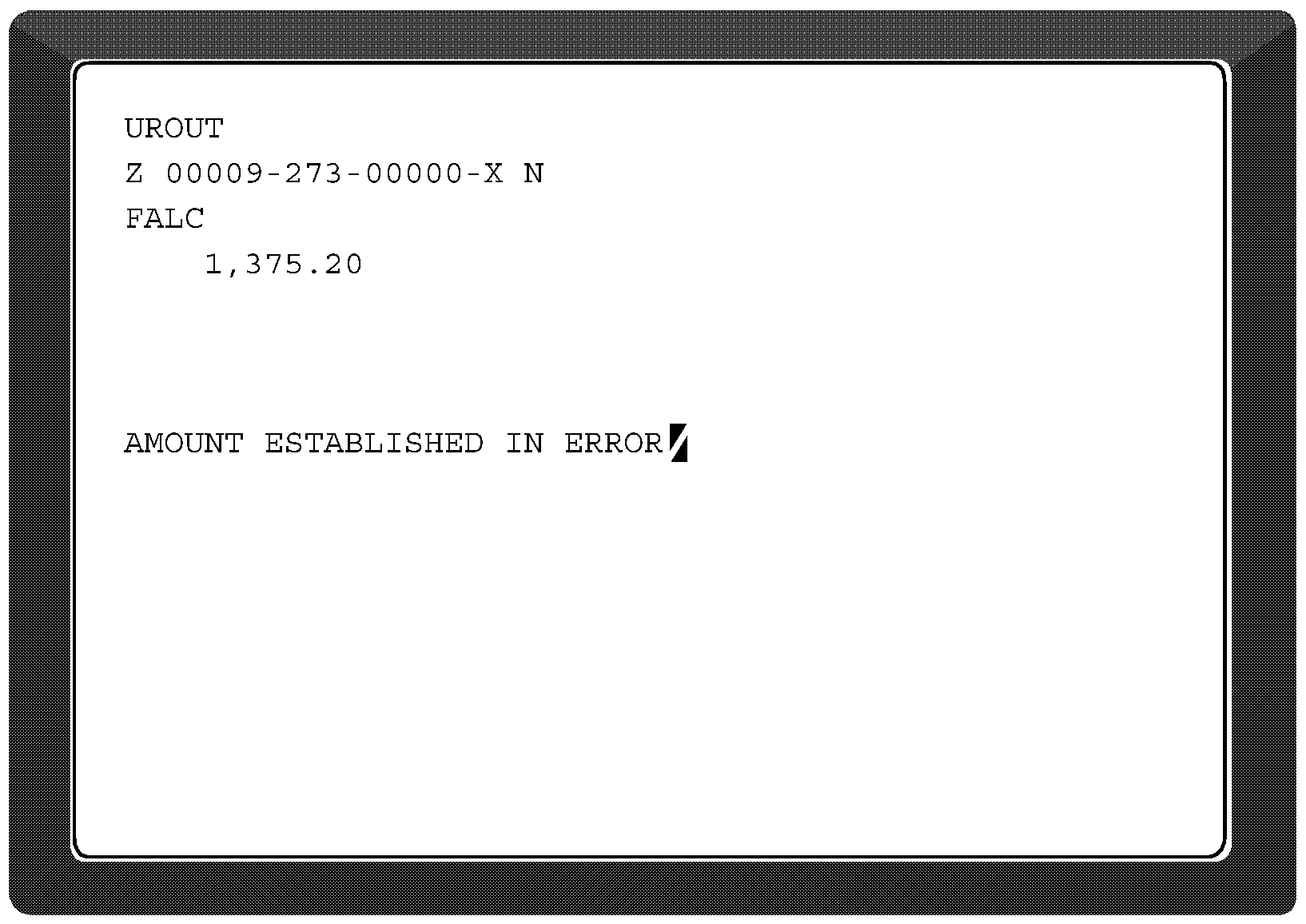
Please click here for the text description of the image.
| Line # | Description |
|---|---|
| Line 1 | CC UROUT - Overlay URAPL |
| Line 2 | APPLICATION CODE - Enter "Z" . UR CONTROL NUMBER - must match the number on the UR record. |
| Line 3 | UR NAME CONTROL - Overlay "NCUR" with the UR Name Control which must match the name control on the UR record and cannot be UNKN. "NCAP" is not used with a UROUT input. |
| Line 4 | AMOUNT - Beginning with the first "$" sign, overlay with the corrected amount. |
| Line 9 | REMARKS - Overlay with the reason for the correction. |
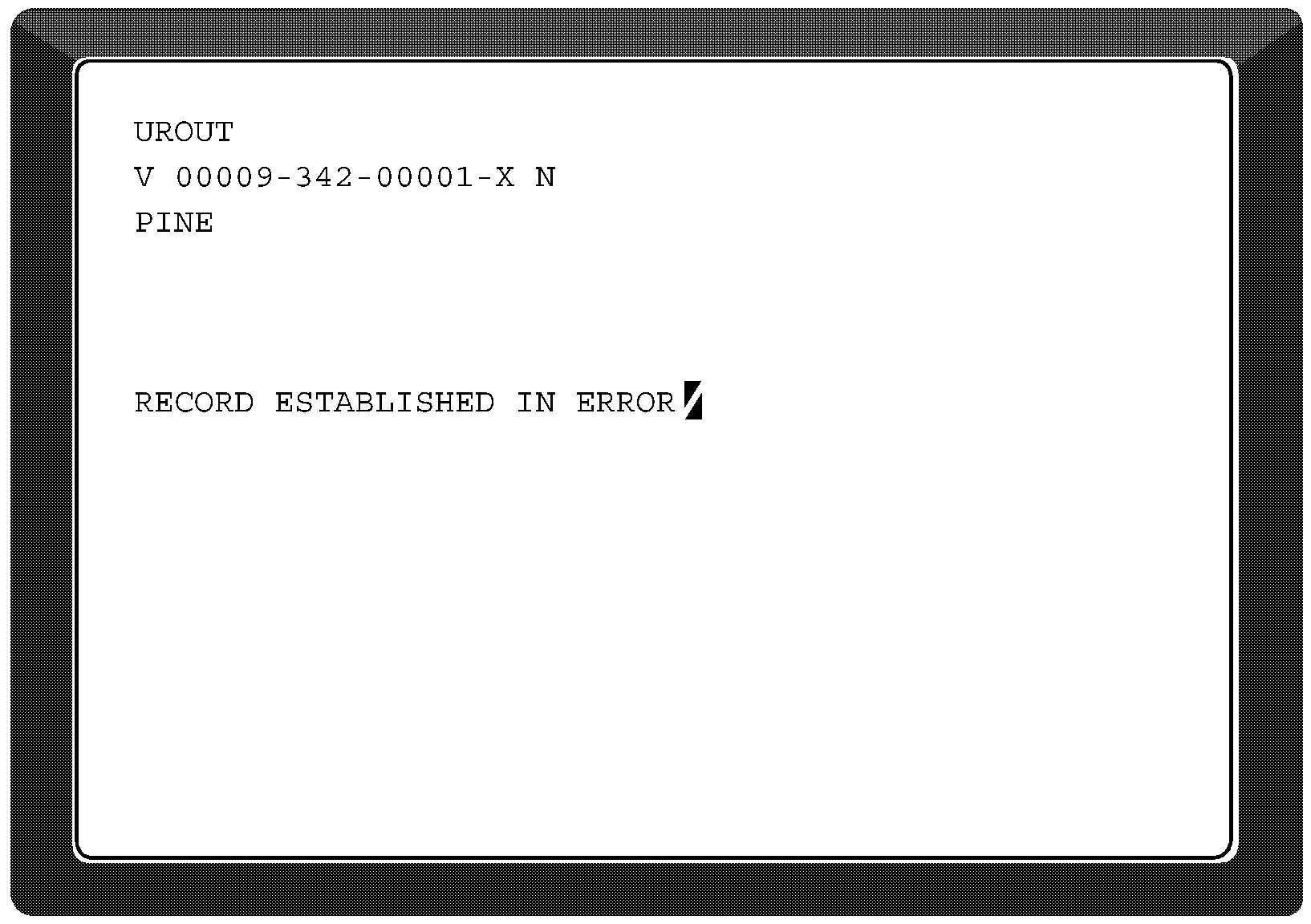
Please click here for the text description of the image.
| Line # | Description |
|---|---|
| Line 1 | CC UROUT - Overlay URAPL. |
| Line 2 | TYPE OF APPLICATION CODE - Enter "V" . UR CONTROL NUMBER - Must match the number on the UR record. |
| Line 3 | UR NAME CONTROL - Overlay "NCUR" with the UR Name Control which must match the name control on the UR record and cannot be UNKN. "NCAP" is not used with a UROUT input. |
| Line 9 | REMARKS - Overlay with the reason for voiding the UR record. |

Please click here for the text description of the image.
| Line # | Description |
|---|---|
| Line 1 | CC UROUT - Overlay URAPL. |
| Line 2 | TYPE OF APPLICATION CODE - Enter "D" . UR CONTROL NUMBER - Must match the number on the UR record. |
| Line 3 | UR NAME CONTROL - Overlay "NCUR" with the UR Name Control which must match the name control on the UR record and cannot be UNKN. "NCAP" is not used with a UROUT input. |
| Line 4 | AMOUNT - Leave money amount blank if entire amount is being dishonored. If partial application has been made, enter the remaining amount to be dishonored. |
Refer to IRM 2.4.24 for specific command code information.
(1) Use CC URAPL in conjunction with a TYPE-OF-APPLICATION code (M, N or T) to record the application of part or all of an Unidentified Remittance record.
The chart below shows the valid transaction codes (TC), MFT codes and document codes for CC URAPL.
1 = valid as 1st (primary) TC only.
2 = valid as 2nd (secondary) TC only.
3 = valid as 3rd (tertiary) TC only.
Listed below are the CC URAPL Transaction Codes
| 170 | 180 | 200 | 270 | 360 | 570 | 610 | 620 | 640 | 650 | 660 | 670 | 678 | 680 | 690 | 694 | 720 | ||
|---|---|---|---|---|---|---|---|---|---|---|---|---|---|---|---|---|---|---|
| Doc Codes |
17 | 2 | 2 | 2 | 2 | 2 | 2 | 1,3 | 1,3 | 1,3 | 1 | 1,3 | 1,3 | 1,3 | 1 | 1,3 | 1 | |
| 45 | 1 | |||||||||||||||||
| BMF MFTs |
01 | 2 | 2 | 2 | 2 | 1,3 | 1,3 | 1 | 1,3 | 1 | 1,3 | 1 | ||||||
| 02 | 2 | 2 | 2 | 2 | 1,3 | 1,3 | 1,3 | 1,3 | 1,3 | 1 | 1,3 | 1 | ||||||
| 03 | 2 | 2 | 2 | 2 | 1,3 | 1,3 | 1 | 1,3 | 1 | 1,3 | 1 | |||||||
| 04 | 2 | 2 | 2 | 2 | 1,3 | 1,3 | 1,3 | 1 | 1,3 | 1 | ||||||||
| 05 | 2 | 2 | 2 | 1,3 | 1,3 | 1,3 | 1,3 | 1,3 | 1 | 1,3 | 1 | |||||||
| 06 | 2 | 1,3 | 1,3 | 1,3 | 1 | 1,3 | 1 | |||||||||||
| 07 | 2 | 1,3 | 1,3 | 1 | 1,3 | 1 | ||||||||||||
| 08 | 2 | 1,3 | 1,3 | 1,3 | 1 | 1,3 | 1 | |||||||||||
| 09 | 2 | 2 | 2 | 2 | 1,3 | 1,3 | 1 | 1,3 | 1 | 1,3 | 1 | |||||||
| 10 | 2 | 2 | 2 | 2 | 1,3 | 1,3 | 1 | 1,3 | 1 | 1,3 | 1 | |||||||
| 11 | 2 | 2 | 2 | 2 | 1,3 | 1,3 | 1 | 1,3 | 1 | 1,3 | 1 | |||||||
| 12 | 2 | 2 | 2 | 2 | 1,3 | 1,3 | 1,3 | 1 | 1,3 | 1 | ||||||||
| 13 | 2 | 2 | 1,3 | 1,3 | 1,3 | 1 | 1,3 | 1 | 1 | |||||||||
| 14 | 2 | 2 | 2 | 2 | 1,3 | 1,3 | 1 | 1,3 | 1 | 1,3 | 1 | |||||||
| 15 | 2 | 2 | 2 | 1,3 | 1,3 | 1,3 | 1 | 1,3 | 1 | |||||||||
| 16 | 2 | 2 | 2 | 1,3 | 1,3 | 1,3 | 1,3 | 1 | 1,3 | 1 | ||||||||
| 17 | 2 | 2 | 2 | 1,3 | 1,3 | 1 | 1,3 | 1 | ||||||||||
| 33 | 2 | 2 | 2 | 2 | 1,3 | 1,3 | 1,3 | 1,3 | 1,3 | 1 | 1,3 | 1 | ||||||
| 34 | 2 | 2 | 2 | 2 | 1,3 | 1,3 | 1,3 | 1,3 | 1,3 | 1 | 1,3 | 1 | ||||||
| 36 | 2 | 2 | 1,3 | 1,3 | 1,3 | 1 | ||||||||||||
| 37 | 2 | 2 | 2 | 1,3 | 1,3 | 1,3 | 1 | 1,3 | 1 | |||||||||
| 43 | 2 | 2 | 1,3 | 1,3 | 1 | 1,3 | 1 | 1 | ||||||||||
| 44 | 2 | 2 | 2 | 2 | 1,3 | 1,3 | 1,3 | 1,3 | 1 | 1,3 | 1 | |||||||
| 46 | 1,3 | 1,3 | 1,3 | 1 | ||||||||||||||
| 50 | 2 | 2 | 2 | 1,3 | 1,3 | 1,3 | 1 | 1 | ||||||||||
| 51 | 2 | 2 | 2 | 1,3 | 1,3 | 1,3 | 1 | 1 | ||||||||||
| 52 | 2 | 2 | 2 | 1,3 | 1,3 | 1,3 | 1,3 | 1,3 | 1 | 1 | ||||||||
| 58 | 2 | 2 | 2 | 1,3 | 1,3 | 1,3 | 1 | 1 | ||||||||||
| 60 | 2 | 2 | 2 | 1,3 | 1,3 | 1,3 | 1 | 1 | ||||||||||
| 61 | 2 | 2 | 2 | 1,3 | 1,3 | 1,3 | 1 | 1 | ||||||||||
| 62 | 2 | 2 | 2 | 1,3 | 1,3 | 1,3 | 1 | 1 | ||||||||||
| 63 | 2 | 2 | 2 | 1,3 | 1,3 | 1,3 | 1 | 1 | ||||||||||
| 64 | 2 | 2 | 2 | 1,3 | 1,3 | 1,3 | 1 | 1 | ||||||||||
| 67 | 2 | 2 | 1,3 | 1,3 | 1,3 | 1 | ||||||||||||
| 74 | 2 | 2 | 2 | 1,3 | 1,3 | 1 | 1,3 | 1 | ||||||||||
| 76 | 2 | 2 | 2 | 1,3 | 1,3 | 1 | 1,3 | 1 | ||||||||||
| 77 | 2 | 2 | 2 | 1,3 | 1,3 | 1,3 | 1 | 1,3 | 1 | |||||||||
| 78 | 2 | 2 | 2 | 2 | 1,3 | 1,3 | 1,3 | 1 | 1,3 | 1 | ||||||||
| 83 | 2 | 2 | 2 | 2 | 2 | 1,3 | 1,3 | 1,3 | 1,3 | 1 | 1,3 | 1 | ||||||
| IMF MFTs |
29 | 2 | 2 | 2 | 22 | 1 | 1 | 1 | 1 | |||||||||
| 30 | 2 | 2 | 2 | 2 | 2 | 1,3 | 1,3 | 1,3 | 1,3 | 1 | 1,3 | 1 | ||||||
| 31 | 2 | 2 | 2 | 2 | 2 | 1,3 | 1,3 | 1,3 | 1,3 | 1 | 1,3 | 1 | ||||||
| 35 | 2 | 2 | 1 | 1,3 | 1 | 1 | ||||||||||||
| 55 | 2 | 2 | 1 | 1,3 | 1 | 1 | ||||||||||||
| 82 | 2 | 2 | 2 | 2 | 2 | 1,3 | 1,3 | 1,3 | 1,3 | 1 | 1,3 | 1 |
Refer to IRM 2.4.24 for specific command code information.
(1) Use CC FMAPL to request the CC URAPL format. CC URAPL cannot be input to the URF if the name control on the UR record is UNKN. The name must be changed with CC URENT.
CC FMAPL Input Screen Format

Please click here for the text description of the image.
Response: CC URAPL. A new CC URAPL format will be displayed after the CC FMAPL input screen. CC URAPL are used with the following definer codes:
M - to apply a credit to a Master File account.
N - to apply a credit to a NMF account.
T - to transfer a credit to Deposit or General Fund application.
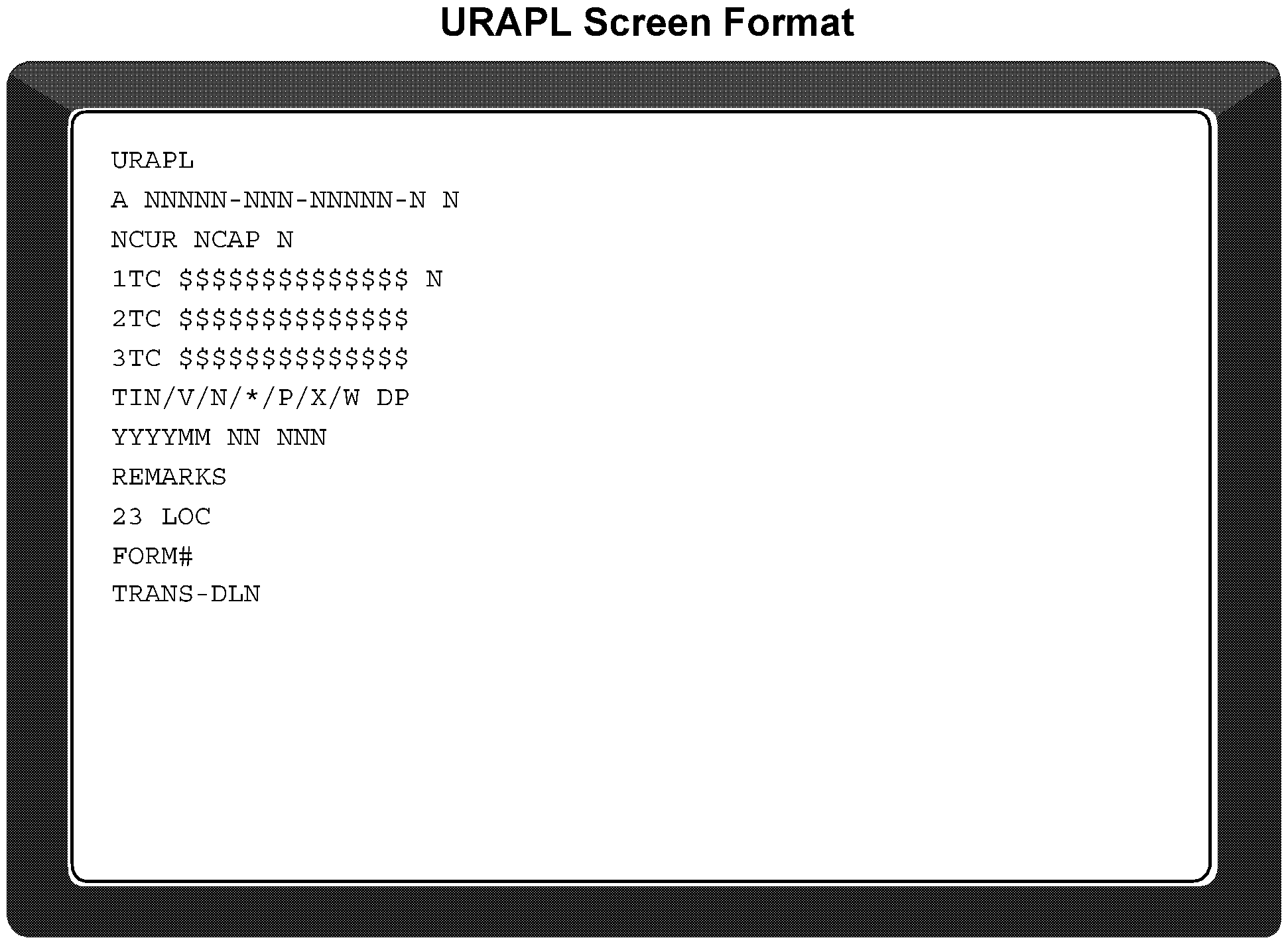
Please click here for the text description of the image.
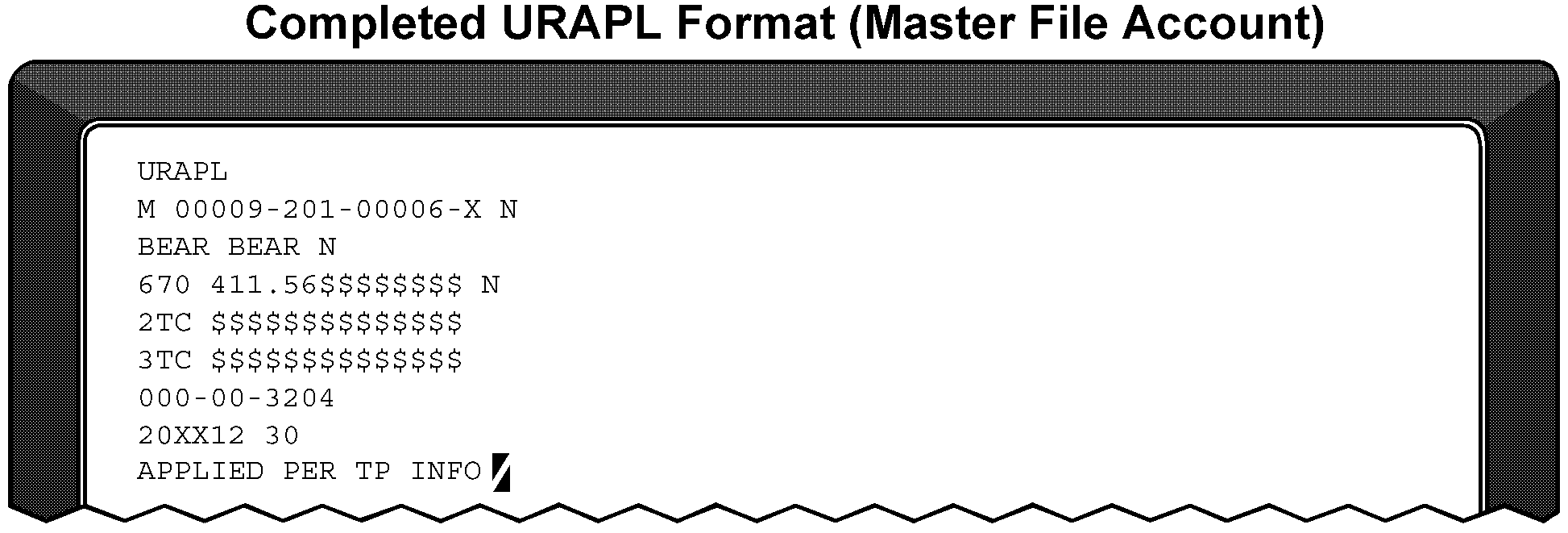
Please click here for the text description of the image.
| Line # | Description |
|---|---|
| Line 1 | CC URAPL |
| Line 2 | APPLICATION CODE - Enter "M" UR CONTROL NUMBER - must match the number on the UR Record. NOTICE INDICATOR - Enter "Y" if Letter 2349 should be sent to the taxpayer. (Figure 3.17.10-40, Form 8765, IDRS Control File Credit Application) Enter "N" if Letter 2349/Letter 2349 (SP) should not be sent to the taxpayer. "Enter E" if Letter 2349 (SP) should be sent to the taxpayer. The field will default to "N" if no entry is made. |
| Line 3 | UR NAME CONTROL - Overlay "NCUR" with the UR Name Control. This must match the name control on the UR record and cannot be "UNKN" . ACCOUNT NAME CONTROL - Overlay the "NCAP" with the name control of the account being credited. This must match the name control of the tax account module. ELECTRONIC PAYMENT INDICATOR - Enter "Y" if an electronic payment is being applied. The field will default to "N" if no entry is made. |
| Line 4 | PRIMARY TRANSACTION CODE - Overlay "1TC" with a valid transaction code (TC). (Exhibit 3.17.10-11 Valid URAPL "M" Transaction Table.) PRIMARY TRANSACTION AMOUNT - Beginning with the first "$" sign, overlay with the amount including commas and decimal point, which may not exceed the balance amount in the UR record. BYPASS INDICATOR - To apply an amount greater than the balance of the master file account to which the application is being made, overlay "N" with "Y" to override UPC 198 or 305. The field will default to "N" if no entry is made. |
| Line 5 | SECONDARY TRANSACTION CODE - If a secondary TC is needed, overlay "2TC" with a valid secondary TC. SECONDARY TRANSACTION AMOUNT - Can be present only when the primary transaction code is present. |
| Line 6 | TERTIARY TRANSACTION CODE - If needed, overlay "3TC" with a valid tertiary TC. TERTIARY TRANSACTION AMOUNT - Can be present only when the secondary transaction code is present. |
| Line 7 | TIN - Overlay with the correct TIN. Enter file source literal if applicable: Blank - Valid IMF SSN and BMF EIN. * - Invalid IMF SSN. N - NMF TIN. P - Valid IMF SSN on MF with MFT 29. X - Invalid IMF SSN with MFT 29. V - Valid BMF SSN. W - Invalid BMF SSN. |
| DESIGNATED PAYMENT CODE - Overlay DP with the correct code. | |
| Line 8 | TAX PERIOD - Overlay "YYYYMM" with the correct Tax Period. MFT - Overlay "NN" with the correct MFT. PLAN/REPORT NUMBER - Enter Plan/Report Number if MFT is 46, 74 or 76. Format is NNN. |
| Line 9 | REMARKS - Overlay with appropriate remarks. |
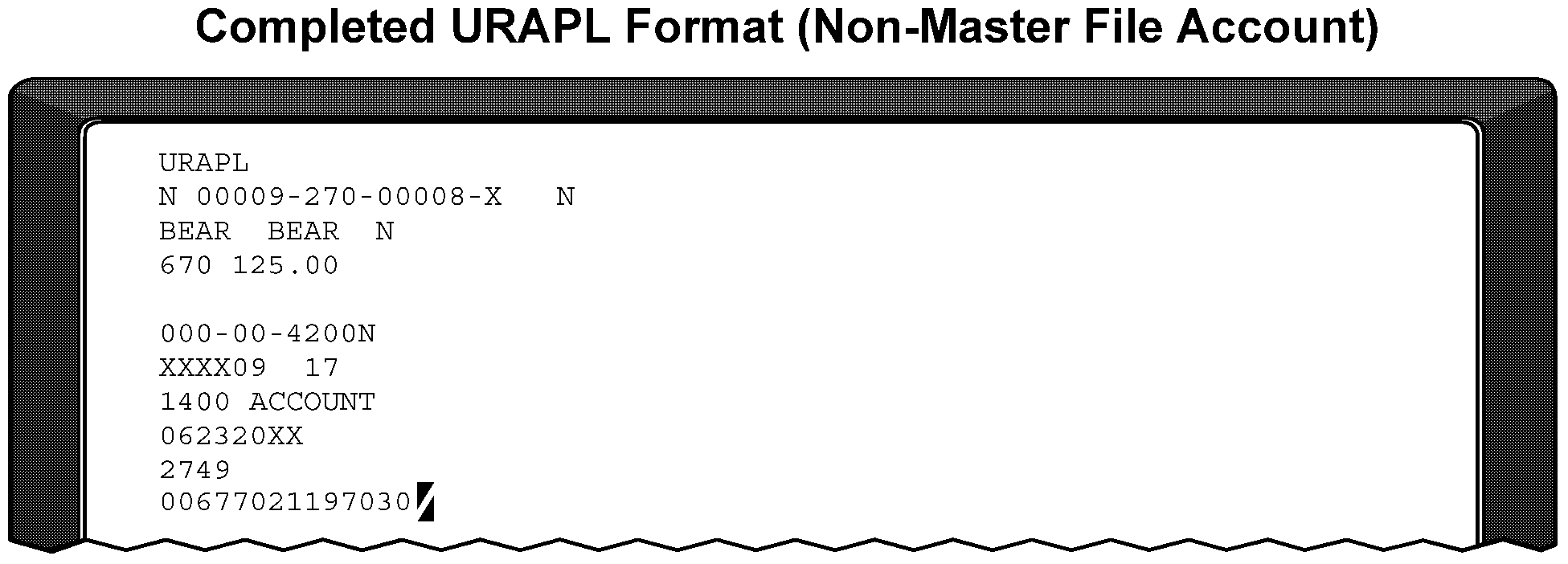
Please click here for the text description of the image.
| Line # | Description |
|---|---|
| Line 1 | CC URAPL |
| Line 2 | APPLICATION CODE - Enter "N" UR CONTROL NUMBER - must match the number on the UR Record. NOTICE INDICATOR - Enter "Y" if Letter 2349 should be sent to the taxpayer. Enter "E" if Letter 2349 (SP) should be sent to the taxpayer. (Figure 3.17.10-403.17.10-40, Form 8765, IDRS Control File Credit Application ) Enter "N" if Letter 2349 should not be sent to the taxpayer. The field will default to "N" if no entry is made. |
| Line 3 | UR NAME CONTROL - Overlay "NCUR" with the UR Name Control. This must match the name control on the UR record and cannot be "UNKN" . |
| Line 4 | PRIMARY TRANSACTION CODE - Overlay "1TC" with a valid transaction code (TC). (Exhibit 3.17.10-11, Valid URAPL "M" Transaction Table.) PRIMARY TRANSACTION AMOUNT - Beginning with the first "$" sign, overlay with the amount including commas and decimal point, which may not exceed the balance amount in the UR record. |
| Line 7 | TIN - Overlay with the correct TIN. FILE SOURCE LITERAL - Must be "N" . |
| Line 8 | TAX PERIOD - Overlay "YYYYMM" with the correct Tax Period. MFT - Overlay "NN" with the correct MFT. PLAN/REPORT NUMBER - Enter Plan/Report Number if MFT is 46, 74 or 76. Format is NNN. |
| Line 9 | REMARKS - Overlay with appropriate remarks |
| Line 10 | 23C DATE OR LOCATION CODE |
| Line 11 | TAX FORM NUMBER |
| Line 12 | NMF IDENTIFYING NUMBER OR LEDGER ACCOUNT NUMBER |
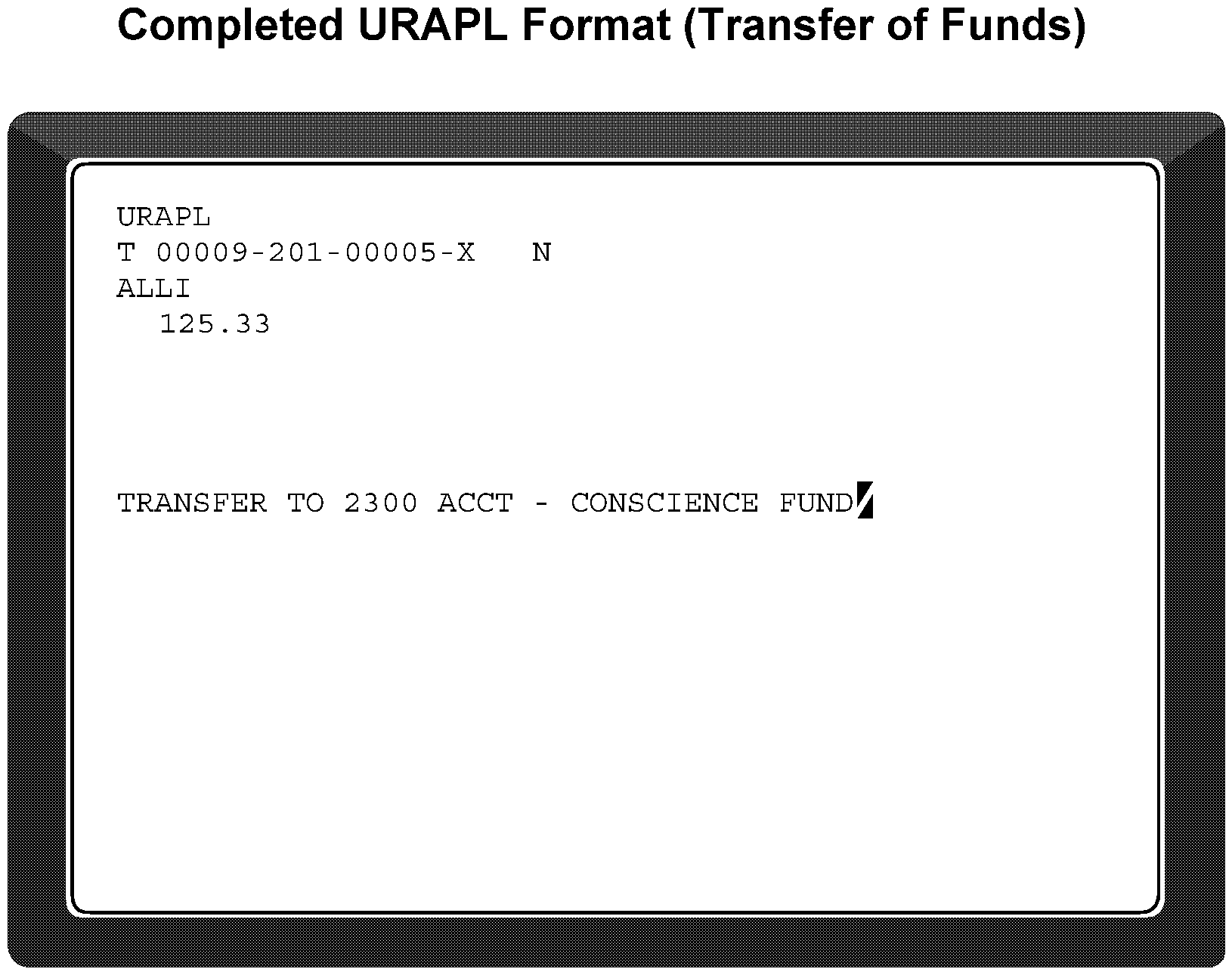
Please click here for the text description of the image.
| Line # | Description |
|---|---|
| Line 1 | CC URAPL |
| Line 2 | APPLICATION CODE - Enter "T" UR CONTROL NUMBER - must match the number on the UR Record. |
| Line 3 | UR NAME CONTROL - Overlay "NCUR" with the UR Name Control. |
| Line 4 | PRIMARY TRANSACTION AMOUNT - Input the amount of the transfer. Begin overlaying the first "R" sign with the amount to be transferred. |
| Line 9 | REMARKS - Overlay with description of the transfer. |
Refer to IRM 2.4.24 for specific command code information.
(1) Input CC FMREF to request CC URREF format.
(2) CC URREF is used to make a Refund application from the URF.
CC FMREF Input Screen Format
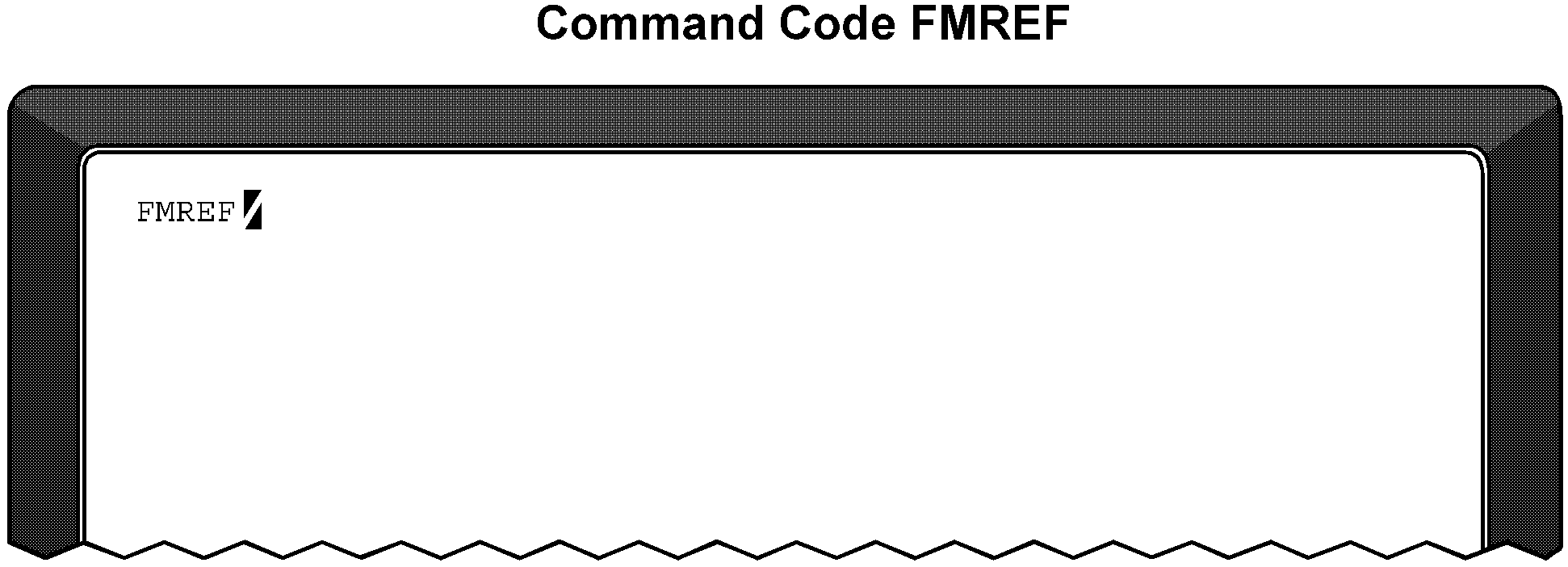
Please click here for the text description of the image.
Response: CC URREF. CC URREF format will be displayed after the CC FMREF input screen.
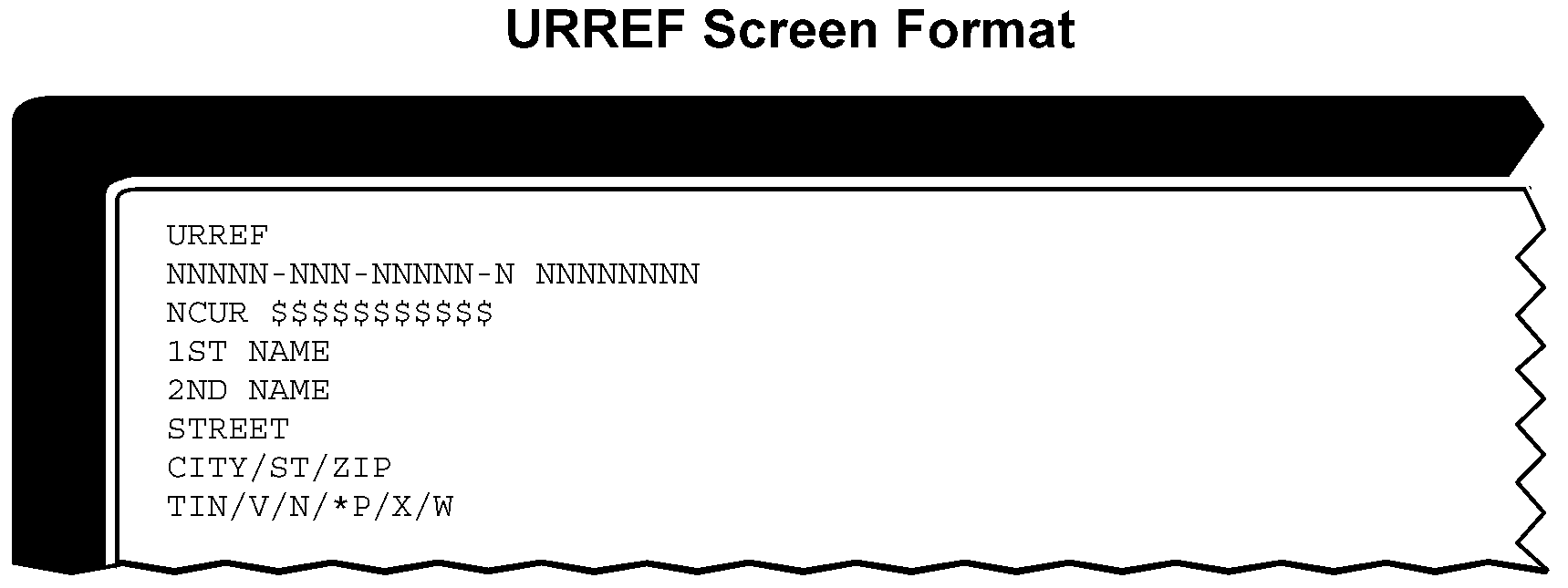
Please click here for the text description of the image.
| Line # | Description |
|---|---|
| Line 1 | CC URREF |
| Line 2 | UR CONTROL NUMBER - Overlay "Ns" with the UR Control Number which must match the control number on the UR record. RETURN-FILED DATE - Should be entered in MMDDYYYY format if IRS received date is more than two years before the current date. Optional entry. |
| Line 3 | UR NAME CONTROL - Overlay "NCUR" with the UR Name Control which must match the name control on the UR record and cannot be "UNKN" . REFUND AMOUNT - Overlay "$" with the Refund Amount. |
| Line 4 | PAYEE'S FIRST NAME LINE - must be present. |
| Line 5 | PAYEE'S SECOND NAME - optional. |
| Line 6 | PAYEE'S STREET ADDRESS - must be present. |
| Line 7 | CITY, STATE, AND ZIP CODE - This information must be present. There should be a comma between the City and State and one blank space between the State and the Zip Code. A Major City Code, one blank and ZIP Code is valid City/State/ZIP Code input. Required entry. |
| Line 8 | TIN-FILE-SOURCE - This is an optional entry. |
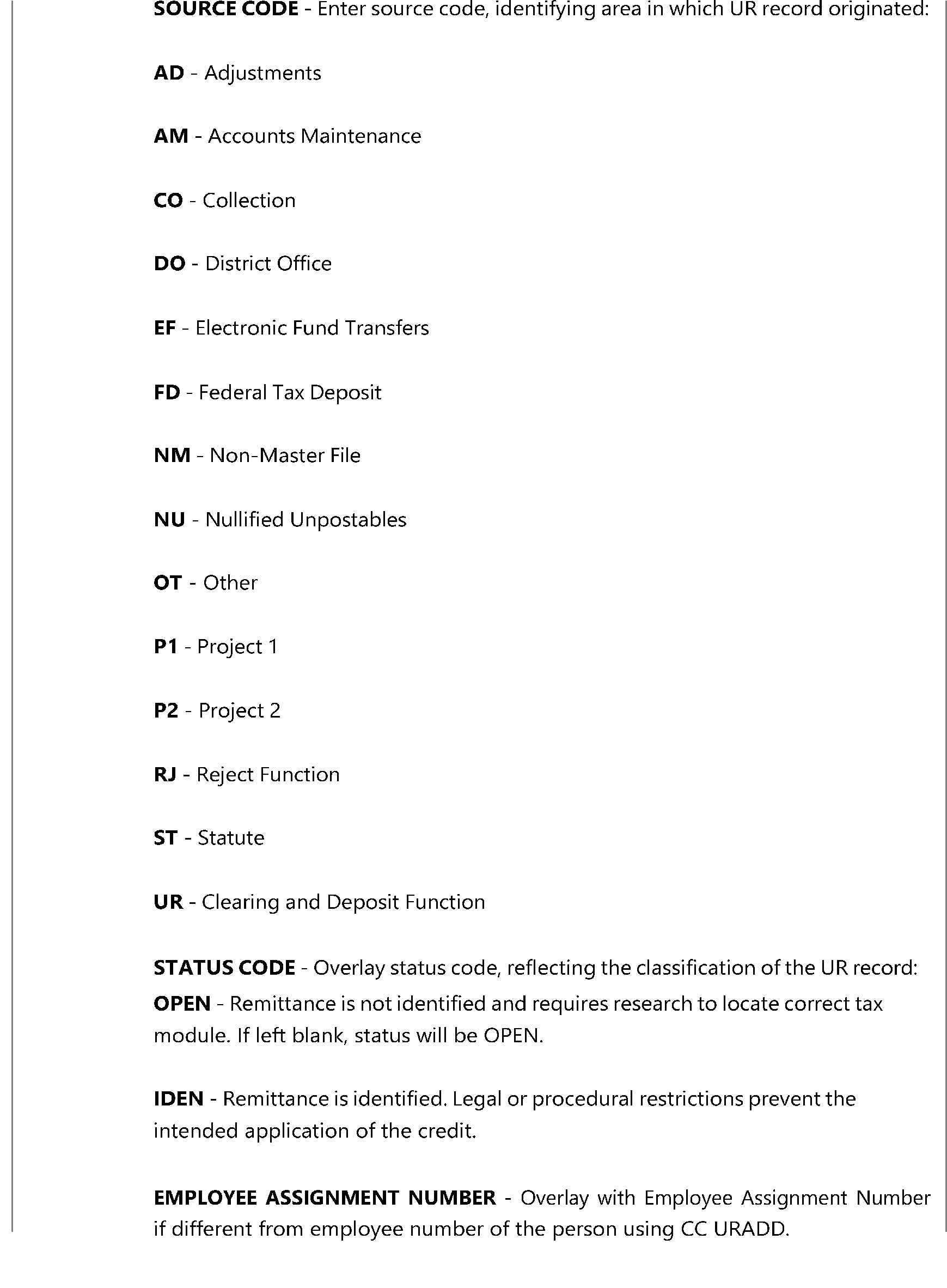
Refer to IRMs 2.4.24, 2.4.25 and 2.3.20 for specific command code error messages.
Note:
The Chart below shows the Error Messages, Conditions and Solutions. The list does not include all error messages.
| AMOUNT FIELD INVALID | 1. Amount field not formatted correctly. | Correct and reenter. |
|---|---|---|
| 2. PRIMARY-TRANS-AMT in CC UROUTZ is equal to the ORIGINAL-AMT in the UR record. | Correct PRIMARY-TRANS-AMT. It must be different. | |
| 3. ORIGINAL-AMT and UR-BALANCE-AMT within the record are not identical. | Review/Apply info—use VOID. | |
| APPLICATION AMOUNT EXCEEDS BALANCE | An attempt has been made to apply more money out of a UR record than is available. | Determine the apply amount and reenter application |
| DLN CHANGE INVALID FOR CC URENT | An attempt has been made to change a DLN on a UR record | Do not use CC URENT |
| DO/SC INVALID FOR THIS CENTER | The DO-CD or SC-CD is not within this campus | Correct and reenter. |
| DUPLICATE UR CONTROL NO-ADD DENIED | Another exact UR-CTRL-NUM is present on the existing URF. | Determine the reason for the duplicate number and reassign a different UR-CTRL-NUM and reenter, or VOID the original (existing) record if it is in error and reenter subsequent (correct) UR-CTRL-NUM after voided one has been dropped from the file. |
| NAME LINE INVALID | NAME-LINE-1 is missing; or NAME-LINE-1 does not begin in the first position; or the first position is not alphanumeric. | Enter NAME-LINE-1 beginning in the first position. |
| NARRATIVE MISSING OR INVALID | The RE-MARKS field is all blank; or the first position is blank; or the RE-MARKS field exceeds 35 positions | Begin RE-MARKS in the first position and keep them within 35 positions. |
| nnERRORS-CORRECT* FIELDS REENTER | One or more of the INPUT DATA fields are in error (fail to pass validity checks). Invalid fields will be indicated by having an asterisk (*) to the right of the data field. "nn" will show how many fields are invalid and must be corrected. |
Locate the invalid fields and correct the erroneous data and reenter. |
| NO UR RECORD FOUND FOR GIVEN DATA | Self-explanatory. | Change search or apply information and reenter. |
| PRIOR COMMAND CODE NOT COMPATIBLE | Command Code immediately preceding the one just entered was not correct for inquiry or for processing; i.e., FMADD entered and URAPL overlaid. | Determine correct command code and reenter data. |
| RECORD STATUS DOES NOT ALLOW APPLY | An attempt has been made to change or apply an amount in a record where the status is not OPEN or IDEN. | Be sure this is the record you want before taking further action. Record subsequent action taken via CC URENT. |
| STATUS CHANGE NOT ALLOWED | An attempt has been made to change the status of a record that does not presently have an OPEN status. | Be sure that this is the record you want before taking further action. Add subsequent information via CC URENT. |
| STATUS CODE INVALID | An attempt has been made to change the record status to other than IDEN. | Enter IDEN as status change. |
| SUBTOTALS NOT AVAILABLE FOR RECALL (only when using RECELL-CD) | No prior totals are stored; or EMPLEE-NUM is different from the one used to store the subtotal; or prior command code is not compatible with the command code being entered. Condition will result in zeroing out whatever totals have been stored up to this point. | Recall to the screen all prior entries to get totals entered up to this point. |
| UR CONTROL NUMBER INVALID | The UR-CTRL-NUM is not formatted correctly or is not all numeric. | Correct and reenter. |
| MORE THAN 999 PAGES–USE FLC/CAMPUS CODE TO NARROW DOWN SEARCH | The URINQ request has rendered more than 999 pages. | Use either an FLC or Campus Code to narrow down the search. |
| M APPLICATION LIMIT EXCEEDED | BDAPL Applications exceeds 98 records. | Void remaining amount, create new CC BDADD for balance and reenter remaining applications. |
| TOO MANY TIF63 RECS - MUST WAIT FOR TRANSACTIONS TO POST BEFORE REINPUTTING/RE-ENTERING. | The maximum allowable pending TIF63 records is 96. Your request will exceed this amount. | Try your request again after some of the pending transactions have posted to the TIF. |
| DUPLICATE DC CONTROL NUMBER | A DC Control Number exactly the same as the one being entered already exists on the DCF. | Determine the reason for the duplicate number, then either assign a different control number and reenter or VOID the existing record if in error and reenter the correct record. |
| INVALID TRACE ID (SITE-ID) | SITE ID of TRACE ID invalid for Service Center processing | Check to ensure SITE-ID of TRACE ID is valid for Service Center. |
| REASON-CD 23 COMMENTS REQUIRED | Comments are required when a master file apply is made to an account with a reason code 23. | Input comment line and re-try. |
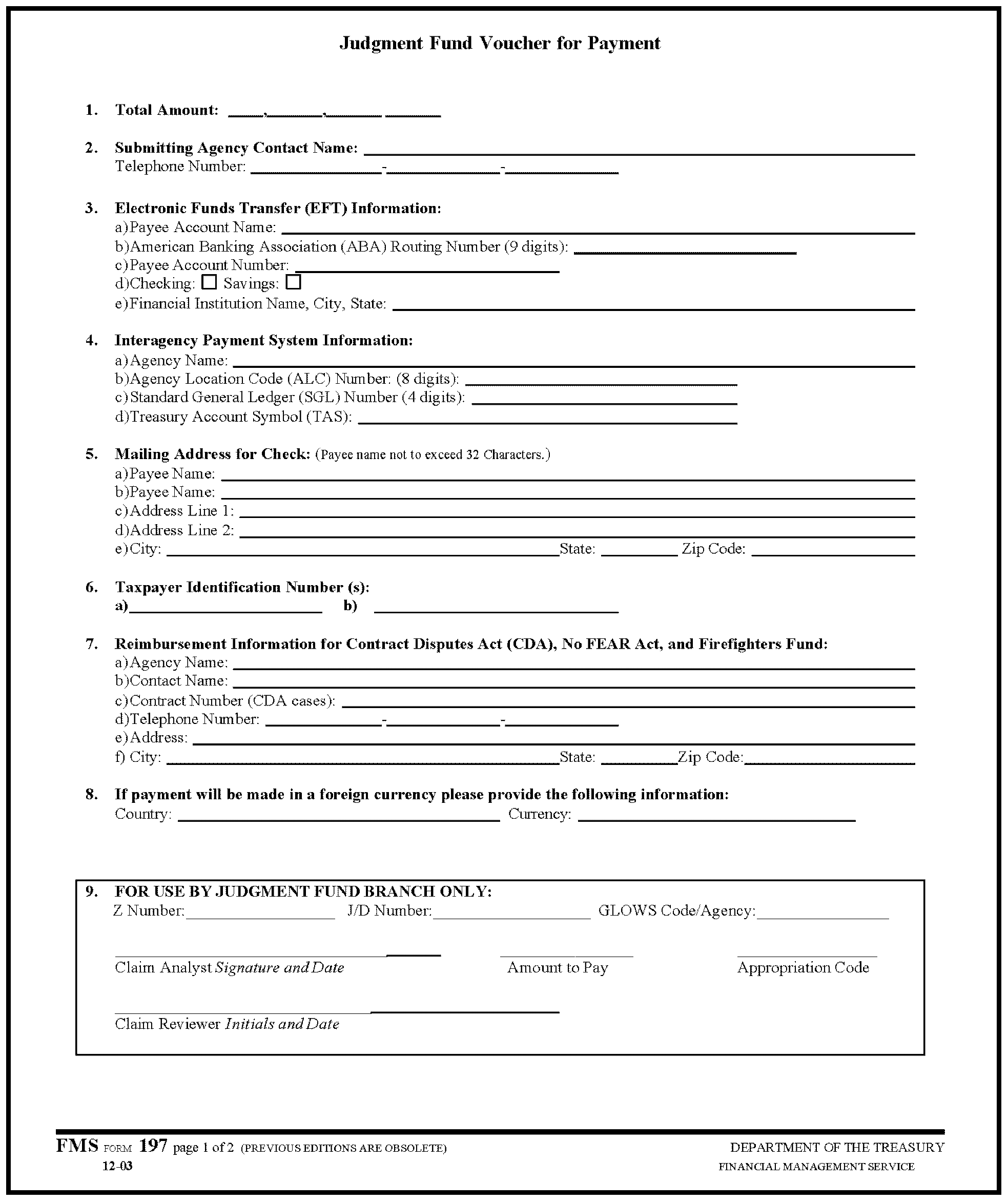
Please click here for the text description of the image.
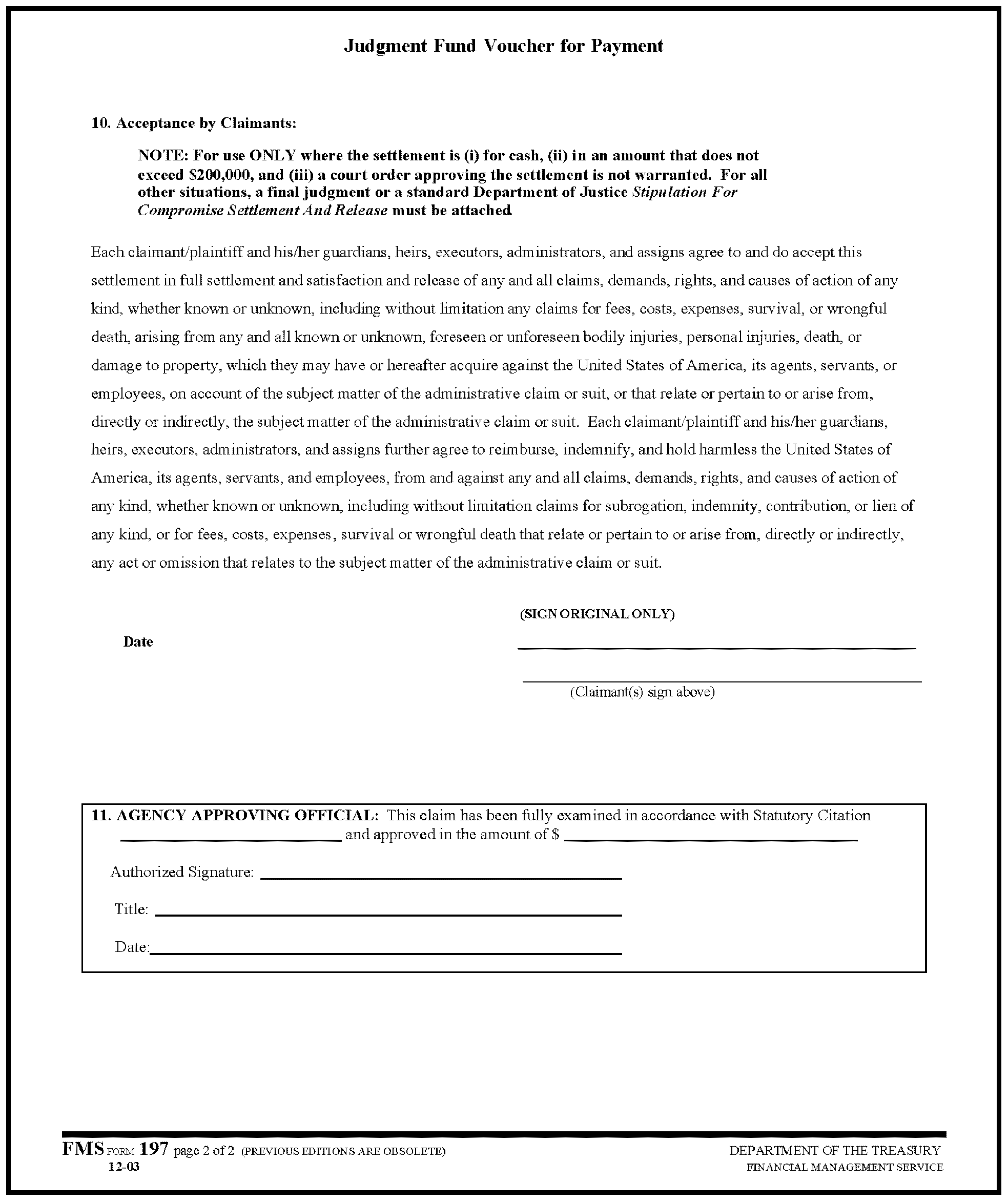
Please click here for the text description of the image.
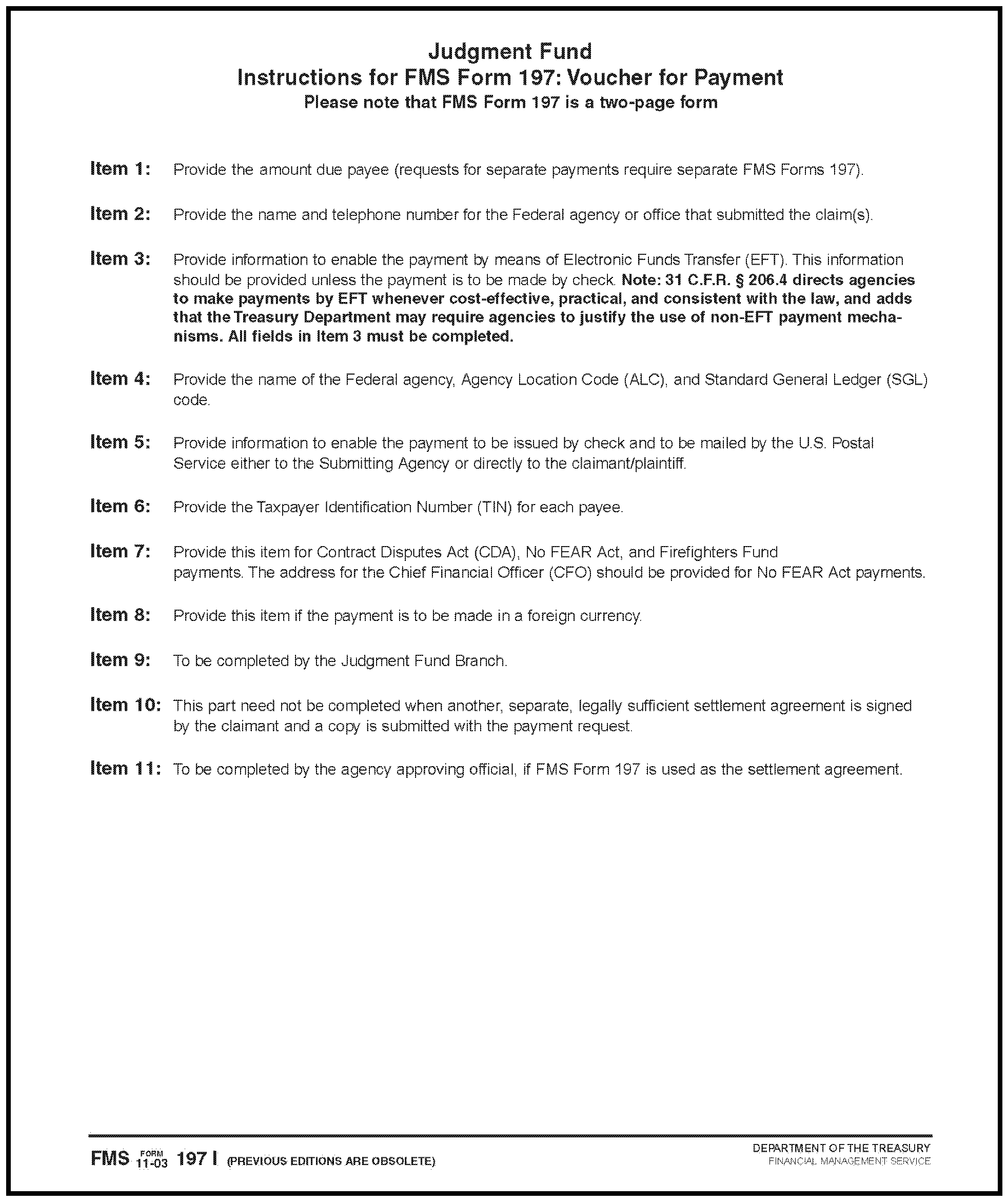
| 1. All User Procedures |
|---|
| If your agency has been chosen to use OTCnet and you have been identified as an employee who will need access, your Primary Local Security Administrator (PLSA) or Local Security Administrator (LSA) will need to create you as a user. You must agree to the "Rules of Behavior" document to be granted access to OTCnet. After your user ID has been created, your user ID and password will be distributed to you. |
| 1.1 Initial Sign In |
| Regardless of your role, you must sign in for the first time in the following manner: |
| 1. Go to OTCnet PIV/CAC Sign In. 2. The system will prompt you to enter your User ID and password. 3. The system will prompt you to enter your password again, and then enter a new password twice (please see the password rules below). 4. When your new password has been accepted, you will be directed to the Treasury User Provisioning Service. 5. Select "Update My Secondary Authorization Answers" . 6. Enter the answers to the questions provided. (This feature will help you reset your password should you ever forget it). |
| 1.2 Password Maintenance |
| To change your password at a later date: |
| 1. Go to PIV-CAC for OTCnet Connection to contact OTC support to reset your PIV/CAC log in connection. |
| 1.2.1 Password Rules |
| -Must be a minimum of 8 characters -Must include each of the following: -Alphabetic lower-case -Alphabetic upper-case -Numeric character -Maximum of two repeated characters -An identical password cannot be reused for 10 successive password changes. -A user has three consecutive attempts to enter a valid password. After the third try, the user is locked out and must answer pre-determined secondary authentication questions or call his or her PLSA, LSA or the Treasury OTC Support Center for validation of user identity and reset of the password. |
| 1.2.2 Resetting Passwords |
| A user is permitted three consecutive attempts to enter a valid password. After the third try, the user is locked out and must answer pre-determined secondary authentication questions or call his or her PLSA, LSA or Treasury OTC Support Center for validation of user identity and reset of the password. Users must log into the OTCnet application at least every 90 days or your access will be inactivated on the 90th calendar day since your last access date. Users that have not accessed their OTCnet account for 120 days will have their access deleted on the 120th calendar day since their last access date. Users that have their access deleted will need to reapply for access through their organization. Users that have been inactivated (90 days, no activity) or deleted (120 days, no activity) may be reactivated by the user's PLSA, LSA or the Treasury OTC Support Center. Reactivating a user requires resetting the password. |
| 1.3 OTCnet Contingency |
| -Should you have an issue accessing OTCnet, review the contingency document at OTCnet Contingency and click on the OTCnet Contingency document. |
| 2. Agency Viewer Procedures |
| As a viewer, you may search deposits, view deposits, search adjustments and view business reports. |
| -Deposit history should be reviewed daily to verify deposits that are submitted and are confirmed on time by your Financial Institution. |
| Questions? Please call (866)945–7920 or e-mail Fiscalservice.otcchannel@citi.com |

 )
or https:// means you've safely connected to the .gov website. Share sensitive information only on official, secure websites.
)
or https:// means you've safely connected to the .gov website. Share sensitive information only on official, secure websites.

